
- Philippines
- Western Australia
- The Netherlands
- United Kingdom
- Photography Tips Photography Ideas and Inspiration

Faroe Islands on a budget: Including an Itinerary
This guide will give you the top tips on how to visit the Faroe Islands on a budget! I am always looking to keep costs down, so I will be giving you a few top tips on how to visit the Faroe Islands on a budget . At the end I will also include a one week itinerary. We still didn’t do everything we wanted to in one week, but if you’re looking to keep costs down then I would say that one week is the perfect amount of time to visit the Faroe Islands on a budget! The one thing that is a bit more expensive but WELL worth it is the Lake Sørvágsvatn Hike . There are so many free things to do in the Faroe Islands to add to your bucket list!
[In collaboration with Visit Faroe Islands]

Please note that this post may contain affiliate links and any sales made through these links will reward me a small commission – at no extra cost for you.
Where are the Faroe Islands?
The Faroe Islands are located in Northern Europe . They are between Scotland and Iceland. Faroe Islands are part of Denmark but it is a self-governing archipelago. They speak both Danish and Faroese here. Everyone we met also spoke very good English so we didn’t have any trouble being understood here at all. Faroe Islands is actually comprised of 18 separate islands. To get between all of these is by tunnels, ferries or by air. The itinerary at the end of this post is mainly for the islands that are easy to reach by tunnels. Although, Kalsoy Island you will need to get a ferry across to get here.

What is the currency?
Danish Krona is the currency here. However, I didn’t get any money out during my time here as everywhere accepted cards. I also hardly got my card out at all as everywhere accepted contactless and I just used my Monzo card stored on my Wallet on my phone. I always use my Monzo card as then you don’t pay any fees while using your card in shops abroad. This is just a personal tip on how to keep costs down too! Then if you need to withdraw money, you can withdraw up to £200 without paying any fees too within a 30 day period. If you try and withdraw over £200 in a 30 day period then you get charged £4 per transaction.
Read more: The best Levada walk in Madeira
How long do you need to see the Faroe Islands?
We spent a week here and it actually still wasn’t enough. The weather changes a lot here, so we had to change our itinerary daily according to the weather. However, some mornings we would wake up in total mist and fog in Tórshavn. On these days all it took was to drive through a tunnel to another island and the weather was totally different. So don’t be disheartened if you can’t see anything when you wake up, as it may be much better on another island. I would recommend at least 5 days to a week to see the top spots. However, I enjoyed exploring further. We found so many spots that we stumbled upon and aren’t the famous spots but also incredible!
Which time of year is best to go?
We went here in September and were a bit unlucky with the weather as it was quite foggy and rainy. However, the week after we left was meant to be perfect weather, even as we headed to the airport the sun had come out and it was lovely. September is a good time as it is not yet too cold. I managed the week without a hat and gloves as it was 10 degrees most days. The reason I needed a hat some days was mainly when it was drizzling, instead of an umbrella! Boyan went to the Faroe Islands last in late October and it was a bit colder but he had beautiful weather all week so it really depends. We spoke to a local here who said that the warmest temperature are about 20 degrees in summer. It is much easier to hike when it’s a bit cooler.

Spring/Summer
Late spring to early summer is also a good time if you want to see the flowers here and more importantly the puffins . However, this is also the busiest time of year here. We were here in September and had most places to ourselves. On one of the hikes we only saw two other people and it was nice not having anyone else in the way of our views and having the waterfalls to ourselves.
Read more: 10 best things to do in Jersey
How to visit the Faroe Islands on a budget?
Stay in an air bnb.
We stayed in an Air Bnb near Tórshavn for the first few nights and I loved it. I would definitely recommend the one we stayed in. The host was really lovely and the whole apartment was very bright and clean. I am not usually one for a private room, but this was totally fine. There was actually a separate entrance to get into the part of the house where we stayed. There were three rooms here and one shared bathroom. The rooms had a large bed with a large window and mirror, dressing gowns, hairdryer and tea making facilities. We also had bath towels provided and little handmade soaps. The host even baked cupcakes and left us some on our first day.
Here is the link to our Air Bnb we stayed in: From 40 Euro per night – best way to stay in the Faroe Islands on a budget

There was a small kitchen here where you could cook. This is the best way to keep costs down as food can be quite expensive in the Faroe Islands in the cafes and restaurants. We bought bread rolls and cheese and ham and I made sandwiches for us for lunch each day. You would also be able to make breakfast here as there was a little stove as well as a microwave oven.
Where to eat while in the Faroe Islands on a budget
As I said, food can be quite expensive in the Faroe Islands but we found some great cheap eats!
Fisk and Kips
This was our favourite fish and chip shop here. It is located in the centre of Tórshavn and makes great fish and chips to take away. We paid about £20 for two large portions of fish and chips and drinks. It is actually more expensive in London so I thought this was a good deal!
If you enjoy a take away pizza then I would recommend this place! The base is actually the closest to a good Italian pizza I’ve ever had from a take away. I had the pepperoni pizza, which was a bit oily but Boyan had one with lamb and it was delicious. We paid around £20 for two pizzas and drinks. If you were on a real budget you could actually share one pizza as they were huge!
Chinese Takeaway on Vágar
Sandavágur is home to a great Chinese takeaway! It is next to Turf House on Leitisvegur. This food truck appears in the evening and does great spring rolls and deep fried prawns. I had a rice box with curry, spring rolls and deep fried prawns. We paid £14 for the both of us which was DKK 120.
Take snacks from home
We packed lots of snacks from home! It saves time having to go to the shop, as you might want something while you hike. We had some snickers as well as cereal bars to snack on. Also there aren’t supermarkets everywhere so it’s a good idea to stock up. If you are looking for a supermarket though then Bonus is the best one!

Plan your route to reduce driving time
The Faroe Islands have a lot of long roads you don’t want to be driving back and forth! Make sure you plan your trip well. Either explore one island a day or make sure you see everything while you are in the area so you don’t have to go back on yourself!
Keep in mind the Toll Roads
Two of the sub sea tunnels cost 100 DKK for a return trip. One of these is the tunnel that connects Stremoy island and Vágar, which you will have to use on the below itinerary.
Use SkyScanner to find the cheapest flights
To get to the Faroe Islands, you will have to most likely fly to Copenhagen first and then fly to the Faroe Islands. Make sure to time your flights well. On our way back we had to spend one night in Copenhagen, which I definitely wouldn’t recommend, as it is very expensive! So make sure your flights line up well so that you can avoid this.
Read more: 5 Best places to visit in Dorset in Winter
One Week Itinerary for the Faroe Islands
Day 1 – streymoy island.
This is the island that is home to the capital city, Tórshavn.
Breakfast at Brell café
If you want to treat yourself one morning then I would recommend Brell Café. It has some lovely sandwiches and one of the best chai lattes I have ever tried! Our first night in the Air Bnb we hadn’t been to the shop yet so went here after being recommend this café.

Kirkjubour Village
This is the first village we visited here and it is a lovely one! Lots of grass roofed traditional Faroese houses. It is the most southern tip of Streymoy. From here, you can drive up through this lovely island.

Then 25 mins drive away..
Head to an amazing Gorge
This gorge has no name but is located near to Norðradalur. As you drive down the road, it should be to your left. There is a small waterfall here and lots of geese and sheep.

Drive back via the most scenic road – Oyggjarvegur
This is one of the most scenic roads for sure! It is also home to the prison on the island. Definitely the prison with the best view!

Day 2 – Streymoy Island
Fossa waterfall.
This is one of the biggest waterfalls here! It has two tiers. You have amazing views from the bottom, but you can also walk up to the middle section or to the top. I would recommend walking to the middle section where you can see both waterfalls from. As you walk up, take a right and almost walk away from the waterfall, then as you reach a path to your left that is all rocks, walk up here until you reach the top. From here, you walk back towards the waterfall.

Village with black beach – Tjørnuvik
This is 12 minutes drive away from Fossa Waterfall. It is a lovely village with a black sand beach. Incredible mountains that you won’t want to miss also surround the village.
Day 3 – Head to Esturoy Island
This is a very scenic little village that is worth a visit. There is a lovely church here.

This was one of our favourite villages here. A river that runs through the whole village with lovely houses either side. There is also a small church as well as a 200-metre sea filled gorge. There are steps to walk down here. You can also see it from either of the two paths above too.

See the waterfall at Eiði
Even further North is the village of Eiði. This is not such a scenic village, but there is a great waterfall nearby. As you drive to the other end of the village you will reach a football field. From here, there is a path up to the best viewpoint for this huge waterfall.

Camp on a football field
The football field is also actually a campsite!
Day 4 – Vagar Island
Mulafossur waterfall.
This waterfall is one of the easiest to reach the viewpoint. You park by the side of the road and walk about 5 minutes to the viewpoint. This is a huge waterfall and absolutely incredible.

Gásadalur Village
This village is right behind the waterfall. It is full of lots of traditional houses and a great heated toilet.
Day 5 – Head to Kalsoy
Kalsoy can be reached by ferry, you can take the car or go by foot. The ferry goes from Klaksvik which is on Bordoy Island. It should take around an hour to drive here. Get the earliest ferry you can, as the cars start to line up early and there are limited spaces.
Hike to Kallur Lighthouse
This hike is not the easiest! It is also not for those afraid of heights. The views are breath taking and it is well worth it.
Day 6 – The most scenic hike on Vagar
Trælanípa – bøsdalafossur.
This hike surrounds Sørvágsvatn lake. It was free up until April 2019, and now costs 26 Euro per person as they are raising funds to improve the path. Don’t be discouraged, it is well worth it! The views from the top are stunning, as you can see the sea and the rocks in between the lake and the sea. There is also a beautiful waterfall as you reach the very end of the hike.

Day 7 – Explore Tórshavn
I would recommend spending some time here, especially in the old part of the town. There is a lovely harbour and the old town has traditional grass roofed houses.
I hope you enjoyed my post on how to explore Faroe Islands on a budget. Just remember to find cheap accommodation, take your own snacks and plan your days as best as you can!
Pin this post on Faroe Islands on a budget for later!

You may also like
21 comments.
Stunning photos. picturesque views 😍 Great advice about snacks, flights and Monzo!!! Not many of us knew where the Faroes are before your blog. 👏👏👏🏞 Thank you 💚💙
Yes the Monzo card is great! Any questions just let me know 🙂
Loved it! But I couldnt open the airbnb link. Could you check it if you still have it?
Thanks for letting me know! The link isn’t working for me either I’ll double check if I can find the place!
Wyspy Owcze. Faroe. Byly owce? Ciekawe , dramatyczne widoki, szczegolnie z ta mgla. Dziekujemy nasza BEAUTIFUL za ta piekna wycieczke. 💙💛💜
Same owce wszędzie chodza po drodze i trzeba czasami czkeać aż przejda sobie przez ulice!
Czyli chodza jak krolowe haha Trzeba miec swoj namiot na football campsite? Do you need your own tent on the football campsite? Super plan 👏👏👏
Tak trzeba mieć własny namiot 🙂
Spectacular photos and views. What an adventure 😍 Thank you for interesting info on Faroe!
Hope you can go soon!
Love all your pictures and your detailed itinerary with all your tips! I really want to visit the Faroe Islands someday so I know this will come in handy. 😀
I hope you get to go soon, it’s incredible!
This is soo helpful. Had no idea it could be done on a budget. And those pictures are just stunning <3
Thank you so much! And yes we tried to do our best to do it on a budget!
Faroe Island has always been on our travel list. Now after reading your article and seeing all these wonderful photos, we will definitely move it up the list so we can go there sooner. Thank you for all the useful travel information about this place, we really like the way you structured the info so it is easy to read and go trough the whole article.
Glad to hear it!! Hope you can get to go soon I really do! I’m hoping to visit Iceland as soon as I can!
I’m planning my trip for October 2021!
Amazing, you are going to love it!!
Hello – where did you rent a car? Wouldn’t it be cheaper to use public transport? I guess one will have to plan the trip more carefully though.. Thanks, Eszter
Hi Eszter, We rented a car from Unicar, public transport is good when it’s not so cold, as I don’t recommend waiting for a bus for a long time here in the wind! Here it is best to have a car I think as we ended up picking up hitchhikers even due to there being limited public transport near Mulafossur waterfall which is a pretty popular waterfall to see. It can be done by public transport I’m sure but yes as you say with lots of planning 🙂 Let me know if you have any other questions at all! Hanna
All really great information! I enjoy reading your blog and the questions too. I would love to visit soon and rent a car 🙂
Leave a Reply Cancel reply
Your email address will not be published. Required fields are marked *
Popular Posts
- 1 Photography Tips Instagrammable photography ideas at home: Top tips from travel content creators!
- 2 Photography Tips Creative Mirror Photography Ideas and Tips!
- 3 France , Travel The best place to see a Pink Lake in France
- 4 Photography Tips Home Photoshoot Ideas: Creative Indoor Photography Ideas!
Subscribe and follow
Work with me, do you want to work with me.
Travel / fashion collaboration
- Denmark (4)
- Fashion (1)
- Germany (2)
- Indonesia (16)
- Maldives (2)
- Morocco (2)
- Philippines (5)
- Photography Tips (6)
- Portugal (8)
- Sri Lanka (5)
- The Caribbean (2)
- The Netherlands (6)
- Travel (90)
- United Kingdom (13)
- Western Australia (10)
How to Visit the Faroe Islands On a Budget

Located halfway between Scotland and Iceland, the remote and windswept Faroe Islands are becoming an attractive alternative to visiting Iceland itself. However, like many Nordic countries, the islands are often associated with being unaffordable -- but that doesn't have to be the case, especially if you follow this guide to a budget-friendly trip.
Getting There Searching for flights between New York and the Faroe Islands usually turns up fares around $1,000 for routes that require at least one stopover and take up to 30 hours each way. You can save some money and time by flying through the few cities -- including Copenhagen, Reykjavík, and Edinburgh -- that have direct routes to the islands. If you fly with low-cost carrier Norwegian , you can book a round-trip flight to Copenhagen in May for as little as $485. From Copenhagen, Atlantic Airways has $300 round-trip flights to Vágar, the Faroes' main airport. Alternatively, keep an eye out for inexpensive flights to Reykjavík or aboard Icelandair , which regularly runs promotions, or to Edinburgh -- from either city, it's around $300 round-trip to the Faroes with a travel time that's about 90 minutes.
Where to Stay Hotel Føroyar is justly famed as the best place to stay in Tórshavn. The grass-roofed building is situated high above the city, with fantastic views of the harbor from every room. The hotel features Philippe Starck designs, original artwork by contemporary Faroese artist Edward Fuglø, and you'll see sheep roaming just outside. Rates start from $116 per night this spring with breakfast included.
Visit Faroe Islands, the official tourism organization for the destination, has a comprehensive directory of lodging options -- including guesthouses and B&Bs -- throughout the island.
Where to Eat KOKS , one of the most popular restaurants in the islands, is currently hosting a pop-up in Copenhagen but will return to the Faroes' capital city of Tórshavn in May in a new location. It'll be closer to the harbor, and we expect that it will continue to offer its $160 tasting menu. But of course, there are lower-key dining experiences. Heimablídni , or "home hospitality," is an underground restaurant network offered in several households across the islands. Travelers can enjoy local insight and conversation, as well as homemade Faroese food, for as little as $50 per person.
Getting Around If taking a helicopter ride is on your must-do list, the Faroes might be the best place to finally cross it off. Not only are the views wonderful, but helicopter travel is subsidized by the government so that the Faroese people can live on some of the archipelago's more remote islands . Happily, for tourists, this means that you can take a helicopter trip between islands for around $20. Good to know: the helicopter subsidy is a community initiative, so it is expected that tourists will only take advantage of it for a one-way trip (and take the ferry back).
Public transport around the islands is efficient and wallet-friendly as ferries are also subsidized and can cost as little as $3. If you purchase multi-day transport passes ($70 for four days), it can be used on all buses and ferries, with the exception of the one to Mykines. Additionally, you can catch a free bus that travels around Tórshavn, including the historic village of Kirjubøur. If you have the time to travel according to the pace of the timetables, you won't even need to rent a car -- an expense that may cost up to $100 a day, or more if you need an automatic.
July 2016 Update: In an effort to get the attention of Google Street View, the Faroe Islands are turning to rather unusual methods. Its official tourism arm is strapping a lightweight 360-degree camera to the back of sheep and letting them run wild to capture images of the destination. Dubbed " SheepView360 ," the video highlights the islands' beautiful, wide open spaces and grassy green hills.
Find the best deals!

How To Set An (Affordable) Budget And Itinerary For The Faroe Islands

Your changes have been saved
Email is sent
Email has already been sent
Please verify your email address.
You’ve reached your account maximum for followed topics.
12 Top Travel Destinations In The US For 2024
10 best countries to retire in europe, according to the global pension index, 10 charming small towns in new york's catskills.
After coming out of the last year and being used to isolation and rediscovering the remote beauty that exists in the U.S., some travelers might be feeling ready to explore what the rest of the world has to offer in that same regard. Why would anyone want to visit a remote set of islands where sheep far outnumber people , though? And, even more so, why would anyone spend a week in a place where tree groves don't grow, and where seabirds are considered a dinner delicacy ? And, the one question that overrules them all: why would anyone not want to visit these islands?
Related: Deception Island Is So True To Its Name That Many People Don't Know These Things About It
In a land where juniper bushes cover the mountainsides, pastures and meadows are greener than any green a person could imagine, villages that look like they haven't changed in hundreds of years, and a culture that is so deeply rooted in the traditions and history of these islands, whether or not it's worth visiting is a no-brainer. Travelers make the trek to the Faroe Islands to experience practically untouched beauty and to explore a unique environment that's home to species (both animal and plant) that are equally unique. Despite their remoteness , these islands are teeming with life around every corner and it's far easier and more doable than people might realize.
How Much Time Is Needed To See The Faroe Islands?
In short, travelers probably don't even need a full week in order to see the most popular and picturesque aspects of the Faroe Islands. A time frame of four days, minimum, is recommended for a short trip while a max of nine days is really all that's needed to see most of the islands and their features. Therefore, an average of five to seven days is preferable in order to get the full experience and not feel as though the trip is rushed. Any extra days added to this timeline just mean that travelers can take their time and enjoy a leisurely trip as opposed to one that might be a little busier as they try to fit everything into their schedule.
Travelers will want to start their trip on Streymoy Island which is the largest in the archipelago, and this is where much of the sightseeing excursions will be done. It's recommended that tour groups be considered for first-timers but if that's not an option or not something a traveler is interested in, then renting a car is the next best thing. This also allows travelers to drive between places at their own leisure which can be a lot more relaxing - just be sure to drive carefully as many of the roads around the island are narrow. This also allows travelers to leave at their own will which means fitting multiple things into one day or spreading things out over the space of several days. With such a small population and no traffic to deal with (aside from sheep crossings), this is a relatively stress-free way to travel around the Faroe Islands.
How Expensive Is It To Visit The Faroe Islands?
Normally, travelers would be able to determine some type of median cost of a destination based on the surrounding areas... but in the case of the Faroe Islands, there are none. Iceland, Norway, and Scotland are the closest countries to it but they all feature wildly different costs, accommodations, transportation methods, and attractions. Most people will reach them by plane (as opposed to a 19 or 38-hour hour ferry ride) and the reason this is so costly is that Atlantic Airways is the only airline flying in and out of the islands. These planes leave from Edinburgh, Copenhagen, Bergen, Reykjavik, and Paris, each being roughly one to two-hour flights. Copenhagen also offers flights via Scandinavian Airlines. Therefore, airfare is the first big expense so it's helpful to spend some time doing research here as many from North America will first need to fly to the U.K. before flying to the islands.
The next biggest expense is the accommodations and there aren't many ways around this. While airfare will range, with flights from the U.K. and surrounding areas being as much as $200 round-trip, a traveler's best option is to try Airbnb before anything else. There are discounts available for first-time users and through various blogging sites, so check these out! Outside of rentals, a hotel room could cost up to £80 per night , which is roughly $110 USD. Therefore, the difference of £40 is quite a lot when considering an Airbnb rental over a hotel.
Next: The Most Remote House In The World Sits On This Island, And Its Owner Is A Mystery
- Destinations

Faroe Islands Itinerary & DIY Travel Guide: 5 Days (More or Less)
by Aileen Adalid Itineraries , Faroe Islands 54 comments
- How I Afford to Travel the World Full Time — and How You Can, Too! (Tips & Hacks)
- Maximizing Your Miles: Unlock Budget-Friendly Travel Hacks & Tips
- Sampuru Workshop in Japan’s Fake Food Capital: Gujo Hachiman! (Travel Guide)
- 20 Least Visited Countries in Europe: Off the Beaten Path Destinations
- 20 of The Coolest Things to Do in Antarctica: The “White Continent”
- All About YOU: Letters from My Readers / Volume 1
- Best Hotels in Skopje, Macedonia: From Cheap to Luxury Accommodations and Places to Stay
- Belgium Facts & Trivia: 25 Interesting Things That You Didn’t Know
- How to Get Proof of Onward Travel (5 Best Legal Ways)
- Netherlands Facts & Trivia: 10 Things Foreigners Should Know
Growing up in the islands of Batanes in the Philippines, I am no stranger to natural terrains and formations that can easily take anyone’s breath away. In fact, I’m quite hard to please when it comes to such things; but of course, this does NOT mean that I do not appreciate nor acknowledge the beautiful sights that I see in my travels — because I do! However… in order for me to be in utter awe and wonder, the landscapes must be far incredible. (Faroe Islands Itinerary)
To date, there have only been a few places that have made me feel this way and on top of that list would have to be the far-flung yet stunning Faroe Islands.
Right from the moment that I landed there, I felt as if I was sucked into a grand fairy tale — everywhere I looked, there would be something that will draw my breath in awe, as I constantly question myself if I was still on Earth.
Yes, it was that majestic and surreal.
It might still be an understatement to say that the Faroe Islands are a natural masterpiece; but either way, it is my hope that you will see the outstanding beauty of this place in the flesh!
With that said, I bet you have this now on your travel bucket list and it would be my pleasure to help make your travel planning easier. So, with this post, I give you the ultimate travel guide for the Faroe Islands — complete with info, tips, resources, things to do, and an itinerary that you’re free to customize depending on the length of your stay or the style of traveling that you will do.
Table of Contents
Faroe Islands Facts
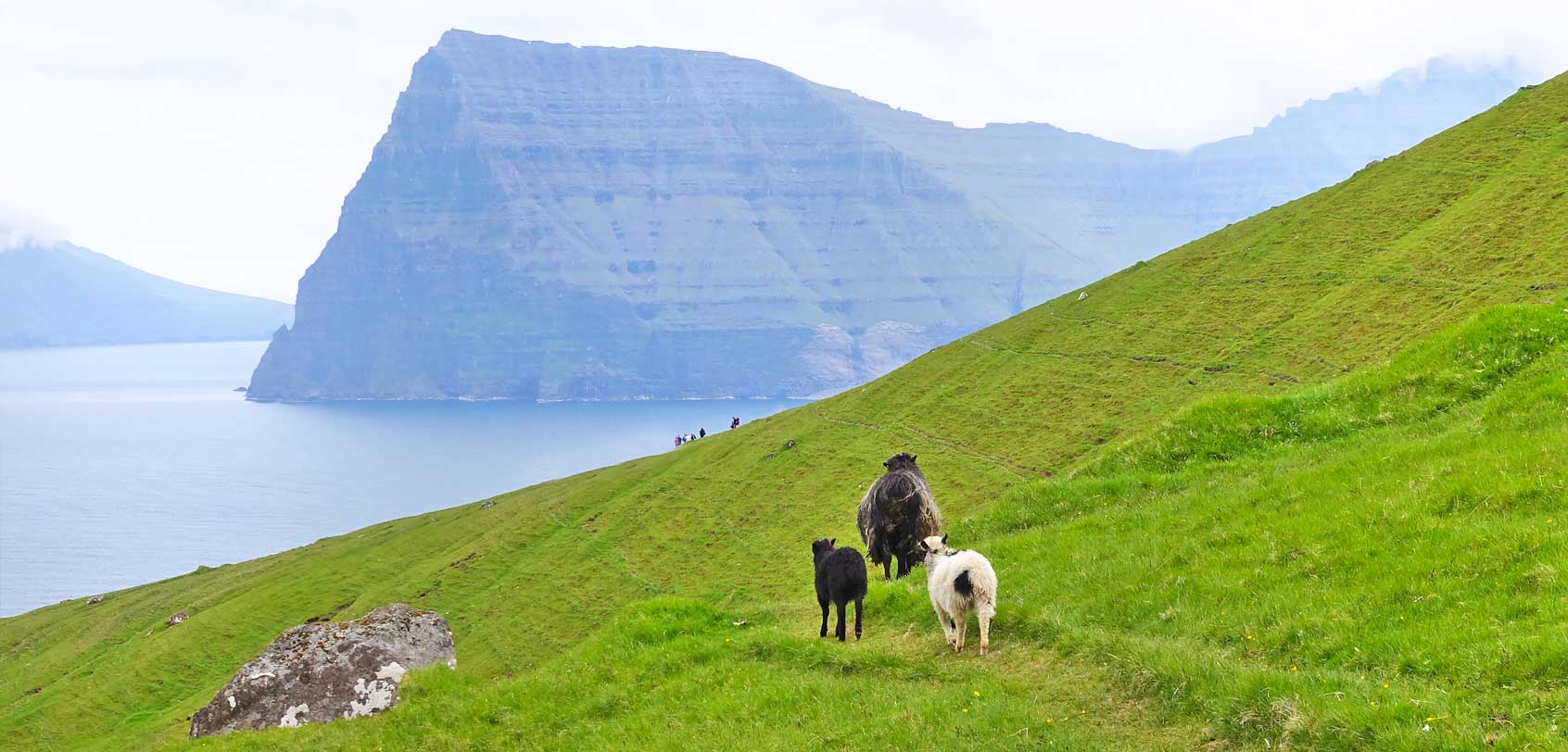
Before we go on, let me give you some quick and basic facts about the Faroe Islands…
- TRIVIA : One of the inhabited islands, Koltur, has only one resident! …Or two, because I keep seeing conflicting info online; but some of the locals said that there’s only one left there. Maybe they were talking about 1 family which are these 2 residents. .
- TRIVIA : The Faroese language is said to be one of the North Germanic languages and it is closely related to Icelandic and the now extinct Old Norse Language. Anyhow, English is widely spoken especially by the younger ones. .
- The sheep are taking over. The nation’s symbol is the ram, and rightly so because the Faroe Islands are packed with 70,000 sheep!!! Remember how there are about 50,000 people living here? Without a doubt… they’re outnumbered! And as a tourist, you’ll certainly find sheep as your typical surrounding companion — much like I have.
Faroe Islands Travel Guide
» quick travel planning.
- Top tours & experiences
- Find flights to the Faroe Islands
- Visa requirements
- Best hotels & hostels
- Travel insurance (5% discount)
- Stay connected
– – –
» Best Time to Visit the Faroe Islands
The weather here can be quite unpredictable. It’s common to somewhat experience all 4 seasons in just one day! But yes, generally, sunny days here are rare because the islands are mostly windy, cloudy, and chilly.
For starters, expect cool summers (with an average temperature of 13°C) and mild winters (with an average temperature of 3°C). I went here in the summer around the end of June and the days can have long hours of sunlight with the sun setting after 11PM or even later. The longest day will be on June 21 spanning at almost 20 hours. As for winter, it can be as short as 5 hours — imagine that!
With all that said, it’s best to visit the archipelago around June to September to enjoy the green scenery. Don’t forget to pack your jacket
- WINTER: Dec to Feb
- SPRING: March to May
- SUMMER: June to Aug
- AUTUMN: Sept to Nov
» Getting in to the Faroe Islands
By air. There are currently 2 airlines that fly to the Faroe Islands. First is Atlantic Airways which has 2 flights per day from Copenhagen, Billund, Aalborg, Bergen, and Reykjavik. Flights cannot be booked through travel websites so you’ll have to book directly on Atlantic Airways website here . The other one is Scandinavian Airlines (SAS) which just started having daily flights to the Faroes.
By sea. Smyril Line’s ferry, M/S Norröna, sails to the Faroe Islands from Hirtshals in the north of Denmark and from Seyðisfjørður in Iceland. It doesn’t sail as frequently though so make sure to check its website for the scheduled departures.
» Where to Stay (Faroe Islands Accommodations)
The central city of Tórshavn is where you will find most of the accommodations and it’s a strategic place to base yourself for all your adventures around the islands. Of course, it can get cheaper if you get places outside of Torshavn, but for the best capital picks, they would be the following:
Luxury : Hotel Foroyar Mid-Range: Hotel Hafnia or AirBnB Budget : Kristjanshavn or AirBnB
» How to Get Around the Faroe Islands
By car. Driving your own car is highly recommended (to make the most of your time) and you can arrange a rental online before your arrival on the islands. Rest assured, you can rent a car (from small cars to SUVs) on-the-spot when you land at the airport since there are stalls there by Sixt, AVIS, HERTZ, and Unicar. Once you start driving around the Faroe Islands, be mindful of the driving conditions and rules because for instance, there are one-way tunnels in the islands and you have to make way for incoming vehicles (you can find all the details here ).
By bus. The main inter-town bus they have is called Bygdaleiðir and they’re easy to spot since they’re big and in the color of dark blue. To see the complete timetable of the buses, go here . It helps to note, however, that public transportation is expensive in the Faroe Islands, so it’s best to buy a travel multiple-ride card beforehand with Strandfaraskip Landsins (the mother company of Bygdaleiðir) at the airport or at the main bus terminal in Torshavn. This travel card already covers busses and ferries around the islands except for Mykines Island and can cost 500 DKK ($70~ / Php 3,500~) for 4-days or 700 DKK ($100 / Php 4,900~) for 7 days.
By ferry or by helicopter. Since this place is made up of islands, some are not connected by roads so you’ll sometimes need to hop on a ferry. The schedules for this can be found on Strandfaraskip Landsins. If a helicopter ride seemingly sounds expensive to you, don’t worry! Here in the islands, the service is subsidized by the government so it’s quite cheap and it is serviced by Atlantic Airways (see the timetable here , and remember, booking in advance is mandatory). With these affordable helicopter rides, I say take advantage of them — especially if you haven’t experienced riding a helicopter before, this could be quite a fun experience.
By bike . Some districts like the capital, Tórshavn, can be explored on the city or sports bikes. You can rent these from Visit Tórshavn which is located in Steinatún in the city center. The cost for a day can start at DKK 150~. To book, just send an e-mail to [email protected] or call (+298) 302425.
» Packing Guide
If you’re coming around May to September to the Faroe Islands, you should pack for chilly weather so your bare essentials should be a sweater, a raincoat, and a set of good comfortable (hiking) shoes. If you’re like me who can get cold quite fast, go and pack a warm hat or even some gloves just in case!
Of course, if you visit around winter or the colder months, your clothing essentials will be different. The same goes for when you’re coming here mainly to camp or hike.
» Visa for the Faroe Islands
Even if the Faroe Islands are connected to the Danish immigration policies, as I’ve already mentioned above, there are some different factors to take note of. So…
- If you come from a Nordic country: showing off your document of identification with a photo is enough to enter the islands.
- If you come from an EU (European Union) or Schengen country: if you’re an EU citizen, you may enter with just your ID card with a photo. However, EU residents are not part of the entry scheme because you must be a citizen (so for instance, it follows that if you have a Danish residence permit, you still need a visa to the Faroes). If you have a Schengen visa or Danish visa, it is NOT applicable for entry to the Faroe Islands — you still need to apply for a separate visa that is specific to the islands (the requirements will be similar to obtaining a Danish visit visa ).
- If you are of any other nationality: naturally, you need to apply for a Faroe Islands visa (remember: NOT a Schengen visa) at the Danish embassy in your country of residence — unless your nationality is exempted from getting a Danish visa then you can enter the Faroe Islands.
» Faroe Islands Currency
Króna (kr) is the currency of the Faroe Islands and it is issued by the central bank of Denmark. It’s not a separate currency but a local issue of banknotes denominated in the Danish krone.
- How to best exchange your currency? Either exchange it at a bank or at a money exchanger in your home country or in the city center. Better yet, just withdraw from an ATM with your debit/credit card — however, you must do one big withdrawal to minimize fees with your bank. Speaking of cards, a lot of the establishments accept credit cards but it’s always advisable to have cash on hand because a lot of smaller shops do not accept international credit cards.
» Cost of Travel in the Faroe Islands
To give you an idea for your Faroe Islands itinerary, you should expect to travel in the islands with an average daily cost of about USD $60~ per person on a budget, or at least $150~ if you want to experience more comfort in activities, tours, hotels, and more. (Values below show low budget to medium budget ranges).
- Hotels: $25 to $65 USD / day
- Food: $17 to $40 USD / day
- Fun: $10 to $30 USD / day
- Transport: At least $10 for local transportation
» Local Tour Operators
In case you don’t like to DIY your trip and you want to have someone take care of everything for you, I suggest that you book through local operators in order to help support the Faroese economy. Some of them are as follows:
» Helpful Norwegian Phrases
The official language of the Faroe Islands is Faroese which is a Germanic language that descended from Old Norse. Since they are within the Kingdom of Denmark, the locals also speak Danish. Rest assured, most of the people can speak English (sometimes even German and Norwegian). All in all, it doesn’t hurt to learn a few of the local phrases.
- RELATED READ: Best translation apps for travel
Hello : Halló (hahloh) Thank you: Takk fyri (Takk fi-reh) or Takk ( Takk) Yes : Ja (Ya) No : Nei (Ney) Goodbye : Farvæl (Far-vyel)
I’m sorry : Orsakið meg (Or-sha-kee mey) Excuse me (getting attention): Orsaka (Or-sha-ka) Excuse me (begging pardon): Umskylda (Um-shil-da) How much does that cost?: Hvat kostar tað? (Kvat kost-ar tay?) Is there someone here who speaks English?: Dugir nakar her eingilskt? (Du-cheer nak-ar her ain-gilsk?) Help!: Hjálp! (Yolp!) Cheers!: Skál! (Is-kol!)
Faroe Islands Itinerary
NOTE: The following section is in a tabbed format; so, in order to see the next day’s contents, just click the headings below.
Explore parts of Vágar and Streymoy Islands
After you land and pick up your rental car at the airport, I highly advise that you don’t go straight to Tórshavn yet (which is likely where your accommodation will be) because there are some nearby spots around the airport that are worth looking into!
You might be thinking, “ I can visit those later! ” — sure you can, but the thing is… they’re quite far and to save time, I think it’s best that you visit them ASAP while you’re in the vicinity because they can be quite far from everything else. Otherwise, you can visit them on your last day on your way to the airport, depending on your scheduled flight back.
◘◘ Visit Sørvágsvatn Lake
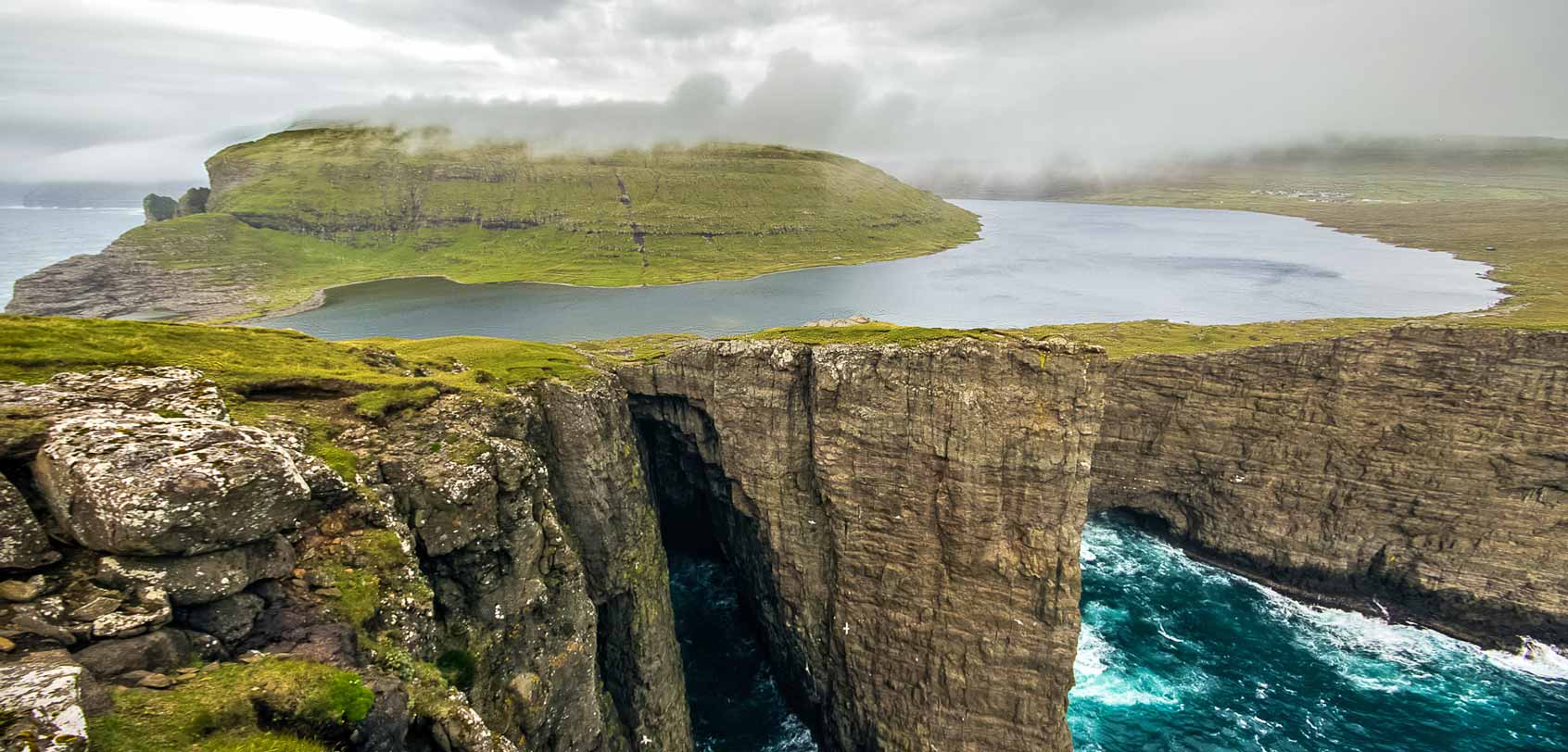
If you want to see one of nature’s mind-blowing ‘optical illusions ‘, make sure that you drop by Lake Sørvágsvatn (also called Leitisvatn) as a part of your Faroe Islands itinerary.
It is the largest lake in the Faroe Islands and it has been dubbed the “ lake over the ocean ” — this is because if you go up a certain angle, it will appear as though the lake is floating directly above the ocean! The lake is just 40 meters above sea level with a magnificent waterfall at the end of it that’s called Bøsdalafossur.
To get here, set your GPS and near the location or by the church in Miðvágur, you will find signs to “Trælanípa/Bøsdalafossur”. Follow these signs until you find a parking spot. You will then find a gate and you must start walking from here to the south towards the ocean by following the gravel path. The hike takes about an hour (one way) and in order to get to the spot that shows the iconic ‘illusion’, you must go to the southern tip (not on the southwest end of the lake).
You will know if you’re in the right place when you see 3 small sticks sticking up or if you see a steep hill. ( Doesn’t matter if you end up at the wrong vantage point because every angle is stunning here! But if you really want some more specific instructions, go to this page and scroll to pages 36 to 37. )
◘◘ Drive to Gasadalur to see Mulafossur Waterfall
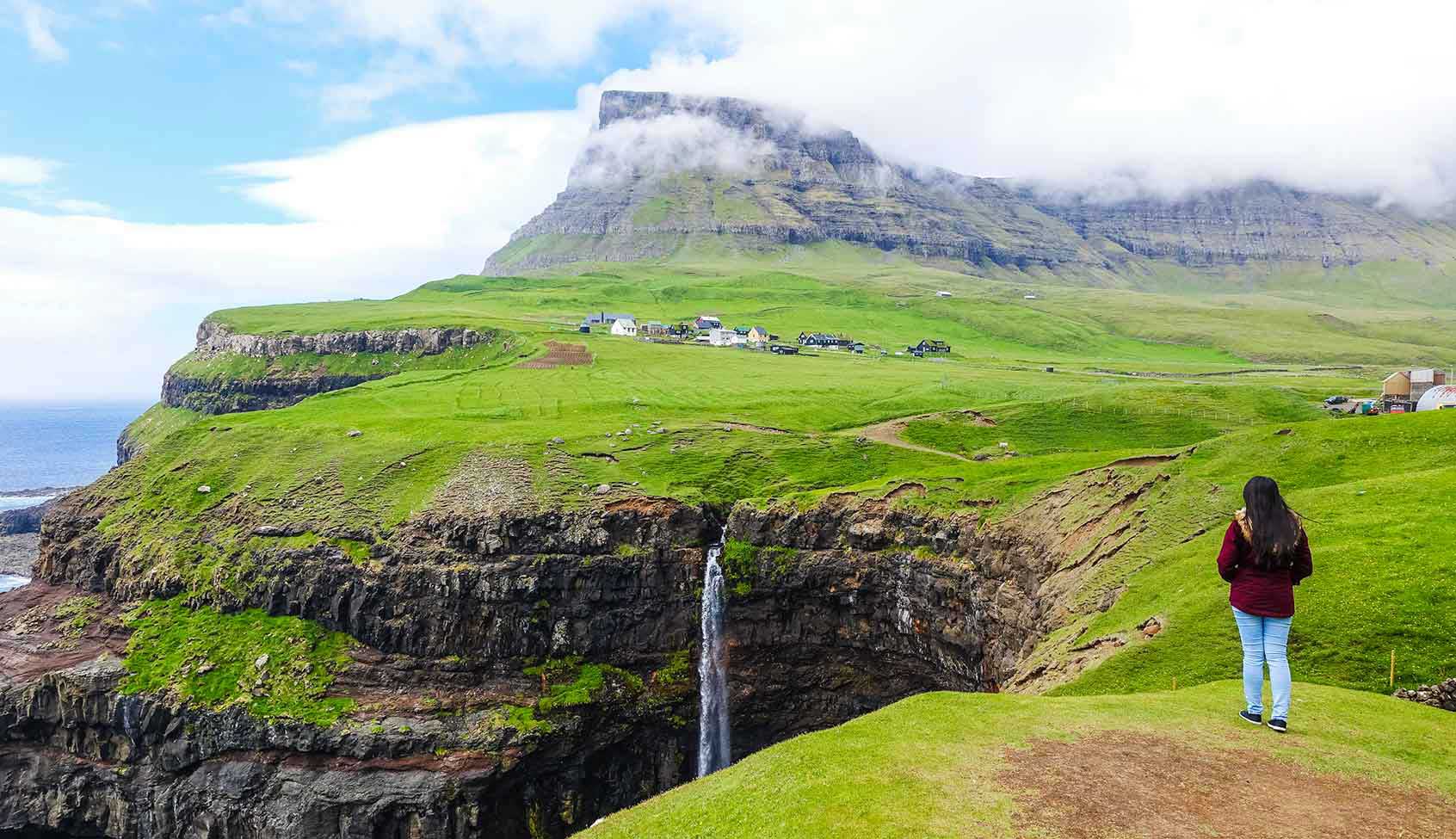
This is yet another iconic landscape in the Faroe Islands which is just an 18-min ride away from Vagar Airport. As you will see from the photo above, the Mulafossur Waterfall is a grand sight! It is nestled within this small village of Gasadalur and there are 2 ways to see it: with minimal effort and with some effort.
What do I mean by this? You can see this glorious spot by car as you do some short walking from the main road; or if you’re a dedicated hiker, you can do a hiking trail that the villagers used to take before the car tunnel was built.
TRIVIA : Gasadalur used to be one of the most isolated places in the islands. Residents had to hike through 700-meter mountains just to get in and out of the village! After the car tunnel was built, access to the town got a lot better, but to date, the residents here still number at only 18!
Since I didn’t have much time (and a bit tired from my flight), I opted to just drop by here with my car as I enjoyed the waterfall and do a bit of strolling in the village itself. If you want some more detailed tips for this place, like how to find the trail that leads to this vantage point and how to do the longer hiking trail itself, check out my guide found here: Gasadalur & its Mulafossur Waterfall
◘◘ Check in to your hotel
The central city of Tórshavn is where you will find most of the island’s accommodations and it’s a strategic place to base yourself for all your adventures around the islands. But of course, it can get cheaper if you get places outside of Torshavn, but for the best capital picks, they would be the following:
Luxury : Hotel Foroyar Mid-Range: Hotel Hafnia or AirBnB Budget : Kristjanshavn or AirBnB
I stayed over at a guesthouse with a local though and unfortunately, it’s not really a place you can book — but I wish it was because the house was in the traditional style and it was so cozy with a great view of the sea and a river!
◘◘ Explore the village of Saksun
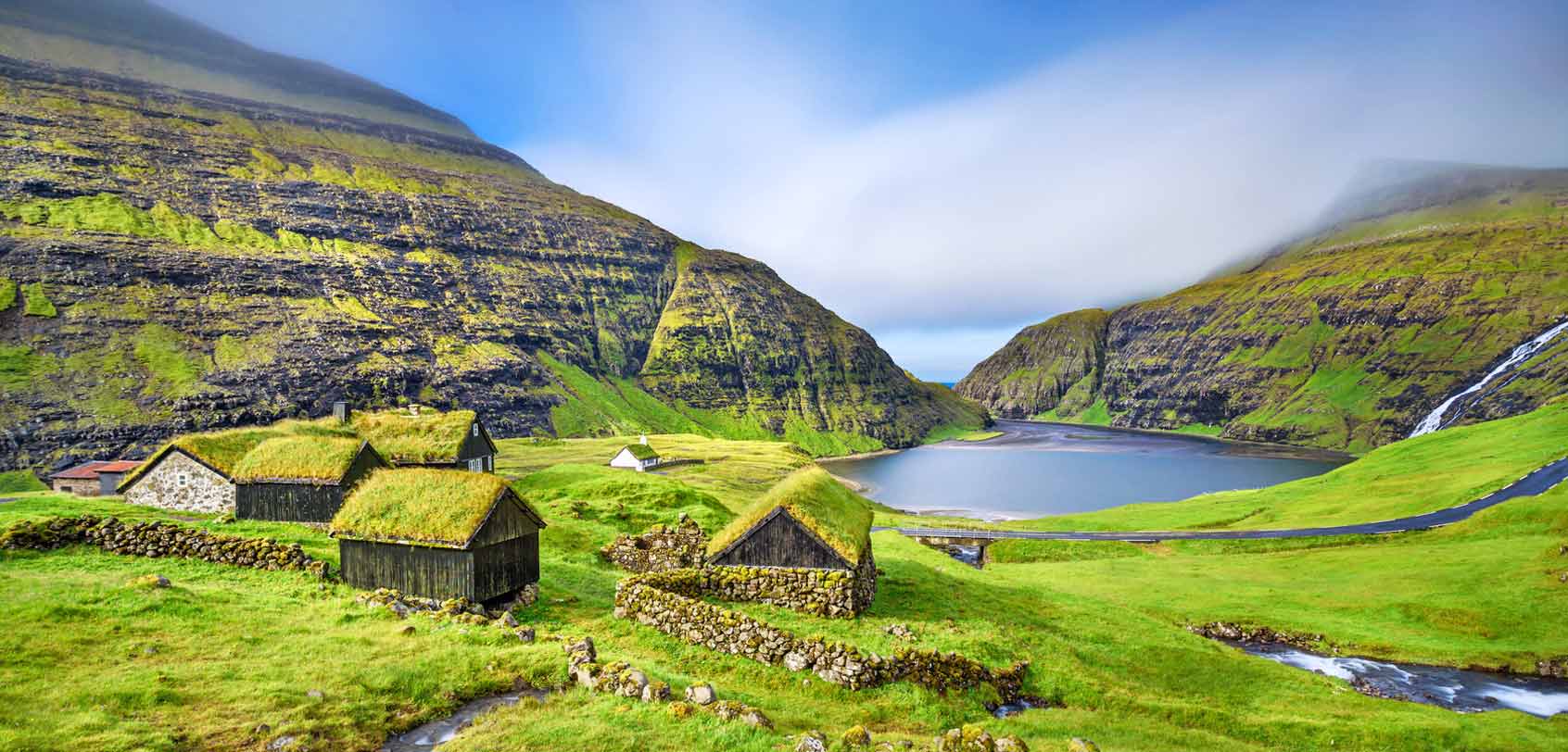
Like a natural amphitheater, Saksun is a splendid remote hillside village that is known for its serene atmosphere. The place where it lies now used to be a deep inlet in the sea (fjord) and during low tide, you can walk along the lagoon’s sandy shore which is found at the foot of the village.
Whilst here for your Faroe Islands itinerary, as one of your things to do, make sure you check out the village’s church and Dúvugarðar, a farm that houses 300 ewes — which also functions as a museum.
◘◘ S ee Fossá waterfall

This is the largest waterfall in the Faroe Islands at a height of 140 meters. Located near the village of Haldarsvík, this waterfall has two cascades that fall down to the sea.
If I may share a tip, it’s best to come here after some heavy rainfall because that’s when it becomes even more spectacular!
TRIVIA: Fossá in Faroese means “river with waterfalls”
◘◘ Dine at Barbara
As the night falls, you can choose from an array of restaurants that speckle the city of Tórshavn; but if I may suggest, go and dine at Barbara Fish House ! It has a great menu that consists of Faroese seafood dishes; plus, the place itself is quite charming given that it is built into the rocks.
Discover Kalsoy and Gjógv
Rev up your car, wear good shoes, pack up some food, and sail to the nearby island of Kalsoy for your Faroe Islands itinerary!
You can spend a whole day here exploring its various sights. If you still have time by the end of the day, you can drop by the charming village of Gjógv.
◘◘ Take the ferry to Kalsoy
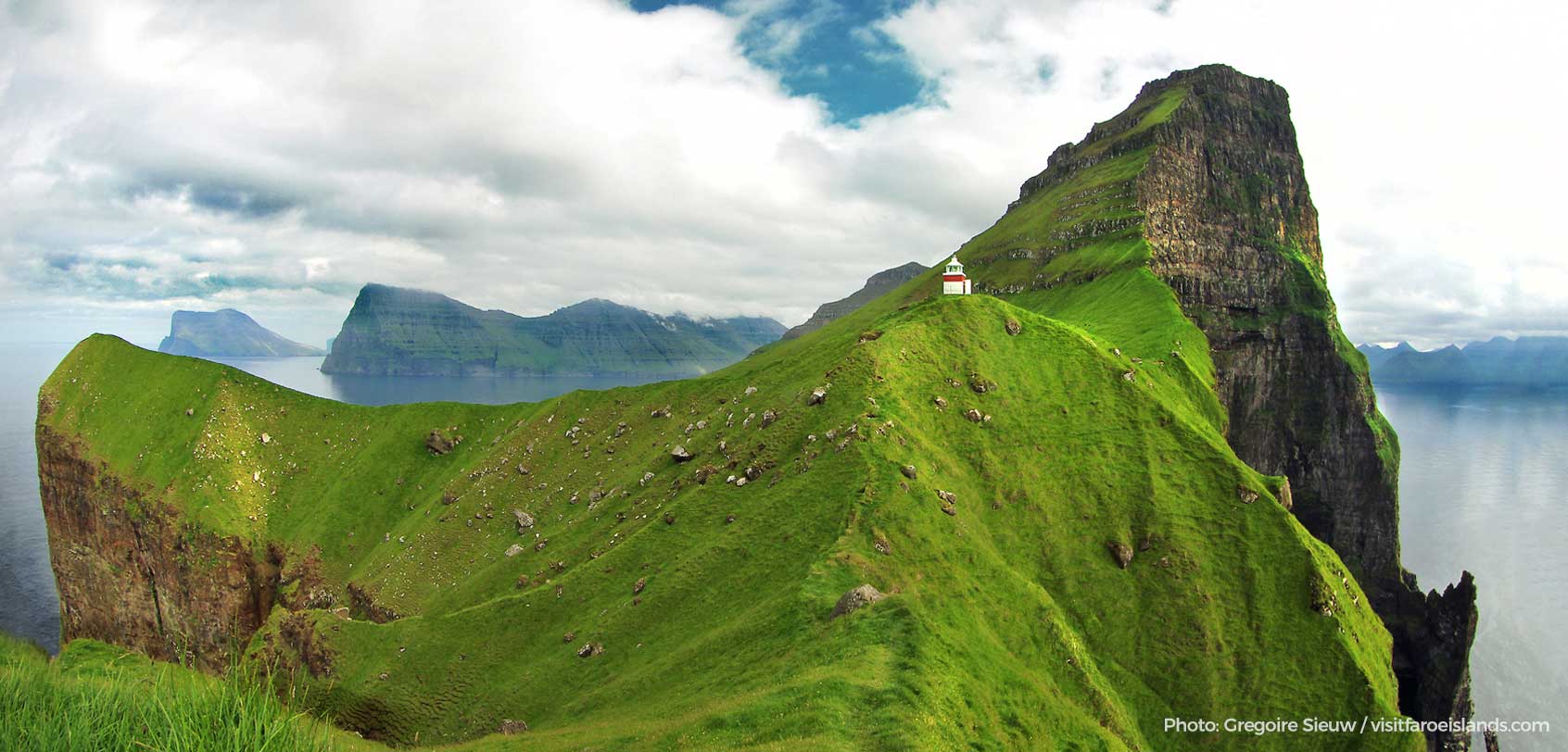
Kalsoy is like a flute-shaped island due to its thin shape. You can reach it by ferry along with your car by driving from Tórshavn to the port of Klaksvík (this is a 1-hour drive).
It’s best to catch the first or earliest ferry to Kalsoy’s Syðradalur port so that you’ll have enough time to explore the island. To check the timetables, see this page (take note of the departure times as well so you can time when you will have to drive back to the port).
Note: it’s not possible to book in advance so you have to pay on the spot (DKK 160 for one vehicle), and if you’re coming with your car, make sure you arrive there 15 minutes before departure.
Once on the island, there’s no need for maps because there is but just one highway with lots of tunnels — make sure that you watch out for sheep because they can come up anywhere and block the road, seemingly seeking some sort of showdown.
First up on your list for this day of your Faroe Islands itinerary, I recommend that you go straight to the north to Trøllanes not only to see the surroundings of the village but to also hike up the mountains to see Kallur lighthouse because the view here is superb. I actually had a hard time finding the trail that leads to this place because there are no signs that lead me to it. Thankfully, my companion and I saw a tour group by the road who were headed to the lighthouse and they gladly invited us to join them.
Basically, somewhere on the road before the village, you will find a small red gate along the fence. This is closed but you can open it — most of the gates on the island are closed not for people, but for sheep.
Once inside, you just have to climb up the hill in the north direction until you see the white Kallur lighthouse . With this in mind: make sure to wear good and comfortable hiking shoes! Rest assured, the climb up isn’t that hard but it can get a bit steep.
On the way back, make sure that you stop by the village of Mikladalur to visit Kópakonan , or the “Seal Woman”, which embodies one of the popular folktales in the islands. Made of bronze and stainless steel, it stands above a rock near a waterfall with a great backdrop of the mountains and the sea. The legend that surrounds this is quite sad and dark though and you can read all about it here.
TIP: Pack your own lunch and snacks because I had a hard time looking for a restaurant in Kalsoy. There was a canteen in Mikladalur but it only served snacks.
◘◘ Visit Gjógv

Just an hour away from Tórshavn, this is the northernmost village on Eysturoy island.
Nominated by the Nordic Council for the Nature & Environmental Award in 2014, this well-preserved town is nestled by mountains on all sides and filled with traditional houses that are made of timber and turf roofs. For those who are fond of hiking, there are also several trails for you to do here!
What’s one thing that you absolutely must NOT miss? it would be the natural harbor that they have which is a picturesque gorge.
◘◘ Dine at Aarstova
Once you’re back in the capital, have some more classical Faroese dishes — but this time around, try some fine dining at Aarstova !
All About Mountains
The way I see it, the Faroe Islands is a hiker’s dream paradise! In fact, almost all of the best landscapes can be seen via hiking.
But for those who don’t have the stamina for such things (like me) , don’t fret because there are hiking trails that are at an easy level.
Though of course, if you could push yourself — by all means, do so! I have done a difficult hike up the mountain of Villingardalsfjall , and I was so glad that I pushed myself to do it even if my legs were about to give way. After all, the view that I saw up high was one of the most jaw-dropping landscapes that I’ve ever seen in my life!
» READ: Hiking Trails in the Faroe Islands
Anyhow, if you think you can’t really do any moderate to high-level hikes during your Faroe Islands itinerary, you can spend this day visiting the villages of Saksun or Gjógv if you haven’t managed to do so in the past few days. You can even revisit the past spots I’ve mentioned if the weather became a lot more favorable for this day.
◘◘ Go up Slættaratindur
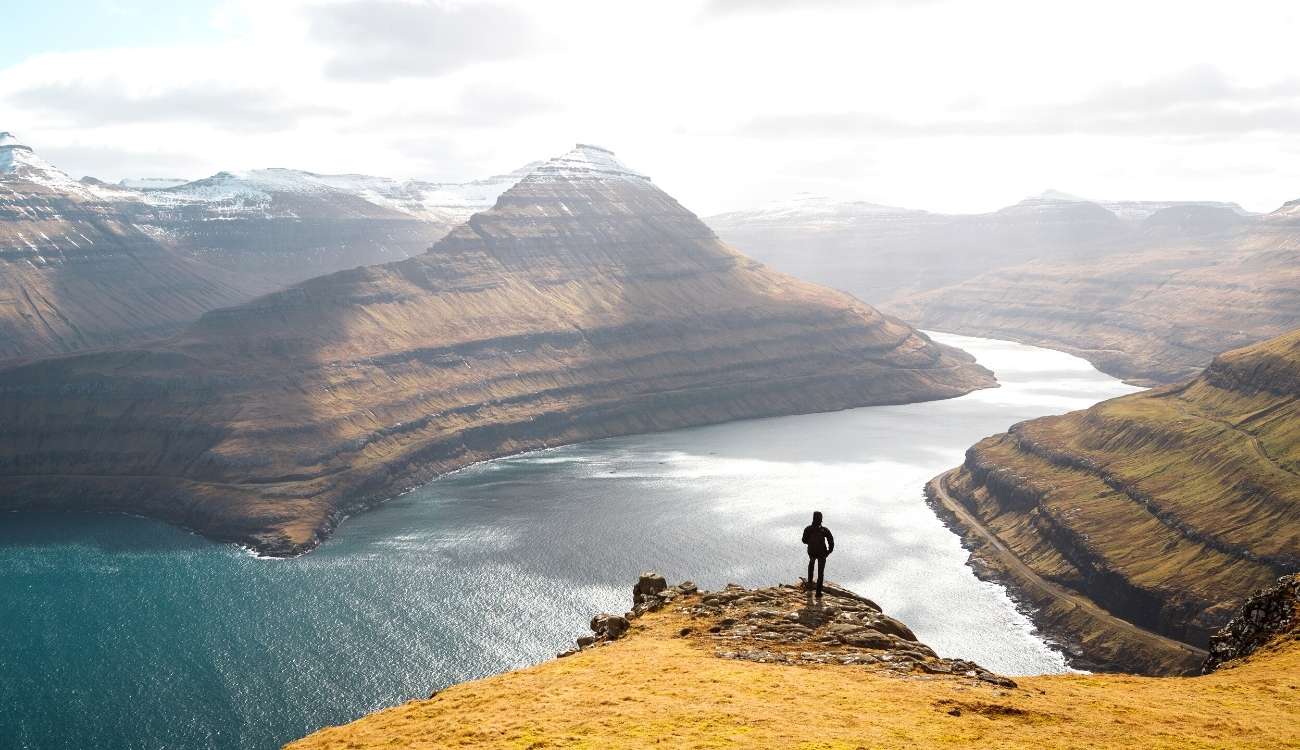
(Hiking difficulty: medium) Towering at 880 meters, Slættaratindur, or “flat summit” is the highest mountain in the Faroe Islands so it’s an absolute must-see!
According to Guinness World Records, this is the world’s longest sight line because due to the light bending effects of the atmosphere, the largest glacier in Iceland called Vatnajökull can be seen from here on a clear day (aside from the fact that you can have awesome views over the whole Faroese archipelago).
For complete hiking instructions, go to this page and scroll to page 22 to 23.
◘◘ Conquer Mt. Villingardalsfjall
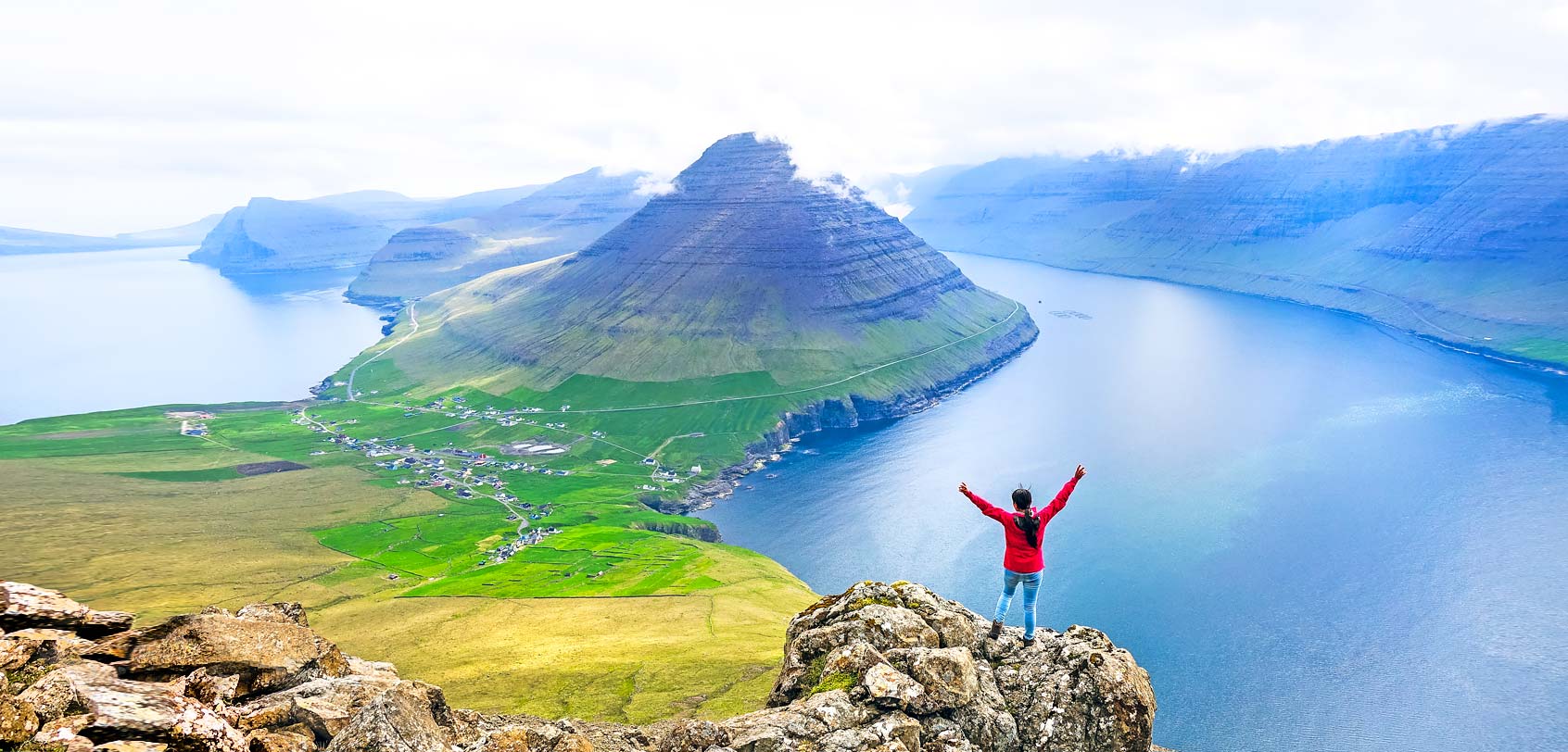
This is the hike that I was talking about — as a non-hiker, this has been one of the most difficult hikes of my life but also one of the most rewarding (together with Norway’s Trolltunga ) !
The whole hike to the top takes 3 to 4 hours with a distance of 6 kilometers yet at a steep height of 841 meters. I can talk on and on about this place, but I think it’s best that you read my blog post below to read more about my experience as well as to see the other views you will witness from its summit:
RELATED READ: Hiking Faroe Islands’ Stunning Mountain of Villingardalsfjall
◘◘ Go on top of Sornfelli Mountain
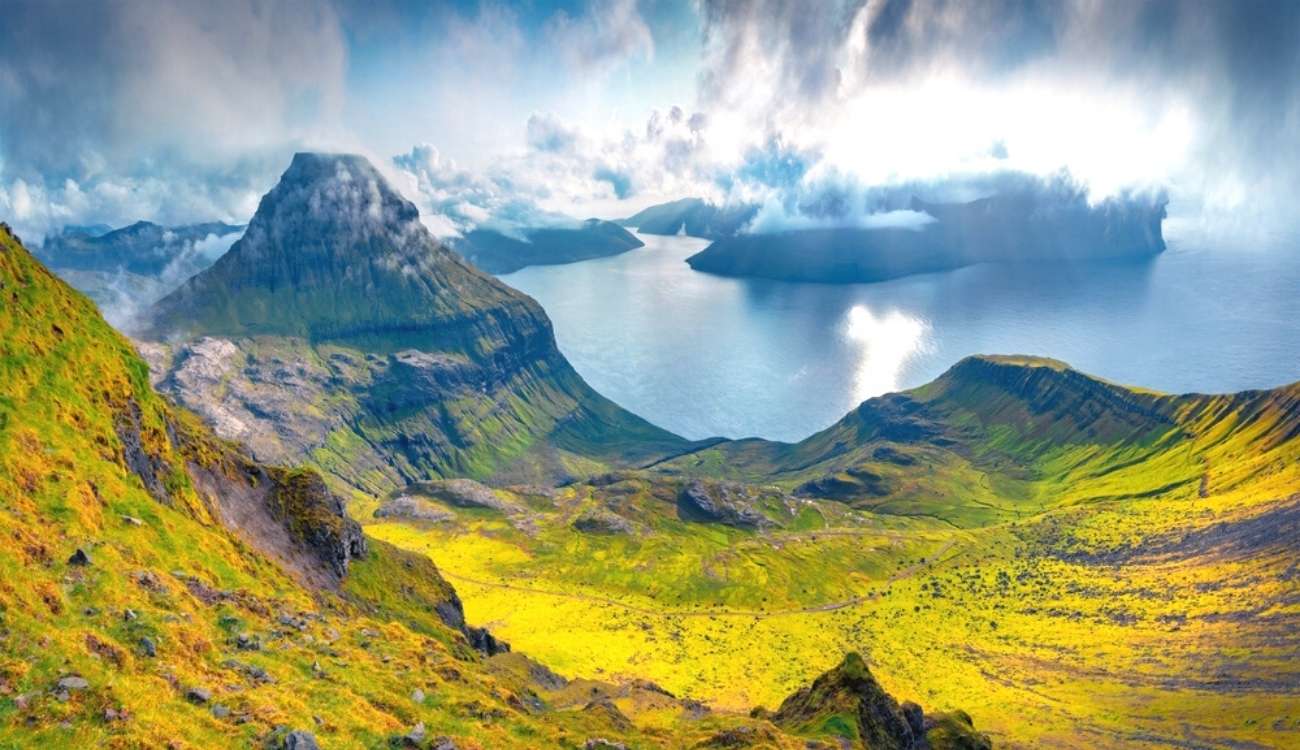
Good news: this does NOT involve hiking so it’s a great addition to your Faroe Islands itinerary.
The top of this mountain plateau near Hotel Føroyar can be reached by car and reaching its amazing viewpoint will only take you a 30-meter walk.
A Mykines Kind of Day
Mykines island is a favorite in the Faroe Islands!
For your Faroe Islands itinerary, you’ll need a whole day for this mostly because the transportation to the island usually only happens in the morning and the ride back in the afternoon. Regrettably, when I visited here, the weather wasn’t good. In fact, once we arrived at the island, we were stranded in a small cafe together with other tourists as we waited for the heavy rain and strong winds to pass.
It still ended up as a great day though because we met a lot of interesting individuals — one of which was a well-known harp player from Ireland who was on tour at that time and who gladly played songs for everyone. Still and the same, before leaving the island, my companion and I braved the rain so that we could at least glimpse at the cute puffins that live on the cliffs!
Anyhow, it’s my wish that you get a good day so that you can see the great sights below.
◘◘ Explore Mykines
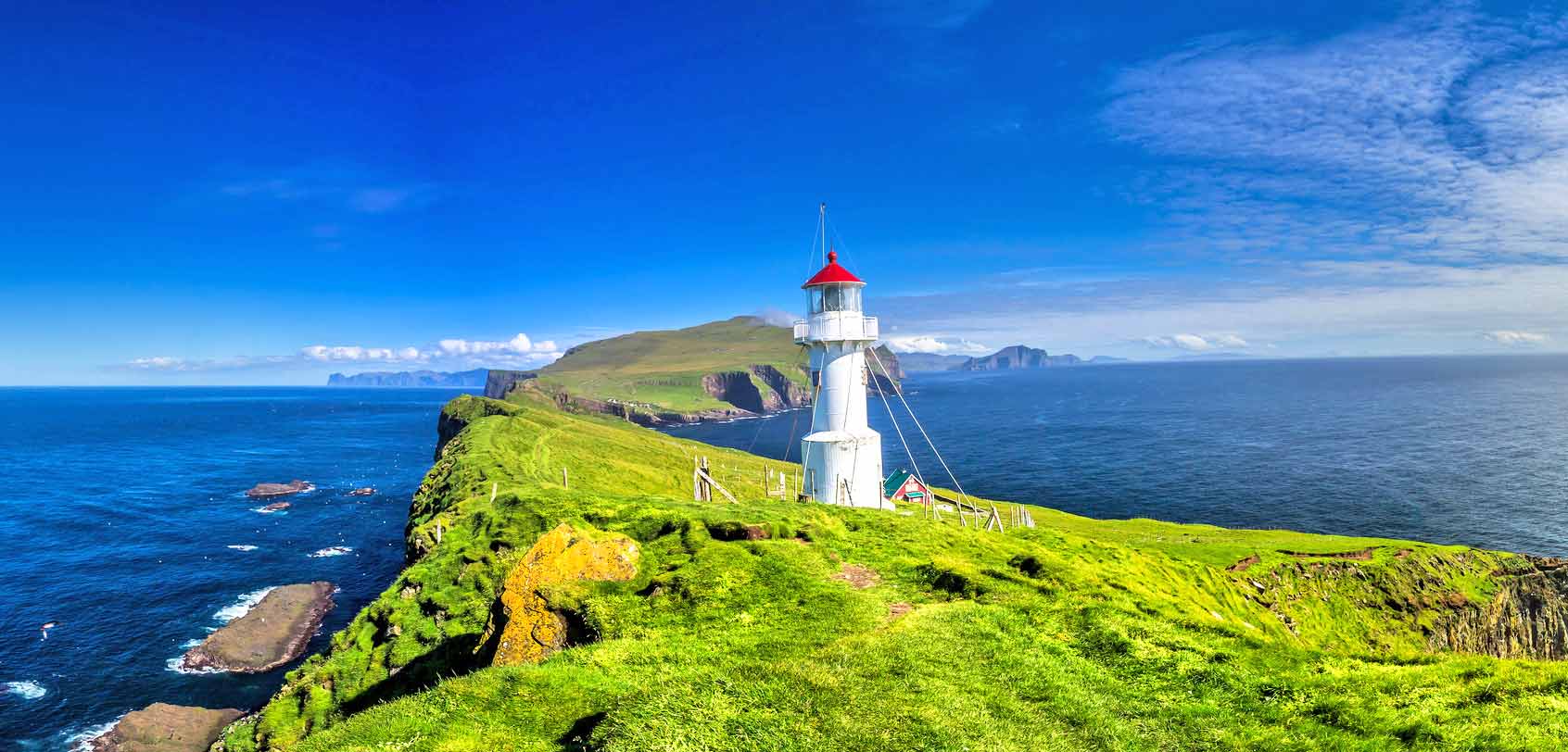
There are 2 ways to reach Mykines for your Faroe Islands itinerary: by boat or by helicopter .
Remember how I said that helicopters are subsidized by the government of the Faroe Islands? With that in mind, I highly suggest that you take a one-way helicopter trip to this island by booking in advance! I say one way because Atlantic Airways’ helicopters mainly service a round trip route to Mykines in the mornings only from Vagar Airport — so unless you want to spend a night here or two, then feel free to book that round trip ticket.
To see the complete timetable, see this page. For the boat or ferry, timetable can be found here .
Once you’re on the island, you can hike from the old turf-roofed-filled village to the lighthouse which is at the western end of the islet of Mykineshólmur.
If it’s summertime, make sure to visit some clifftops to see an endless sea of cute puffins nestled in the burrows. After all, this is called the “paradise of birds” so take advantage of this fact and do some birdwatching while you’re there!
As you wait for your ferry back to Torshavn, take your time exploring the small village. One important thing to take note of though is that if you take a helicopter to the island from Vagar Airport, the ferry will land somewhere else and it’s at the port of Sørvágur — so if you parked your car at the airport, you have to do a 20-minute walk back, or you can take the 300 bus . (Details here ).
TIP: Much like Kalsoy, it’s advisable to pack your own lunch and snacks. There’s a small cafe in the middle of the village but it mostly serves light food. NOTE: Just recently, a new policy has been set that tourists have to pay DKK 100 to travel to the Mykineshólmur lighthouse for maintenance of the birdlife and nature on the island. This fee includes a certified guide to ensure that everyone sticks to the path and not disturb any of the local fauna. For more information, you can contact the Visit Mykines office.
◘◘ See Kirkjubøur

Assuming that it’s summer, by the time that you come back to the main island, it will still be light outside so if you could, make a stopover at Kirkjubøur .
One notable attraction that you must see here is the huge black building at the center of the village that is called Kirkjubøargarður. It’s arguably the oldest inhabited wooden house in the world with over 17 generations of the same family that’s living there (there are sections that are turned into a museum). It even once housed the episcopal residence and seminary of the Diocese of the Faroe Islands.
You could also visit the old churches that they have such as Magnus Cathedral and Saint Olav. And if you go by the shore, you will see two old stone houses.
Before capping the night, while you’re already in the area…
◘◘ Have dinner at KOKS
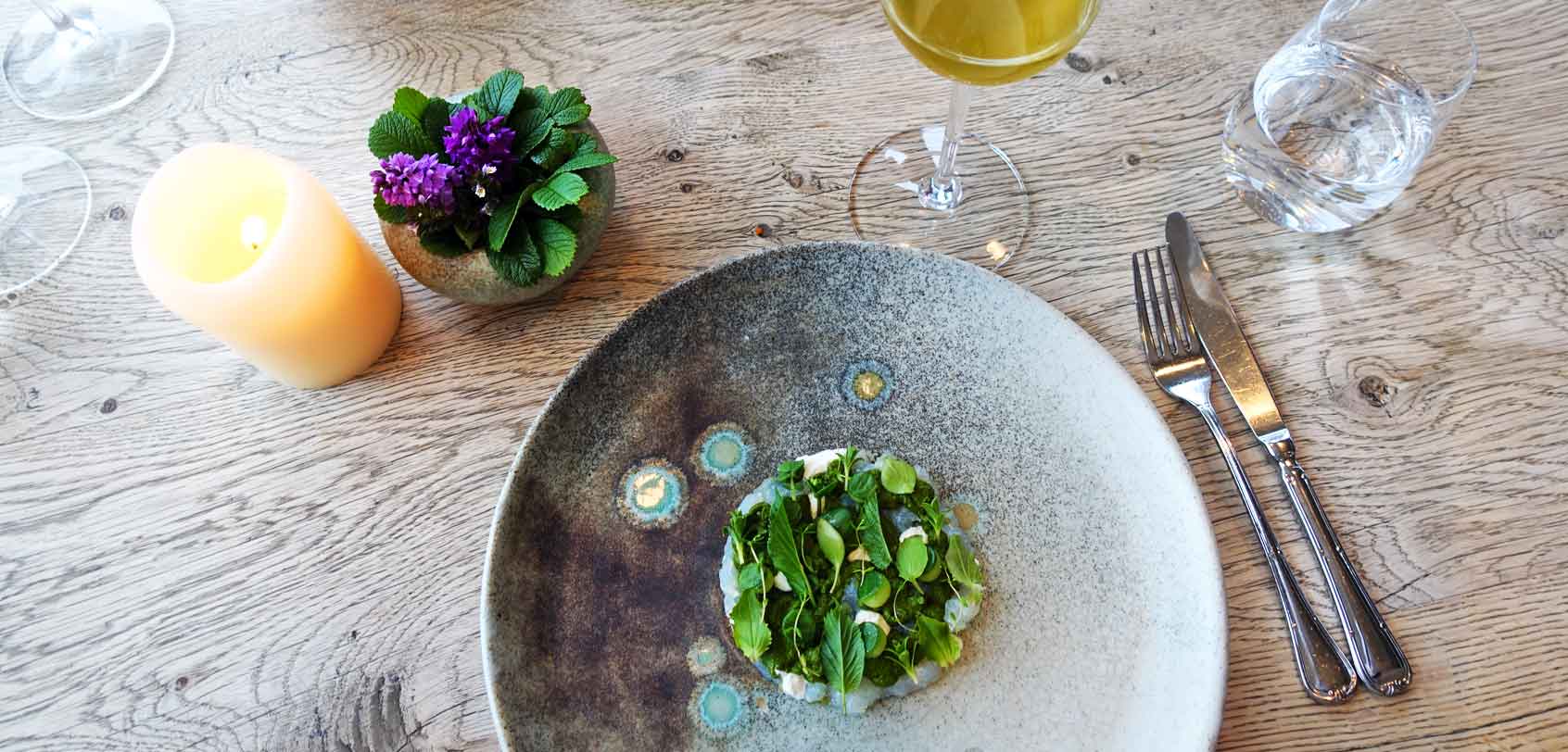
I highly recommend this restaurant since I have dined here myself!
What’s special about KOKS ? Well, it has been awarded the best restaurant in the Nordic countries in 2015 by the Nordic Prize; plus, it is also the first and the only Michelin star restaurant in the islands.
As a stop on your Faroe Islands itinerary, you’ll love how this restaurant only uses local ingredients, plus it is in a private house that has been turned into a guest room. It also has an open kitchen where you can watch the chef and his assistants cook (but there is a bigger kitchen in the back).
Dining here is obviously not cheap, but if you have the money to spare, I urge you to give it a try. I’ve dined all over the world and this is one of the best places I’ve eaten in. Besides, they surely know how to do pairings!
Basically, dinner here is a tasting menu and you can choose to pick your own drinks or choose their wine pairing or juice pairing set — YES! You read that right, juice pairing!
This might sound boring to you but their juice pairings were simply phenomenal. I never thought that fresh juices can be mixed in such ways that would perfectly complement a dish.
Aaaah… simply put: I hope you get to try it to experience a truly gastronomical feast.
Explore the rest of Tórshavn
We’re now on the last day of your Faroe Islands itinerary and I think it’s time to fully explore and enjoy the main capital of Tórshavn.
Let yourself get lost in the city’s small streets; if not, you can take your pick from the array of activities below as some of your things to do in Faroe Islands…
◘◘ See Tinganes and the center of town
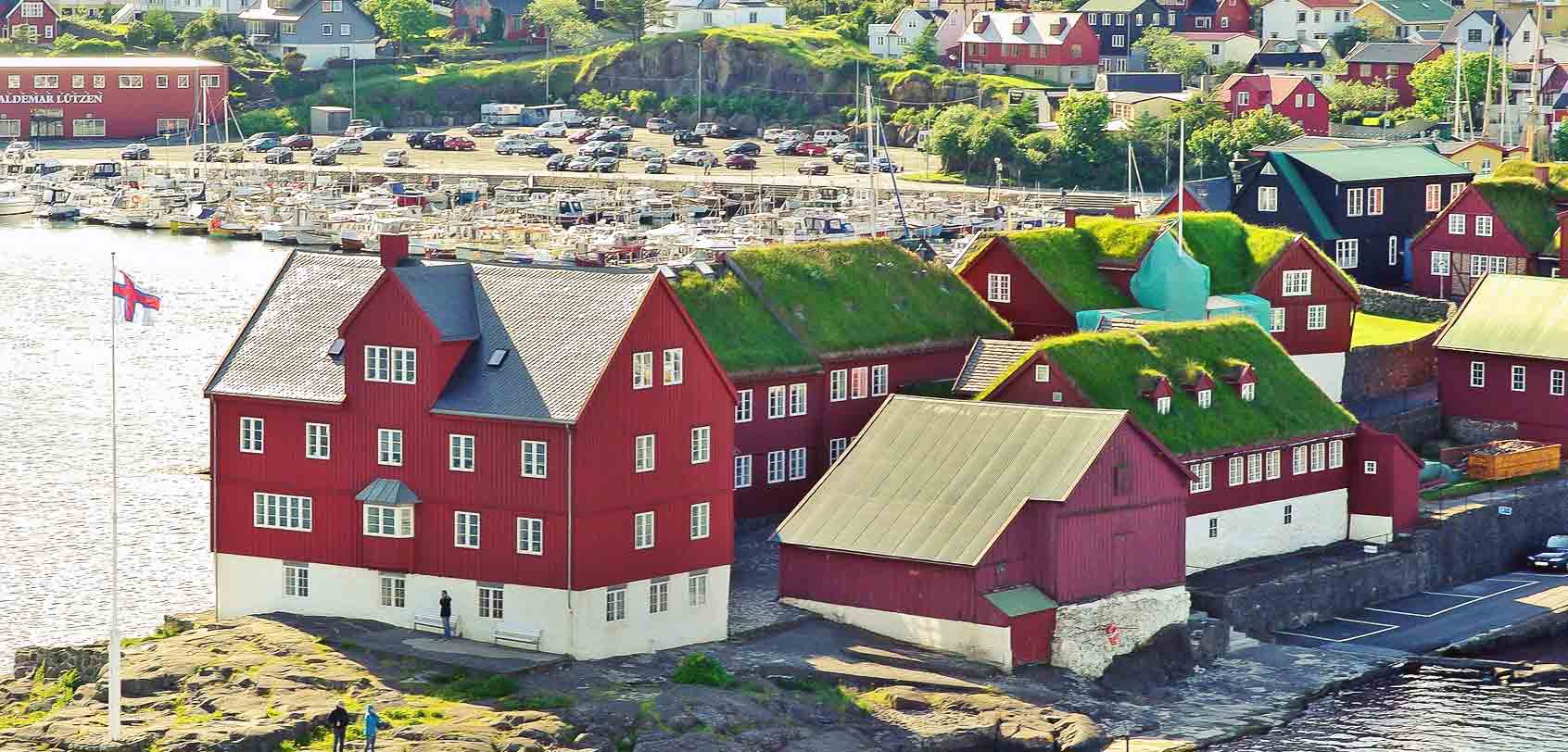
Tinganes is an area where you can see a beautiful clutter of red wooden houses.
These are one of the oldest parliamentary meeting places in the world that once functioned as meeting places for Vikings. Today, it houses the office of the prime minister. You will rather find the Faroese parliament — the Løgting (‘Law assembly’) — a few streets down.
What’s great about this area too is that there are enough signs and plaques to explain the history of the place.
◘◘ Shop for souvenirs at Öström
Go over to the waterfront and you will this store that’s housed in an old factory building. They sell products made on the islands such as traditional clothes, wool sweaters, postcards, posters, and other design products.
For sure, it’s worth looking into during your Faroe islands itinerary!
◘◘ Try horseriding
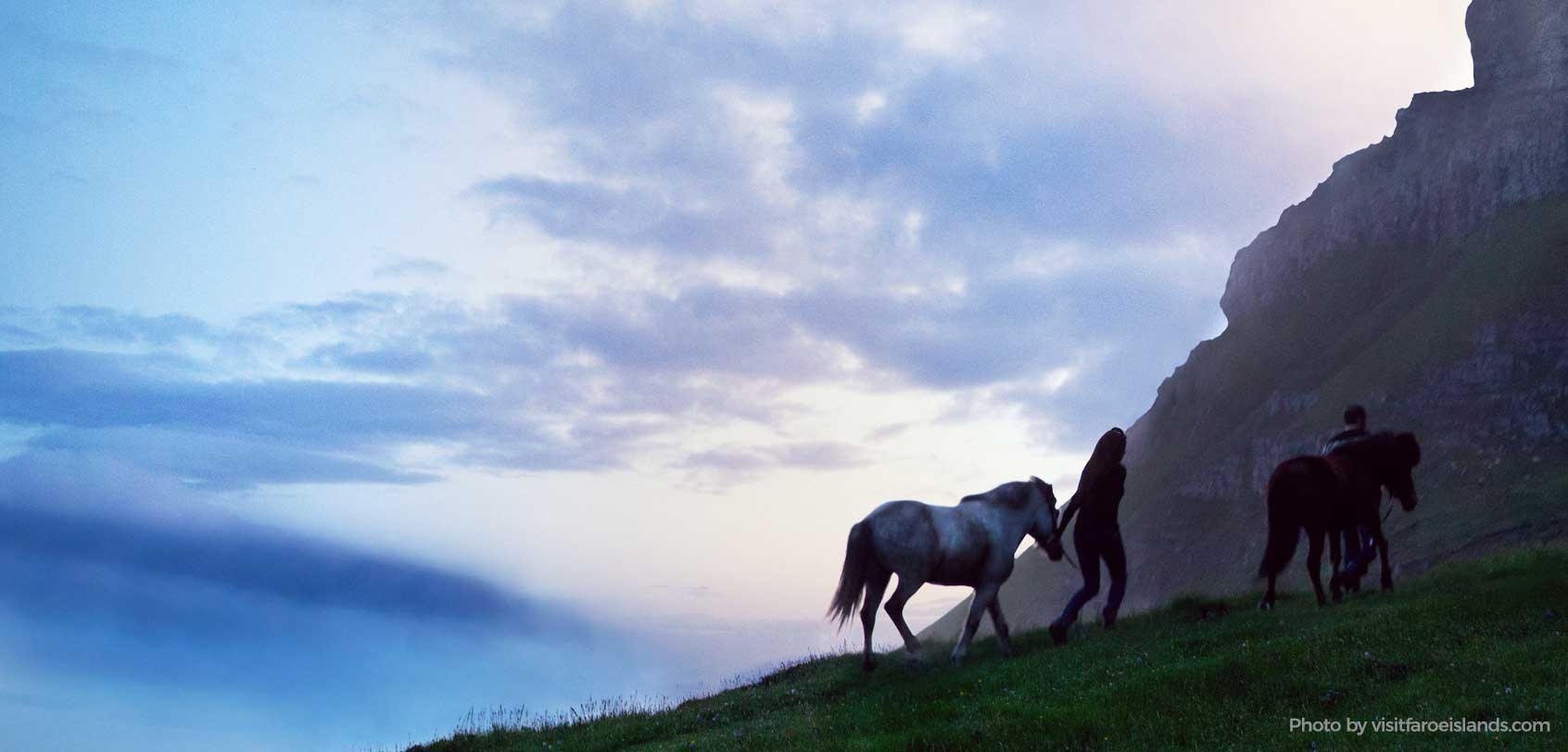
You can experience a magnificent horseriding experience in and around Tórshavn and you can do it with the tour provider, Berg Hestar , who uses Icelandic horses.
The experiences vary in difficulty and price range but take note that it’s only allowed for 7 years and older. To protect the horses, there’s also a weight limit of 95 kilos. To book your spot(s), check their website here.
◘◘ Sail with RIB62 to Hestur
This experience will grant you a unique perspective on the Faroe Islands as you sail by the most remote and breathtaking sights that the islands have to offer — one of which is to circle around the nearby island of Hestur .
RIB62 tailors tours upon request every day of the week so feel free to contact them for inquiries. (Departure for this boat tour is from Gamlarætt which is 15 minutes away from Tórshavn).
Wondering where to dine in the Faroe Islands or the local dishes that you must absolutely try? . Check out this blog post to find out: Top Faroe Islands Restaurants .
Booking Essentials

TIP: It’s a good idea to crosscheck the prices with other popular travel insurance providers like World Nomads and HeyMondo (as my reader, you get 5% off)! . However, take note that a travel insurance’s affordability typically means lesser coverage; so please always ensure that you read the fine print in order to decipher which travel insurance company is the right fit for you and your trip!
The Best Tours in the Faroe Islands?
Come and check out this list of the top things to do in the Faroe Islands which features the best activities and tours!
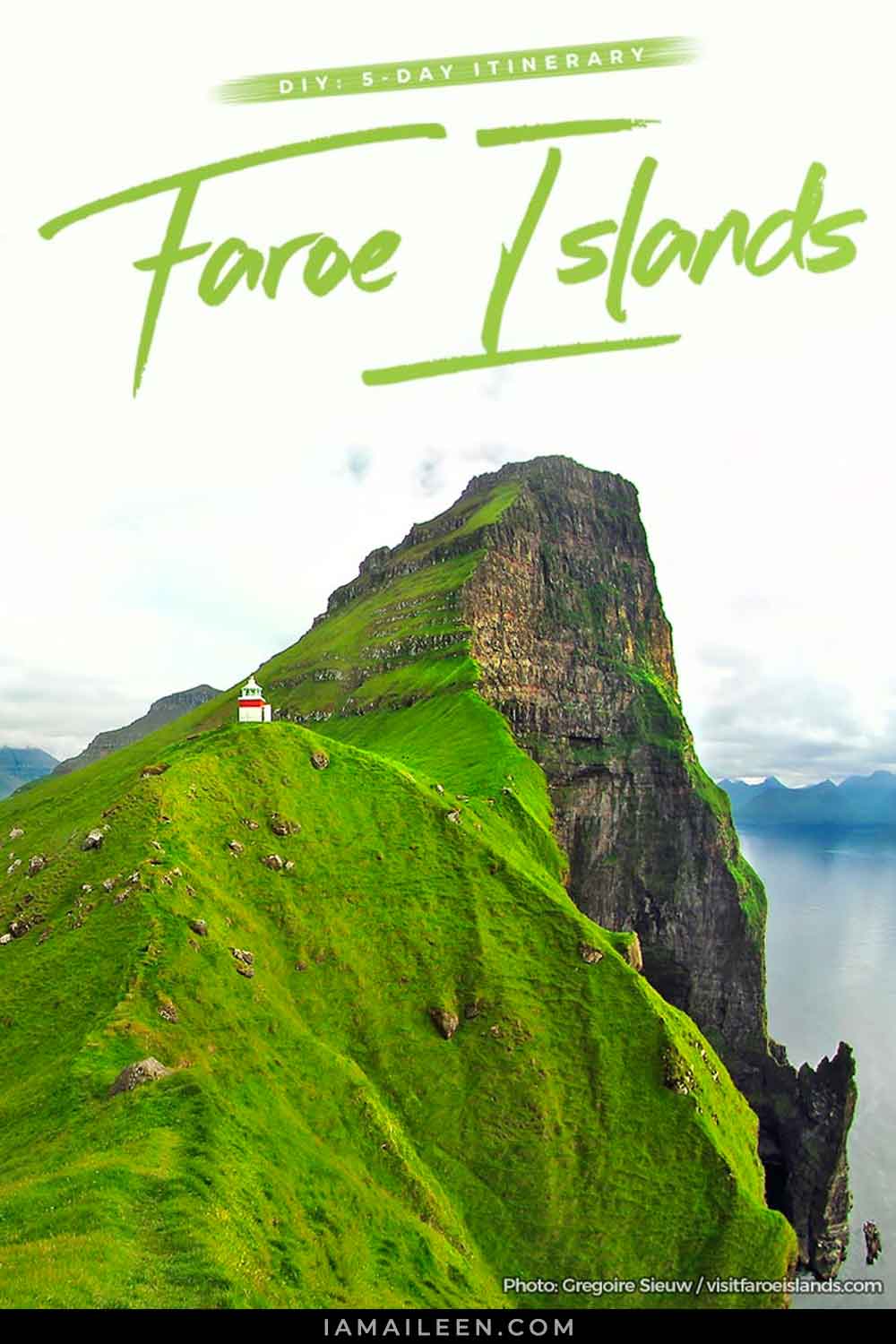
It’s clear to see with this Faroe Islands itinerary that the area has an untouched beauty that’s worthy to be seen and explored! I guarantee you that it is the kind of place that will fit your fancy, NO matter the kind of traveler that you may be.
Besides, it’s a destination that a lot of travelers have NOT heard of yet, so why not be one of the “forerunners” who will sing its praises? In that way, the Faroe Islands could soon be known by more people, thereby paving the way for its popularity — which they so rightly deserve!
Have you seen my latest vlog?

Hey there! I am Aileen Adalid. At 21, I quit my corporate job in the Philippines to pursue my dreams. Today, I am a successful digital nomad (online entrepreneur, travel writer, & vlogger) living a sustainable travel lifestyle.
My mission? To show you how it is absolutely possible to create a life of travel no matter the odds — and I will help you achieve that through my detailed travel hacks, guides, resources, tips, and MORE!
Follow Along
CURRENTLY BASED IN: The Philippines
- 100k Followers
- 51k Followers
- 80k Followers
- 10k Followers
- 23.1k Followers
Trending Now
Visa application tips: 4 important things to get you approved.
Increase your chances of getting that approval — here are the 4 topmost important visa application tips to remember when you’re applying!
Elegance on the Water: The Ultimate Mekong River Cruise Experience for the Discerning Traveler
Here’s why you should put a Mekong River Cruise high up on your bucket list for your upcoming Asia adventures!
Best Hotels in Cebu: From Cheap to Luxury Accommodations and Places to Stay
Explore the best hotels in Cebu — from luxurious five-star resorts, cozy boutique stays, to budget-friendly hostels!
EU261 Compensation: Your Essential Guide on European Flight Delays or Cancellations
Learn to claim EU261 compensation for flight disruptions like delays, cancellations, downgrades, or denied boarding!
20 Safest Countries for Solo Female Travelers: The Best Trip Destinations in the World (& The 5 Worst!)
Find out the BEST and safest countries for solo female travelers to go on adventures to — as well as the 5 most dangerous destinations!
Latest Posts
Learn Today
How to start a successful blog, 54 comments.
This is a great itinerary with all of the island’s highlights. I’d love to come back to tackle Slættaratindur – the weather was terrible when we wanted to ascend it, so we skipped it.
If you plan an coming back, I can really recommend the hike to the abandoned village of Skarð on Kunoy. It’s such a unique place and feels even more remote than most places on the Faroe Islands.
Submit a Comment Cancel reply
Your email address will not be published. Required fields are marked *
Be notified of follow-up comments by email
Submit Comment
Pin It on Pinterest

Faroe Islands Itinerary Suggestions for 3-9 Days (+Map & Practical Tips)
By Author Jurga
Posted on Last updated: January 23, 2024
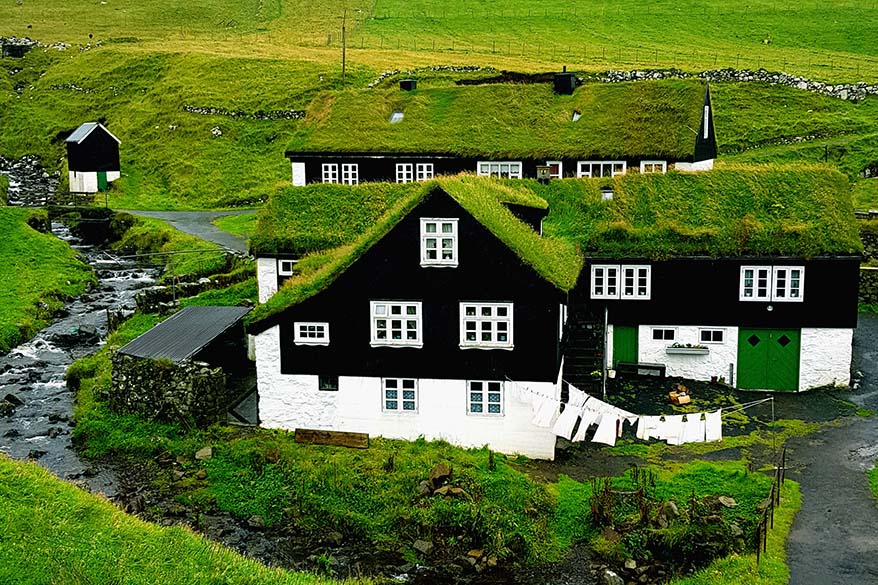
The Faroe Islands is a place of rugged landscapes, harsh weather, and unspoiled natural beauty. Europe’s best-kept secret, little known and unexplored, waiting to be discovered by those who know how to appreciate it.
We learned that the literal translation of the Faroe Islands actually means the Sheep Islands . This alone was enough to convince us to visit these remote islands with countless shades of green, millions of birds, and indeed, more sheep than people….
Do you also want to visit the Faroe Islands, but are not sure where to start? In this post, I’m sharing our complete Faroe Islands self-drive itinerary for 9 days . It covers all the most beautiful places that you shouldn’t miss in the Faroe Islands, as well as some less-visited locations and incredible hidden gems.
In addition, I’m also sharing the best Faroe Island itinerary suggestions for 3, 4, 5, 6, or 7 days . You can find those at the bottom of the article.
If you love the outdoors, adventure, and quiet places where time seems to have stood still, then you probably know how increasingly difficult and challenging it is to still find a travel destination that ticks all these boxes. Faroe Islands is such a place, and it’s closer and easier to visit than I always thought it was.
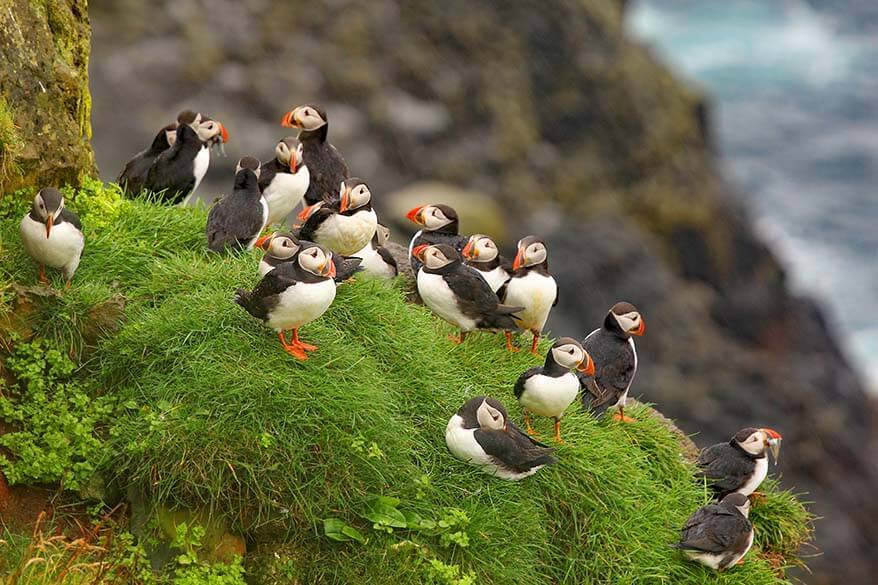
How much time do you need for the Faroe Islands?
While you can see the main highlights of the Faroe Islands in 4-7 days, staying a few days longer makes for a more relaxing trip and gives you an opportunity to visit remote islands and also do some hiking. As a minimum, I suggest you spend 4-5 full days in the Faroe Islands.
Many people travel to the Faroe Islands for just a few days, but we wanted to explore the main islands to the fullest, and so we spent 9 full days in the Faroe Islands 11 including travel days.
TIP: If you are visiting the Faroe Islands for the first time and are not sure where to start, you can also opt for organized tour packages . They include daily tours to the best places in the Faroe Islands and you can just stay in Torshavn during the whole trip.
The most popular option is this 6-day tour package that covers all the main highlights of the Faroe Islands. All you have to do is book your Torshavn accommodation and a tour package, and they’ll pick you up for a different tour every morning.
Another great option is this new all-in 8-day package that, in addition to all tours, also includes Torshavn accommodation, airport transfers, and more.
How to use this Faroe Islands itinerary
You can use our Faroe Islands travel itinerary for inspiration and make sure to also check our suggestions for any trip. But keep in mind that you’ll have to make your own trip itinerary as a lot depends on available accommodations and also on the ferry timetables .
To help you plan your trip, we included a handy MAP for searching all available hotels and Airbnbs for your travel dates . You can find it at the bottom of this article.
For more practical information , please check our first-timer’s guide to visiting the Faroe Islands .
I also created a map indicating all the places mentioned in this post. It should help you get a better idea of where everything is and plan your own Faroe Islands travel itinerary. See below.
How to use this map: Use your computer mouse (or fingers) to zoom in or out. Click on the icons to get more information about each place. Click the arrow on the top left corner for the index. Click the star next to the map’s title to add it to your Google Maps account. To view the saved map on your smartphone or PC, open Google Maps, click the menu and go to ‘Your Places’/’Maps’. If you want to print the map or see it in a bigger window, click on ‘View larger map’ in the top right corner.
TIP: The Faroe Islands are a paradise for hikers and some of the most beautiful places can only be reached on foot, so pack your hiking gear and explore. Here you can read more about 5 spectacular hikes that you shouldn’t miss in the Faroe Islands .
If you click on the hike icons indicated in the map above, you’ll see a number by each hike. Those numbers correspond to the numbering used in the ‘Hiking in the Faroe Islands’ brochure issued by Visit Faroe Islands. You’ll be able to find this hiking brochure at all tourism information points and some hotels on the Faroe Islands.
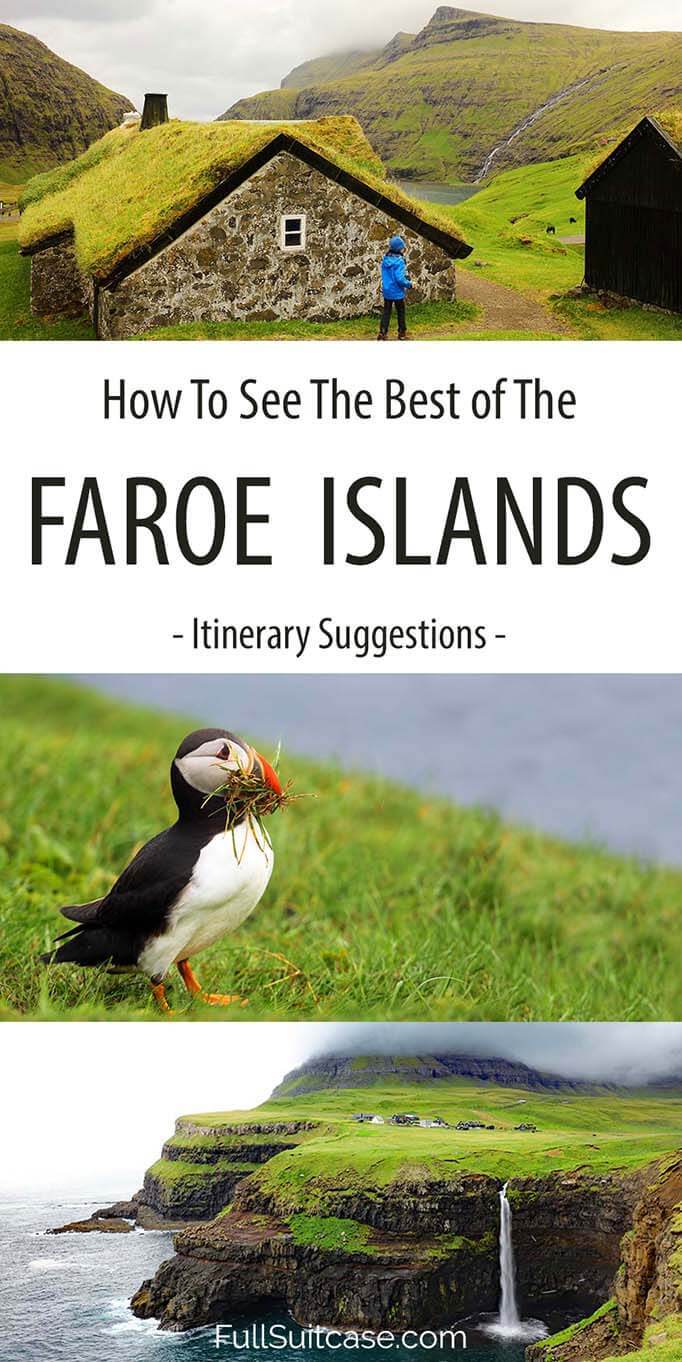
Day 1: Streymoy Island: Saksun, Tjornuvik, Vestmanna
Streymoy Island is the largest of the 18 Faroe Islands, home to the capital city of Torshavn and to almost half the population of the Faroe Islands. But don’t worry, even here it’s quite easy to escape the people and get a good feel of what the Faroe Islands are all about.

Oyggjarvegur Scenic Road
The scenic road Oyggjarvegur , over the mountains above Torshavn, is a road you must drive at least once. Green mountains, spectacular vistas, fjord valleys under your feet, countless waterfalls… The scenery here is truly beautiful and you can call yourself lucky if you can experience it without mist.
It’s very likely that you’ll run into some sheep, but also wild geese. Faroese geese are extraordinary birds – they live here the whole year round and are extremely well adapted to the harsh environment.
We saw so many geese that, at first, we thought they belonged to someone. But no, these birds are wild and roam freely all over the islands. Since they have no natural predators, they aren’t very shy, so you are bound to run into some geese during your trip.

The tiny village of Saksun is considered one of the nicest places in the Faroe Islands, and a must in any Faroe Islands itinerary. Saksun is situated at the end of the valley overlooking a magnificent bay that is surrounded by steep mountains. It looks like a natural shelter from the ocean, yet the wind is very strong here and it’s the coldest place we have been to in the Faroe Islands. Even in summer, don’t forget your gloves and a hat!
Saksun is best known for its little church overlooking the bay and picture-perfect turf houses of a 200-year-old farm Duvugardar, which is now a museum. It’s such a peaceful sleepy little village and the time seems to have stood still here.
TIP: If you want to have this place all to yourselves, best come here first thing in the morning or in the late afternoon. The museum opens around 2 PM and that is also the time when the tour buses arrive.
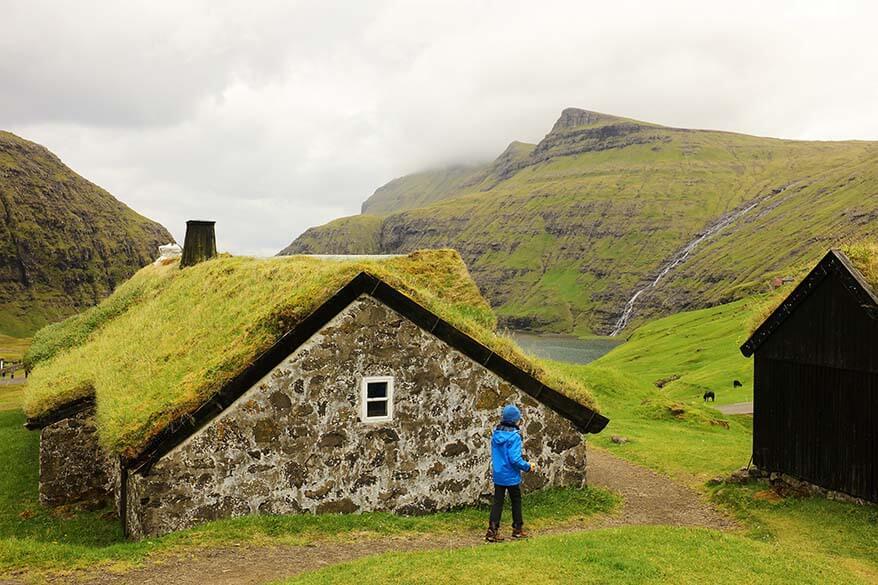
One of the popular hikes of the Faroe Islands, Saksun – Tjornuvik hike starts by the waterfall just behind the turf houses. However, it’s a long hike that involves a serious climb and will take at least 2-3 hours one way, so if you are planning to do it, start early and count the whole day for just this area.
Alternatively, make a shorter walk along the Western side of the river (you can read all about this hike in our Faroe hiking guide – hike no. 5 ) and drive to Tjornuvik by car.
Practical information: Saksun has some minimal facilities – a bathroom, a cafe that is open for a few hours in the afternoon, and a kiosk selling some small snacks (it’s located at the first parking area, not by the church where all the tourists come – go figure).
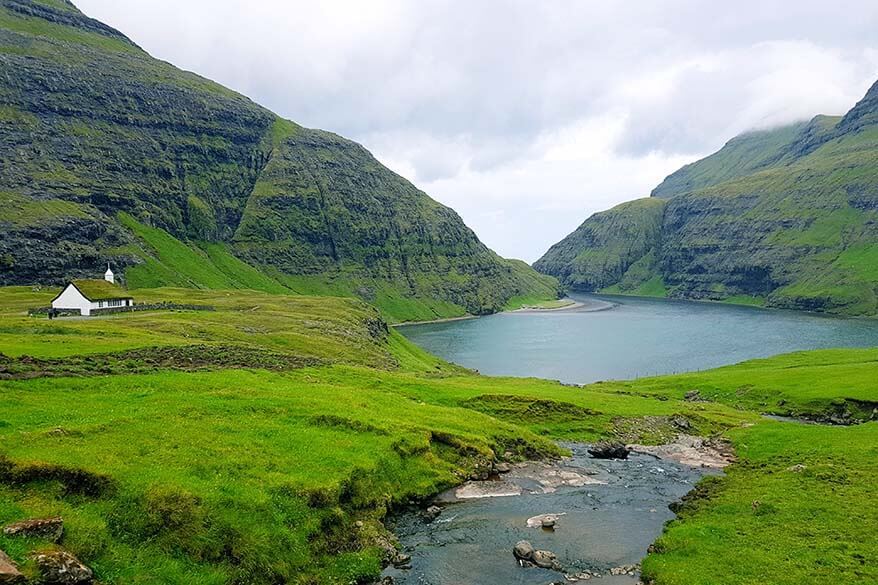
Fossa Waterfall
On the way to Tjornuvik, just before Haldarsvik, you will pass the highest waterfall of the Faroe Islands, Fossa . The 140m waterfall tumbles down over two levels and looks very impressive in the pictures.
However, in reality, it’s so close to the road that you can’t truly appreciate its beauty unless you own a drone. Anyway, it’s just a short stop that doesn’t require any effort, so don’t miss it.
The waterfall is even more impressive if you come here when it rains. Actually, it’s amazing to see how much and how quickly the waterfalls change when it starts to rain in the Faroe Islands.
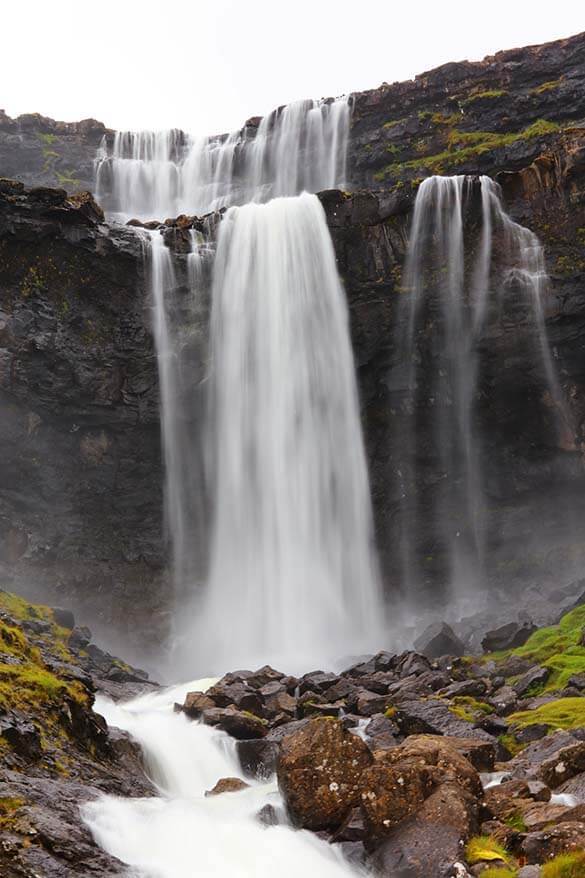
Tjørnuvík
The road to Tjornuvik is extremely narrow, but it’s really scenic, so you don’t want to drive fast here anyway.
The moment you turn the last corner, the picturesque little village appears in front of you – it’s a sight to behold!
There are many places in the Faroe Islands where you feel like you’ve reached the end of the world, Tjornuvik is one of them.
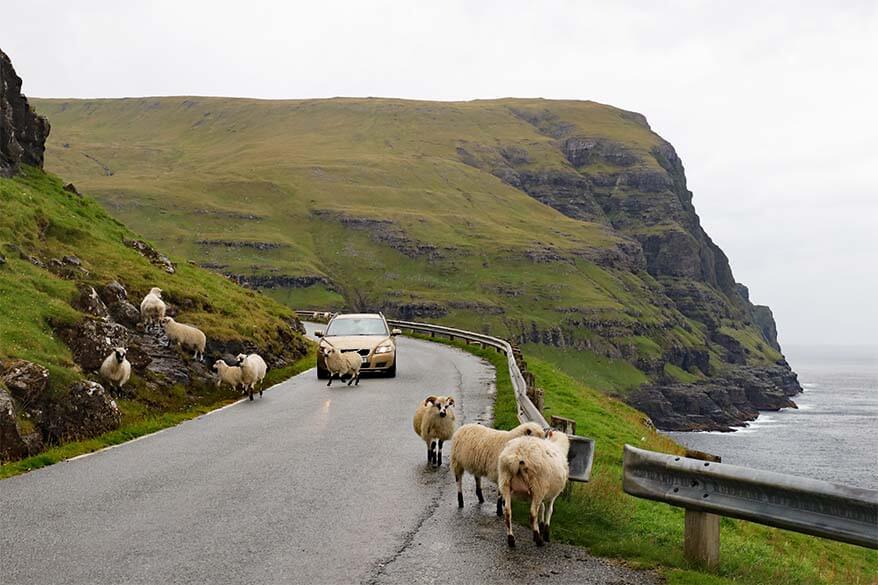
Tjornuvik is a somewhat bigger village than Saksun, and we were glad to see that there were more locals here than tourists (according to Wikipedia, there were 64 people living here 15 years ago, no idea how many people live there today).
The village has a beautiful beach that is supposedly a paradise for surfers. We didn’t see any surfers here but loved the peaceful beach overlooking two beautiful rocks along the coast of the nearby Eysturoy island.
The rocks are known as Risin and Kellingin , a giant and a witch. According to a local legend, they tried to drag the Faroe Islands to their home in Iceland, but the job appeared more demanding than they anticipated. While these night creatures were working hard, the sun came up and turned them to stone.
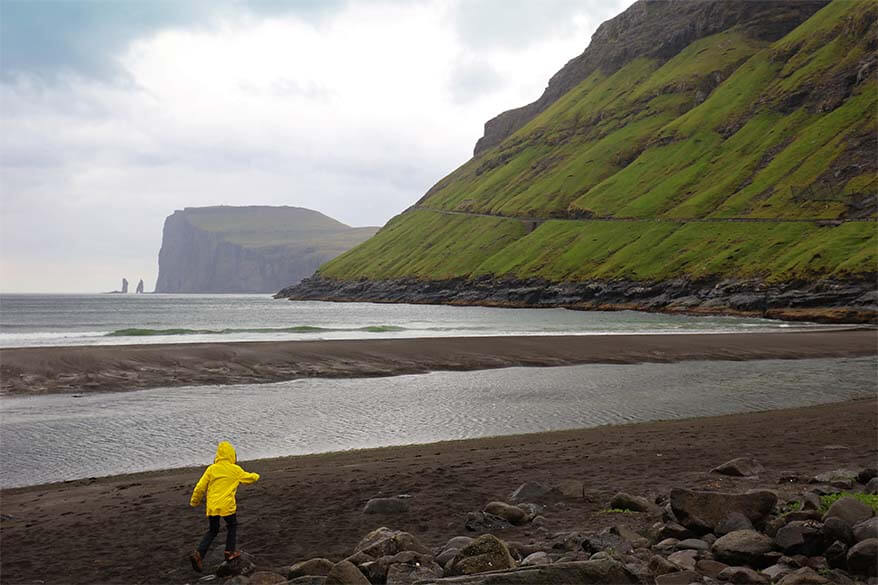
Practical information: Tjornuvik village itself is quaint and picturesque, but there is no tourist infrastructure here at all. The only restaurant in town has been permanently closed a week before our visit. Looking for a place to hide from the rain, we followed a sign for coffee and waffles and ended up in front of yet another closed door. The neighbors told us that the owner’s granddaughter was getting married that day.
The reason I mention this is so that you know what to expect when traveling around in the Faroe Islands. Adjust your expectations, travel well prepared, and you’ll have a wonderful time.
But if you forget to pack a picnic thinking that you’ll find something in these quaint little villages, keep in mind that the nearest cafe might be an hour’s drive away.
Vestmanna Bird Cliffs
Vestmanna bird cliffs is the most popular day trip on the Faroe Islands and takes you to the steep rocky coastline where thousands of birds nest in season. If the sea is calm, this is a great tour, and a possibility to see puffins.
Vestmanna boat trip only runs in high season, April to September, and usually just 2 or 3 times a day. In summer months, the boats are usually full, but even in the shoulder season, this is one of the most popular excursions that quickly sells out. So if you want to see the bird cliffs of Vestmanna, you have to book the boat in advance .
For the rest, there isn’t that much to do in Vestmanna, unless visit the Saga Museum, buy some souvenirs at the visitors center, or meet some of the cutest sheep of the Faroes…
Accommodation: Stay in Torshavn for the first 4 nights of this itinerary. We stayed at Hotel Føroyar , one of the best hotels on the Faroe Islands at the moment. Here you can find our complete updated guide to the Faroe Islands hotels .
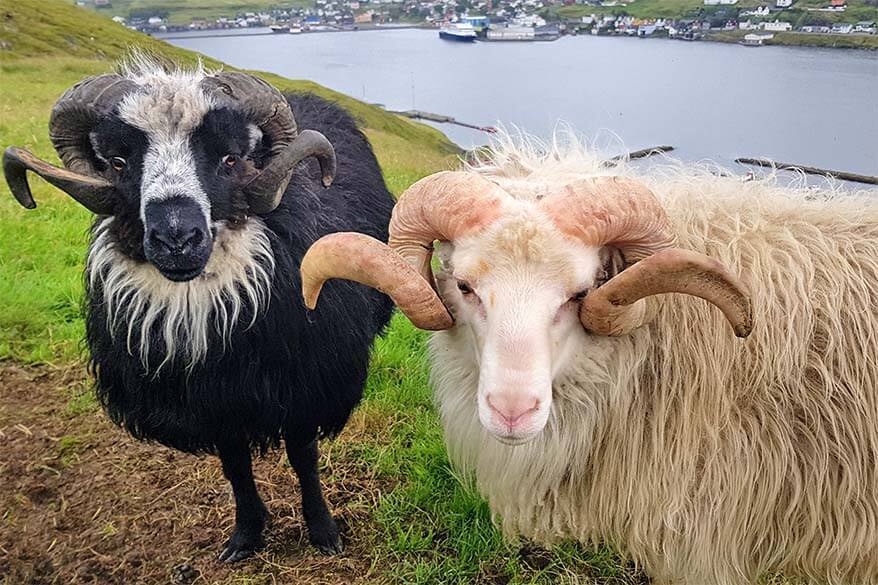
Day 2: Streymoy Island: RIB62 Tour to Hestur Island, Kirkjubøur, Torshavn
Our second day on the Faroe islands was the proof that you shouldn’t let the weather influence your travel plans. It was pouring the whole morning and we were reluctant to even leave our hotel.
While it kept raining pretty much the whole time in Torshavn, the weather was very different in other places. One moment we were driving in complete mist, and then just a mile further down the road we would find open blue skies and sunshine…
We’ve been to many places where the weather is known to be unpredictable, but we have never experienced such instant fluctuations as in the Faroe Islands.
Before the trip, I often asked myself what to do in the Faroe Islands when it rains . My best advice to you is to pack a good rain jacket and just do what you have planned. Alternatively, just drive till you find better weather; it can be surprisingly close by. Or visit the city – you’ll have it all to yourself.

RIB62 Tour to Hestur Island
One of the absolute highlights of our time in the Faroe Islands was a RIB62 speedboat tour to see the bird cliffs of Hestur island . I can’t compare the Vestmanna boat trip to the RIB62 speedboat tour, because we only did one. But at least at first view, the two tours seem to be quite similar in terms of what you get to see (even though the location is different).
There are several reasons why we chose the RIB62 tour. First, our kids love speedboat tours and none of us ever got seasick on them (as opposed to bigger boats). Second, a speedboat is small and can access areas inaccessible to bigger boats. And third, we just prefer the less touristy options and more off-the-beaten-path alternatives that are just as good or maybe even better than the most popular options chosen by big groups.
The tour lasts just 1,5 hours, so don’t miss it, even if you don’t have that much time in the Faroes. It’s a unique opportunity to visit the spectacular cliffs along the Hestur coastline, see puffins (in season), and admire some of the most unique landscapes you’ll ever see.

Kirkjubøur
Kirkjubøur , just a short drive or a 2-hr hike from Torshavn, is one of the oldest settlements of the Faroe Islands, dating from the Middle Ages. Kirkjubøur was the bishop’s residence for centuries and you can still see the ruins of the old cathedral, Muren, which was one of the finest churches of the Nordic countries back in the 14th-15th centuries.
What still stands is St Olav’s Church, built in 1111, and the King’s farmhouse (the oldest inhabited house in Europe); both can be visited. The church is actually still in use and has services on the first Sunday of the month.
Apart from admiring picturesque Faroes turf houses, you can also make a short walk along the coastline. Even in the rain, it’s a very enjoyable short visit.
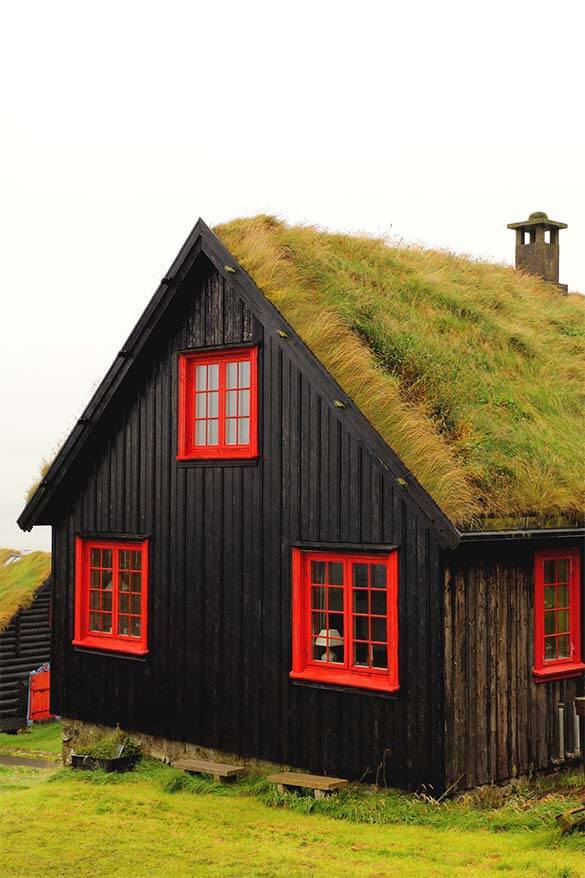
Tórshavn
End your day in Torshavn , the capital city of the Faroe Islands. Not to be missed is the oldest part of town called Reyn with narrow passages and a few turf houses. Don’t expect much of it though – it’s really just a few houses. The main landmark of Torshavn is the historic Tinganes area – one of the world’s oldest courts dating from the 9th century.
The Torshavn city center is rather small and compact, so you don’t need a lot of time to see it all. Other places of interest include the Skansin area by the harbor and the Torshavn Cathedral . It might not look like much from the outside, but you really have to see its wooden interior!
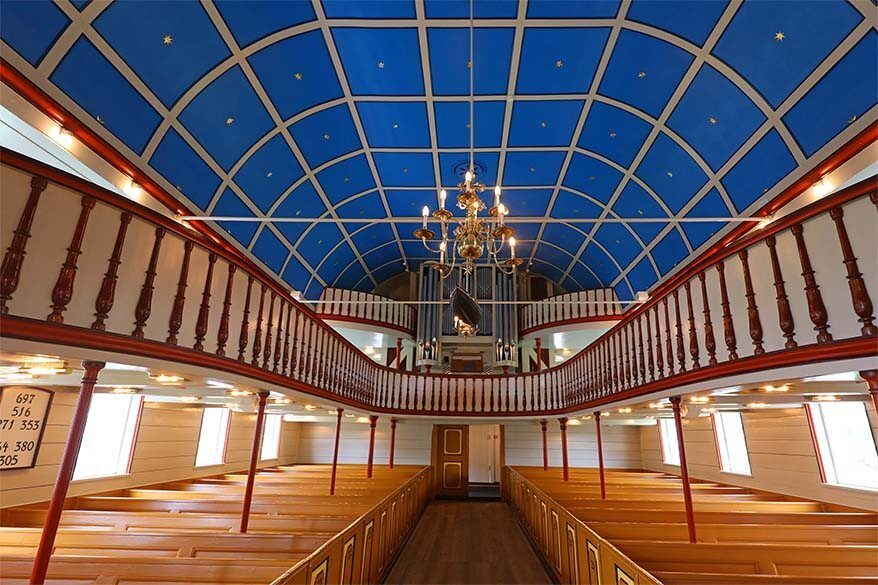
One of the liveliest locations in town is the little Vagsbotnur harbor with quaint colorful buildings and several cafes, pubs, and restaurants. This is probably the best place in the whole of the Faroe Islands for food, drinks, and a lively atmosphere. A great way to end your day.

Day 3: Nolsoy Island
Nolsoy Island , just off the coast from Streymoy Island, can be reached by ferry from Torshavn. The ferry ride takes just 20 minutes, but ferries run just a few times a day, so keep that in mind when planning your itinerary.
The island has just one tiny village, so you don’t need a car to visit Nolsoy. Leave the car at the hotel, or, if it’s too far to walk to the ferry, at the free car parking lot behind the ferry and bus terminals. The other car parking areas near the harbor have strict time limits, which you’ll probably not be able to adhere to when visiting Nolsoy.
If the weather is extraordinarily beautiful, you can hike all the way to Nolsoy Lighthouse. It’s a 5-6 hour walk (13-14 km total), so keep the ferry schedule in mind if you decide to go all the way to the end. Alternatively, do just the first part of the hike – the climb is steep, but the views are really nice.
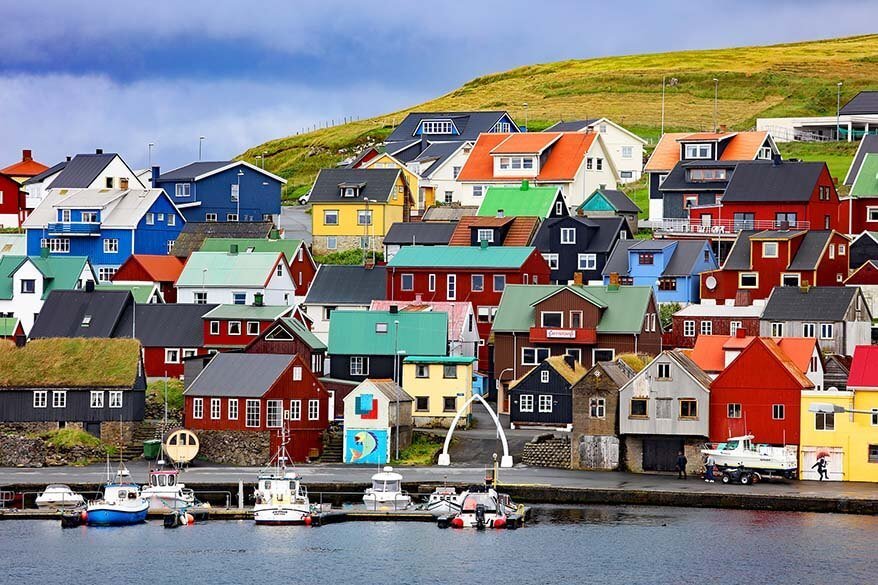
Nolsoy village itself is really picturesque, but apart from a short stroll between the colorful houses, there is not that much to do here for day visitors.
There is a tiny visitor center on Nolsoy Island. They can arrange a guided tour of the village, or some coffee and waffles. For guided tours, it’s best to call them in advance.
TIP: If you take an early ferry back to Torshavn, you could opt to do a horse riding tour close to town . You have to book it in advance, as people in the Faroe Islands don’t seem to like last-minute bookings, even if the tours aren’t full.
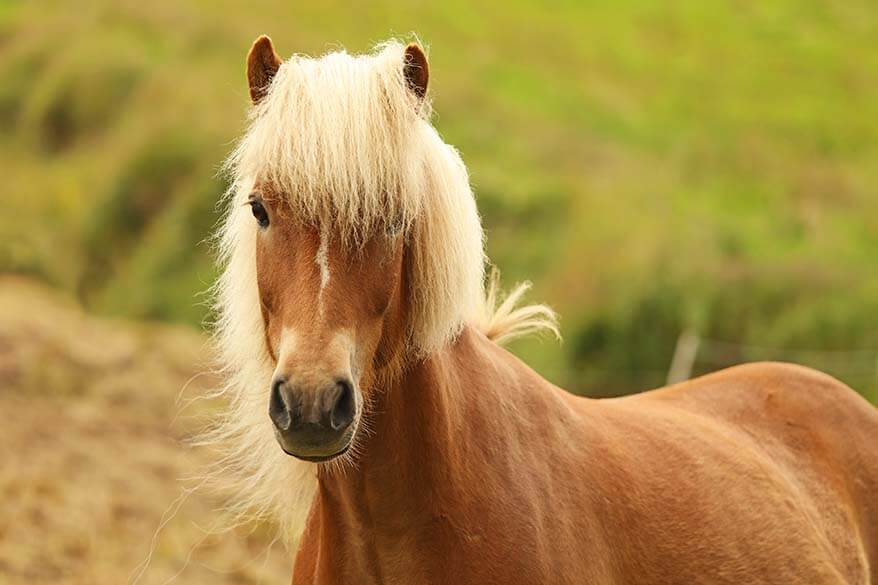
Day 4: Viðoy and Borðoy Islands
Time to explore the Northern islands of the Faroes! The furthest island that you can easily reach by car is Vidoy, about 1,5 hrs drive from Torshavn.
You could do it as a day trip, but I recommend staying in Klaksvik for one night and visiting Kalsoy Island the next day as well.
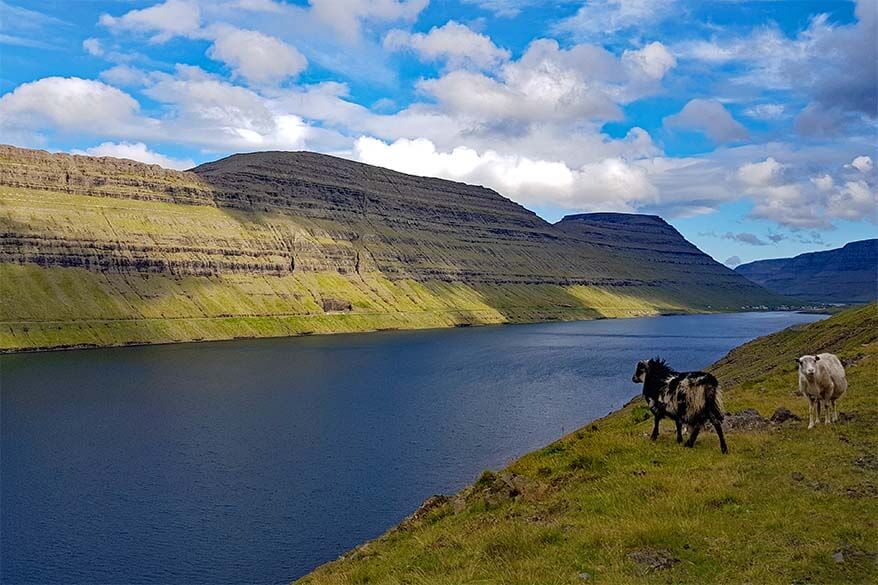
Viðoy Island – Villingardalsfjall/ Enniberg Hike
Villingardalsfjall hike on Viðoy island is probably the most spectacular hike of the Faroe Islands. From the trail, you have phenomenal views over all the Northern islands such as Fugloy, Svinoy, Bordoy, Kunoy, and Kalsoy. Not to be missed!
Practical information: This hike will take you a good part of the day (more information in our Faroe hiking guide – hike no.1 ), so make sure to pack a picnic.
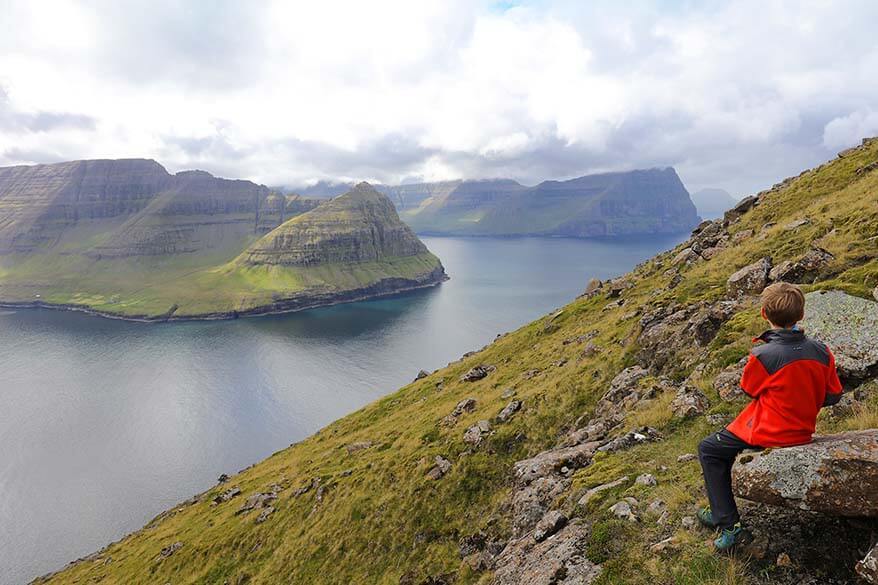
Borðoy Island – Muli and Klaksvik
There is just one road going through Bordoy island and if you drive all the way to the end of it, you reach a tiny village called Muli. The road is really scenic, so it’s a nice little detour.
Muli village itself is not more than a few houses dating from the early 19th century. The sign at the village says that it has been abandoned in 1992, so I guess the people that we met there were using them as vacation houses.
You can make a few very short walks here. One of them leads to the gorge, the other one to a sheepfold along the coast, where you have a nice view over the coastline.
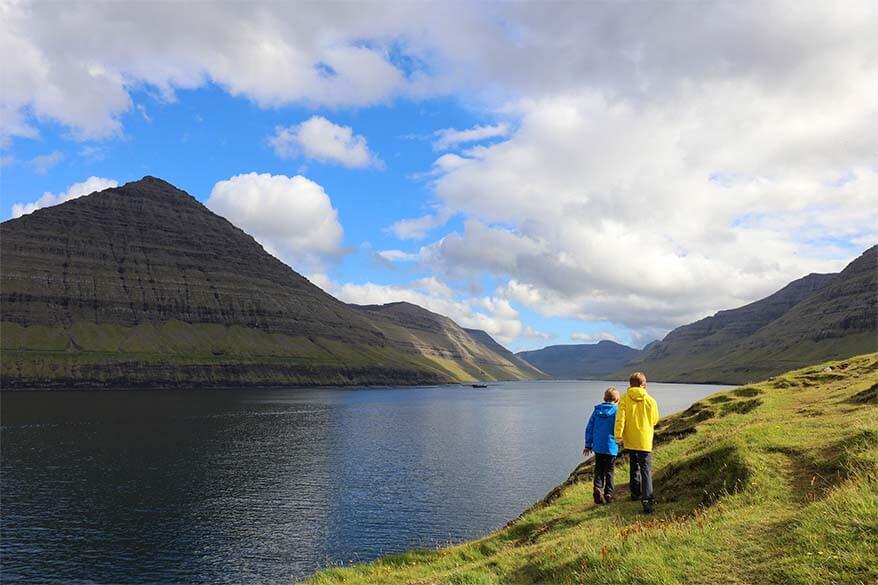
Klaksvik, the fishing capital of the Faroes, is the biggest town of the Northern islands. In addition to its famous brewery, it also has all the facilities that you may need, including shops, restaurants, and also a few accommodations. It’s the best place to stay for exploring the Northern Islands.
Accommodation: Stay in Klaksvik for 1 night. Accommodation here is very limited. We stayed at Eysturland Lodge .
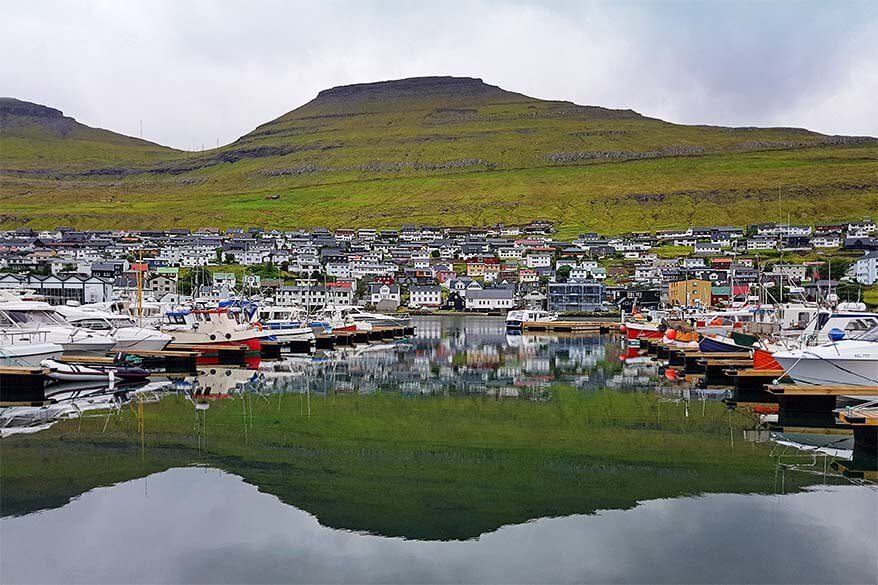
Day 5: Kalsoy Island
Kalsoy Island is not connected to the other islands and the best way to get there is by taking a car ferry from Klaksvik. Keep in mind that the ferry is tiny (it can squeeze 17 small cars at best). Furthermore, it only runs a few times a day.
In high season you really have to arrive at least an hour in advance (that’s why it’s best to stay in Klaksvik and not drive from Torshavn). We arrived about 50 minutes in advance and were the 16th car in the queue and so you can imagine our relief when we could board. The next ferry was 6 hours later…
Update: Recently, I saw that it was possible to prebook a spot on the ferry in advance. So be sure to check the official website of Faroe Islands ferries and if it’s possible, definitely book in advance!
Kallur Lighthouse
The main reason to come to Kalsoy Island is the spectacular scenery on the island’s most northerly point, Kallurin.
It requires some hiking to get to Kallur Lighthouse , but apart from the fact that it’s muddy and slippery, it’s not a very demanding hike (more info in our best hikes of the Faroe guide – hike no.2 ). The views here are rewarding and well worth all the effort that it takes to get here.
Good to know: There is now a fee that you’ll have to pay in order to hike to the lighthouse. More and more landowners in the Faroe Islands are now charging tourists for hiking through their land.
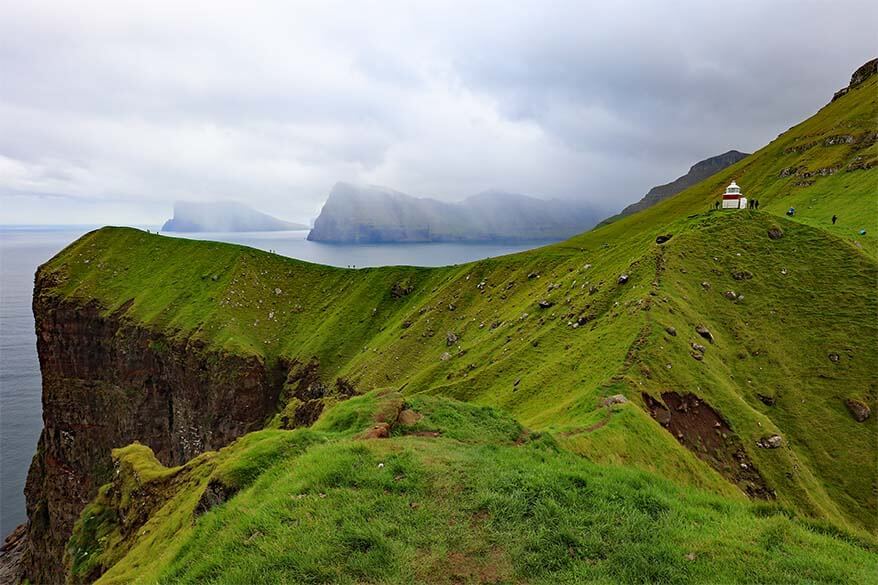
Mikladalur – Kópakonan
One more highlight you shouldn’t miss on Kalsoy island is the statue of a Seal Woman (Kópakonan) in Mikladalur village. The coastline here is stunning too.
My advice is not to linger on the island longer than necessary and get back to the harbor well in time for the ferry. It was so busy on the day we visited that despite arriving more than an hour before the ferry, we ended up waiting for the next one. Hours wasted sitting in the car… Luckily, we had some snacks and our e-readers.
TIP: Probably a better way to visit Kalsoy would be to leave your car in Klaksvik, take a ferry as a foot passenger, and then a small local bus that seems to follow the schedule of the boat. From what I understand, this bus drives all the way to Trollanes where the hike to Kallur Lighthouse starts. I’m not sure what happens if there are no places on this minivan, and I don’t know if it makes any other stops, like Mikladalur. But it’s definitely worth inquiring about this option at the visitor’s center.
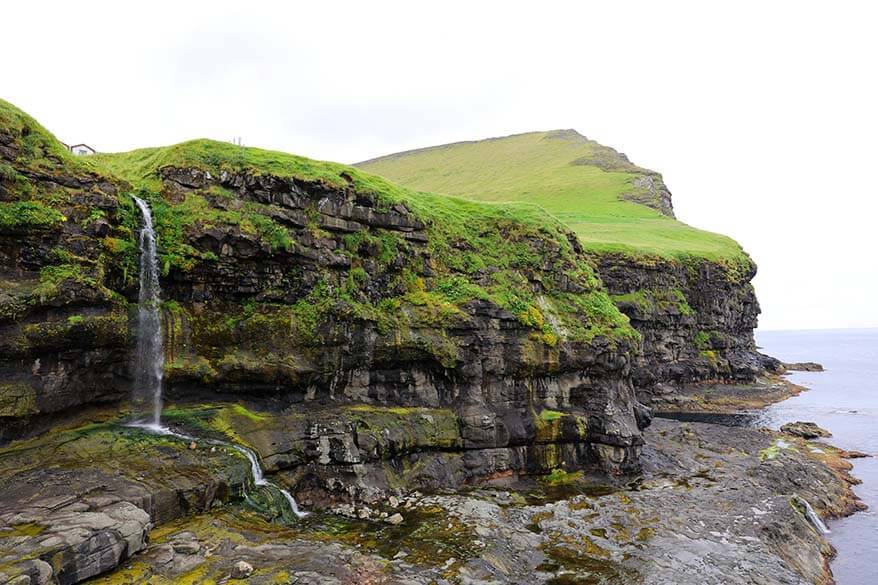
Depending on how much time you have on this day, you might be able to drive some of the scenic roads described in the itinerary on the next day. We spent so much time waiting for the ferry that we ran out of time and therefore drove straight to our accommodation in Gjogv.
Accommodation: You could either stay in Klaksvik one more night or drive to your next destination. We stayed in Gjaargardur Guesthouse in Gjogv – one of my favorite accommodations of this trip.
Day 6: Eysturoy Island: Gjogv, Slættaratindur, Oyndarfjørður, Elduvik
Gjogv is one of the places you shouldn’t miss in the Faroe Islands. It’s such a quaint little village in a beautiful setting.
There are hiking trails available here. As a minimum take a very short walk to and a bit around the gorge, it’s such wonderful scenery. In season, you’ll see puffins here, but they are usually quite far away.
TIP: If you’re in Gjogv around lunchtime, try some pancakes at the Gjaargaardur Guesthouse.

If you drive to Eiði from Gjogv, you’ll pass some of the highest roads of the Faroes. No wonder that this area is often covered in clouds, and it was also the case when we visited. If the weather is nice, you can hike to the top of Slættaratindur , the highest mountain of the Faroe Islands.
Eiði village itself isn’t really that interesting from a tourist point of view. We thought we might be able to see the beautiful rock formations Risin and Kellingin that are just off the coast near Eidi, but you can’t really get close to them or even see them from the village. They are best visible from Tjornuvik on Streymoy Island.
The nicest places on Eysturoy island, we found, are the roads leading to Gjogv, Elduvik, and Oyndarfjordur , so I suggest you drive them all. These scenic drives are not about the destination, but rather about the roads themselves. One exception – Elduvik village is actually quite scenic and worth a short visit.

In the afternoon we drove back to Torshavn where we took a ferry to Suduroy island (see the schedule here ). It’s a big car ferry and we were told that it’s never full. But just in case… we arrived well in advance, parked the car in line at the ferry terminal, and went for a short walk in the city.
Accommodation: We stayed 2 nights on Suduroy island . The accommodation we stayed at is not available at the moment and other options are extremely limited. So you’d have to see if there’s anything available on the private rental market if you plan to visit this island…
Day 7: Suðuroy Island
One of the best things to do on Suduroy Island is Hvannhagi hike near Tvøroyri. It’s a rather long hike, but one that gives you a true feeling of remoteness. The landscape around Hvannhagi is so special!
Don’t miss Akraberg Lighthouse , the southernmost point of the Faroe Islands. Just be careful here – the whole area is surrounded by steep cliffs with a sheer drop to the ocean deep below.
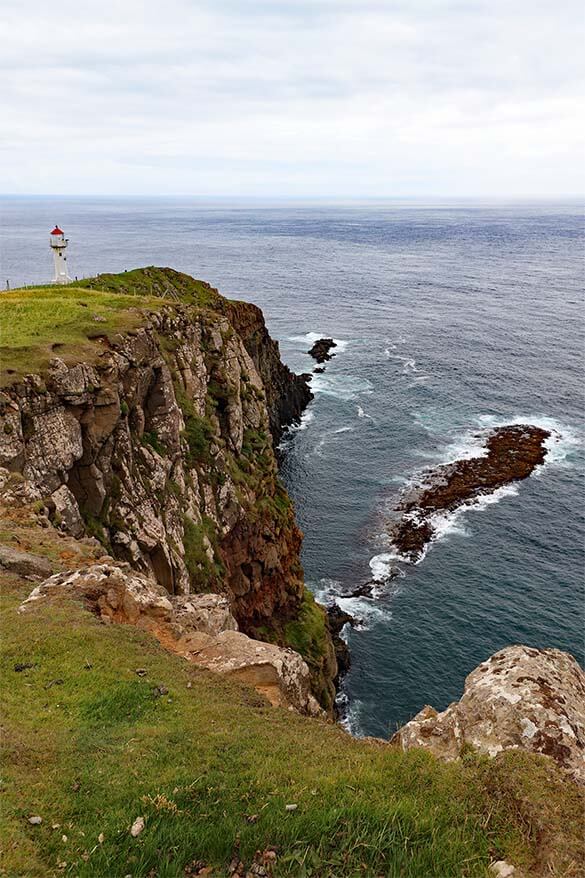
The area around Hvalba and also around Sandvik is really nice to see too.
One of the hidden gems of the Faroe Islands can be found near Sandvík. It’s a tiny nameless wooden bridge over a nameless gorge with incredible views. It’s not easy to find, but if you do – it’s definitely worth it!
Drive the bumpy road Heiðavegur in Sandvik all the way to the end. There is a fence on this road, but the locals told us that it’s ok to drive through it (don’t forget to close it, otherwise the sheep might run away). At the very end of the road, you can leave the car and climb the hill following white poles with a rope, then turn right where the poles end. Continue towards the ocean for 10-15min and you’ll find the little bridge.
TIP: The western coastline near Sandvik is the best place to be at sunset. Follow the Heiðavegur road as described above, but instead of driving all the way to the end, stop where the road is closest to the ocean. From there you can walk just a few steps for the most amazing views.
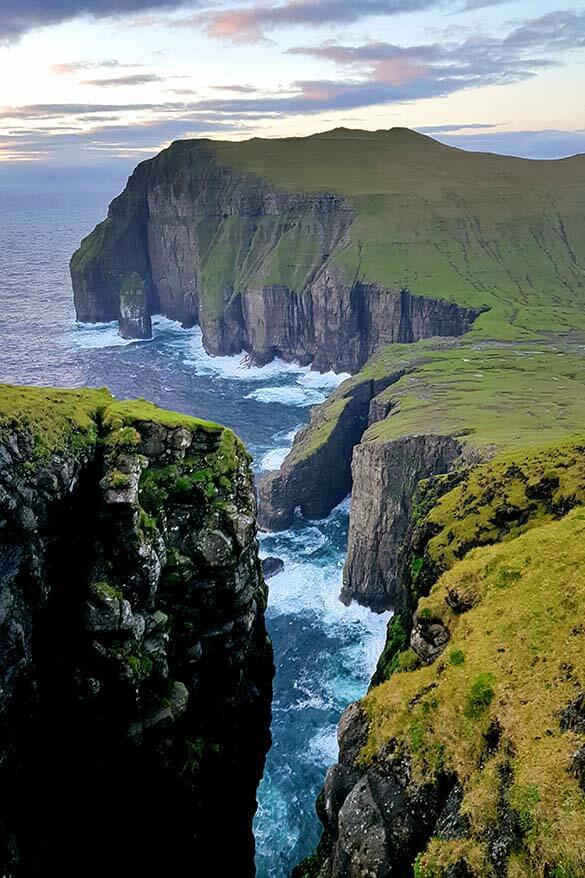
Alternative suggestion: Visit Sandvik and this beautiful sunset spot the evening when you arrive in Suduroy (day 6 of this itinerary). Stay just one night on Suduroy and head back to Torshavn in the evening. Don’t forget to check the ferry timetable. This will give you more time to explore Vagar island the next day.
Day 8: Vagar Island: Trælanípa Hike, Gasadalur, Mulafossur, Trøllkonufingur, The Nix
In the morning we took a ferry back to Torshavn and drove straight to Vagar island . We left this island for the very end of our trip, because it’s close to the airport. Also, there is a toll for driving the tunnel between Vagar and Streymoy, so it’s best not to drive through it too many times if not necessary.
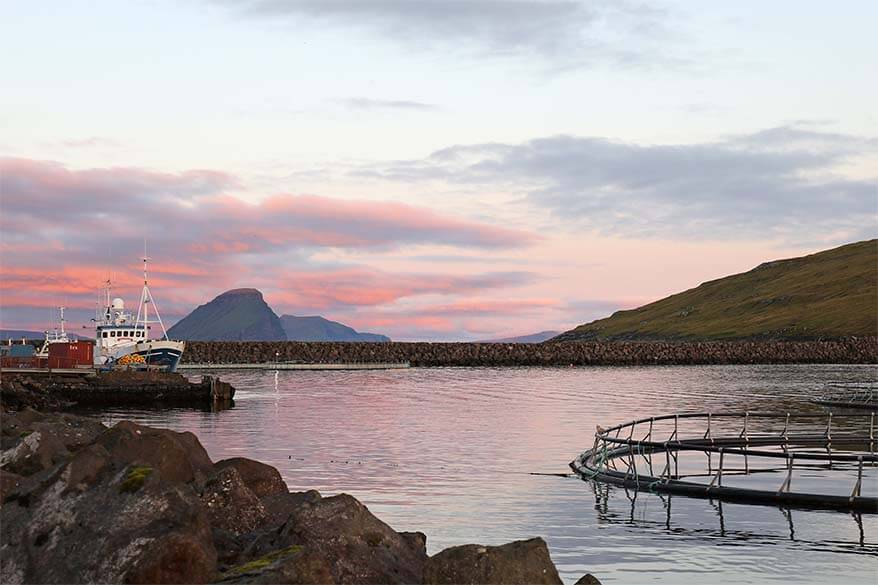
Trælanípa Hike
The hike from Miðvágur to Bøsdalafossur waterfall and Trælanípa mountain is one of the most beautiful and by far the most popular hike in the Faroe Islands. You can read all about it in our Faroe hiking guide, hike no.3 .
TIP: It’s best to come here late in the afternoon if you can – the light for photography is best at sunset and there will be fewer people.
Good to know: There is now a 200 DKK hiking fee that you have to pay (cash) in order to access this area.
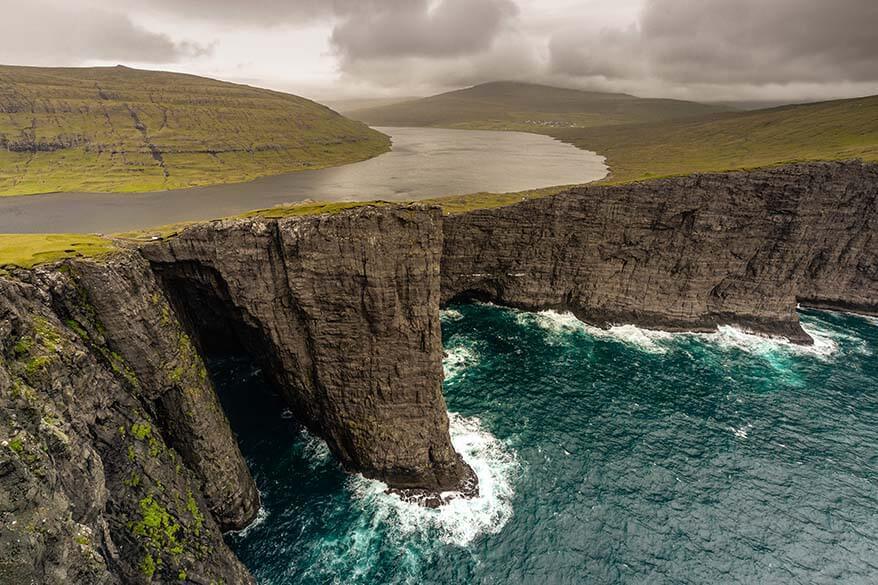
Trøllkonufingur
Trøllkonufingur – the Troll woman’s finger – is a big rock along the coast of Vagar island near Sandavágur. There is a sign to a viewpoint, so you can’t really miss it. It’s also well visible from the road at the trailhead of Trælanípa hike.

Gásadalur and Múlafossur
Gasadalur is a tiny village, just like many others on the Faroe Islands, stuck between the mountains on one side and steep cliffs and the ocean on the other. In the past you could only get there by boat, on foot, or by helicopter; now there is a tunnel connecting Gasadalur to the rest of Vagar island.
The main reason to visit is to see the beautiful waterfall Mulafossur , probably the most photographed waterfall of the Faroe Islands. Don’t miss it – the coastline here will take your breath away!
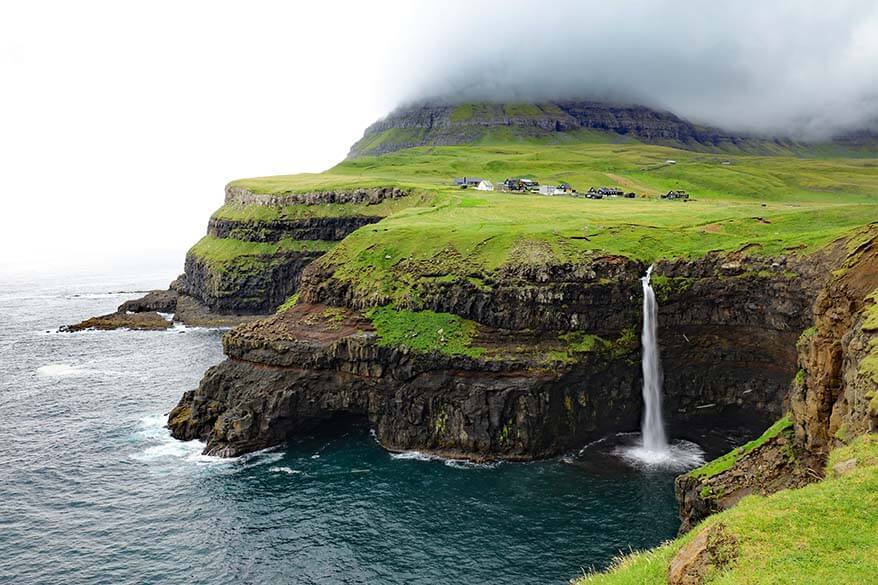
The Nix in Sørvágsvatn or Leitisvatn
On the way to the airport, you’ll notice an interesting piece of art – a horse in the middle of the lake Sørvágsvatn/ Leitisvatn. It’s called Nix and is a mythical water creature that wants to lure people into its underwater world.
There are several stories and legends surrounding Nix and locals could tell you more about it. But the statue is just next to the main road and worth a short stop anyway.
Accommodation: We stayed on Vagar island for the last two nights. It’s close to the airport and also the best location for a day trip to Mykines . There is just one hotel on this island and a few private accommodations. See the accommodation map here .
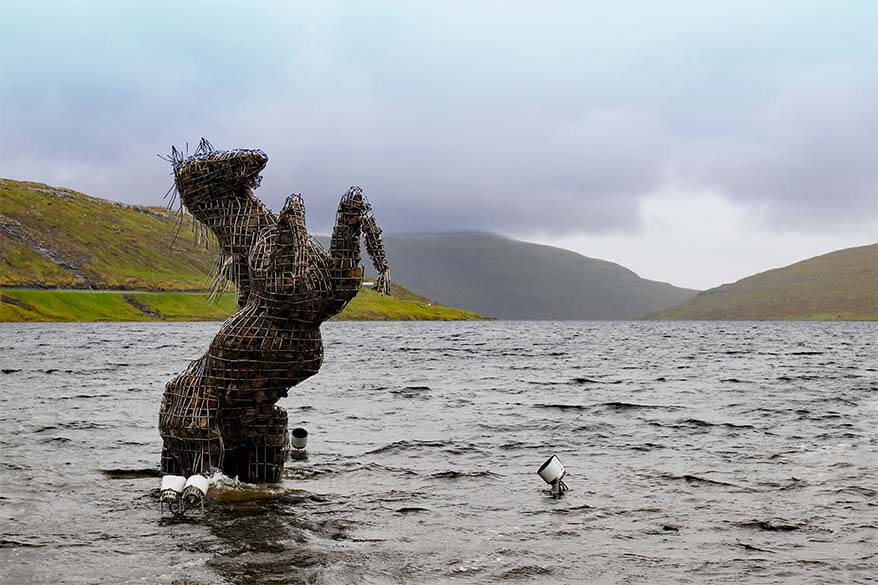
Day 9: Mykines Island
We left the very best for last. Mykines island is one of the most beautiful places of the Faroe Islands and it really should be included in any Faroe Islands itinerary.
We had really bad luck with the weather and visited Mykines in the pouring rain. Nevertheless, it’s one of the most unique and beautiful places I have ever been to. I can’t even imagine what it would look like on a sunny day with blue skies… I’d go all the way back to the Faroe Islands just to explore Mykines in good weather.
As if green hills, charming turf houses, and spectacular scenery are not enough, there is one more reason to visit Mykines Island. Puffins . Mykines is home to thousands and thousands of puffins that come to nest on the island every summer. It must be the best place to see puffins in the world!
One of the nicest things to do is hike Mykinesholmur all the way to Mykines lighthouse. This hike brings you past the puffin colony and has incredible views all the way. Unfortunately, a big part of the hike was closed when we visited (due to the weather and dangerous conditions), but even then it was worth it.
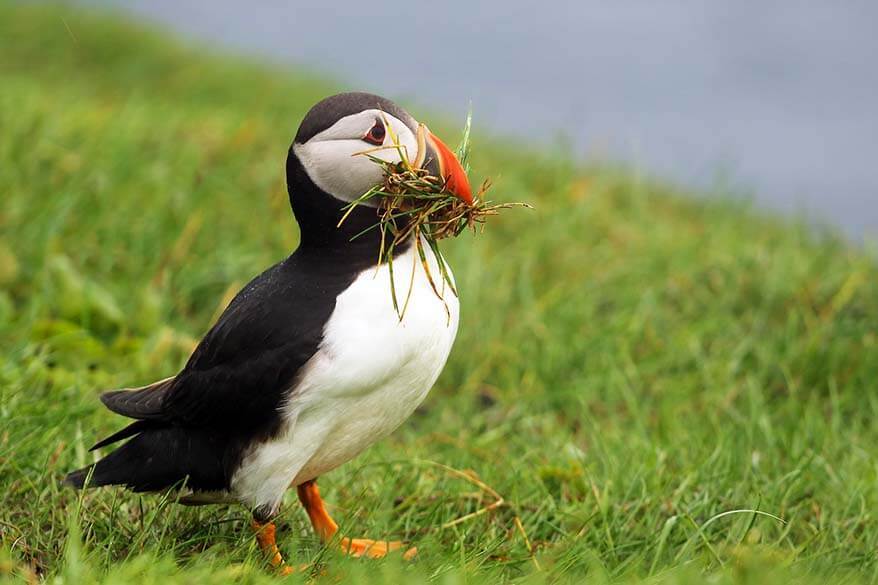
Keep in mind that Mykines is an extremely popular place to visit in the Faroe Islands, and Mykines ferry is also the only one of all official ferries that you can (and have to) book in advance. Nowadays, there is also a shuttle boat to Mykines , which makes it so much easier to visit!
TIP: The easiest way to get to Mykines without having to worry about practicalities is by booking a guided tour to Mykines . Most tours include the ferry, hiking fee, a local guide, and a packed lunch. Just note that some tours start from Sørvágur harbor, but some tours include transportation from Torshavn as well.
There aren’t many accommodations on the island, but it is possible to stay there if you really want to. In that case, inquire at Visit Faroe Islands for more information.
Most people come to Mykines for the day. The ferry schedule is such that it gives you about 5 hours on the island, which is enough if the weather is nice and much too long if it rains.
TIP: You can find more practical information for your visit to Mykines in our Faroe hiking guide – hike no.4 .
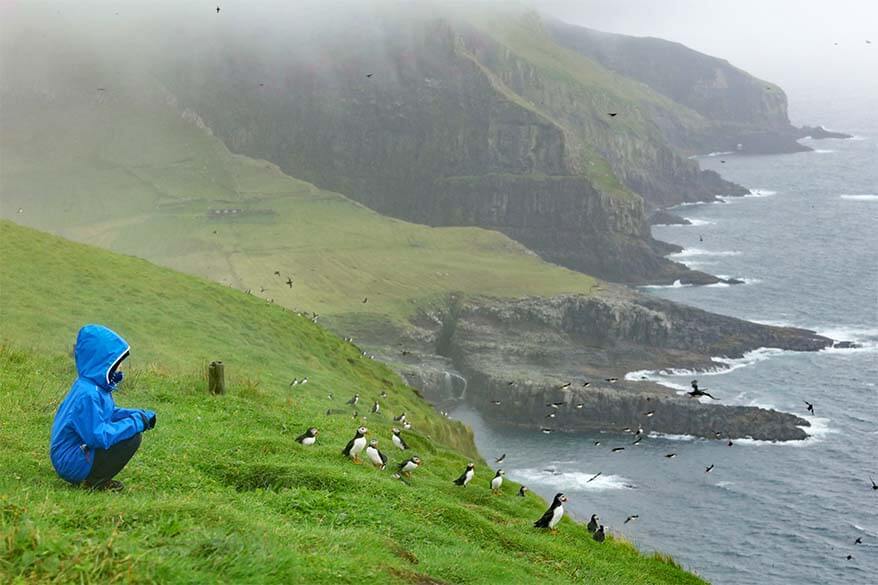
Faroe Islands Itinerary Suggestions
Below you can find some suggested Faroe Islands itineraries for shorter trips, from 3 days up to a week. Read on!
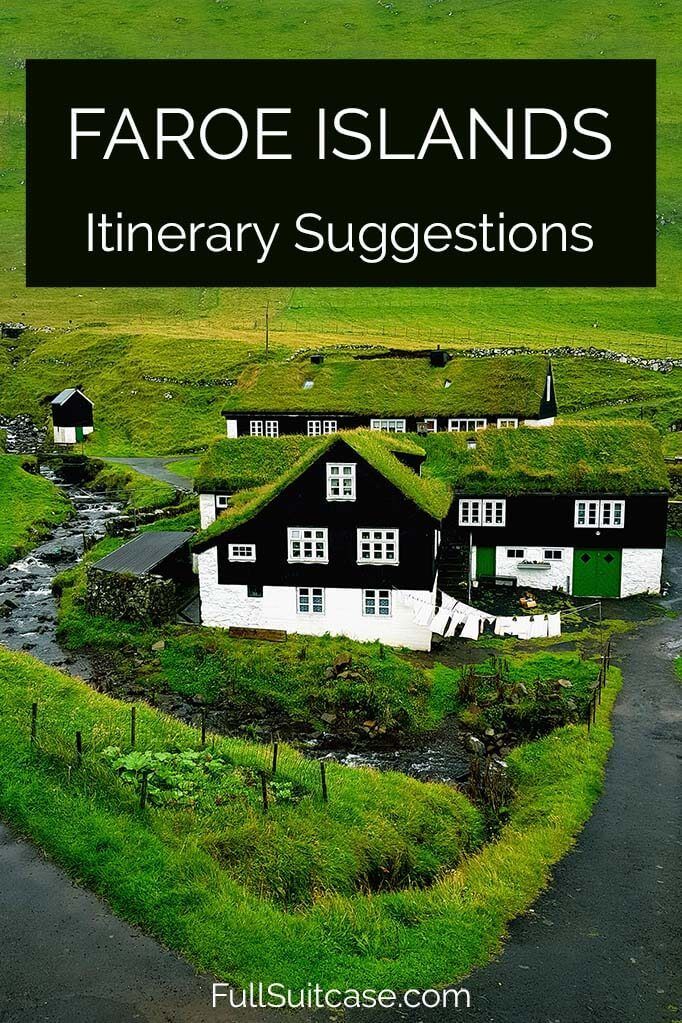
3 Days in the Faroe Islands
- Day 1: Torshavn, Kirkjubour, Saksun, and Tjornuvik.
- Day 2: Boat tour to Vestmanna or Hestur island and Trælanípa hike on Vagar island OR Kalsoy island and Gjogv.
- Day 3: Mykines island. Visit Mulafossur waterfall in the evening.
4 Days in the Faroe Islands
- Day 1: Torshavn, Kirkjubour, Saksun and Tjornuvik.
- Day 2: Kalsoy Island and Gjogv.
- Day 3: Boat tour to Vestmanna or Hestur island and Trælanípa hike on Vagar island.
- Day 4: Mykines island. Visit Mulafossur waterfall in the evening.
Faroe Islands 5 Days Itinerary
- Day 2: Northern islands. Villingardalsfjall hike on Vidoy. Klaksvik.
- Day 3: Kalsoy island and scenic roads on Eysturoy island.
- Day 4: Gjogv, boat tour to Vestmanna or Hestur island and Trælanípa hike on Vagar island.
- Day 5: Mykines island. Visit Mulafossur waterfall in the evening.
TIP: If you have 4-7 days in the Faroe Islands and don’t want to worry about planning the best itinerary, driving, or ferry schedules, consider a multi-day tours package . All you have to do is book a hotel in Torshavn and the local guides will pick you up every morning and drop you off back at your hotel every evening. It’s the most relaxing way to see the best of the Faroe Islands for those who rather take it easy and let someone else do the planning.
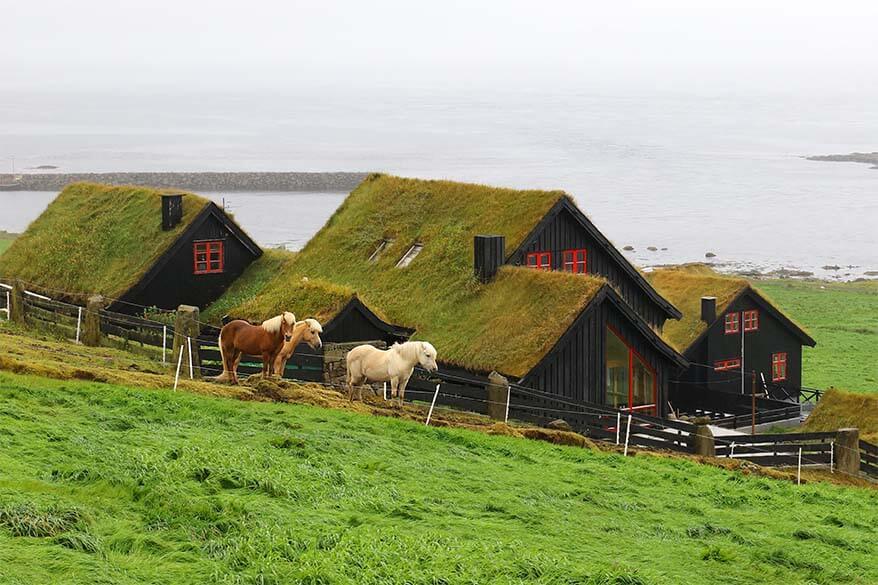
6 Days in the Faroe Islands
- Day 2: Nolsoy Island. Maybe horse riding in Torshavn.
- Day 3: Northern islands. Villingardalsfjall hike on Vidoy. Klaksvik.
- Day 4: Kalsoy Island and scenic roads on Eysturoy Island.
- Day 5: Gjogv, boat tour to Vestmanna or Hestur island and Trælanípa hike on Vagar island.
- Day 6: Mykines island. Visit Mulafossur Waterfall in the evening.
TIP: If you have at least 6 days in the Faroe Islands and don’t want to worry about planning the best itinerary for your trip, consider this 6-day small group Faroe Islands tour package . They pick you up from your hotel in Torshavn every day and take you to a different part of the Faroe Islands each day. It’s a great way to see the best of the Faroe Islands without planning or worries.
One Week in the Faroe Islands
- Day 3: Day trip to one of the other islands, e.g. Suduroy if the ferry schedule allows it.
- Day 4: Northern islands. Villingardalsfjall hike on Vidoy. Klaksvik.
- Day 5: Kalsoy Island and scenic roads on Eysturoy Island.
- Day 6: Gjogv, boat tour to Vestmanna or Hestur island, and Trælanípa hike on Vagar island.
- Day 7: Mykines island. Visit Mulafossur Waterfall in the evening.
Compare Hotels & Short-Term Rentals in the Faroe Islands
Using the map below, you can compare hotels and short-term rental accommodations in the Faroe Islands . You can zoom in and out for various islands.
Simply insert your travel dates and group size, and you’ll see the best deals for your stay. Check it out!
So, this is our Faroe Islands itinerary and suggestions for a shorter vacation. I realize that planning a self-drive trip to the Faroe Islands can look really overwhelming at first, so if you have any questions, please also check our practical guide to the Faroe Islands .
If you still don’t find an answer, don’t hesitate to leave a reply below and I’ll try to help.
READ ALSO: Faroe Islands Hotels & Tips for Where to Stay
If you found this post helpful, don’t forget to bookmark it and share it with your friends. Are you on Pinterest? Pin this image!
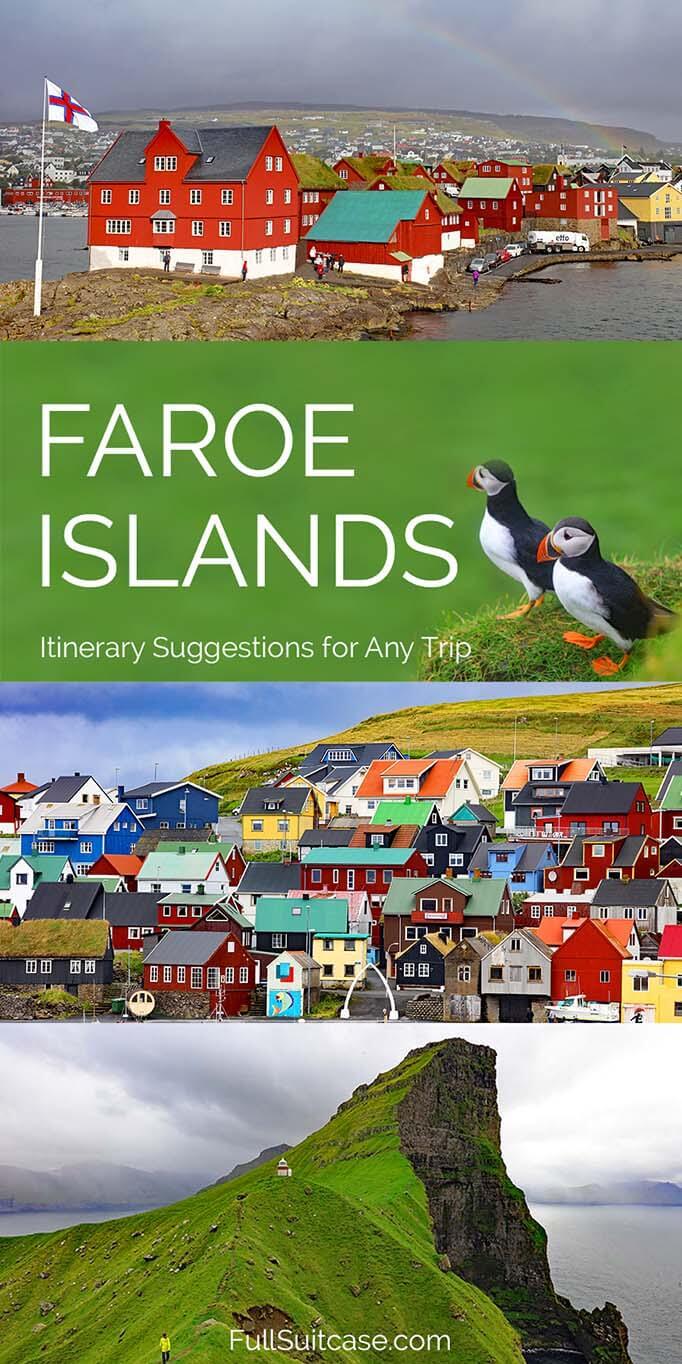
This site uses Akismet to reduce spam. Learn how your comment data is processed .
Thursday 16th of May 2024
Hi, Thanks so much for the detailed blog, very helpful! we are planning to stay in the Faroe Islands for 6 days, of which 2 travel days, so only 4 full days. do you recommend staying in the same place each night (and if yes; where?) or would it be best to change locations every night?
Kind regards, Isabelle
Hi Isabelle, staying in Torshavn is probably best for such a short trip. If you are booking for this summer you may not even have many other options anymore. For more information please read this guide: where to stay in Faroe Islands.
Saturday 20th of May 2023
Hi there! Just passing through to thank you for all the content! Just finished my trip to the Faroe and your posts helped a lot :)
Monday 22nd of May 2023
Glad to hear that, Leticia. Happy travels!
Thursday 29th of September 2022
Thanks for the detailed info! From what you wrote, Sundory Island seems to have more scenic landscape and beautiful view than Nolsoy Island. But on your 6 day itinerary it doesn't have Sundory Island but Nolsoy Island. I am a little confused. We are more into wild landscape than colorful house. Would you please advise? Thanks.
Second, those ferries would run even in raining days and bad weather?
Saturday 1st of October 2022
Hi Camille, Suðuroy island is indeed very beautiful. However, if you look at the map, you'll quickly realize that it's much trickier to get there than e.g. to Nolsoy island which is just next to Torshavn. Depending on the boat schedule, you may need to plan 2 days for Suðuroy and also spend a night there. If you can get a very early ferry there and a late one to get back, it could be done in a day too - it all depends on the ferries and on what you want to see/do. Also, there is not that much accommodation available and if you don't bring your car with you, it's tricky to get around and actually see much. So it requires more planning and more time. And that's the main reason why I wouldn't recommend it if you have less than a week in the Faroe Islands. As for the ferries, it depends on the ferry and on the weather. The biggest ferries usually have no problem unless it's some exceptionally bad storm, whereas smaller ones (like the one to Mykines) could get canceled if the seas are very rough. But definitely not just because of some rain. Hope this helps.
Monday 25th of April 2022
Hi Jurga, your blog on Faroe islands is so detailed and comprehenisve with all the site maps of various places of interest. I don't think I need to read any other Faroe islands guides after seeing your blog. Every thing I need to know can be found right here. By the way, I'll be making the trip with the wife this August, the same time you were there I think. We are a retired couple in our sixties (me 67 and the wife 62) so we don't plan on doing too many hikes. Right now, I don't have any question for you just yet as I'm still going through the blog and will re-read some more time. We plan to spend 5-6 days at Faroe islands but could extend if necessary. Our intenerary will be based on your writing. Thank you very much for the information.
Tuesday 26th of April 2022
Thanks for your kind feedback, Kittiwat. Good luck with the planning and have a great time in the Faroe Islands!
Joanna Mendoza
Thursday 24th of March 2022
Hi!I'm so glad to have come across your blog! I wanted to ask how we go from Torshavn to Nolsoy?This is our itinerary for June and would like to know if this is okay. 1- arrival, Kirkjubour 2- Mykines Day trip 3- Nolsoy Day trip 4- Saksun, Tjornuvik, Gjogv
Thank you. Joanna
Hi Joanna, yes, sure, your itinerary looks good. For Nolsoy, you just take a ferry from Torshavn harbor. It's very simple to get to Nolsoy - you get the ticket on the spot, and it takes just about 30min. Just keep an eye on the ferry schedule so that you don't have to wait too long. You don't need a car on that island; lots of walking. Have a great trip!
- Search Please fill out this field.
- Newsletters
- Destinations
Faroe Islands: Planning Your Trip
TripSavvy / Lauren Breedlove
Few places in the world are as naturally beautiful and unspoiled as the Faroe Islands. The lush rolling hills, green-roofed cottages, and pastures dotted with sheep are like something out of a storybook. This idyllic remote nation is made up of 18 small islands connected by bridges, tunnels, helicopters, and ferries.
Located between Iceland and Norway, the country is a self-governing nation belonging to the Kingdom of Denmark. An ideal destination for hikers, photographers, and nature-lovers, it won’t take long for you to fall in love with this tiny country of fewer than 50,000 people.
Planning Your Trip
- Best time to visit: Known as “The Land of the Weather Gods,” let’s just say the climate can be unpredictable. Most people visit during May, June, July, and August when the days are long, all the roads are accessible, and the temperatures are between 40 and 50 degrees F. But if you do visit during the chilly winters, you may be able to see the Northern Lights .
- Language: The official languages are Faroese and Danish.
- Currency: The two currencies of the Faroe Islands are the Faroese króna and the Danish krone.
- Getting around: The best way to get around the Faroe Islands is by car. The islands are serviced by a robust network of roads, bridges, and subsea tunnels. Many roads in the villages are paved in gravel, though, so proceed with caution when driving these.
- Travel Tip: Visitors may experience four seasons in one hour, so be sure to pack layers and wet weather gear.
Things to Do
The Faroe Islands is a destination made for the outdoorsy, athletic, and nature-loving among us. Whether hiking, trekking, strolling, or kayaking , animal watching, surfing, exploring, or road-tripping, the Faroe Islands are all about resplendent, natural beauty. Bring your camera, hiking boots, and plastic baggies for snacks to-go, and consider these activities:
- See puffins on Mykines: This is arguably the Faroe Islands’ most popular destination from May to August. You’ll be sure to see dozens of puffins along the cliff sides, as well as the country’s only gannet colony. Book a stay with GoLocal and stay in the owner Oda’s traditional renovated turf house overnight. She’ll take you on the local hiking trail at the far end of the village, past puffins and rams, down to a beautiful lookout to watch the sunset with a hot chocolate in hand. Avoid the touristy hike to the lighthouse. You’re actually stepping on puffin colonies, irreparably harming the local environment.
- Visit the beach in Tjørnuvík: One of the most stunningly enchanting towns in the entire country is also home to the best surf beach. When you round the corner of the one-way cliff-side road, the colorful houses of Tjørnuvík will make you gasp. Wander the village and stop by a local turf house for some coffee and waffles before heading to the black stone beach to watch surfers from around the world take on the icy waves.
- Examine history in Kirkjubøur: The most historic village in the Faroe Islands is a 20-minute drive from the capital. It’s home to St. Olav’s Church from the 12th century, the ruins of Magnus Cathedral dating all the way back to 1300, and the world’s oldest inhabited wood house built in the 11th century. The village is teeny, tiny, and quaint as can be, so be sure to respect residents’ privacy.
Where to Eat
For such a small country, the Faroe Islands has a unique dining culture. Due to the harsh, cold climate, the Faroese became masters of food preservation over the years, fermenting fish and lamb by hanging them in drying houses. The resilient vegetables that are traditionally eaten here include potatoes, kohlrabi, turnips, and rhubarb.
Most famously, they have a two Michelin-star restaurant called Koks . From the moment you arrive lakeside to their small hjaller (fermentation cabin), the journey begins. You’re whisked away via four-wheel drive to a turf house dating back to the 1700s. There you’ll eat 18 impeccably-plated courses with the Faroe Islands' freshest ingredients.
In the capital, a local favorite is Raest , the world’s only fermentation-only restaurant outside of Japan. Located in Tiganes, the historic center of the capital, you can try fermented salted cod and fermented dried whale. If you’re looking to warm up, try ramen at Suppugarðurin , or head to Paname Café for an impressive charcuterie board and dessert. For fresh fish, order sushi at Etika or anything off the menu at Barbara Fishouse .
How to Get There
There are multiple flights to the Faroe Islands from European capitals including Paris, Reykjavik, Copenhagen, Bergen, Edinburgh, Barcelona, and Billund on Atlantic Airways and Scandinavian Airlines. Even without a direct flight from North America , you can easily fly to the Faroe Islands with a stopover in Reykjavik, Iceland, Copenhagen, Denmark, or Edinburgh, Scotland.
How to Get Around
When it comes to exploring the Faroe Islands, you can either rent a car or utilize their public transportation system.
The bus system , a more sustainable and much cheaper way to get around the islands, is well planned out and easy to navigate. Adults can book a four-day pass for 500 Danish kroner ($74.50) or a seven-day pass for 700 Danish kroner ($104), which includes ferry rides. Kids travel even cheaper. The buses are efficient and visit the smaller villages like Kirkjubøur and Tjørnuvík. Find more about the buses and ferries at the official site .
Although buses in the city capital of Tórshavn are free, spend some time walking to places like Tiganes, a famous old area with cobblestone streets and centuries-old turf houses that are begging for a photoshoot. This historic point is where one of the world’s first parliaments met, and today it still houses government buildings.
If you’re looking for more freedom during your trip, a car may be the way to go. But keep in mind, it takes a confident and experienced driver to traverse the narrow one-way roads and dimly lit subterranean tunnels that connect the Faroe Islands. (However, they do drive on the right side of the road.)
When renting a car, go with companies like 62°N , but be sure to rent a GPS as most cars don’t come with one. There are many tunnels in the Faroe Islands. so it’s a good idea to buy the unlimited tunnel pass for 300 Danish kroner ($42). There are also very few speed limit signs but remember it’s 80 kilometers per hour (about 50 mph) on the main roads and 50 kilometers per hour (about 30 mph) in populated areas unless otherwise noted. Find more important information about driving safety in the Faroe Islands at the tourism site .
There are numerous parking restrictions, especially in the Tórshavn. There is signage displaying how many hours you can park in a spot before you need to move your car. Set the clock on the bottom right corner of your windshield to the time you parked your car; otherwise you may get a 200 Danish kroner ($30) fine. There are no parking restrictions on Sundays.
For a special treat, take one of the world’s cheapest helicopter rides subsidized by the government. Usually reserved for locals, lucky tourists can snag a seat for as little as 125 Danish kroner ($19) one way. Just be sure to book a week in advance.
Where to Stay
Basing yourself in the capital city of Tórshavn is a good idea. From here you can take day trips out to the smaller villages and islands scattered around the country.
There are multiple comfortable hotels and quaint Airbnbs to choose from in the capital. The turf-roofed Hotel Føroyar is perched up on the hill with sweeping views of the city, and the historic Hotel Hafnia is in the center of the city, so it's within walking distance to all the best restaurants, coffee shops, stores, and parking spots.
Travel Tip: Credit cards are accepted pretty much everywhere, and tipping is not expected but appreciated.
Money Saving Tips
As is true elsewhere in Scandinavia, the Faroe Islands can be an expensive place to travel, but with the right planning strategies you can shave off some unnecessary costs.
- Take in the island’s otherworldly views on one of the dozens of trails across the country. The vast majority of trails are free for tourists, but remember to respect the land, stay on the path, and be careful around any wildlife or bird colonies. Also, remember to tell your hotel where you’re hiking and when they can expect you back.
- Make your own postcards by taking the 15-minute ride past the airport on the island of Vágar to the country’s most Instagrammable spot. A flowing waterfall cascades into the Atlantic Ocean with a small, colorful village in the background eclipsed by a giant green clifftop.
- Dining out in the Faroe Islands can be costly, and grocery stores are few and far between in the more outdoorsy areas. Bring snacks from home if you don't want to stop for expensive meals three times a day, like granola bars or sandwich stuff.
- Stay in an Airbnb, which is much more affordable than the hotels.
Related Articles
More related articles.
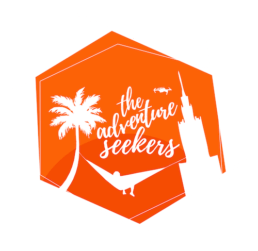
- Work with us
- Get to know us
© 2024 The Adventure Seekers. All rights reserved
Faroe Islands on a budget. Is it even possible?
Visiting faroe islands has been on my bucket list for a few years now. ever since i travelled to scandinavia for the first time and found out how many different shades of green exist in the universe. first, i fell in love with norway, than went further north and spent three intense days in spitsbergen. now it was time for the land of the sheep. faroe islands are more beautiful than you could ever imagine (even after seeing thousands of photos on instagram). it’s a place where everyone knows each other and they’ve not yet discovered theft. it’s a country where everyone is a musician after they’re done with their day job , where sometimes you might have to look for an alternative route because there’s a giant ram standing in the middle of the road, and he has never lost a staring contest before. long story short, it’s the best place i’ve ever been to..
In this blog post I’ll tell you how I organized my trip to Faroe Islands and what I did to make it as budget friendly as possible. I’ll share with you our best tips for saving money in such an expensive country and tell you what we did wrong, but you can do better. I’ll give you details of the cheapest car rental (at least the cheapest one we managed to find) and a great Airbnb that looks better than in pictures and the hosts won’t mind giving you some flour when you’re in need (even though it’s the most expensive product in the country). I’ll tell you what I packed for this a trip and share some good sources of information that will be useful when planning a route. Details about where we have actually been and what we saw will succesfully appear on the blog in separate posts. You can expect a faroese adventure series. And not one that suddenly breaks off like Miętas story about Camino 😉
My 30th birthday with the sheep
Let me start by saying that this trip was special for me not only because I’ve wanted to visit Faroe Islands for years, but also because I planned it in such a way that I can spend my 30th birthday while I’m there. The plan was to wipe my thirty year old tears with sheep’s fur. It was not fulfilled however. I had so much fun that I forgot I was supposed to be depressed about growing old. Plus the sheep there run wild and don’t let anyone touch themselves. The main reason why this trip was so good was because of the crew. We went in a group of five, all girls: Doris, Maria, Pinks and Aga. After all, the best girly trips are the ones where you sweat your as off while hiking a mountain and break your nails on rocks when you try to be quick on a semi-legal route to the waterfall.
Since we’ve all been sailing for years and are used to shitty canned food and instant ramen we decided it’s best to pack some food from Poland instead of fancy clothes. That’s what helped us save a loooot of money. In Faroe Islands food is expensive. Any food. Since nothing really grows there except for potatoes and rhubarb. We saved some money on the luggage as well. Since our trip was planned mostly around hiking we decided that we don’t need to look good. Instead we packed just two sets of trekking clothes and some washing detergent. Because we didn’t have that much stuff we only needed 3 (instead of 5) registered bags (which cost extra).
Ok, let’s get to the important stuff. We spent 8 days in Faroe Islands (7 nights but we had a full day after we checked out from our Airbnb). We were there in peak tourist season (late July – early August). We visited 8 out of 18 islands that the archipelago consists of. We drove over 800 kilometers in our rented car and walked god knows how many more (we didn’t really track that. I didn’t always have my phone on me and it did die a few times after I used it to flight a drone, so the amount of kilometers it has counted on our hikes was 56). I’m not going to write about drone regulations here (I don’t want to be responsible for someone not checking it properly themselves and doing something wrong), so I’d just advise you to do the research for youself. All the basic info can be found HERE . For the first time ever I managed to do almost everything I wanted to do during a trip. But I’ll definitely be coming back for some music event, preferably concert in a grotto , for a feast in a Michelin awarded KOKS restaurant and for a stroll in the National Museum of Art (we visited the capital on sunday so it was closed).
How to organize a trip to Faroe Islands?
First of all do it ahead of time. Book your flight, your stay, your tourist attractions in advance if possible. Acting fast is the one thing that we failed at and it cost as a lot of money. Travelling in a bigger group has its perks (splitting the cost of accomodation, shopping, car rental, gas, etc.) but it also has some major disadvantages. The biggest one being having to wait for every one to make a decision, to check their schedules for wedding and other ‘unskippable’ events, to submit vacation requests at work, to check whether they can actually afford it.
Cheap flights to Faroe Islands
That was the thing we spent the most on. But those were the costs that could easily be avoided (see point above). When I first started looking for cheap flights, the ones form Copenhagen to Vagar cost as little as 125 € there and back. When we finally decided on a date and got around to actually booking the flights the cheapest seat cost 152 € , but I was the only one who managed to get it at this price. The rest of the gang paid between 170 and 205 € . And it still didn’t teach us anything. We waited with booking the flights from Warsaw to Copanhagen for so long that we ended up paying for them more than for the ones to Faroe Islands. Embarrassing? Well, yes. Hopefully next time everyone will just book flights before even starting to think about things that may get in a way of holiday.
Best accommodation in Faroe Islands
Ok with this we actually did good! When we started looking there wasn’t much choice since everything was mostly booked for the season, but somehow we managed to book an amazing Airbnb in the city of Klaksvik . I highly recommend this place, but be aware: staying up north means you’ll have to spend more money on underwater tunnels fee. Anyway, we were really happy with the house we found. The hosts were lovely and helpful. We had plenty of space (6 beds and a big but cozy room with a sofa where we spent most our evenings), amazing view on the harbour, a washer and dryer and all of the kitchen utensils that you could ever dream of. We had a spot where we could park our car for free (whch was really important for us) and we lived right next to a supermarket. And we only paid 27 € per night per person.
That’s a really good offer since the ‘alternative’ doesn’t really exist. There arent many hostels (and the ones that do exist charge aroun 20-25 € per night per person for a dormitory). Camping is an option, but you can only set up your tent in the designated place which costs quite a bit as well.
We quickly realised that we weren’t the only residents of the house. A king of huldufólk people, called Marjun (we later found out it’s a female name, so just ignore this fact), lived with us. Although Pinks and Maria are afraid of Marjuna’s alluring lips to this day, he quickly became the sixth member of our crew. He ‘drank beer’ with us, ‘played board games’ and went on trips. k, the last one is true. If you ever stay at “our” house, be sure to take Marjun the dwarf with you on your hking adventures, and then share your photos! Marjun has a soul of a troll and will eat your sweets when you’re not looking, but it’s worth having him on your side;)
Renting a car in Faroe Islands
I won’t write about everything related to renting a car in Faroe Islands in detail. I hope that Doris, who was our driver, will create a separate post all about road conditions, car costs, traffic law, etc. All you need to know for now is that we got our Ford Focus at Unicar.fo rental. They had the best prices we could find. The car was big enought for as and all of our stuff. We paid 800 € for 8 days with the highest insurance option possible. 2 underwater tunnel fees were included in the price as well and we got 20% off for additional ones. We had to pay the deposit of 275 € as well, but we got it back straight after we got back t Poland (excluding any additional tunnel fees). We used PayPal to pay for the car in advance. Once we wrrived to the airport the car was already waiting for us, open, with the keys and all the documents in the glove box.
Is it possible to travel around Faroe slands withut a car? I guess so, but we decided that we don’t have enought time to try. There are some buses going to most of the cities, you can use a ferry without a car as well. I’ve read that the Faroese don’t mind taking hitchhikers, often driving them wherever they need to go even if they don’t go there themselves, but I’m guessing it would still make it difficult to go everywhere you want.
Planning in advance
Once you figure out what it is you want to do in Faroe Islands, book everything right away! In our case the procrastination almost ended in tragedy! (don’t mind my ‘slight exaggeration’, I’m just building tension here). We were close to not going to Mykines, an island dominated by puffins, which is an absolute must-see! It turned out that if you want to book a trip to Mykines the week before, there are most likely no ferries available anymore. Do you remember when I said that the Faroese season is very short, so tourist attractions are occupied in July and August? Exactly. When planning my own trip somehow I “forgot” about tiny minor detail. And it almost ended in tears.
What to do if there are no more spots available on the ferry to Mykines? There is also a possibility of booking a helicopter flight, which, interestingly, is not much more expensive than a ferry. This, in turn, can be purchased at the earliest seven days before the planned trip (to give the locals a chance to get out of their own island). What’s most important however is that it is not possible to buy a return ticket for the same day. So most tourists decide to travel by helicopter one way, and by ferry (which has no places, remember?) the other. An alternative is to spend the night on Mykines, which is possible, but super expensive.
So how come we have pictures of Puffins? Well we were lucky and got to go to Mykines in the end. Fortunately, due to high demand (and the local wedding happening on Mykines the day we went there), it was decided to add additional ferry courses that day (and some other highly requested days in August). Additional ferries ran in the afternoon (there was less time for hiking on site) and only left if all seats were booked. More info about ferries and hiking permits (yes, in this one place you need to have a “puffin visa”) can be found in the post entirely dedicated to Mykines (which as of yet has not been written, but will come to life one day).
What to pack on a trip to Faroe Islands?
My first advice is to bring some food with you if you’re on a budget. I know it seems stingy, but that really is how you can save the most! We packed quite a lot of bread with a long expiration date. We used it to make sandwiches for the hike. Of course it didn’t last us a whole trip and we still had to buy some, but just be aware that bread is extremely expensive in Faroe Islands. The cheapest option we found were tiny buns from Bonus (the cheapest supermarket in the country) that you need to put in the oven for a few minutes. We also bought some vegetables and bananas in Bonus. One hing that you will not find in the supermarkets hovewer is alcohol. Alcoholic beverages can only be purchased at special shops called Rusan . We bought our beer at a shop that’s inside Føroya Bjór brewery in Klaksvik.
What else did we bring from Poland? Some oataand a lot of nuts and dried fruit, pasta and tomatoes in a carton, a small bag of semolina flour, from which we made a home-made pizza (that’s the way to live your life!) and some canned foods: chickpeas, tuna, beans. Vegan pastes for spreads also work pretty good since some do not require refrigeration. Any space that was left in the luggage was stuffed with chocolate, energy bars and fruit pouches that work best as a quick snack during hiking.
What you want need a lot of however is cash. The Faroese have their own currency (Faroese króna) but it works exactly the same way Danish króna does. You can withdraw both of them from ATMs at the airport and in the bigger cities. In most places you won’t need cash at all since you can pay by card almost everywhere. The only situation when you will need cash is when you’re sightseeing. You’ll need cash to pay for the ferry to Mykines or for the entrance to the Sørvágsvatn Lake, as well as for selected hiking routes that run through someone’s private area. In many places, payments are made on a ‘pay what you want’ basis, the suggested amount should then be thrown in the box next to the entrance gate (which you need to close behind you so that the sheep don’t escape). It’s best to check how much money you’ll need before going on a particular hike. Most were free, but the ones that weren’t cost quite a lot (for example, entering a lake costs DKK 200 per person which is around 27 €).
What about clothes? Here I have some conflicting information to give you. Without a doubt the most important things are non-slip and waterproof trekking shoes (you will spend most of your time climbing uphill on damp slippery grass, but you might also need to jump over streams). In addition, a scarf and a warmhat will be needed to defend yourself against the merciless wind on the cliffs. And be sure to pack a good waterproof jacket. Apparently, it is said that if you are extremely lucky then during one week of holidays in the Faroe Islands you will get one perfectly sunny day. And here comes my conflicting information: when we arrived it turned out there’s the summer of the century. In fact, it only rained one day (and again once in the evening) and there was hardly any wind. The thermometer did show from 13 to 16 degrees Celcius (that’s the average temperature in the summer), but in the sun it felt more like 20. Locals went crazy, children bathed in streams (water couldn’t have more than 3 degrees Celcius) on inflatable flamingos, and we were sweating like crazy. This situation does not happen often, but just in case I recommend you layer when planning your outfit. Especially since the weather can change dramatically in five minutes (see photos below taken 40 minutes apart). Oh, and don’t take umbrellas. That’s the easiest way to spot a tourist. The locals know that there’s not much point even owning an umbrella since the rain more frequently than not moves horizontal, rather than vertical.
Those of you who, like me, travel the world to take photos, be sure to pack the widest lens you own. The cliffs in Faroe Islands are massive and I did regret once or twice that I don’t have a tiny bit wider lens. I mostly used 24-70 mm F/3.5, occasionally switched to 35 mm F/1.2 when I needed some more light. I also packed an old Zenit 200 mm F/4 lens. I only used it once, on Mykines, but was really glad I had it. I would not be able to look the Puffins straight in their cute little eyes.
So, is it possible to visit Faroe Islands on a budget?
I won’t give you a clear answer. Depends what ‘on a budget’ means for you. Vacationing in Faroe Islands is bound to be more expensive than All Inclusive in Spain, but I guess, since you’re reading this blog post, you don’t care about All Inclusive that much. I think it is possible to go to Faroe Islands on a budget. I certainly spent less than I expected. Just don’t make the same mistakes we did and book everything in advance. And I mean REALLY IN ADVANCE. Not a month prior to boarding a plane. Of course you’ll have to make some tiny sacrifices. But as long as you can take a break from eating bread and eat oats brought from home instead, as long as you are willing to cook pasta with canned tomato instead of going to a restaurant and you don’t need alcohol to feel happy, you’ll be fine.
To finish off I’ll leave you with my cost calculations (per person). This is how much my entire trip cost:
Flights: 152 € (Copenhagen-Vagar) + 187 € (Warsaw-Copenhagen) ~ 340 €
Registered luggage: 7 €
Accomodation: 27 € per night = 189 € for a week
Car rental : 23 € per day = 161 € for a week (including insurance)
Costs of the car: 14 € (tunnels) + 8 € (ferry) + 23 € (gas) = 45 €
Food bought in Poland : 20 €
Food bought in Faroe Islands : 20 €
Tourist fees :
- MYKINES: 14 € (hiking permit) + 23 € (ferry)
- SORVAGSVATN LAKE : 27 €
- SAKSUN: 17 € (I’ve not been there because I was sick that day so I didn’t pay this one)
Restaurants and cafes: 50 € (1 lunch + 4 coffees, I did not pay for the most expensive dinner however, since I was invited by my friends as a birthday gift)
Beer bought at the local brewery: 9 € (I didn’t really drink since I was sick)
……………………………………………………………………………………………………………………………………………………….
Which means I spent a total of around 930 € during my week long trip to Faroe Islands. I don’t include costs of a two day long transfer in Copenhagen since we didn’t really have to spend that much time there. I think of it as a separate adventure. I dont include the cost of souvenirs and vinyls I bought in Torshavn either, because that’s just something extra that you don’t have to spend. But I have to admit, less than 1000 € for 8 days (7 nights, but we had a full day after we left our Airbnb) in Faroe Islands is way less than I expected.
Freelancer, also known as an unemployed. Etnographer and photographer. She spends most of her free time in Photoshop or Lightroom. The sole purpose of her life is to travel around the world (on top of her must-see list are thecountries where she can stuff her face with tacos). She values people who understand irony. Enjoys minigolf as well. When she grows up she'll run her own hostel and a restaurant. She decided to start writing a blog only because she wants someone to send her a Boosted Board ;)
Podobne posty
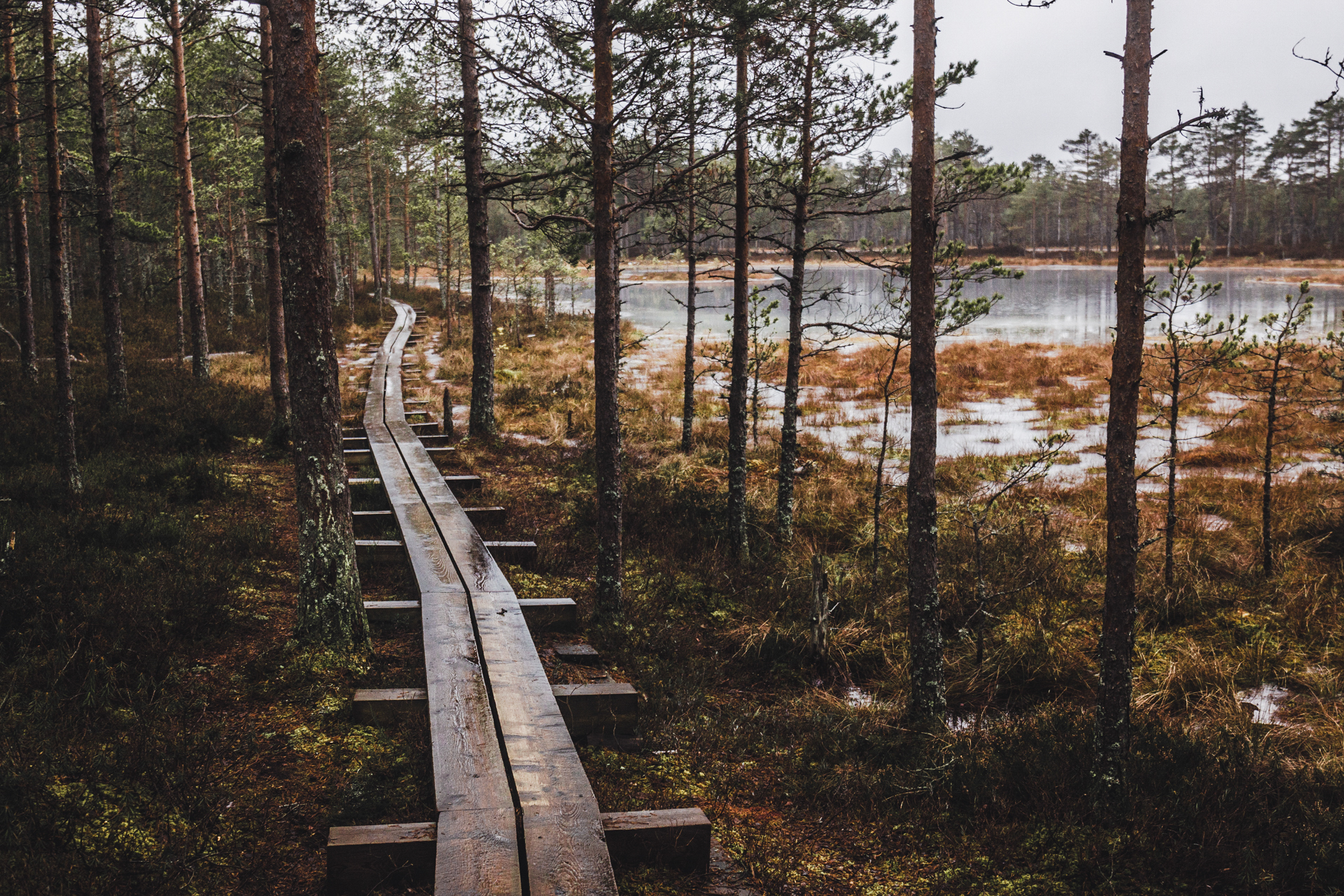
12 December 2018
Winter adventure – guide to Estonia
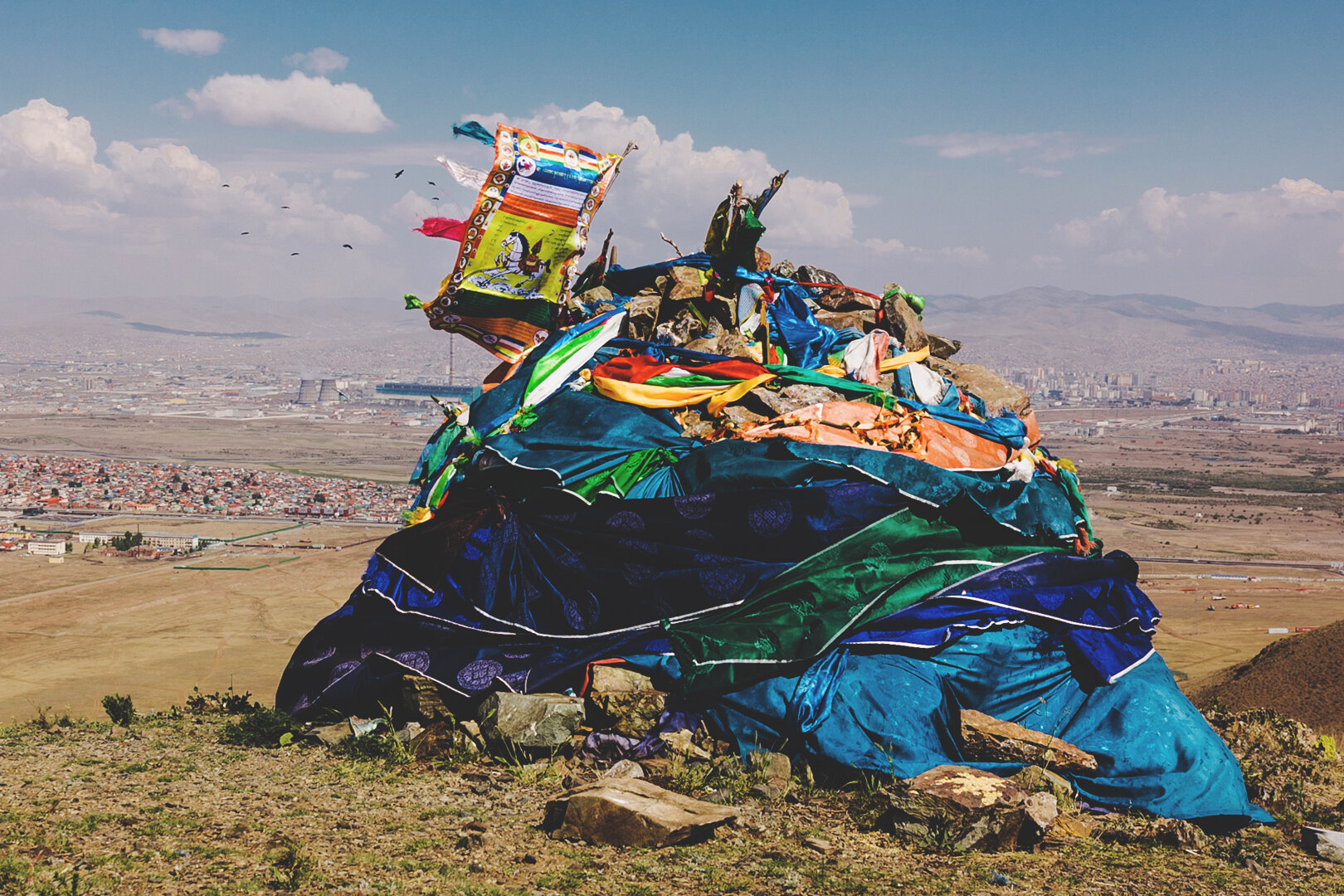
17 March 2018
How to organize a trip to Mongolia?
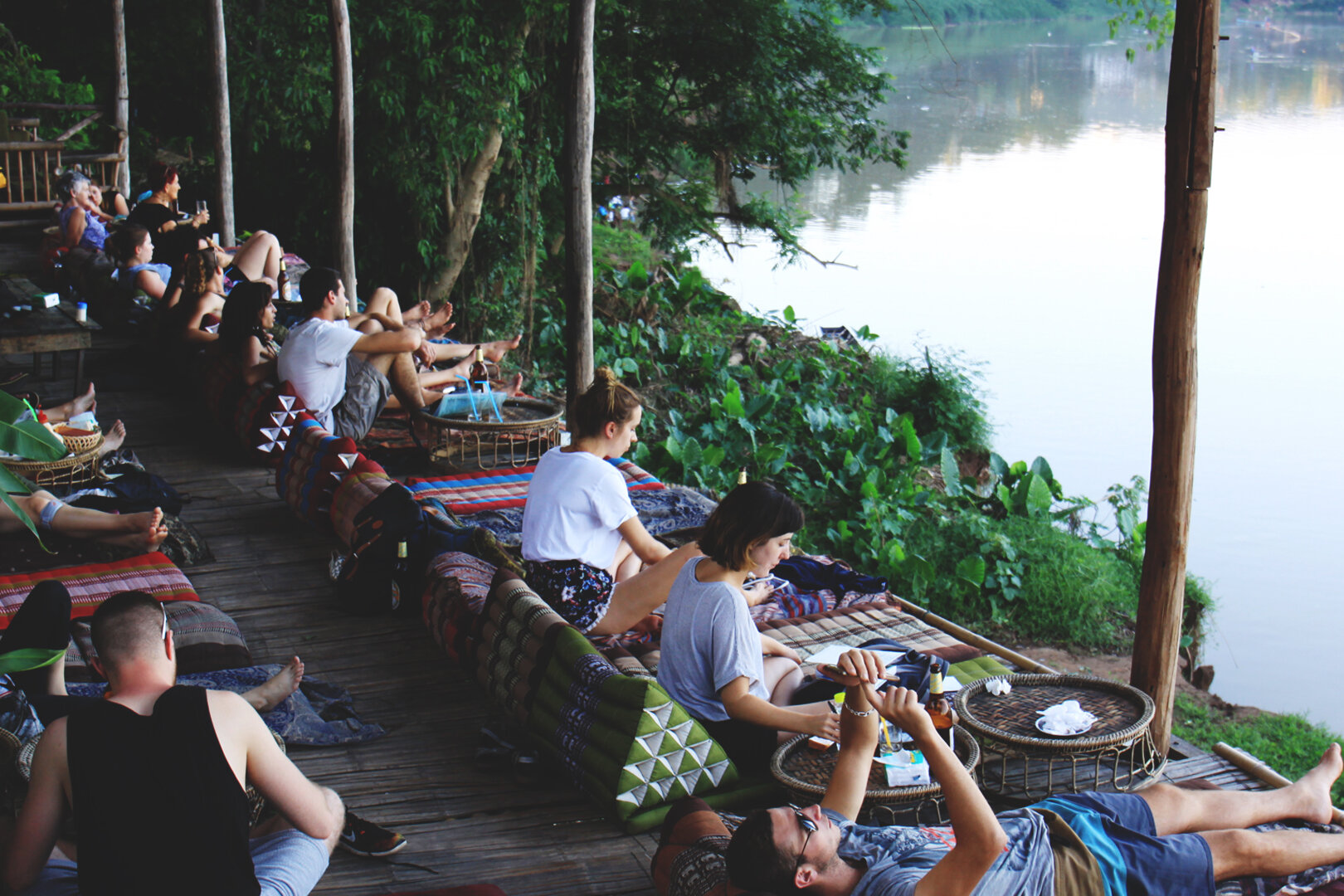
30 October 2017
Laos on a budget
Add comment cancel reply.
Save my name, email, and website in this browser for the next time I comment.

- Bosnia + Herzegovina
- Faroe Islands
- Philippines
- South Africa
- French Polynesia
- Solomon Islands
- Work With Me
The Perfect Faroe Islands Itinerary For 3, 7 or 10 Days
10 April 2019.
Rugged cliff lines, sweeping fjords, tiny gingerbread villages, spectacular coastal drives and pristine wilderness that unfolds beyond your window makes the Faroe Islands a perfect place for a road trip.
After two trips to the Faroe Islands, one in late summer when the landscapes were washed in brilliant greens and again in spring when the saffron-coloured grasslands were offset by thick snow, I’ve driven across much of the archipelago, explored on foot, returned to some places over and over again and only managing to squint at others through a thick layer of fog.
Whether you’ve got just 3 days to spare or 10, this is how I’d suggest planning your Faroe Islands itinerary to make the most of your time.
Before diving in though, it’s important to know that it pays to be a little flexible when exploring this remote cluster of islands. Frequently wild weather means plans have a habit of getting thrown out the window, ferries cancelled, hikes shelved for another day and epic viewpoints obliterated before your eyes. So, while I’d recommend using these itineraries as a guide, try to make use of good weather for the adventures that really need it and know when to throw in the towel and save an activity for another time rather than push on senselessly.
* This post includes affiliate links and any purchases made through these links will earn me a small commission at no extra cost to you. *
Visiting for a long weekend or perhaps enjoying a stopover on the Smyril Lines cruise ship? With 3 days in the Faroe Islands you’ll get a fantastic introduction to the archipelago and be able to tick off some of its most famous sites that will undoubtedly whet your appetite for a longer return journey.
Day 1 | Vágar
Hit the ground running with the Faroe Island’s most iconic sight – the majestic waterfall of Múlafossur tumbling from a vivid green cliff into the churning sea. Backed by towering cliff walls and the enchanting grass-roofed village of Gasadalur, it’s impossible to imagine a more magical sight or one more quintessentially Faroese to kick off your adventure.
Gasadalur sits less than half an hour from the airport along a stunning coastal drive that hugs the cliffs extending beyond Sørvágur and Bøur before disappearing into the eerie mountain tunnel that funnels you toward the once isolated village. If you’re arriving in the Faroes by ferry, you may wish to drop your luggage at your hotel in Tórshavn before setting off for the hour long drive.
The incredible waterfall scene is best experienced from the viewing platform opposite, but be sure to take the time to wander around the village itself and climb a short way up the hill beyond the falls.

Slowly make your way back toward Sørvágsvatn, or Leitisvatn as it’s also known, drinking in the views across the bay of the jagged spires of Tindhólmur, the perfect arch of Drangarnir and, on a clear day, the silhouette of Mykines twisting into the distance.
A short way beyond the airport, pull into the parking area to begin the hike along Sørvágsvatn to the soaring sea cliffs of Trælanípan.
Nestled in a lush basin, this lake was made famous by the optical illusion created when viewed from the cliffs that surround it where it appears to float precariously above the crashing sea. From here you can peer down the vertigo-inducing rockface that drops straight into the churning water, watch Bøsdalafossur spill into the ocean and clamber up the sweeping and rather steep hillsides to enjoy the views from every angle.
From the parking lot, it’s just 3 kilometres to the farthest point, an easy 1 hour each way, but you’ll most likely be persuaded to spend a whole lot more time here. This area is notoriously foggy and, though it should go without saying, remember to always be exceptionally careful when wandering about near the cliffs.
** UPDATE: As of April 2019 the trail along Sørvágsvatn to Trælanípan is restricted and visitors are required to pay a hiking fee and be accompanied by a guide. The cost is 450 DKK (€60) for adults, 150 DKK (€20) for children aged 7 to 14, and free for kids 6 and under. Guided hiking groups depart at 9 a.m., 12 and 3 p.m. daily. Book your tour here or visit this website for more information.
Sørvágsvatn is one of the most visited areas in the Faroe Islands and these measures have been put in place to help preserve the fragile natural environment and curb the strain from increasing foot traffic.
If this hike is slightly out of your budget, I’d highly recommend the nearby Fjallavatn as a stunning alternative. For the full guide, read this post or scroll down to Day 7 of this itinerary.
** UPDATE: Thankfully, it is now also possible to complete the hike without a guide, but you must pay the hiking fee of 200DKK (€27) at the entrance gate.

From here, avid birdwatchers and those unable to visit Mykines should head straight to Vestmanna to catch the final departure of the day for the famous bird cliff boat tour. On this two-hour trip, you’ll weave between the towering sea stacks and along the dramatic cliff line to bring you up close to the many species of seabirds that nest and forage in this rugged untouched setting.
Vestmanna Bird Cliff Tours run from May to September and cost 295 DKK per adult (€39.50) with just five daily departures during peak season. These trips are operated by the Vestmanna Tourist Centre and can sell out months in advance during busy periods so be sure to book your trip well in advance to avoid disappointment.
Check availability of the Vestmanna Bird Cliff Tours here and here .
Not much of a twitcher or saving yourself for Mykines? You might prefer to skip Vestmanna altogether and push onto Torshavn instead.
As you peel away from Sorvagsvatn, keep an eye out for the vibrant red-roofed church of Sandavágur and if you still feel the need to stretch your legs, follow the small road out the back of the village to begin the short walk to the gnarled spike of Trøllkonufingur, the Witch’s Finger, a key player in one of the Faroe’s most told legends.

Day 2 | Mykines or Kalsoy
Mykines is an essential stop on any Faroe Islands itinerary, but getting there isn’t always so easy.
This remote western isle is home to some of the archipelago’s most striking landscapes, but without a doubt its biggest draw are the thousands of puffins that nest here during the summer months.
From May through August, there are two daily ferries departing from Sørvágur at 10:20 a.m. and 4:20 p.m, returning from Mykines at 11:05 a.m. and 5:05 p.m. Tickets are 60 DKK (€8) each way and should be purchased in advance as crossings regularly fill up. You can buy your tickets here .
The alternative is to arrive by helicopter which makes the trip just four days a week, however, as this is used as a form of public transport for locals, tourists are only able to book tickets one way meaning you will still need to either arrive or depart by ferry and this often requires you to stay overnight on the island.
As a protected wetland area, all visitors to Mykines intending to explore beyond the village are required to pay a hiking fee of 100 DKK (€13) that contributes to the maintenance of the island. Though not essential, it is also recommended that visitors be accompanied by a guide. The hiking fee must be paid here , or you can book a guided tour here .
Note that many of the organised tours to Mykines include the ferry ticket and/or hiking fee so be sure to check what is covered before booking.

Now, while all this might sound rather straightforward, trips to Mykines are frequently cancelled at short notice due to wild weather, while persistently poor conditions may force hiking through sensitive areas (such as the puffin colonies) to be temporarily suspended.
For this reason, whether you’re visiting the Faroe Islands for 3 days or 10, I’d highly recommend trying to visit Mykines as soon as possible so that if your trip is cancelled you’ve still got enough time to reschedule.
If you’re visiting during summer and the weather behaves, a trip to Mykines is an absolute must! But if you’re not or it’s not, then I’d suggest heading to the northern isle of Kalsoy instead (skip ahead to Day 4 of this Faroe Islands itinerary for details).
Difficulties aside, those lucky enough to actually get to Mykines can expect an incredible day beginning with a journey past rocky archways fending off bursts of ocean spray and the impressive ridgeline of Tindhólmur before sticking close by the towering cliffs of the island.
The ferry trip is only around an hour but seas can be choppy so those prone to seasickness might consider taking something to avoid feeling queasy for the rest of the day.

Arriving on the final days of August, I’d been apprehensive that the puffins may have already begun to move south, but I really needn’t have worried. I was greeted by a mind-boggling display of the clumsy birds circling overhead en masse and it only got better from there.
Don’t miss the hike to the distant islet of Mykineshólmur and the lighthouse that marks the Faroe Island’s westernmost point. From the harbour, it’s about a 3-hour return hike up steep hills, across open meadows and tiny bridges and, best of all, between the frenetic hillsides where you’ll find the puffin’s burrows.
This area is a fascinating hum of activity with birds constantly coming and going, flouncing through the air and returning with beaks full of glassy-eyed fish for their pufflings hidden safely within their nests.
It’s easy to lose hours here, sitting, watching and photographing these beautiful creatures, but please, please be sure to stay on the path and do not disturb the birds or their burrows. Lingering too long or too close to their nests will also make them more reluctant to return so try to be mindful of your surroundings at all times and don’t be a nuisance for the sake of a photo.

As you make your way back to Torshavn, take a detour along Oyggjarvegur, a scenic mountain pass, and venture up the hair-raising Mjørkadalur road for sunset, or stop in at the viewpoint above Norðradalur.
These high points along the pass are blasted with incredibly strong winds and are often the first to recieve snow and the last to lose it so be extra careful when driving along these narrow roads and opening your car doors.
Day 3 | Streymoy and Eysturoy
After two fairly active days in the Faroe Islands, it’s time to spend some time behind the wheel meandering from one beautiful village to the next.
Leaving Torshavn, take the coastal road through the fjords, gazing up at the verdant green walls that cast a perfect watery reflection on a calm day, before turning onto the narrow buttercup road toward the ridiculously picturesque village of Saksun.
On my first Faroe Islands trip, this was a place I returned to over and over again, to wander across the hillsides, to watch the ethereal bay fill with water and to wait for the entire valley to be bathed in soft golden light. It’s also possible to walk around the bay to the beach beyond at low tide, just be sure to keep an eye on the tides.

Next up, head to the northernmost village of Streymoy, Tjørnuvík. Caught between a patchwork of iridescent green and a horseshoe bay of black shores and turquoise water, it’s an impossibly pretty setting and if you’re lucky, you may even be greeted by the comforting scent of freshly toasted waffles in the centre of town.
If you’re in need of some adventure and have some extra time on your hands, there’s a steep trail which leads over the mountains all the way back to Saksun, but it’s also possible to just hike to the ridgeline which affords spectacular views over the village and the dramatic folds of the peninsula. It’s a challenging hike, especially in the knee-deep snow that I encountered, and takes about 2 hours to the top following a combination of post markers and rocky cairns.
Also keep an eye out for Risin and Kellingin , two jagged sea stacks perched off the coast of Eysturoy.

Continue onwards to Gjogv, taking it slow along the spectacular mountain pass that swings around Slættaratindur and stopping at the viewpoints to explore a little further on foot.
At the village, it’s time to don those hiking boots again and hopefully catch another glimpse of some puffins. Though they’re nowhere near as abundant here as you’ll find on Mykines, if your trip to the western isle is cancelled or the ferries have finished running for the year, Gjogv is the next best option to view these wonderfully clumsy, pot-bellied birds.
Stop in at the pretty marina to marvel at the impressive rippled mounds of the northern isles before clambering up the grassy path toward the cliffs above the village.
Gjogv is also a rare place in the Faroe Islands outside of Torshavn where you’ll find a cafe so if you’re in need of some warmth before or after your walk, stop in at Gjaargardur Guesthouse . Reservations are now essential so be sure to book ahead (thanks to a kind reader for passing along this update!)

Since my first visit to the Faroe Islands when tourists were few and far between and the tiny village parking lots were virtually always empty, the situation these days is quite different. Many of these villages have very small populations, some numbering in the single digits, and the presence of even a few dozen tourists can certainly be felt and has been a source of tension for some locals.
I’ll admit that on this first visit I did a fair bit of aimless wandering across the landscapes, unsure of where the properties began and wilderness ended. But with the increasing number of visitors, it’s important to be respectful of the property boundaries that exist (i.e. don’t deliberately climb over fences) and particularly considerate of the residents’ privacy in these tiny villages.
This also goes for driving along the narrow single-track roads that lead in and out of these villages. Don’t just stop in the middle of the road for the sake of a photo, use the stopping bays appropriately and try not to drive at a snail’s pace to enjoy the view while some poor local sits patiently behind you attempting to make it home in a timely manner.

By this point in the day, time is probably seriously getting away from you. The long Arctic summer days can make it all too easy to forget the clock and try to use up every moment of daylight, especially when the weather is good. If the skies are clear don’t hesitate to drive a little longer as the evening light that gets cast across these islands is nothing short of spectacular.
If this is the final day of your Faroe Islands holiday, take your time making your way back to Torshavn via the rather exciting zigzag roads down to Funningur and Oyndarfjørður before cutting back across the island.
On a longer Faroe Islands trip, you’ll have time to explore the stunning northern isles and dedicate a day or two to setting out on foot. If you’ve followed the 3-day itinerary, I’d also recommend relocating to a new base in the north of the archipelago for a few days to cut down on driving time. Head there directly from Gjogv rather than returning to Torshavn.
Day 4 | Kalsoy
Kalsoy, the long thin island shaped like a witch’s bony finger, is perhaps the most famous of the northern isles and is home to the iconic Kallur Lighthouse that sits perched on the very tip of the peninsula offset by a wildly impressive backdrop.
Catch one of the morning ferries across from Klaksvik to Syðradalur to begin the drive to the northern village of Trøllanes. Prepare for plenty of spooky tunnels that cut through the island’s peaks and epic views as you zoom along the narrow fjord.
In the village, set off through the little red gate and follow the rambling sheep trails north into the countryside for the 45-minute walk to the lighthouse. This area is known for its violent winds and torrents of mist that roll across the escarpment so be sure to bring warm clothing and keep a close eye on the trails if the fog descends. Trust me, it’s far too easy to get funnelled off on the wrong tiny trail.
After your hike, backtrack to Mikladalur and stroll down to the wave-soaked rock platform to visit Kópakonan, the selkie woman who pays homage to perhaps my favourite Faroese folktale and the curse that she put upon the island. You can read all about it here .

Day 5 | Kunoy + Viðareiði
Make your way north to Kunoy, a tranquil tangle of tiny laneways, white-washed homes and rolling countryside that is best explored on foot.
After wandering about the town and taking in the views across the chiselled face of Kalsoy, follow the dirt track uphill to discover a rare feature of the archipelago, the forest of Kunoy. A well-laid path snakes through the lush grove leading to the wilderness beyond.
Next, cross over to Bordoy where you’ll find the tiny village of Muli located on the far northern tip of the island. It’s supposedly abandoned, though was certainly in use when I visited, and you’ll find a small cascade, a number of old stone ruins and plenty of birdlife on the grassy path that extends out past the village. The desolate potholed drive to get here is also beautiful.

On both visits to the Faroe Islands I found myself in the late afternoon winding my way to the beautifully situated village of Viðareiði in the hopes of climbing the enormous Villingardalsfjall. But after mornings filling with lazy strolls, soaking up the views and stopping every few minutes by the roadside for yet another photo, on both occasions I arrived far too late in the day to actually attempt the hike.
This tiny community has one of the most dramatic settings in the archipelago with a striking white church perched on the cliff’s edge backed by a craggy pyramid of rock. The best views, however, are found from above, gazing down on the scene.
The 4-hour hike up Villingardalsfjall is steep and requires a good deal of rocky scrambling, but if you’re short on time like I was, even an hour’s climb up the uneven slope will offer up a spectacular vantage point.

Day 6 | Torshavn and …
By this point in your trip, chances are that things haven’t quite gone according to plan. Perhaps a spell of wild weather stole away the views, a cancelled ferry put an end to your day trip or the epic hike you wanted to take was shelved for another day. So, I’d suggest reserving this penultimate day in your Faroe Islands itinerary as a contingency day.
Slowly make your way back to Torshavn, returning to the places you may have missed along the way, the villages you just need to take a second glance at or the hikes you were forced to put on hold.
Spend the afternoon exploring the charming Faroese capital. Stroll around the harbour where colourful boats bob two and fro and fishermen sell their catch of the day, get lost in the tiny knot of the old town where grass-roofed homes and white window frames are in full supply and take refuge in the galleries and cosy cafes hidden between the city streets.
If you’ve somehow been lucky enough to experience a rare week of good Faroese weather and have no need or desire to slowly amble your way back to the city, consider taking a day trip to Nolsoy instead. Set just 20-minutes from Torshavn, this brightly coloured village provides a warm welcome and that ‘country’ feeling without actually having to go all that far.
The 6-hour return hike to the lighthouse on the island’s southern tip is a beautiful way to spend a sunny day, though bear in mind that thick fog has a habit of sweeping across the peninsula at a moment’s notice. Check the ferry timetable for Nolsoy here .
Day 7 | Hike Fjallavatn and the Seastacks
With the famous hike along Sørvágsvatn already behind you, you may be surprised to learn that just a few short kilometres away lies the far less visited Fjallavatn, another Faroese lake that is perhaps even more impressive.
Rolling meadows, a hidden black sand beach, a thunderous waterfall and the quintessential Faroese cliff line rising from the ocean set the scene for an epic day of hiking.

The 13 km return hike to Fjallavatn begins beyond Vatnsoyrar and hugs the shore of the lake before emerging at an impressive panorama of angular peaks, wild ocean and a relentless stream of waves crashing against the black beach below. It’s rugged and remote and certainly one of the most beautiful views in the Faroe Islands. For the full guide to hiking Fjallavatn, see here .
Next, travel the short distance to the outskirts of Sørvágur to begin the hike to the sea stacks along the south coast of Vagar. It’s a relatively short walk, just 2 km each way, but as it passes through private property it’s best done with a guide. I did the hike with Jóhannus from Reika Adventures who is a wealth of information about the islands and their many hilarious quirks.

With three extra days carved out in your Faroe Islands itinerary, you’ll have time to explore the often overlooked but incredibly beautiful southern isles of Suðuroy and Sandoy.
Day 8 + 9 | Suðuroy
The Faroe’s southernmost isle gets far fewer visitors than its much more famous northern neighbours but I’m here to let you in on a little secret, it’s absolutely spectacular and the perfect place to wrap up your Faroe Islands trip.
Truth be told, I was greeted by some truly awful weather down here. The perpetually gloomy skies and hideous combination of wild winds, sleet and heavy snow meant that hiking was all but out of the question and many of the most scenic drives simply became impassable.
In the brief moments of calm sunshine though, the landscapes dressed in glistening white and bound by the jet-black cliffs was something quite special.
Catch the morning ferry across from Torshavn which should get you to Suduroy around midday.
Over the next two days, if the weather is on your side, hit the trails with a hike to Hvannhagi , a protected lake cradled beneath an impressive wall of rock that is rumoured to be one of the islands’ most impressive natural features, and follow the road north for a glimpse of Hvalba and Sandvik from where you can set off on foot to explore the rugged sea cliffs of the west coast.

If you’re more confined to your car, take the scenic coastal drive down the east coast to Vágur and wind your way up the pass that climbs high over the hills between Sumba and Lopra toward the weather station and the base of the near vertical incline of Beinisvørð. Wander along the cliffs here for some excellent bird watching opportunities – the winged creatures put on quite a show swooping and sailing between the rocky cracks – and, if you dare, attempt the ridiculously steep climb to the island’s highest point which offers up unparalleled views over the majestic folds of Suduroy.
Push onwards to Akraberg Lighthouse, the isolated southernmost point of the Faroe Islands that gazes across the windswept ocean, before backtracking through the charming village of Sumba and onwards to Tvøroyri to catch the ferry.
Don’t miss this more in-depth guide of things to do in Suduroy to help plan your visit.

Day 10 | Sandoy
Set a short ferry ride from Streymoy, Sandoy’s compact size, charming villages and sprawling beaches make it a wonderfully easy day trip from Torshavn, and because it seems to be left off so many people’s itineraries, it’s also an excellent place to explore without the crowds.
Get an early start on one of the first ferries of the day from Gamlarætt to Skopun. Weaving out of the tiny village you’re immediately thrust into the rolling countryside peppered by glassy lakes and before long you’ll be yearning to pull over to take a few snaps. Wind your way to the beautifully situated Dalur on Sandoy’s southern tip before slowly making your way back to catch the ferry, stopping at each village and pretty view as you go.

If you’ve got some extra time on your hands, it’s also worthwhile setting off to explore on foot. The trails climbing above Dalur and beyond Skopun offer up excellent views.
For more details on how to spend your time on Sandoy, check out this guide .
Back on Streymoy, Kirkjubøur is just a 5-minute drive from the ferry terminal and home to a traditional Faroese village of red window frames and grass-roofed houses as well as a collection of historical sights – the ruins of Magnus Cathedral, St Olaf’s Church and Kirkjubøargarður, one of the oldest inhabited wooden houses in the world.

You’ll find plenty more information about how to get around the Faroe Islands in this post , but for this itinerary, it’s definitely best to rent a car. If you’re not a driver, you could also theoretically use a combination of public transport and day tours. See this roundup of the best Faroe Island tours .
Vehicles can be picked up from the Vagar Airport or Torshavn. As always, be sure to read the insurance policy carefully before setting off as it might be a little different than what you’re used to.
Generally in the Faroe Islands, there’s no option for zero excess and each piece of damage is charged individually, whether it’s a tiny ding or a more serious collision. Third-party insurance is a good idea, just in case.
Compare car rental prices here.
Unsurprisingly, this remote collection of islands wedged in the North Atlantic is not the most budget-friendly destination, but there you will find a range of accommodation options to suit most budgets.
For a 3-day visit, I’d recommend staying in Torshavn where you’ll have access to plenty of restaurants and won’t have to bother with packing up and moving every day. For longer stays, I’d suggest picking a handful of bases from which to explore – Vagar, Torshavn and somewhere in the northern isles make the most sense depending on your chosen itinerary.
For those on a tight budget, hostels and Airbnbs present the best value, especially those with guest kitchens, while hotels offer up modern facilities often paired with stunning views of the Faroese landscapes.
These are all places I’ve used during my visits.
Torshavn | Hotel Føroyar | An excellent mid-range choice boasting spectacular views from its perch above town. The sumptuous buffet breakfast is exceptional and rooms are modern and spacious. Check rates and availability here.
Torshavn | Kerjalon Hostel | A clean spacious hostel with comfy beds and a fully equipped kitchen. Run by Hotel Føroyar and located just next door. Last I heard this was under renovation but should be up and running soon.
Vagar | Giljanes Hostel | Facilities are fairly basic here, but it’s one of the few budget-friendly options on the islands where you’ll find a large guest kitchen and lounge area along with a beautiful view across the bay. Check rates and availability here.
Nolsoy | Airbnb | This beautiful, bright house provides a wonderful refuge on Nolsoy and though it isn’t strictly locally run, the friendly owners can give you plenty of interesting insights into life on the islands.
Norðragøta | Airbnb | This big house with a fully equipped kitchen and comfy lounge area was a perfect base to explore the northern isles. Hosts are friendly and full of stories about their homeland.
Suðuroy | Hotel Bakkin | Located in Vágur, this simple but comfortable hotel includes breakfast. Check the latest reviews on TripAdvisor , or for rates and availability enquire here . Suduroy also has plenty of great options listed on Airbnb .
Considering visitors don’t get a great deal of opportunity to interact with locals on the islands, using Airbnbs actually provides a rare chance to get a local perspective on life on the islands, on tourism, on amusing cultural quirks and advice on how to actually pronounce the places you’re visiting because, trust me, between the accents and intonations you’re probably not saying anything right.
They often tend to be far more economical and offer up the chance to stay somewhere truly atmospheric, like a charming countryside cabin or grass-roofed home in the wilderness.
New to Airbnb? Sign up here and receive up to $30 off when you make your first booking.

Visiting The Faroe Islands Without A Car | The Best Day Tours For Your Visit

A Visitors’ Guide To Suduroy | The Faroes Spectacular Southern Isle

A Short Guide To Sandoy | The Faroes Quaint And Beautiful Southern Isle

Hiking To Fjallavatn, The Faroe Islands Other Lake

A Complete Beginner’s Guide To Travelling the Faroe Islands

23 Amazing Things To Do In The Faroe Islands


10 Things to Know Before Visiting the Faroe Islands
Leave a reply cancel reply.
Your email address will not be published. Required fields are marked *
Save my name, email, and website in this browser for the next time I comment.
Post comment
This site uses Akismet to reduce spam. Learn how your comment data is processed .
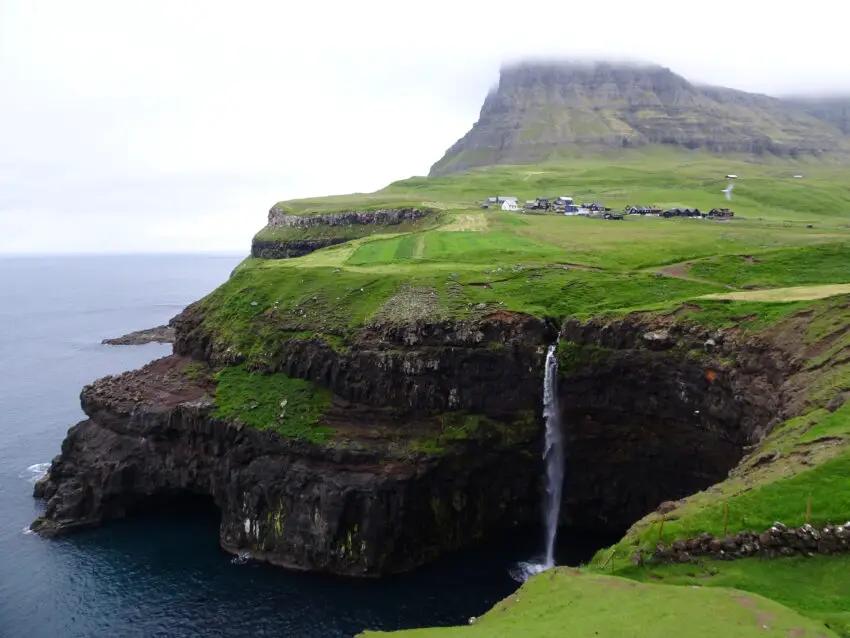
The Perfect One-Week Itinerary for the Faroe Islands
Share this Post:
While exploring the beautiful Faroe Islands , we met a lot of people who were only visiting the archipelago for a couple of days on their way to Iceland. Combining the two destinations surely makes for a nice trip, but you’ll really only be able to scratch the very surface of the Faroe Islands in such a short amount of time.
Stefanie and I spent almost three weeks there, thoroughly exploring 11 of the 18 islands. I’m aware that most people’s time is likely more limited, so I decided to combine our favourite spots into a well-rounded One-Week Itinerary , introducing you to all the top sights as well as some more remote locations on the islands.
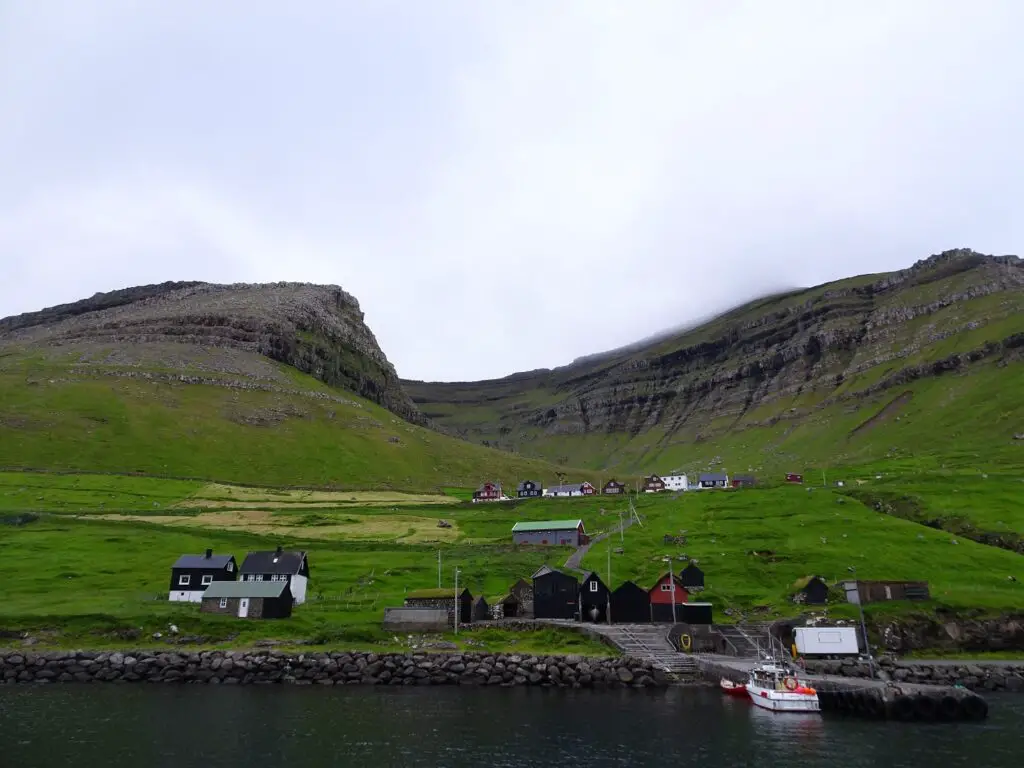
T his post may contain affiliate links, and I might earn a small commission at no additional cost to you. For more info, click here .

Guided Tours of the Faroe Islands
If you prefer to explore the Faroe Islands without the hassle of sorting out your own transport, accommodation and schedules, taking an organized tour might be the way to got for you. There are plenty of companies offering one-week tours of the Islands . Have a look below for some options.
Day 1: Tórshavn
Tórshavn proudly presents itself as one of the smallest capital cities in the world, but in my opinion, there’s enough to see to hold your interest for at least a day. Our favourite part of the city was Tinganes , the historical government quarter, consisting of beautiful red-painted wooden houses with traditional grass roofs.
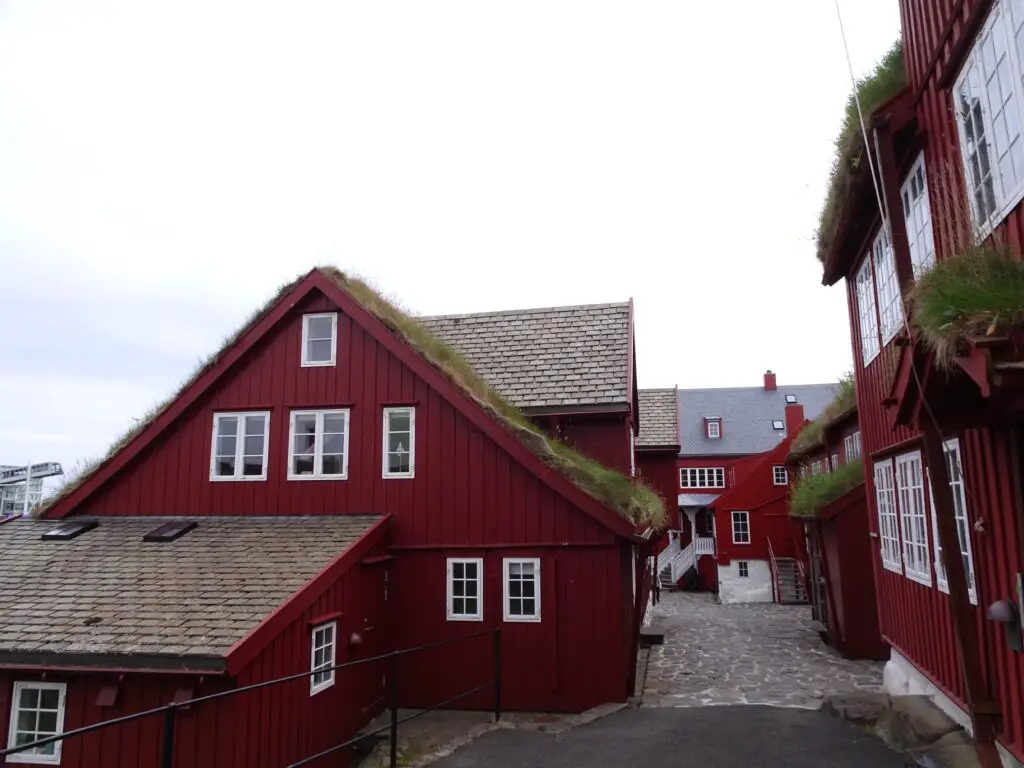
Other cool things to check out are the National Museum , which includes an open-air section with traditional Farm Buildings, the amazing National Gallery sitting in the cute Skansen Park and the Nordic House Cultural Centre , which sports a unique organic architecture. Tórshavn is certainly one of the quaintest capitals we’ve ever come across.
See Also: A Great One-Day Itinerary for Tórshavn, the Quaint Capital of the Faroe Islands
- Budget Accommodation Tip: 62N Guesthouse Marknagil
- Midrange Accommodation Tip: Guesthouse at the Boat Harbour
- Luxury Accommodation Tip: Hotel Hafnia
Day 2: Streymoy
Tórshavn sits on Streymoy, the main island of the archipelago, and on the second day, you can use the capital as a base to explore the rest of the island. You could start your day with a hike from Tórshavn to nearby Kirkjubøur or take a car or bus, if the weather is bad for hiking.
The tiny village at the southwestern coast of Streymoy has plenty to offer : The historically important St. Olav’s Church, the atmospheric ruins of St. Magnus Cathedral as well as Kirkjubøargarður, a traditional homestead and the oldest continually inhabited wooden building in the world.
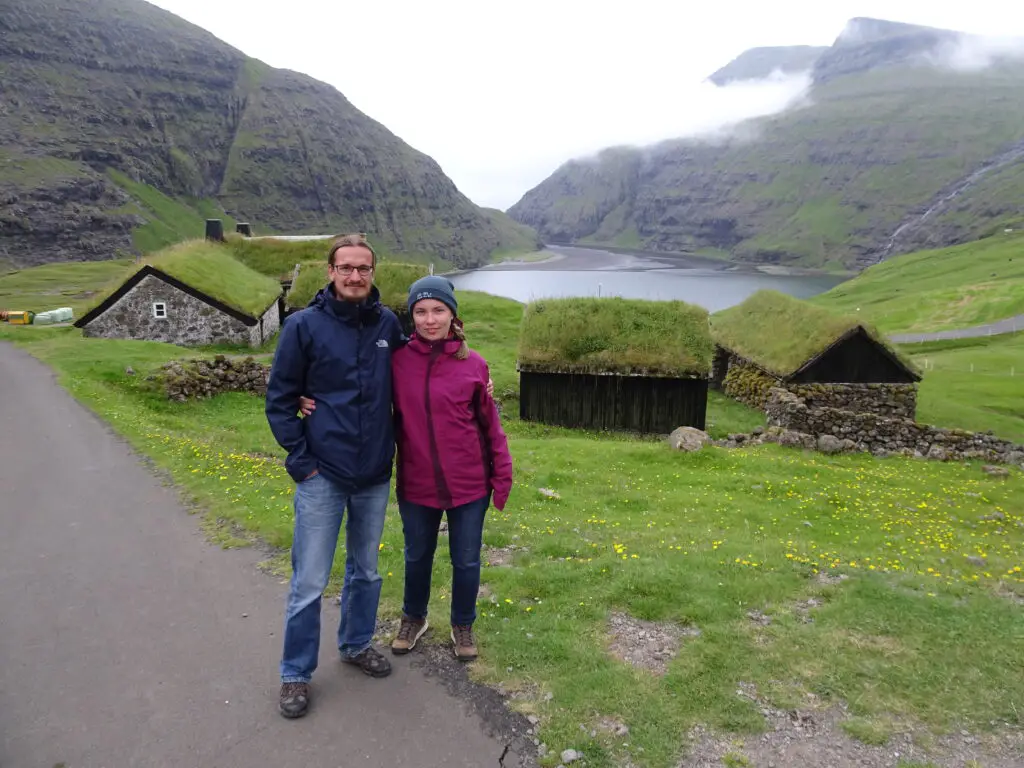
If you have a rental car (or are willing to hitch-hike), you could also make your way to tiny Saksun in the northern part of the island, which seems to spring straight from a fairytale with its scenic surroundings and beautiful grass-roofed houses.
Otherwise, take a bus to Vestmanna , where you can visit the small Saga Museum, detailing the Islands’ (often bloody) Myths and History, before taking a fun boat ride along the dramatic bird-cliffs , which are full of puffins, fulmars, guillemots and cormorants.
Day 3: Gjógv and Northern Eysturoy
On your third day, you should make your way to Eysturoy, the oddly-shaped island lying directly to the East of Streymoy. While the southern part of the island is full of small villages, the northern half is much more scenic, and I suggest you use quaint Gjógv as a base for your explorations.
Apart from the famous gorge , whose walls are populated by tons of cute puffins, we loved walking along the top of the tall sea cliffs as well as hiking into the pretty Ambadalur Valley (although you’ll have to look out for the super territorial Skuas, here – try to avoid their turf or be quick to duck when they come for you).
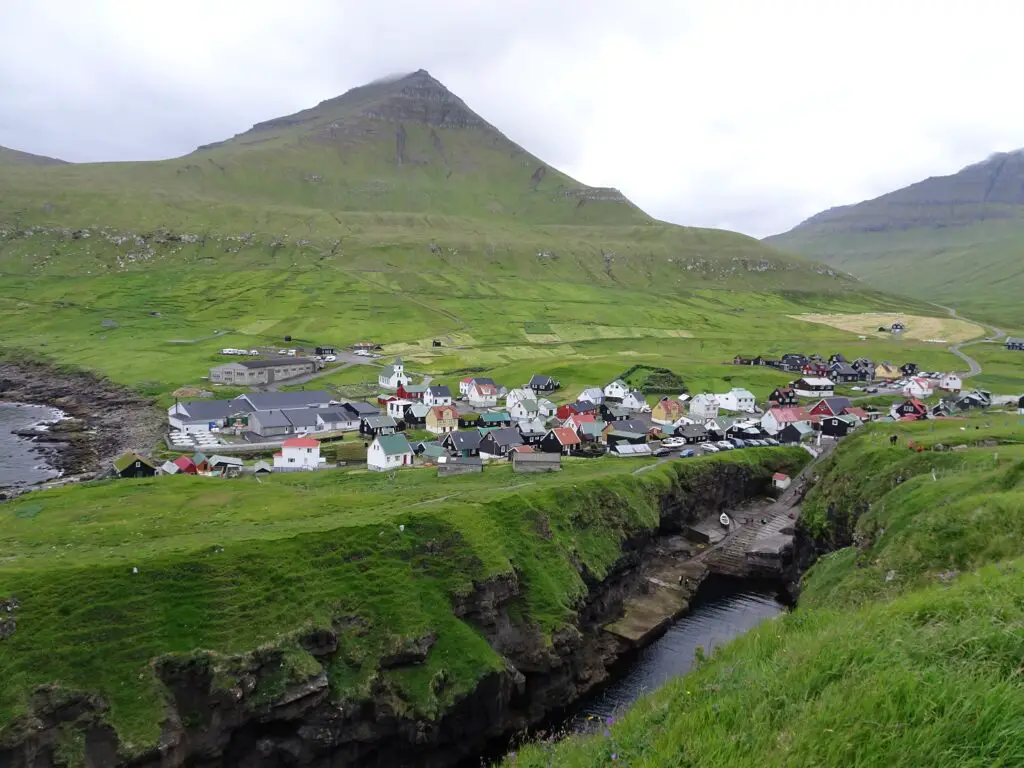
Gjógv is also a good base to tackle the climb to the top of Slættaratindur , the highest mountain on the islands, although the peak was shrouded in clouds when we were there, so we didn’t attempt the climb. If you’re in town on a Wednesday, you also have the opportunity to experience the unique Faroese Cultural Evening offered by the Gjaargardur Guesthouse.
With a buffet of local food , a musical performance by singer-songwriter Guðrið Hansdóttir and an introduction to traditional Faroese Chaindance , we found it to be the perfect initiation to the Islands’ Culture.
- Accommodation Tip: Gjaargardur Guesthouse
Day 4: Bordoy and Kalsoy
Continue east to the group of northern islands, which are collectively known as Nordoy . This was my favourite area on the archipelago. The islands are smaller and seem to rise out of the Ocean even more dramatically than the rest of the Faroe’s, if that’s even possible.
Kláksvik , the biggest town after Tórshavn, is centrally located on Borðoy and a good base to explore the area. There’s an impressive church , a couple of small museums (with very erratic opening times) and a few nice cafés and bars in town.
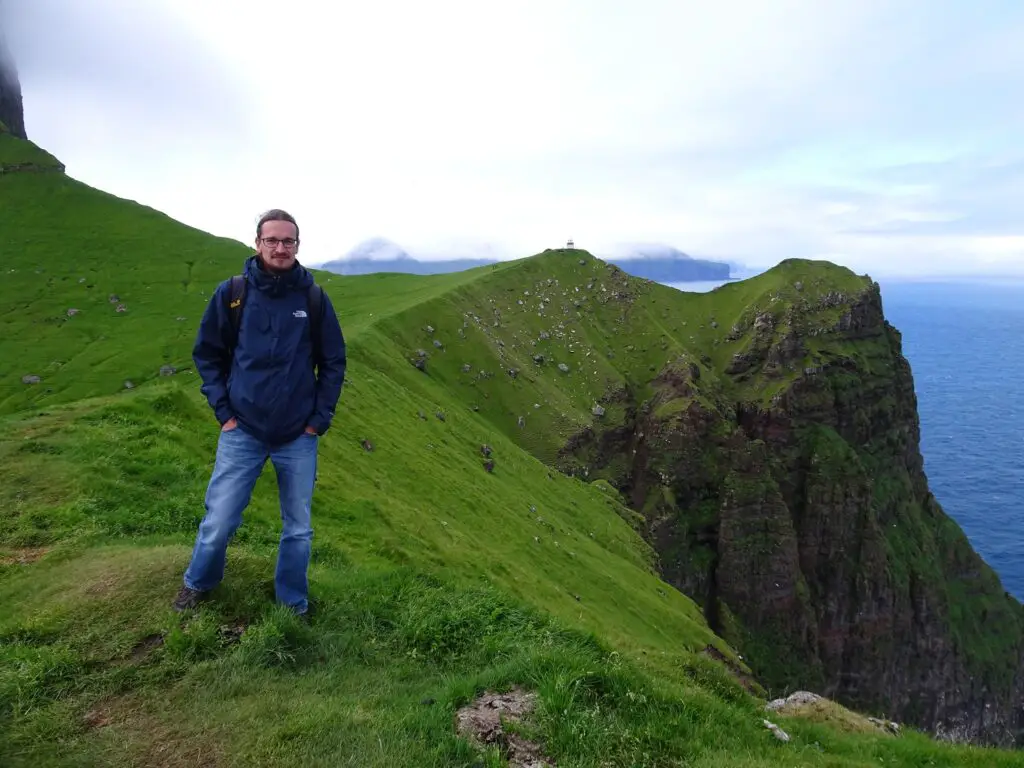
From Kláksvik you can take a ferry to nearby Kalsoy Island and then a bus to Trøllanes, from where you can hike to Kallur Lighthouse , which sits at the very northern tip of the island in a super dramatic and picturesque location.
The island is also home to the ‘Kiosk at the End of the World’ in Trøllanes (a good place for waffles and hot chocolate) and the famed statue of the Seal Woman in Mikladalur . Just keep in mind that buses are a little sporadic here, so plan accordingly, or you’ll be stranded on the island for the night.
- Midrange Accommodation Tip: Hotel Kláksvik (+298 455333) or Cozy Cottage
- Luxury Accommodation Tip: Panorama Boathouse
Day 5: Kunoy or Fugloy
If you’re up for a hike, you could make your way to the abandoned village of Skarð on Kunoy Island. The village has been in ruins since the early 20th century and is very atmospheric, but the hike is quite strenuous and requires crossing countless little streams and brooks.

If you do decide to go for it, keep your eyes peeled for Grey Seals in the Ocean – on our hike, we had an encounter with a seal chewing on a fish, who seemed just as interested in us than we were in him. If you’re not in the mood for hiking, you could also take a trip to remote Fugloy .
We found the perfect way to do this was to take the Post Boat from Hvannasund in the morning, disembarking in Hattarvík on Fugloy and then making your way to Kirkja (home to a tiny church and even tinier café), from where you can take a surprisingly cheap helicopter flight back to Kláksvik, allowing you to see the islands from a very different perspective.
Day 6: Vágar
For your final days on the Faroes, make your way to Vágar, the island lying to the West of Streymoy. A good base to explore this area is quaint Miðvágur , from where it’s just a short distance by foot to the serene Lake Sørvágsvatn , which contains a real-life optical illusion.
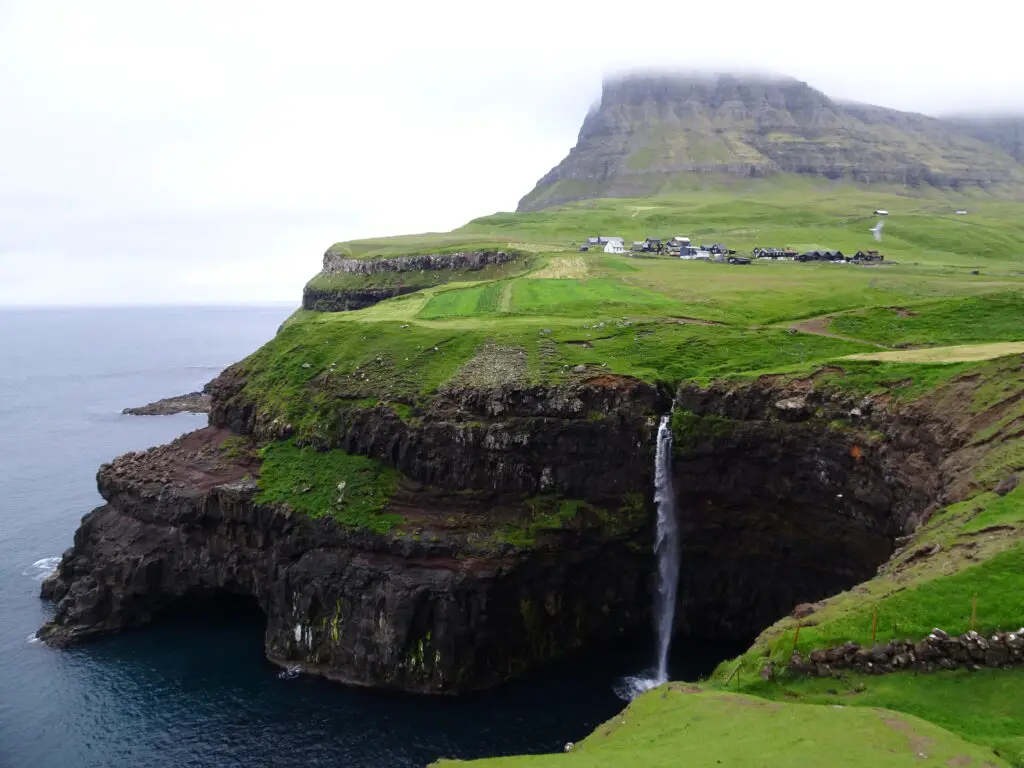
The island is also home to Bøur, which we found to be one of the cutest villages on the Islands, as well as Múlafossur – definitely the Faroe’s most picturesque waterfall in the tiny isolated hamlet of Gásadalur in the western part of the island.
The latter isn’t served by bus, so to reach it, you’ll either need to rent a car / hitch-hike or follow a very steep hiking path over the mountains. Try Giljanes Hostel in Miðvágur if you want to rent a cheap car for a few days.
- Budget Accommodation Tip: Giljanes Hostel
- Midrange Accommodation Tip: Guesthouse Hugo
- Luxury Accommodation Tip: Gásadalur Apartments
Day 7: Mykines
A visit to the small island of Mykines off Vágar’s western coast should be on every Faroe Islands Itinerary. We knew that Mykines nickname is “Bird Island”, but we were still absolutely blown away by the large number of cute puffins populating the cliffs in the western part of the island.

There are also plenty of other seabirds around, including lots of Fulmars and Guillemots. The island also has great opportunities for hiking and on a clear day the view from the highest peak is breathtaking.
Mykines can be reached by ferry from the village of Sørvágur in the western part of Vágar Island. It’s easy to visit it on a day trip from Miðvágur or even Tórshavn, as buses terminate just at the harbour in Sørvágur.
If the weather is stormy, the ferry service might be suspended, so if you want to make sure that your trip to Mykines will work out, you could also switch Day 6 and 7.
See Also: What to Know About Visting the Puffins on Mykines, Faroe Islands
Longer Stays on the Faroe Islands
If, like us, you want to explore the islands more in-depth, it really pays to stay 2 or even 3 weeks . First of all, that would allow you to also visit the southern islands of Sandoy and Suðuroy .
On our trip, we had to skip the latter, but very much enjoyed exploring the cute villages and wacky sights of Sandoy – including the Knitted Stone near Sandur and the biggest letterbox in the world in Skopun.
You could also visit some of the smaller islands, like Nolsoy , which can easily be reached by boat from Tórshavn. It has a cute main village and the hike to the Lighthouse at the southern tip of the island is pretty easy, but still very scenic.
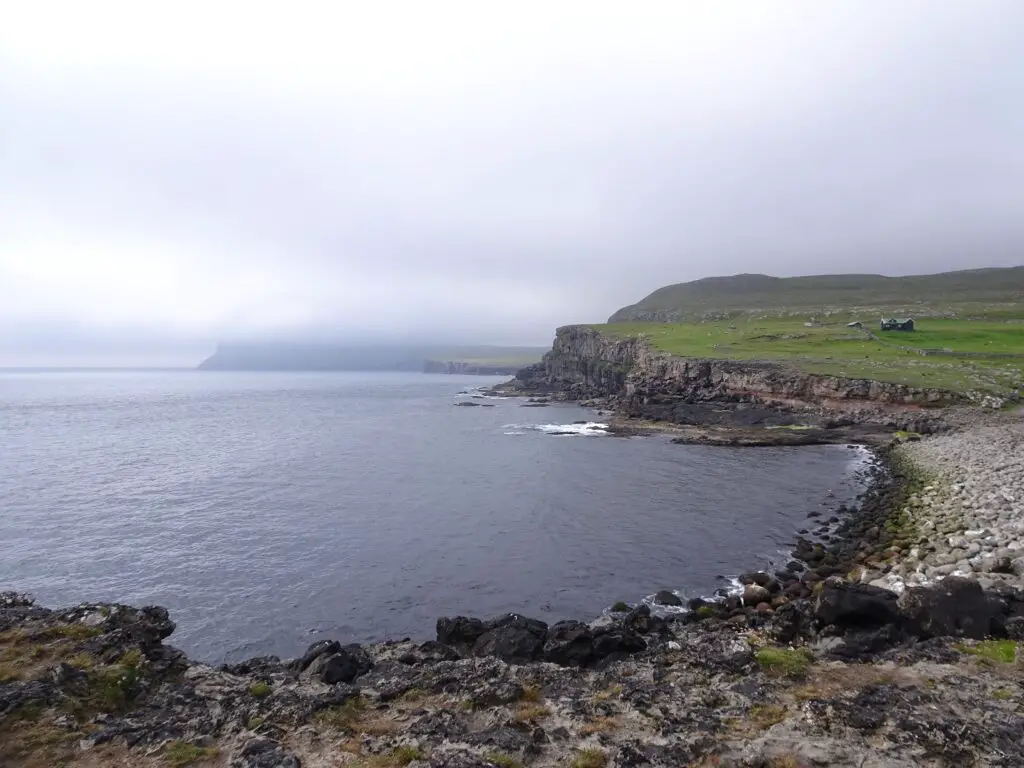
Finally, you could explore the other islands more thoroughly by spending an extra day or two in the places mentioned in the one-week itinerary. For instance, we found the villages of Haldórsvík and Tjørnuvík on Streymoy worth checking out.
On Eysturoy you could visit cute Fuglafjørður Village , Eiði – from where you can see the famous Risin og Kellingin Rock formation off the coast – as well as the remains of an excavated Viking Longhouse in tiny Leirvík.
A Two-Week Itinerary for the Faroe Islands
If you’ve got 2 weeks, I’d suggest the following itinerary. This is assuming you arrive by plane on Vágar – otherwise you could also switch the days on Vágar and Streymoy:
- Day 1: Vágar (Gásadalur, Sørvágsvatn and Miðvágur)
- Day 2: Mykines (Visit the Puffins and climb Knúkur)
- Day 3: Northern Eysturoy (Visit Gjógv and do the Ambadalur Hike)
- Day 4: Northern Eysturoy (Eiði Village and Slaettaratindur)
- Day 5: Central and Southern Eysturoy (Fuglafjørður, Leirvík)
- Day 6: Bordoy (Kláksvik Town and Klakkur Hike)
- Day 7: Fugloy (Go there by Post Boat and return to Kláksvik by Helicopter)
- Day 8: Kunoy (Kunoy Village and Skarð)
- Day 9: Kalsoy (Trøllanes, Kallur Lighthouse and Mikladalur)
- Day 10: Travel to Sandoy
- Day 11: Sandoy (Skopun, Sandur, Skálavik and Húsavik)
- Day 12: Streymoy (Kirkjubøur, Saksun, Vestmanna)
- Day 13: Nolsoy
- Day 14: Tórshavn
Backpacking the Faroe Islands on a Budget – The Ultimate Guide
How to Reach the Faroe Islands by Ferry from Denmark and Iceland
Leave a Reply Cancel reply
Your email address will not be published. Required fields are marked *
Save my name, email, and website in this browser for the next time I comment.
- More Networks
- Destinations
Wild Junket

Travel Faroe Islands: A Detailed Guide and Itinerary
Last Updated on March 18, 2024
Are you planning to travel Faroe Islands? Here’s my complete Faroe Islands travel guide and itinerary with details on the best places to explore, eat and sleep in 4 days.
In the depths of the Atlantic Ocean, tiny islands with jagged peaks and vertiginous cliff faces jut out from the sea, piercing into the sky like giant daggers. Sea stacks, craggy bird cliffs and black sandy beaches dot the coast, while steep snowcapped mountains stretch across the length of the islands.
This archipelago of 18 islands lies in the intersection point of three popular destinations: Iceland, Scotland and Norway. Just like its neighbors, the Faroe Islands has it all. The Northern Lights, world-class hiking trails, an abundance of nature, wildlife and Scandinavian traditions. But few people know about them, and the Faroese prefer to keep it that way.
What makes the Faroe Islands so special to me is that it’s so rugged, wild and small. It truly feels like you’re in the middle of the ocean here. No matter where you go on the Faroe Islands, you are never more than 5 km from the coast. The country is largely covered by wilderness and even the largest towns on the island have populations in their hundreds.

Table of Contents
History of the Faroe Islands
When to travel faroe islands, by car rental, by helicopter, day tours on the faroe islands, hotel føroyar, hotel vagar, hotel gjáargarður in gjogv, where to eat on the faroe islands, how much does it cost to travel faroe islands, what to pack for faroe islands.
- Day 1: Explore Gásadalur and Sørvágsvatn
Day 2: Visit Mykines and Gjógv
Day 3: drive to kalsoy, tjørnuvík and saksun , day 4: get to know torshavn, day 5: fly home, ready to travel to the faroe islands, travel faroe islands.
The first people to settle here were Irish monks, who arrived in the 6th century. Norsemen then settled the Faroe Islands in the 9th century and the islands became a part of the Kingdom of Norway in 1035. Norwegian rule on the islands continued until 1380, when the islands became part of the dual Denmark–Norway kingdom.
The Faroe Islands came under the administration of Denmark following the 1814 Treaty of Kiel that ended the dual Denmark–Norway kingdom. After an independence referendum in 1946 (unrecognized by Denmark), the Faroe Islands were given extended self-governance with the Danish Realm in 1948.
The Faroes may be a part of the Kingdom of Denmark (just like Greenland is), but they have a cultural identity of their own and they are extremely proud of it. They have been self-governing since 1948, they have their own language (that is closer to Icelandic than Danish), traditions and customs. Ask any Faroese how they feel and they would reply, “We are not Danes — we are Faroese.”

Summer is also the best time to see puffins on Mykines island as that is their nesting season. Each summer, they gather on the slopes of the island, burrowing holes to build their nests. I saw hundreds of them on Mykines even in May during my visit – so try to time your trip to this time of the year if you want to see them.
In my opinion, you can also visit during the shoulder season (May-June and September-October) if you’re looking to travel on a budget and have the place to yourself. Whenever you choose to visit, be aware that weather in the Faroe Islands is a fickle beast at any time of year so come prepared for all eventualities.

How to Get to the Faroe Islands
As wild and remote as the Faroe Islands are, they aren’t really that difficult or expensive to get to from mainland Europe. Don’t expect to pay prices that you would for a standard flight in mainland Europe, but they are actually affordable considering what a special place the Faroe Islands is. The most common way is of course on a plane but it is also possible to get there by boat from Denmark and Iceland. Here’s a detailed look at how to get to Faroe Islands.
Flying is an easy and convenient way to get to the Faroe Islands, PLUS the views of the Faroe Islands from the air are just mindblowing. I flew there from Copenhagen and got some great aerial shots when we were about to land in Sorvagur. There are currently 2 airlines that fly to the Faroe Islands:
Atlantic Airways: the national carrier, has 2 flights per day from Copenhagen, Billund, Aalborg, Bergen and Reykjavik. A return flight from Copenhagen to Sorvagur in summer costs around US$300.
Scandinavian Airline s: this well-known carrier now runs daily flights to the Faroe Islands from Copenhagen. It also has direct flights from London, Reykjavik and Copenhagen to Sorvagur.
Search for flights to Faroe Islands
Smyril Line’s ferry, M/S Norröna, sails to the Faroe Islands from Hirtshals in the north of Denmark and from Seyðisfjørður in Iceland. It doesn’t sail frequently though, so make sure to check by its website for the scheduled departures. The best thing is that the ferry acts as a car ferry so you are allowed to transport your vehicle on it (at an extra cost).
This can make it quite a good deal if you rented a car in Iceland or Denmark and want to drive it here to save money on accommodation. The only thing to be aware of is that under rough seas the ferry may not be able to dock.
How to Get Around the Faroe Islands
Seeing that the Faroe Islands are so wild and rugged, they are surprisingly accessible by various modes of transport: car, ferry, helicopter and bus. Of all them, car and ferry are the best way to get around the Faroe Islands. Much of the Faroe Islands are covered by wilderness and many of the most beautiful and interesting sights are only accessible by small roads that zigzag through steep mountains.
There is a good public bus network that runs all over the islands, but buses don’t go to many of these remote but essential sights. Helicopters are surprisingly cheap, as they are subsidised by the government, so consider booking a helicopter flight if you are short on time.
I would highly recommend renting a car even if you are on a budget. I booked my car rental from Guide to Faroe Islands and the total cost of a 4-day rental was around 3,500 DKK (US$550). Get a friend to come along or find a travel partner online to split the car rental cost. I didn’t get a 4WD, but it might be useful if you intend to drive off road. A 4×4 cost around US$113 per day, while a compact car cost $90 per day to rent. Check here for car rental options!
When driving around the Faroe Islands, pay attention to the driving conditions and rules. Most roads are single lane, and it’s not allowed to overtake other vehicles on most highways. As the Faroe Islands are relatively mountainous, you’ll find yourself going up and down slopes and winding along fjords. Don’t be too distracted by the scenic landscapes when driving and only pull up when there is a road shoulder or parking space!
Book your Car Rental here!

To cross from one island to another, the ferry is the easiest, cheapest and most convenient choice. You can go to the island’s municipal website to check the ferry schedule. Most of them don’t need an advanced booking, except for the Mykines ferry that gets booked up easily (go here to book it in advance). You won’t make any payment when booking in advance — make sure you have cash to pay when you’re boarding the ferry.
Some towns (e.g. Sorgavur where you pick up the ferry to Mykines) do not have ATMs. Many islands are also served by car ferries — such as Kalsoy — and they usually don’t take advanced booking. So be sure to get there 30 minutes early to get in line.
If you’re looking to go to Skuvoy or another lesser-visited island during the low-season, you are best off giving a call to order that ferry. The fare isn’t extra, but they simply don’t run it otherwise. Be sure to check the ferry schedule always ahead of time.
For more information, including ferry schedules, head to Strandfaraskip Landsins website .

Atlantic Airways , the national carrier, also has a network of helicopter services to connect the islands. The service is subsidized by the government so it’s quite cheap and almost the same price as the ferry. For instance, you can fly from the main airport at Vagar to Mykines and the capital Torshavn. As you’d expect they save you time and offer some spectacular aerial views of the islands. I was going to book a helicopter ride to Mykines but it was fully booked at the time, so be sure to reserve a seat in advance.
Book your domestic flights here!

The main inter-town bus that they have is called Bygdaleiðir, w hich are easy to spot as they are dark blue. Check here for the complete timetable of the buses. It helps to note, however, that public transportation is expensive in the Faroe Islands, so it’s best to buy a travel (multiple-ride) card beforehand with Strandfaraskip Landsins at the airport or at the main bus terminal in Torshavn. This travel card covers busses and ferries around the islands (except to Mykines Island) and can cost 500 DKK (USD78) for 4-days.
Within the Torshavn municipality, the bus lines are free and there are six lines that operate in the area. In addition, these buses also will transport passengers out to the historic city of Kirkjubøur, a must-see for anyone interested in learning more about the history of the Faroe Islands and the people that inhabit them.
For solo travelers who cannot or prefer not to drive, it is possible to explore the Faroe Islands by booking day tours. These day tours are also great for those who are seeking adventure in the form of kayaking trips or horse-riding excursions. Day tours in the Faroe Islands are not cheap, but they tend to be about the same price as a day of car rental. I recommend booking your day tours on Guide to Faroe Islands, which has the most options to choose from. Here are some day tours I recommend:
- Kayaking to Dranganir — Row to the famous sea-stacks Drangarnir and further to the Tindhólm or Gásadal where you can feel the spray from the free-falling waterfall Múlafossur.
- Guided tour of Mykines — Visit Mykines with a local, see puffins and hike all about the island.
- Vestmanna Sea Cliffs — Hop on a boat trip along the base of Vestmanna Sea Cliffs.
- Horseriding around Torshavn — Horseback riding is a unique opportunity to explore the rough landscape around the capital Tórshavn.
- Home dining experience — Enjoy an authentic Faroese dinner in a private home called Hanusarstova, originally built in 1898 and totally renovated in 2014.

Where to Stay on the Faroe Islands
There’s a good variety of accommodation providers on the Faroe Islands, with at least one guest house in every town (not village though). I found that even remote areas like Gjogv and Mykines had very good accommodation standards. Every single guest house and hotel I stayed at was comfortable and excellent.
Camping in the Faroe Islands, sadly, is only permitted at designated campsites. It is not permitted to stay overnight in your campervans along the road, at rest stops, lay-bys or view areas. Because of the unpredictable weather even in summer, it is advisable to have sturdy, waterproof and windproof camping equipment.
This is easily the best hotel in the Faroe Islands. The stylish four-star hotel is perched on the hilltop of Torshavn, overlooking the city from above. It’s very modern and elegant, perfect for the last stretch of your trip. The setting is dramatic and the atmosphere here even more so. Plus there’s a spectacular view of the capital city and bay right from your room window (pictured below). Check the rates.

Located right next to the airport, this simple hotel makes you feel like you’re in the countryside surrounded by sheeps and plains. Love the black exterior and Scandinavian design. Great base to explore the Bøur, Gasadalur and Sorgasvatn areas. It’s also perfect for those who land late or have an early morning flight the next day as it’s within walking distance from the airport. Book here!

Possibly my favorite hotel in the Faroe Islands, this quaint guesthouse has an old-world charm and stunning views of Gjogv. The main building is a typical Nordic wooden cottage (pictured below) painted in black with turf grass on its A-frame roof. It also has several new rooms which are separate from the main building. They are very tastefully designed and spacious. Book here!

This is one aspect of the Faroe Islands that I sadly failed to experience. Since I mostly bought food at the supermarket (to save money), I didn’t try much of Faroese food. A meal on the Faroe Islands can set you back at least 20-35 euros, even for a simple guesthouse meal.
My guide in Torshavn explained that the most popular local food in the Faroes is fermented lamb meat which is made in everyone’s home. After slaughtering the sheep in their own homes, their meat – still warm – will be hung in a special drying hut and left to dry with the natural saltiness of the air.
That said, dining choices on the Faroe Islands are actually quite limited. You won’t find any restaurants or cafes in villages (and there are only around three towns in the Faroes besides the capital). If you’re lucky, you might find a guesthouse that serves coffee and some simple snacks in the more visited areas.
The best restaurants on Faroe Islands are all located in the capital city of Torshavn. The habit of dining out only started 25 years ago in the Faroes. As a result the dining scene is still in its infant years. However, there are quite a few of upscale restaurants in Torshavn that are highly recommended by my guide.
- Barbara Fish House: a traditional seafood restaurant in the historical quarter of Torshavn, best known for its Barbara fish soup and set menu.
- Aarstova: another long-time fixture in the local dining scene, serves up the best roast lamb in town.
- Etika: a modern and stylish bistro that offers interesting takes on Japanese-Faroese fusion cuisine.

In my opinion, the Faroe Islands only has one big flaw: it’s expensive. Anyone who’s been to Nordic countries will know how pricey things can be in this part of the world. Prices in the Faroe Islands are comparable to that in Norway. Accommodation prices start from 35 euros per person for a hostel bed and 100 euros for a three-star hotel. Restaurant prices are around 20 euros for a meal and ferries cost around 15 euros return.
However, there are ways to keep your budget down. I bought food from the supermarket and made my own sandwiches for lunch and soups for dinner. I also met a few American travelers who had rented a jeep with a tent on the top-bunk to save money on accommodation. Another traveler I met saved money on car rental and instead traveled around the islands by public transport.

If you’re traveling Faroe Islands between May and September, you should pack for chilly weather. 2-3 layers should do: a wool bottom, a fleece, and a thin water and windproof outer layer. For those traveling in fall and winter (September to December), you’ll need 4-5 layers: the above mentioned, plus a thermal layer at the bottom and a down jacket or thick winter parka.
I’m a strong believer in ‘less is more’. The less you travel with, the more convenient it will be to move around. If you can’t see yourself using something daily, you probably don’t need it.
Here are some of the essentials to pack for a trip to Faroe Islands:
1. Long Sleeve Moisture Wicking Tees : The key to staying warm on the Faroe Islands is layering. Bring some long sleeve t-shirts that are great for hiking, that you can easily remove throughout the day and night.
2. Fleece-lined Long Sleeve Thermal Underwear : Pack thermals even if you’re traveling in summer. Mine turned out to be very useful and I wore it several days in a row. Temperatures can dip below zero – and they’ll be particularly useful if you’re camping.
3. Fleece Base : This is my favorite gear for cold climates. It’s thick but lightweight, and keeps me warm even in sub-zero temperatures. Plus most fleece are cheap and easy to find everywhere. I usually get one that can be zipped all the way down, so I can easily remove layers when I’m warm.
4. Soft Shell Jacket : Pack a thin waterproof, soft shell jacket regardless of the weather you’re traveling. It’s particularly useful for the rain. This also acts as an extra layer between your shirt and down jacket or parka. I used this almost everyday on my trip.
5. Quick-Dry Pants : These are something I wear on almost every trip. They’re lightweight, thin, comfortable and waterproof. I can wear them in winter and summer, without feeling too warm or cold.
6. Fleece-lined Leggings : For ladies, these are brilliant to keep warm and comfortable, being looking too shabby. I usually wore them without any pants over them.
7. Hiking Boots : A pair of sturdy hiking boots that are waterproof and protective for hiking in mud, streams or snow. I’ve used mine for around 2 years now and they’ve been to many countries and different types of terrain with me. Instead of getting those high boots that are ridiculously heavy and thick, I think it’s better to travel with hiking boots like these. Mine were perfect for Iceland.

Travel Faroe Islands: 4-Day Itinerary
Day 1: explore gásadalur and sørvágsvatn.
14.05 Arrival with Atlantic Airways from Copenhagen. Pick up keys for rental car at the 62N desk in the arrival hall of the airport. Drive straight to Hotel Vagar , just a 5-minute drive from the airport. Check in and take a quick rest.
15:30 Drive to the villages of Bøur and Gásadalur , just 5 mins from the hotel. Both villages are absolutely stunning, but the Múlafossur waterfall in particular is the icon of the Faroe Islands. The whole assembly of the cascade tumbling down the cliff’s edge, backdropped by the imposing mountains behind the tiny village is a truly dramatic one.
This iconic picture has been featured in many publications including National Geographic. It’s one of the things that have put the country on the tourist map and appear in every Faroe Islands travel guide. When you emerge from the car tunnel (that was built recently, previously the village could only be accessed by foot), you’ll see this exact view.

18:00 Go on a leisurely 2-hour hike around the Sørvágsvatn lake right near the hotel.
You may not have heard of it — but I’m sure you’ve seen a photo of it. The biggest lake on Faroe Islands is famous for the optical illusion that appears where the lake flows into the Atlantic Ocean. In reality, it doesn’t look like an optical illusion at all; it only appears so in photos. But it’s still a scenic place for a hike. Walking along the water’s edge to the hilly top where the lake flows into the ocean is simple and easy and takes just two hours.

10.00 Drive to Sørvágur ferry terminal and take the boat to Mykines . Spend the day on the island, hike to the lighthouse and the puffin and gannet colonies. Remember again to book your ferry tickets or helicopter flight in advance. Alternatively, book a guided tour of Mykines to explore the island with a local and go deeper under the surface.
As the westernmost of the 18 main islands on the Faroes, Mykines is wild and rugged, with no roads and just hiking trails crisscrossing the isle. It’s famous for large numbers of puffins that inhabit the Mykineshólmur area. The Mykineshólmur hike takes around three hours return and well worth the effort as it takes you up ridges and down the vertiginous walls of the island to the northernmost tip of the island.
Before the trip, I was worried that a day on Mykines wouldn’t be enough to see the famous islands. But seven hours are actually more than enough to hike all over the island and even have a drink at a local cafe. Remember to bring a packed lunch so you can enjoy the hike as much as possible, but there are also small restaurants in town.
Book a Guided Tour of Mykines

17.05 Catch the boat back to Sørvágur and drive towards Gjógv. Check into the guesthouse Gjaargarður .
L ocated on the northeast tip of the island of Eysturoy, this remote village is only accessible by one road. You do kinda have to go out of your way to get there, but trust me, it’s worth every minute of the drive. The journey there is an experience on its own, weaving through mountains and in between fjords. The village itself has an extremely dramatic setting: with imposing snow-peaked mountains forming the backdrop and the rocky outcrops forming the foreground, being tormented by massive waves of the Atlantic Ocean.
You’ll probably get there pretty late, but daylight hours are very long in summer so you’ll still be driving when it’s light out.

09:00 Drive to Klaksvik and catch a car ferry to the island of Kalsoy . Alternatively, book a day tour departing from Torshavn which will bring you on a hike.
This island between Eysturoy and Kunoy is wild and remote, o nly accessible by car ferry. The narrow islet has just one road linking north to south. The road meanders along the coast at first, revealing clear views of the striated rock faces of the neighbouring island. I recommend driving all the way t o Trollanes in the northernmost tip of Kalsoy, where the road ends and hiking trail begins.
The steep hike leads you to the Kallur lighthouse that’s perched on a vertiginous slope. It takes around two hours to reach the lighthouse but it involves steep climbing in the initial part of the hike. From the lighthouse, you get a view of the back face of the mountain and the hollow cave on the underside. It’s home to huge kittiwake colonies.
Book your Day Trip!

13:00 On the way back visit the village of Mikladalur and see the new statute of the Seal woman. This 9 ft bronze and stainless steel statue of Kópakonan (The Seal Wife) was created by Hans Pauli Olsen and was installed in the Mikladalur Harbor on August 1st, 2014. The statue commemorates myths about selkies (seal women) and in particular two well known myths about the Seal Wife on the Faroe Islands.
One well known story is about a beautiful Selkie trapped by a fisherman on the island of Kalsoy, who hides her seal skin while she is on land one night. One day however, he goes fishing and she finds her seal skin hidden in a chest in their home. She escapes and leaves behind a message to not follow her and to not harm her Selkie family. The fishermen however ignore the warning and end up killing both her Selkie husband and Selkie children. In revenge she curses the men of the island to die in frequent accidents until as many have perished as can link arms around the whole island.

15.30 Catch the car ferry back to Klaksvík. From there, drive to the village of Tjørnuvík with view to the seastacks Risin and Kellingin, the Troll and the Witch. You’ll be driving along the large waterfall Fossá.
Tjørnuvík is known for its special hymn singing, the Kingo-songs, which is an ancient hymn tradition that originates from the Danish hymn writer Thomas Kingo. The village has a choir that performs Kingo hymns. Tjørnuvík also has a nice sandy beach and striking waves that attract many surfers.

18:00 Visit the village of Saksun where you can walk along the beach towards the ocean. Saksun has a beautiful lagoon surrounded by sand in the fjord. The tall mountains give the area an air of mystery, but not least unimaginable beauty. The fjord used to be a good natural harbour, but after a heavy storm in the 1600s, the fjord was blocked with sand.
20:00 Drive to Torshavn and check in at Hotel Føroyar , the best hotel on the Faroe Islands.

10.00 Go on a walk in the old part of Torshavn the capital city, Reyni,and Tinganes, where the Government sits. Its historic harbour area actually has one of the earliest governing meeting points in the world! The quaint town is an excellent place to just wander and get lost. Learn about the Faroese history and try some of its local food in the restaurants I recommended above.
Paintings, drawings, sculptures, and graphic design are on display at the National Museum of the Faroe Islands , on the edge of a small park close to Nordic House. The permanent collections of individual historic and modern artists, such as the 20th century painters Sámal Joensen-Mikines and Ruth Smith, have been assigned their own rooms.
Don’t miss the fish market that’s located right by the harbor next to downtown Torshavn. It’s a busy area with lots of people bidding for fish that have been just caught from the sea.

12:00 Drive to the nearby Kirkjubøur village. This is the site of the country’s most important historical site with the ruins of the Magnus Cathedral from around 1300 and a runestone found near it. The stone which is referred to as the Kirkjubøur stone dates back to the Viking Age.

13:00 Drive to the village of Vestmanna and join a boat tour along the Vestmanna Seacliffs. The Vestmanna boat trip costs around $45 and will bring you up close to the cliffs for a chance to see the rich birdlife.
There are many tours to choose from, the most popular however being the boat-tour to the renowned Birdcliffs and Grottos north of Vestmanna, the Vestmannabjørgini. This is one of the biggest tourist attractions in the Faroe Islands.
They’ll take you through narrow sounds, into deep grottoes, carved by the surf through ages, and close to the over 1500 feet high-rise cliffs where thousands of seabirds are nesting. I thought it was extremely impressive – just cruising under the sheer cliffs and seeing sheeps cling on to the edges was an experience on its own.
Book your Boat Trip here!

08:00 Departure from Vágar Airport with Atlantic Airways. Drop your car keys off at 62N/Information desk. Be at the airport by about 7:00 (drive from Tórshavn takes about 1 hour).
Bid farewell to the Faroe Islands!
Thank you for reading this far! Now, I wonder, are you planning a trip to the Faroe Islands soon?
I hope this Faroe Islands travel guide and itinerary, detailing the best places to explore will help you have an amazing time there, just as I did.
And I also want to hear from you: did you find this Faroe Islands travel guide helpful?
Feel free to leave any questions you may have in the comments below. I’ll be more than happy to answer them!
For those who are planning to travel more, check out some of these articles:
- Seeing Puffins in Mykines, Faroe Islands
- Greenland Travel Guide: All You Need to Know
- 13 Cool Things to Do in Ilulissat, Greenland
- My Complete Iceland Travel Guide
Northern Lights in Iceland: A Guide on Where and How to Find them
- My Iceland Packing List: What to Pack for Iceland Any Time of the Year
- Iceland with Kids: How to Plan Your Iceland Family Vacation
- My Iceland Ring Road Itinerary
- Review: Staying at Hotel Ranga, Iceland
- Renting a Car in Iceland: Planning an Iceland Road Trip
- Ice Climbing on the Solheimajokull Glacier, Iceland
Disclaimer: This post contains affiliate links i.e. if you book a stay through one of my links, I get a small commission at NO EXTRA COST to you. Thank you for your support!
Inspired? Pin it!

Disclaimer: Thanks to Visit Faroe Islands for assisting me with this trip! As always, my opinions expressed above are my own.
Nellie Huang
Nellie Huang is the founder of WildJunket. Originally from Singapore, Nellie has traveled to over 150 countries across 7 continents. As an accomplished travel writer, she has written for BBC Travel, CNN and Rough Guides . She is also the author of five travel books, including the latest Lonely Planet's Mexico guidebook. Read more about her here and follow her on Facebook and Instagram .
Leave a Comment Cancel Comment
Save my name, email, and website in this browser for the next time I comment.
This site uses Akismet to reduce spam. Learn how your comment data is processed .
The Comments
Brittany from Boston
The Faroe Islands look so so lovely! I especially want to see the puffins!!!
Thank you! I’m in Kyrgyzstan at the moment and then Singapore in two weeks. How about you?
Your article is so helpful. Thank you for putting this together with such wonderful details and recommendation.
Thank you and glad you found it useful!
Hi Thank you for the guide. Do you think walking/hiking poles is necessary? Thanks
hi Wendy, thanks for the comment! It depends on how much hiking you intend to do. If you’re following my itinerary then no hiking poles are needed. I did mostly short hikes and they’re relatively easy. I only recommend hiking poles for multi-day hikes.
Thank you!! This guide is super-helpful in planning my trip there next year. Thanks for taking the time and even adding the links. Very excited!!
Thank you! Very helpful. :)
This is awesome! Thank you for sharing! Will be going to Faroe this coming September and this helps us a lot.
itinerary sounds great. could we work in some sea kayak rental, and where would be the best place to kayak
I didn’t rent a sea kayak there but I think it’s possible to sign up for a guided kayak tour.
Mona Keffer
I absolutely loved reading this article. Your article is very detailed and informative. Faroe Islands are on my bucket list now. Thanks to your fantastic article!
You’re welcome! Glad you’ve found it useful!
What a great article! We’re currently dreaming of going to Faroe islands again – we’ve been there before and we love, love love it! Here’s to a year with loads of travel plans and new experiences!
– Veronika
You May Also Like
Traditional german food: what to eat in germany, things to do in mallorca beyond the resort.
- Vacation Packages
- Attractions
- Explore Faroe Islands
Travel Information

11 Things to know before Hire a Car | Faroe Islands Car Rental Guide
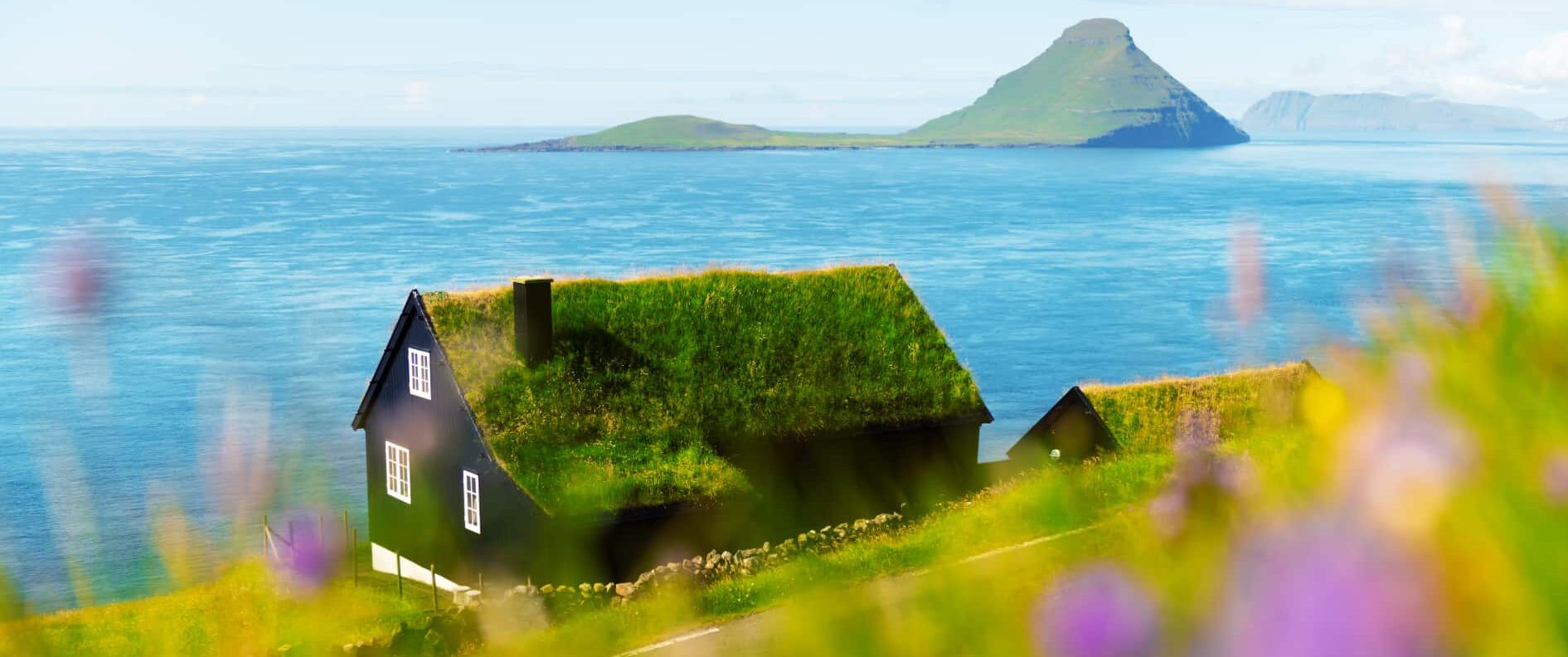
18 Things to Know for your First Trip to Faroe Islands

24 Hours Guide to the Faroe Islands

5 Amazing Things to Do in Faroe Islands in Winter

7 Things Faroe Islanders Love About Faroe Islands Tourism
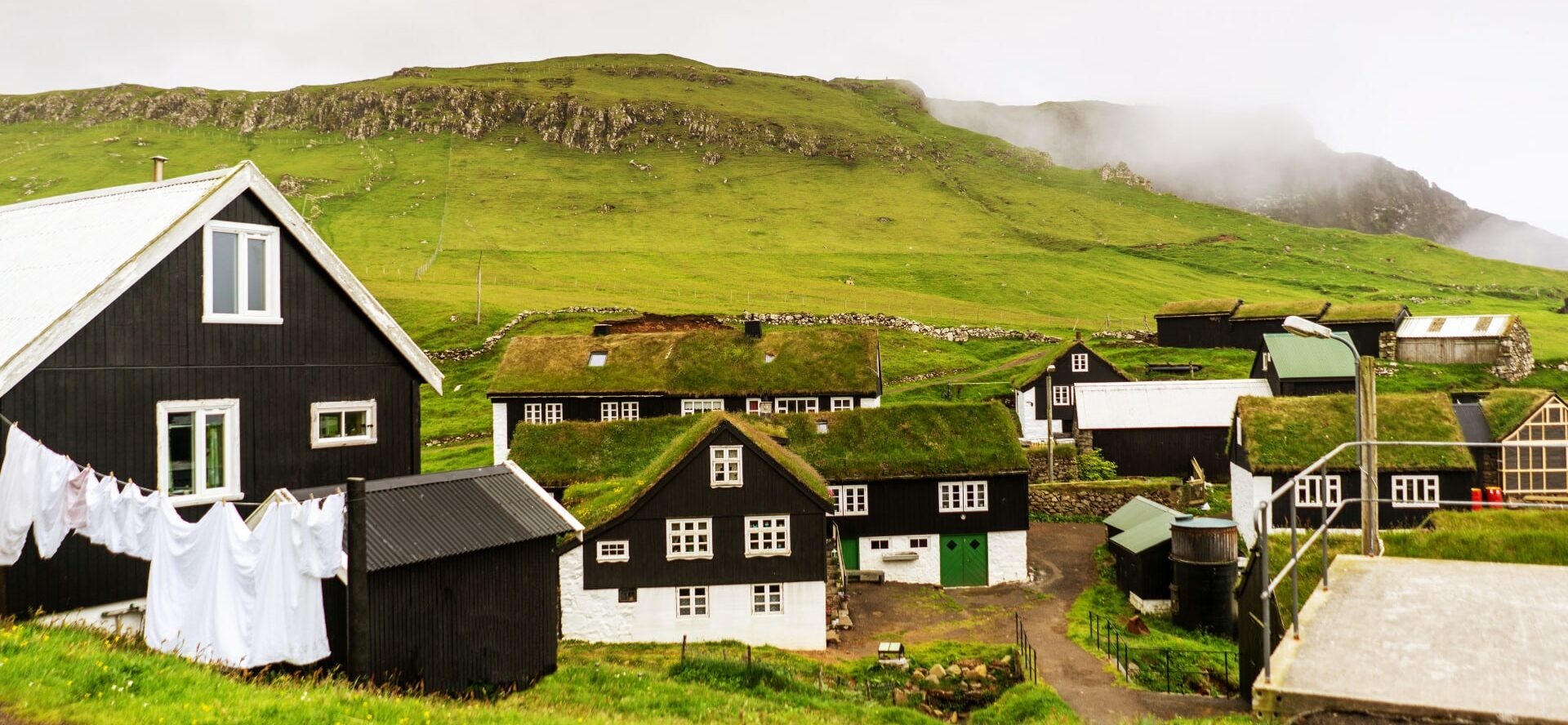
Are the Faroe Islands Expensive?

Complete Faroe Islands Tunnels Guide (+ Map & Essential Tips)

Complete Guide to Suðuroy Island
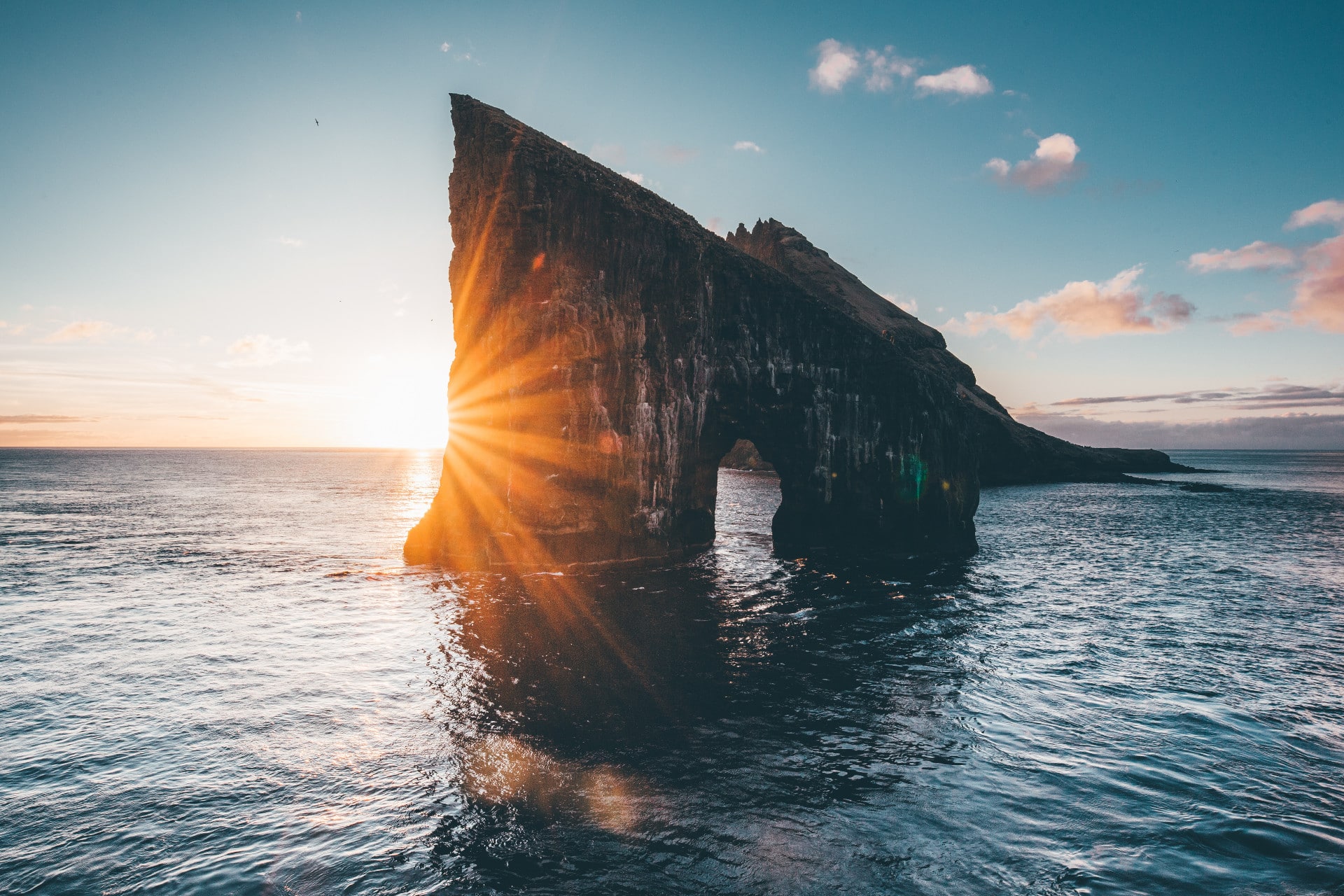
Covid-19 Guidelines for Travellers to the Faroe Islands in 2024

Faroe Island in May | The Ultimate Guide

Faroe Islands in April | Everything You Want to Know
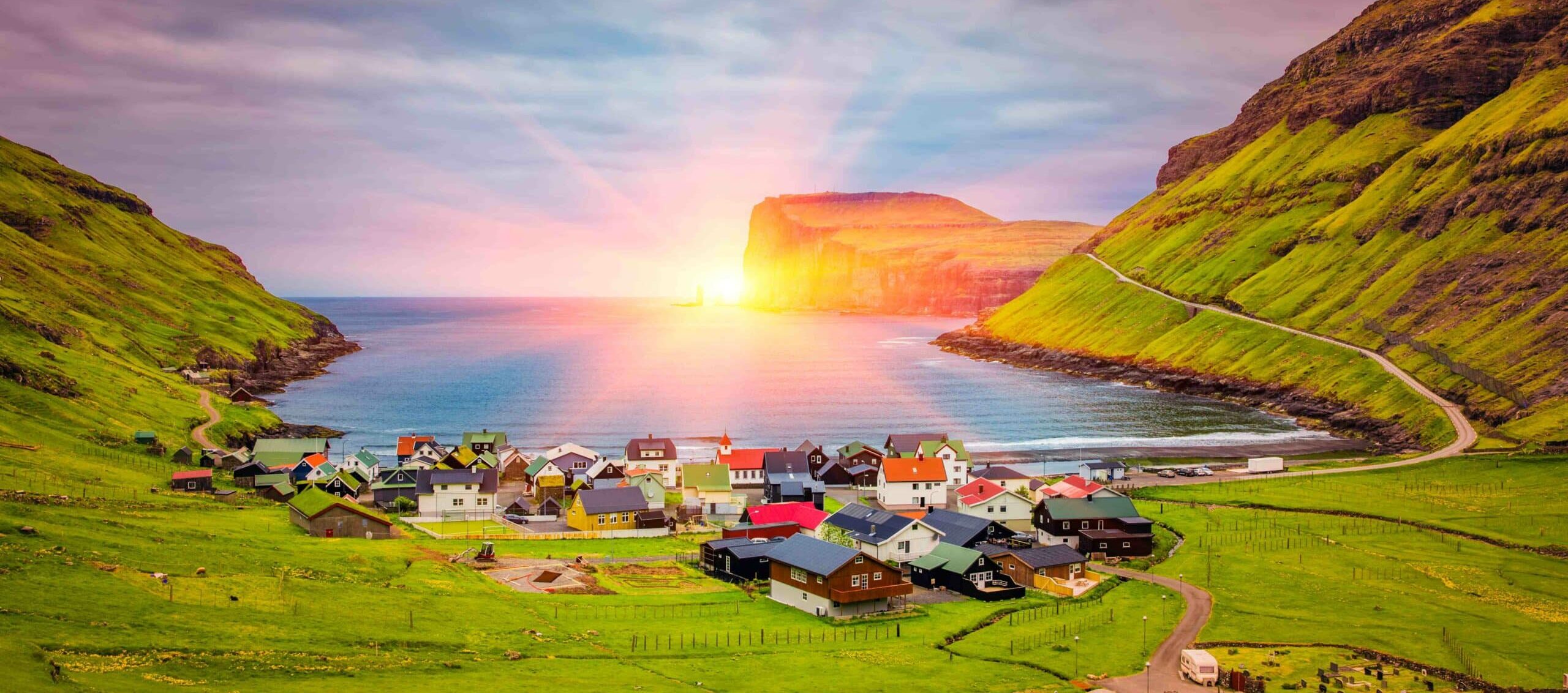
Faroe Islands in August | An Unbeatable Guide
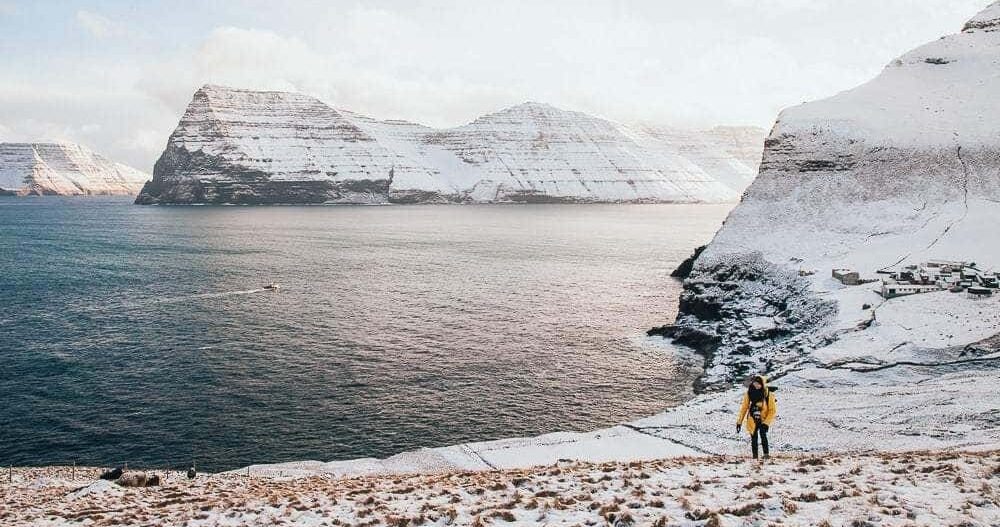
Faroe Islands in December | Nature, Events and Tours
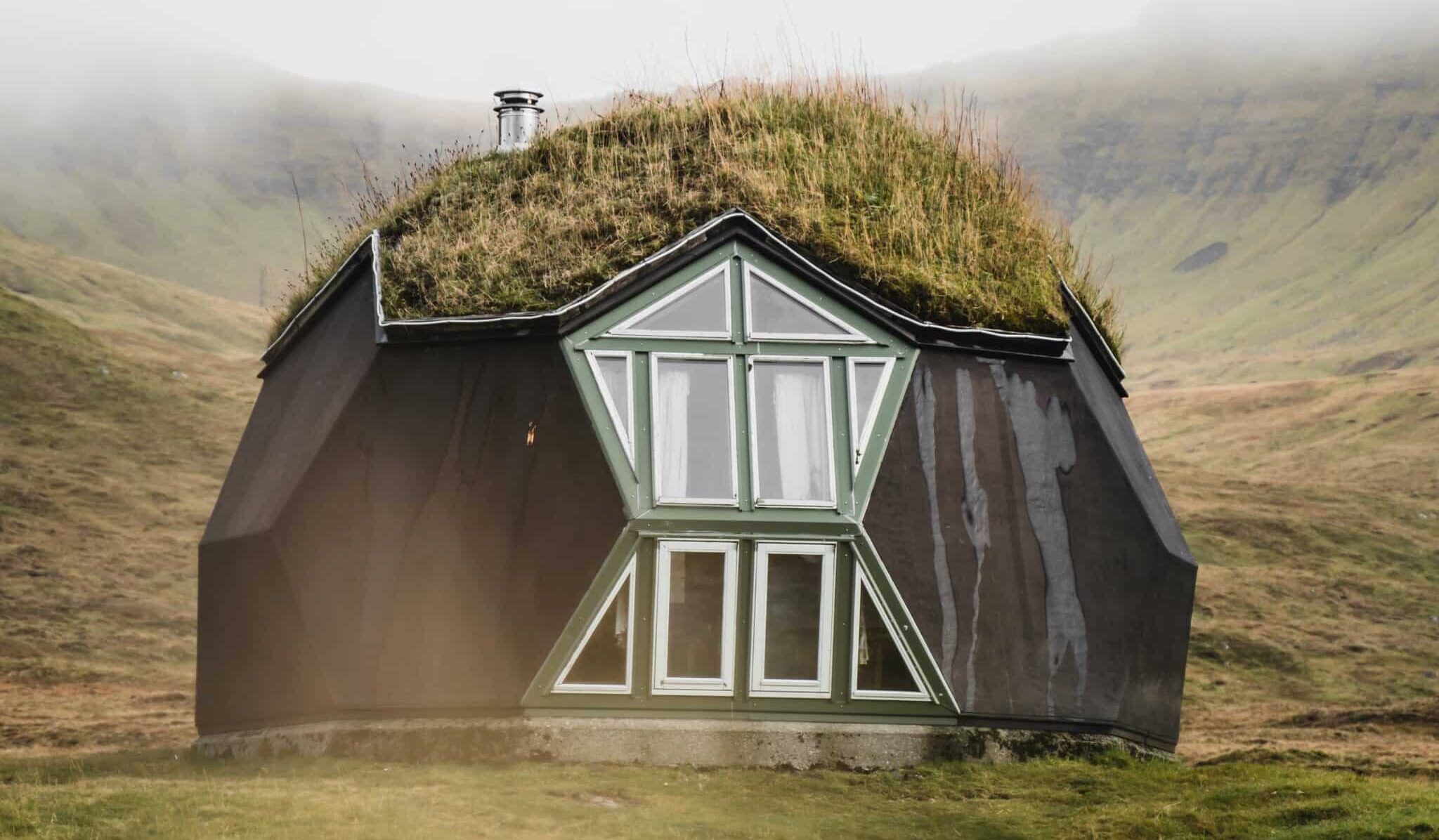
Faroe Islands in February | Everything You Need to Know
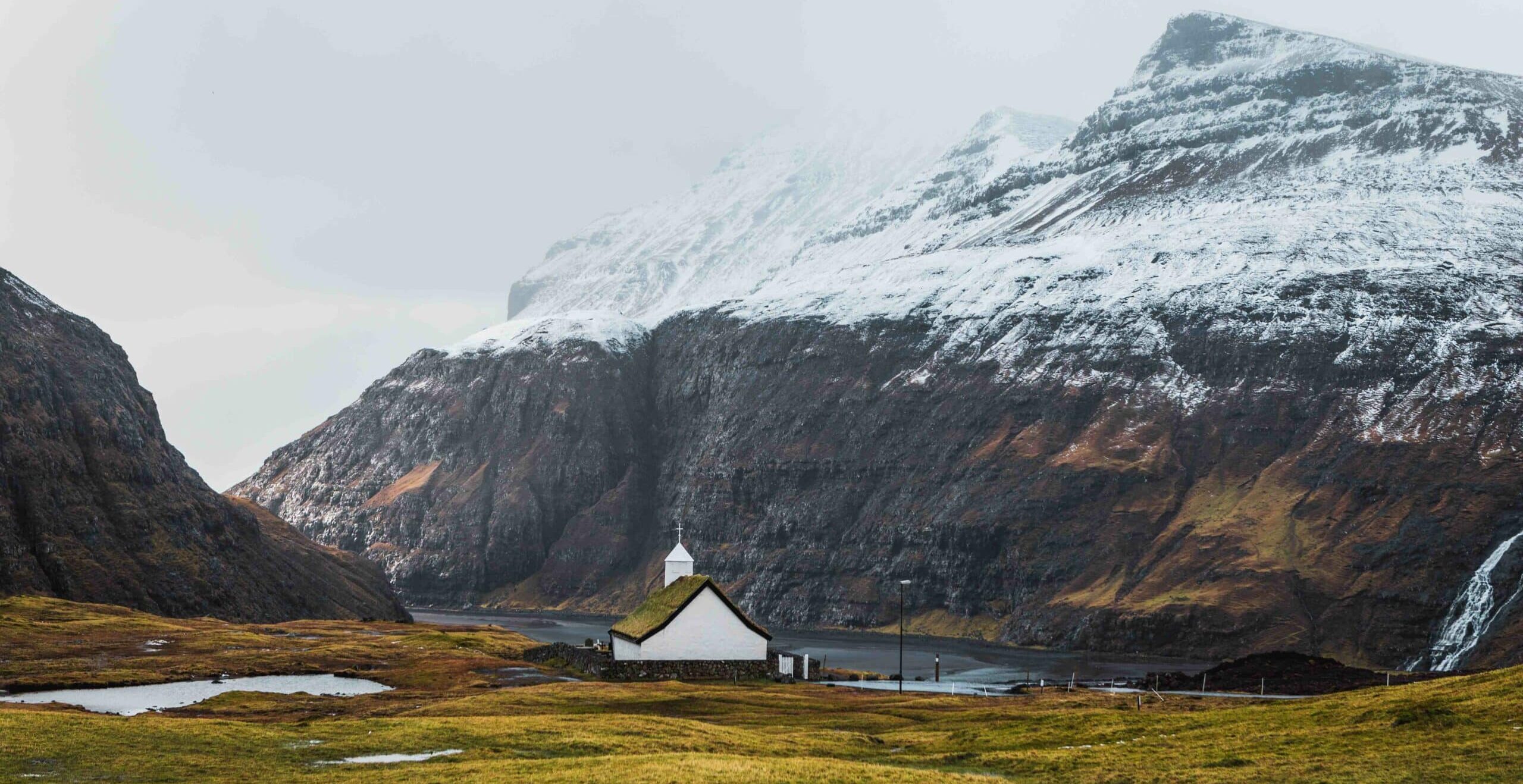
Faroe Islands in January | The Complete Guide

Faroe Islands in July | Everything You Need to Know
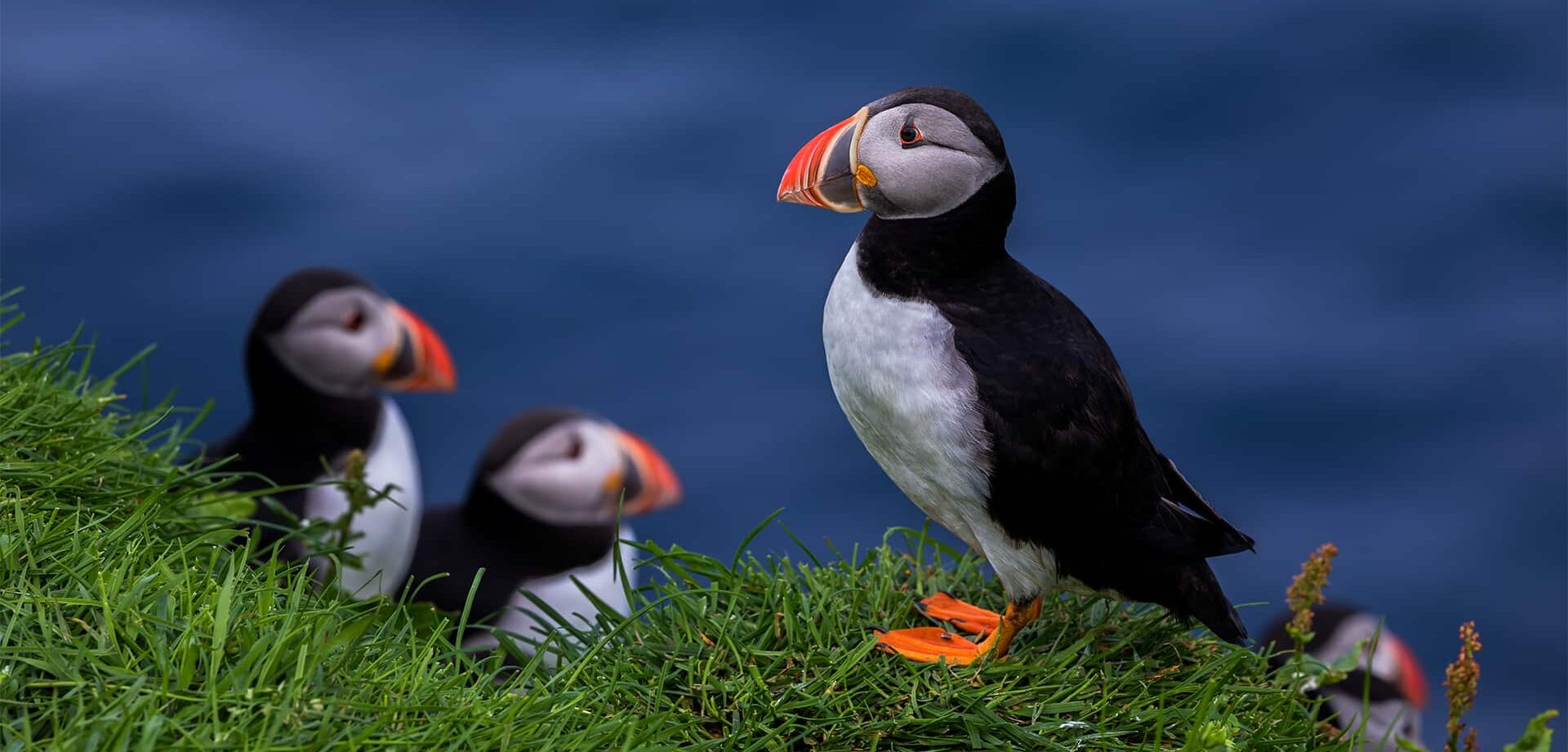
Faroe Islands in June | Things to do & see

Faroe Islands in March | The Ultimate Guide
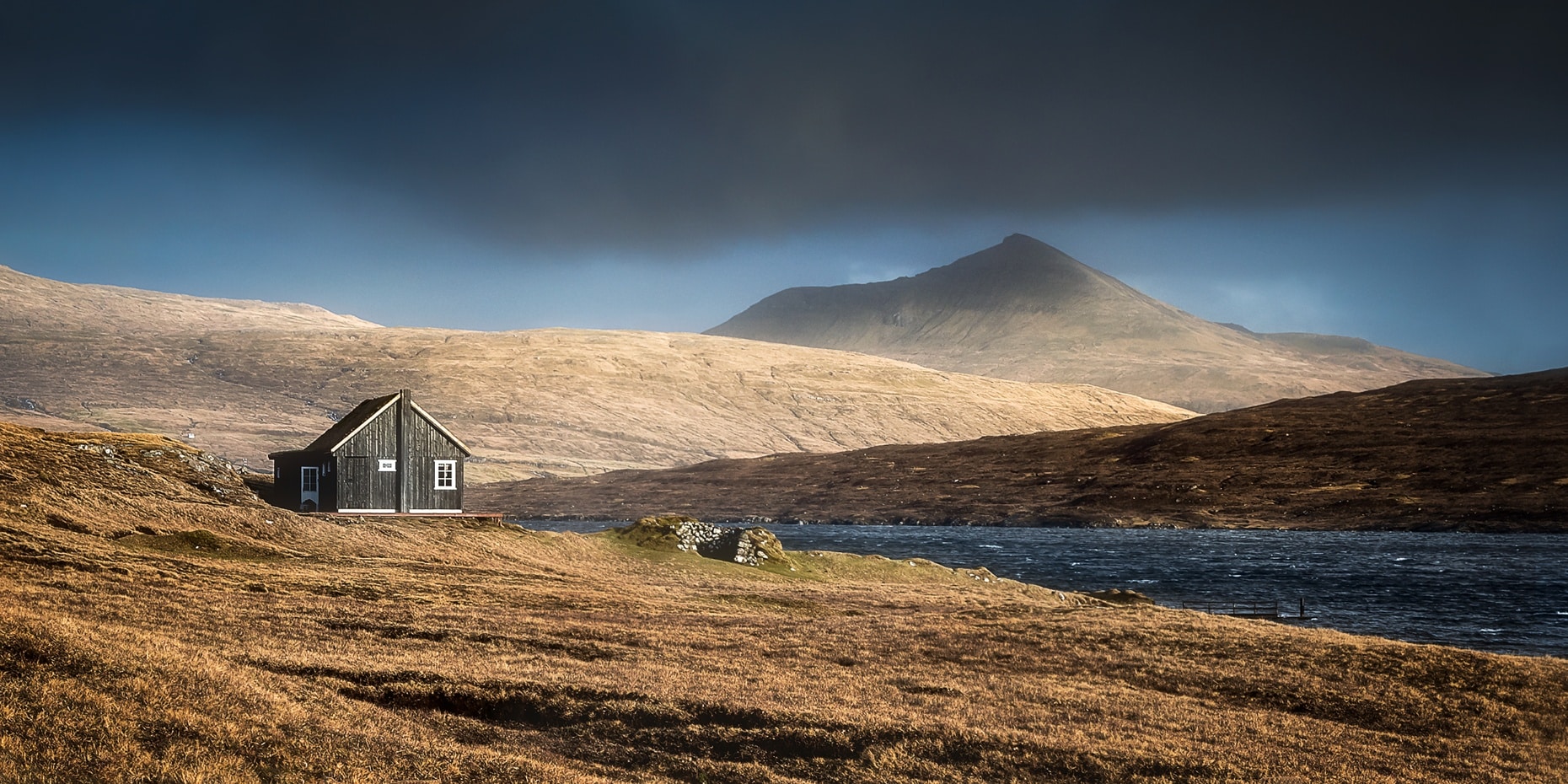
Faroe Islands in November | The Unbeatable Guide

Faroe Islands in October | What To See & Do

Faroe Islands in September | The Full Rundown

Flights to Faroe Islands

Guide to Faroe Islands Visa Requirements
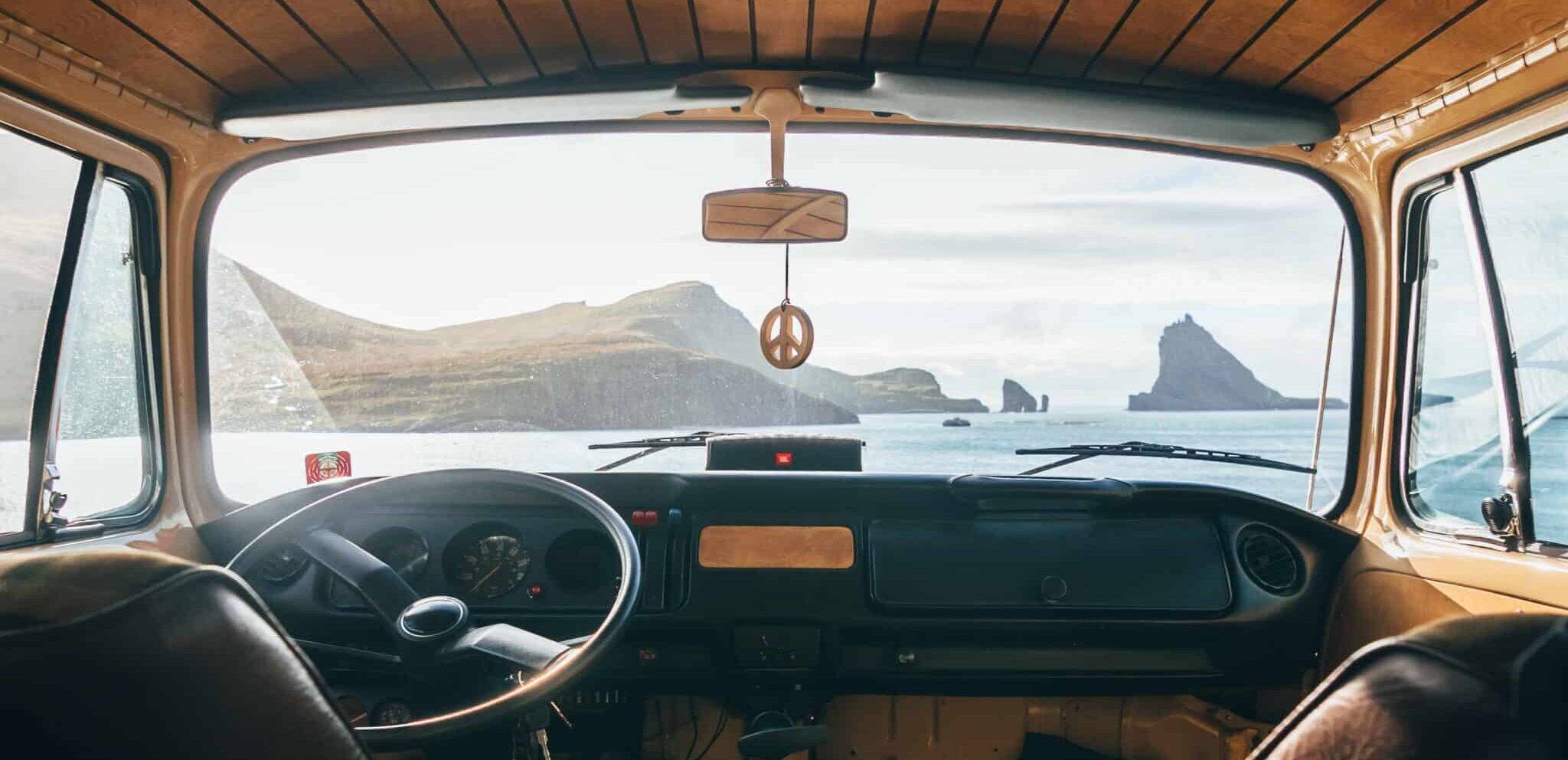
Guide to RV Camping in the Faroe Islands

Guide to the Currency Faroe Islands Use
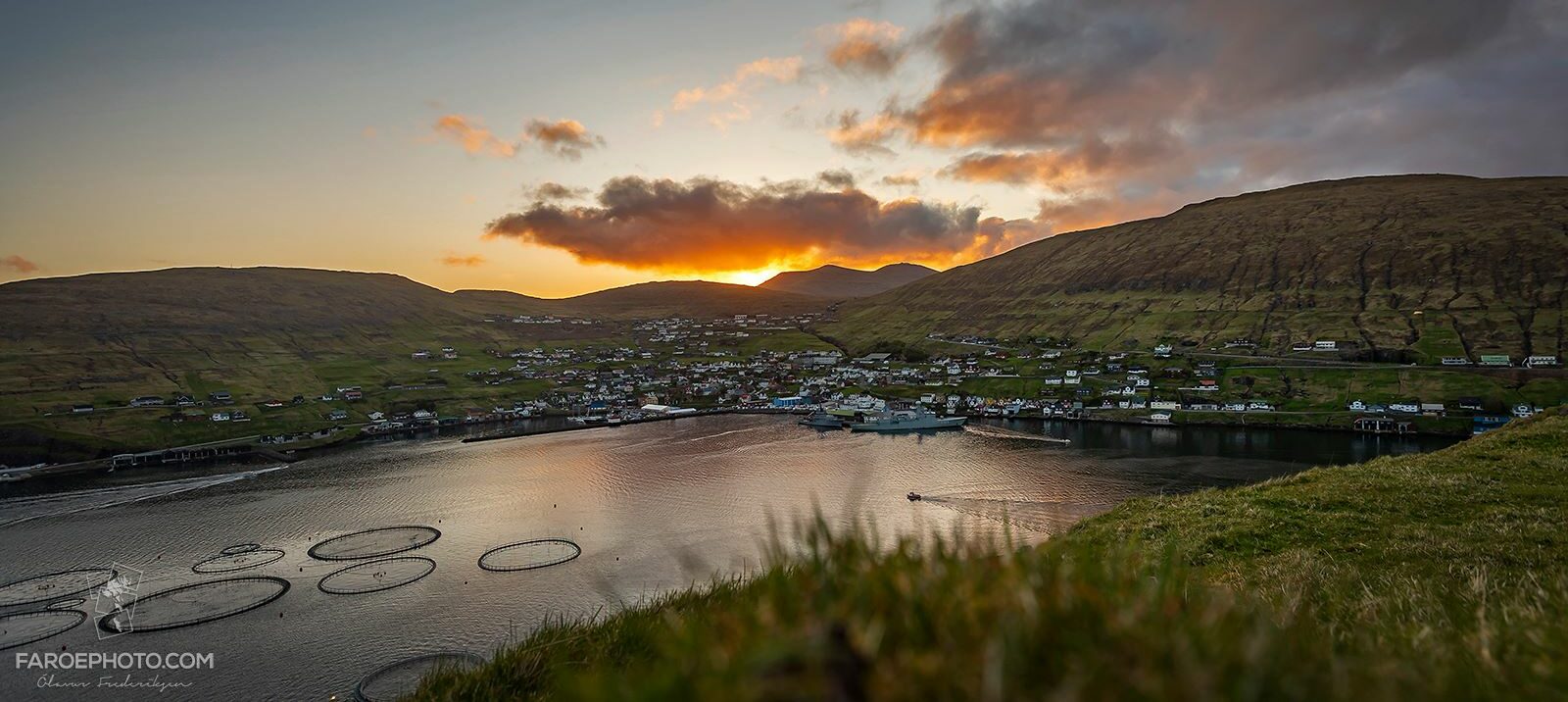
Guide to Vestmanna – Historical Treasure and Alluring Nature
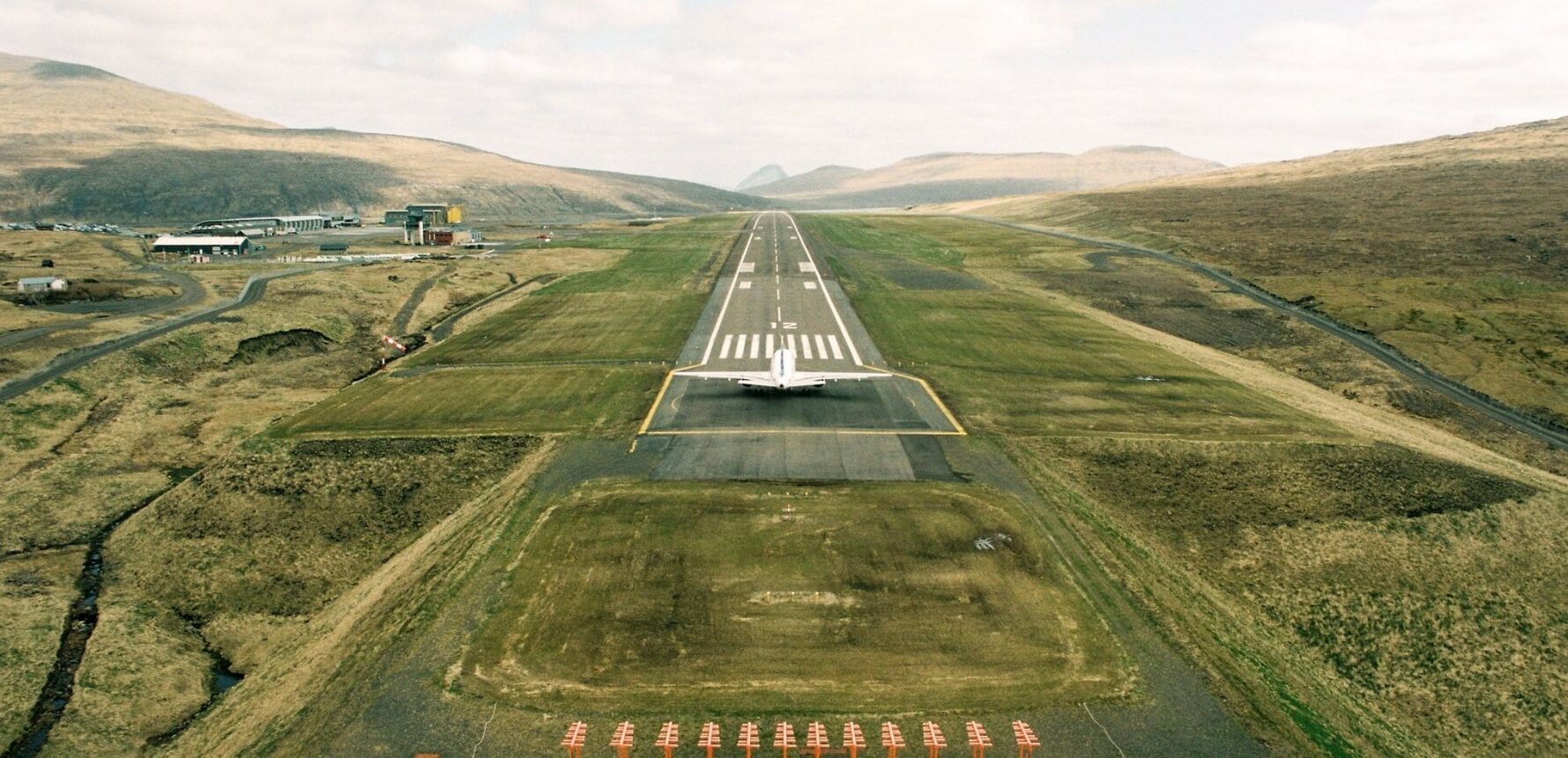
How to get from Vágar Airport to Tórshavn

How to get to Faroe Islands from North America
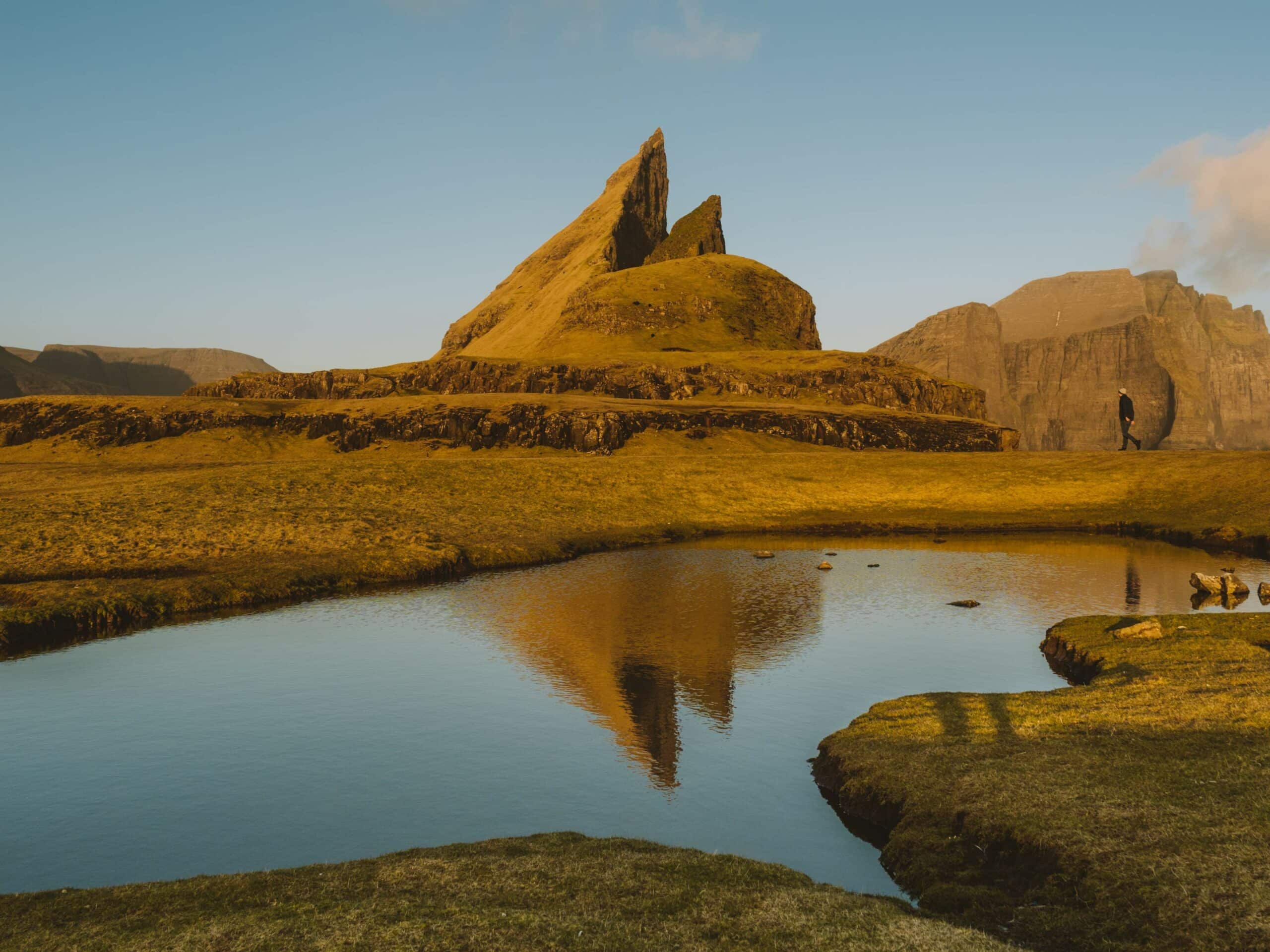
How to Travel Faroe Islands on a Budget
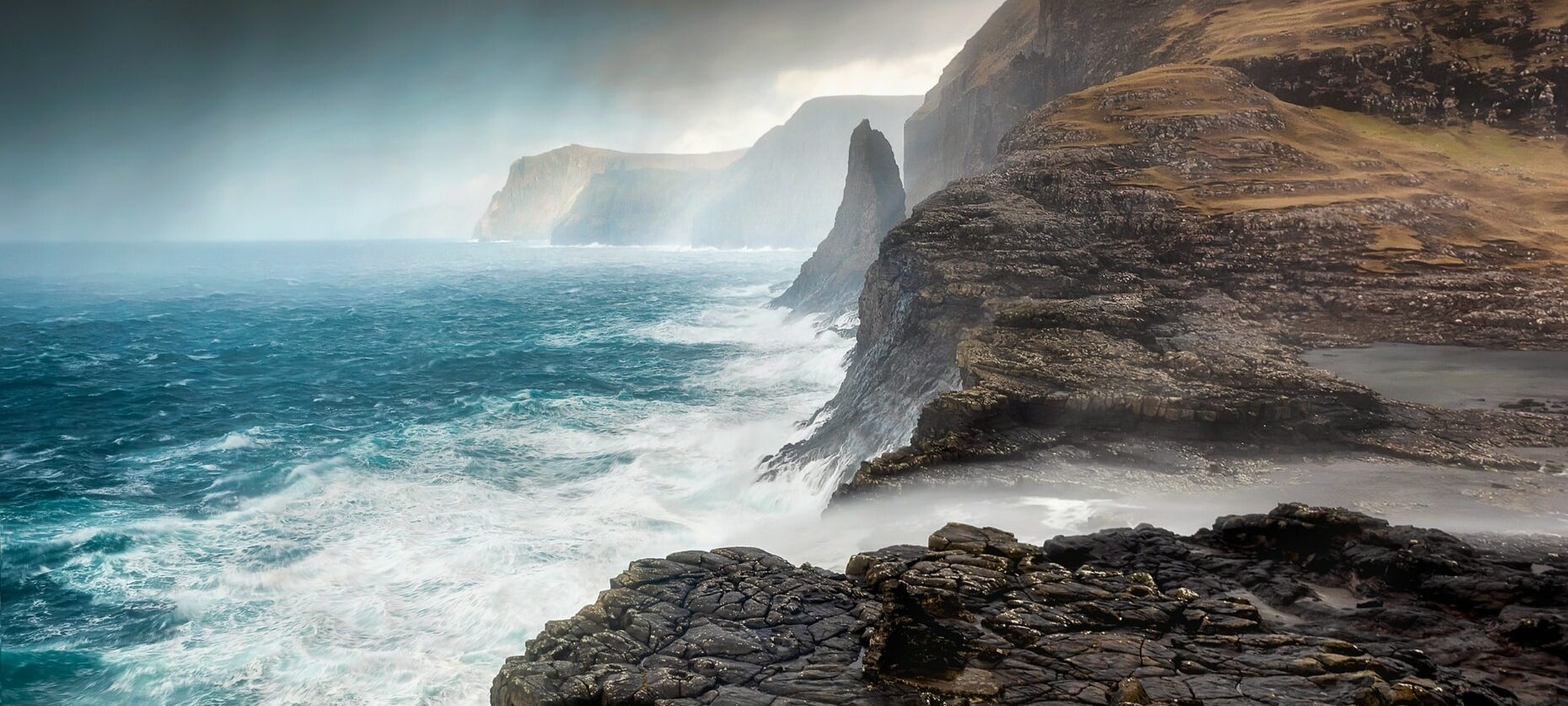
How To Travel in the Faroe Islands | The Top 5 Do’s and Don’ts

Is Faroe Islands Worth Visiting?

Luxury Travel in the Faroe Islands

Map of Faroe Islands

Public Holidays in the Faroe Islands in 2025

The 7 best hotels in the Faroe Islands

The Best Winter Itinerary for Faroe Islands

The Complete Guide to Travel Safety in Faroe Islands
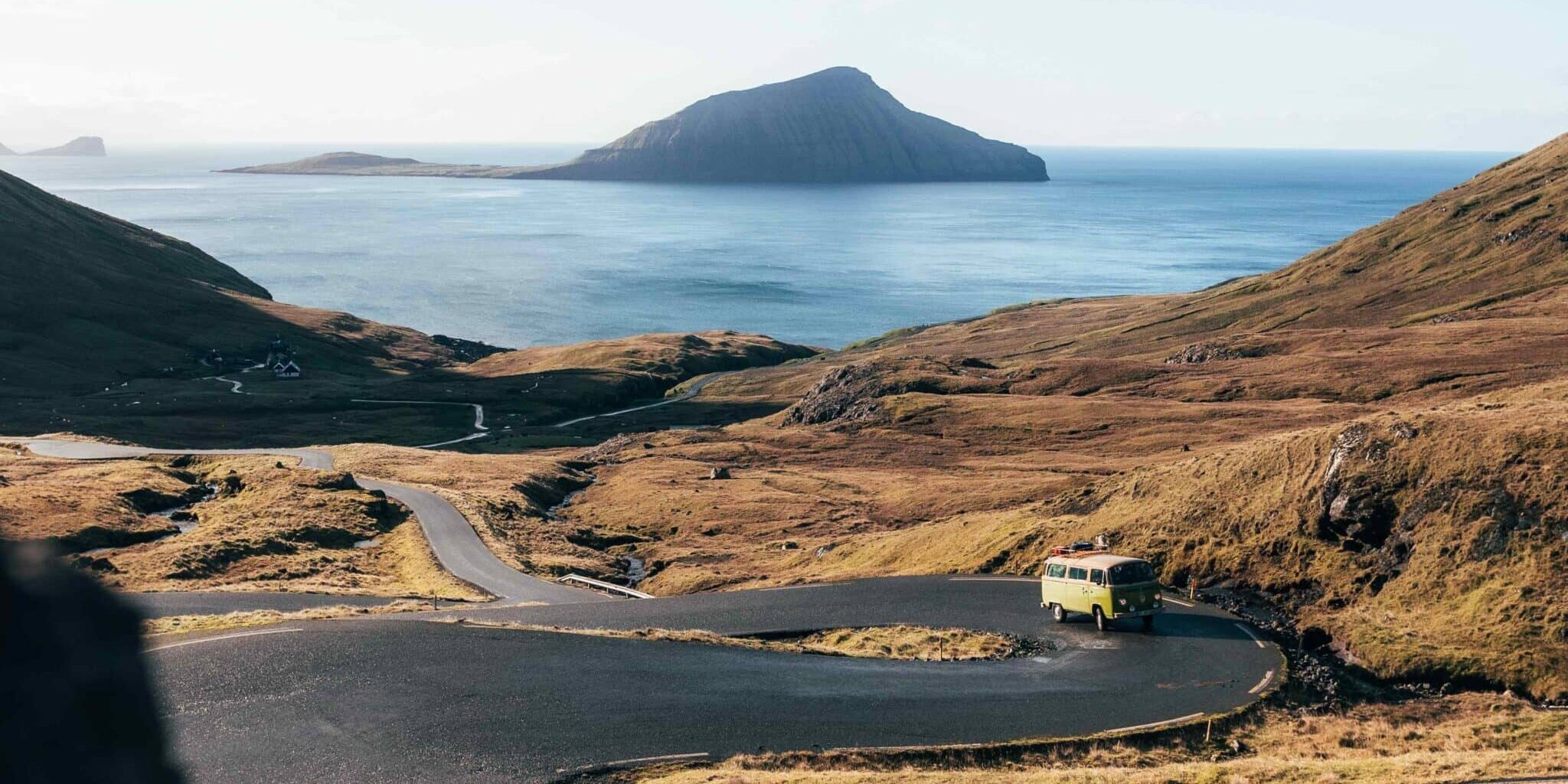
The Ultimate Guide to Driving in Faroe Islands
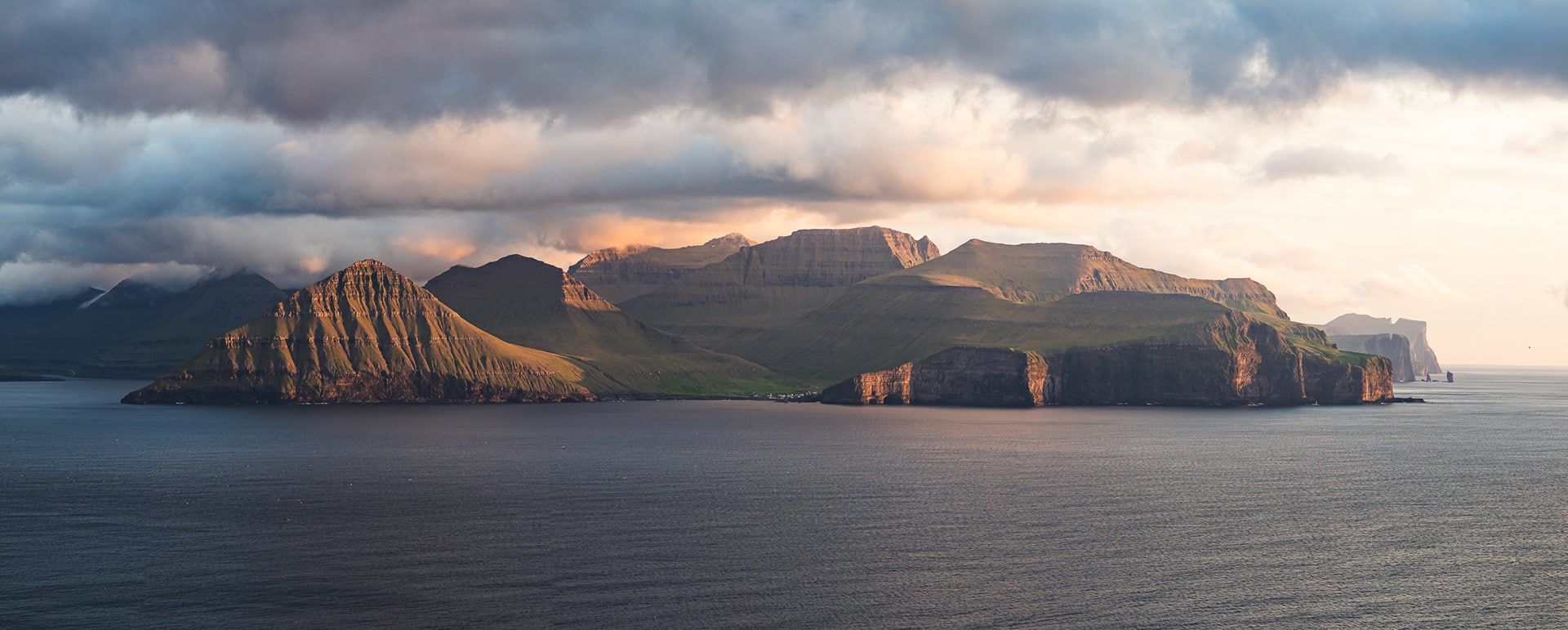
The Ultimate Guide to Eysturoy Island
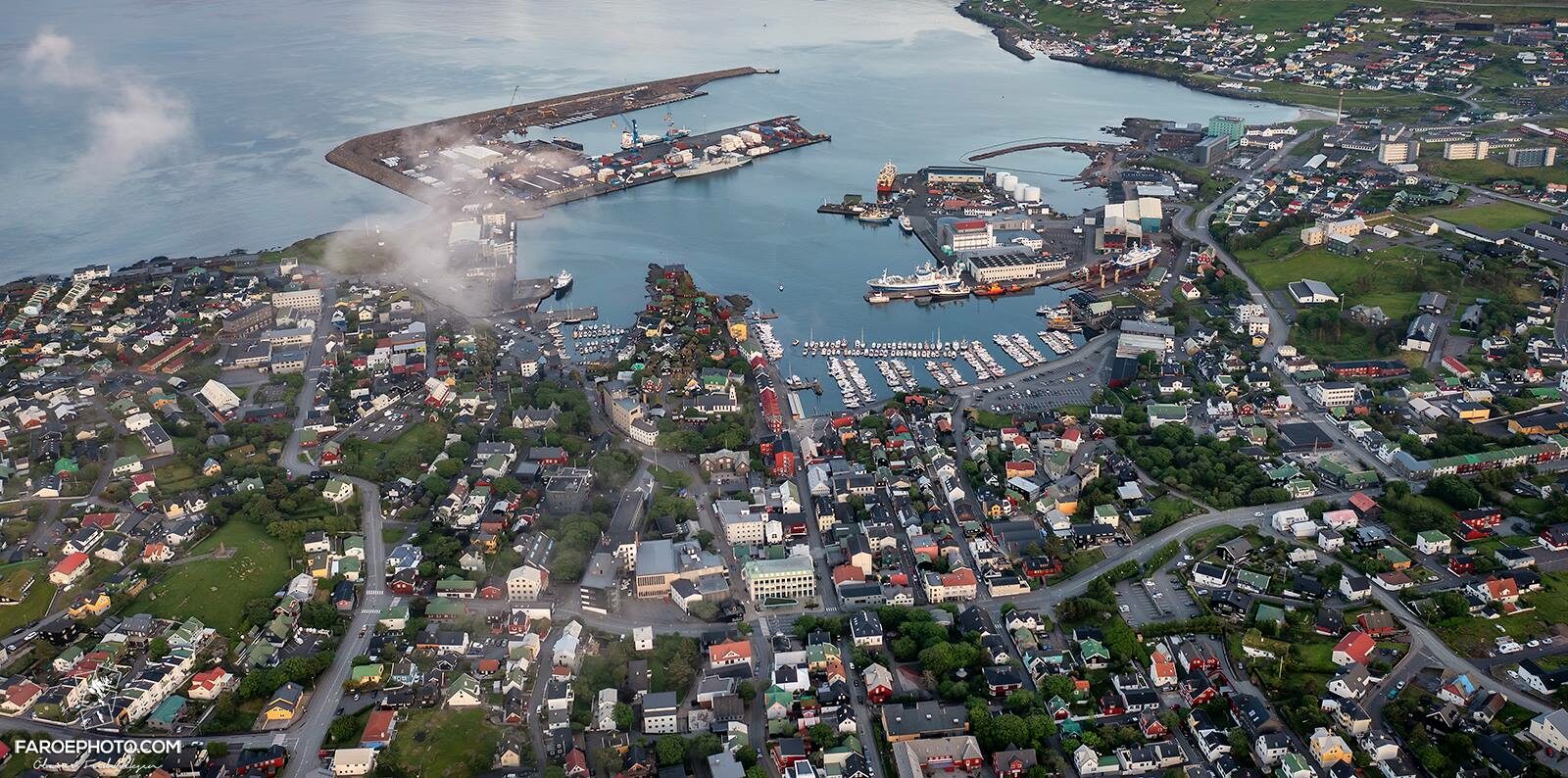
The Ultimate Guide to Tórshavn

The Ultimate Kalsoy Island Travel Guide

The unpredictable Faroe Islands weather

Unmissable Faroe Islands with Kids Guide
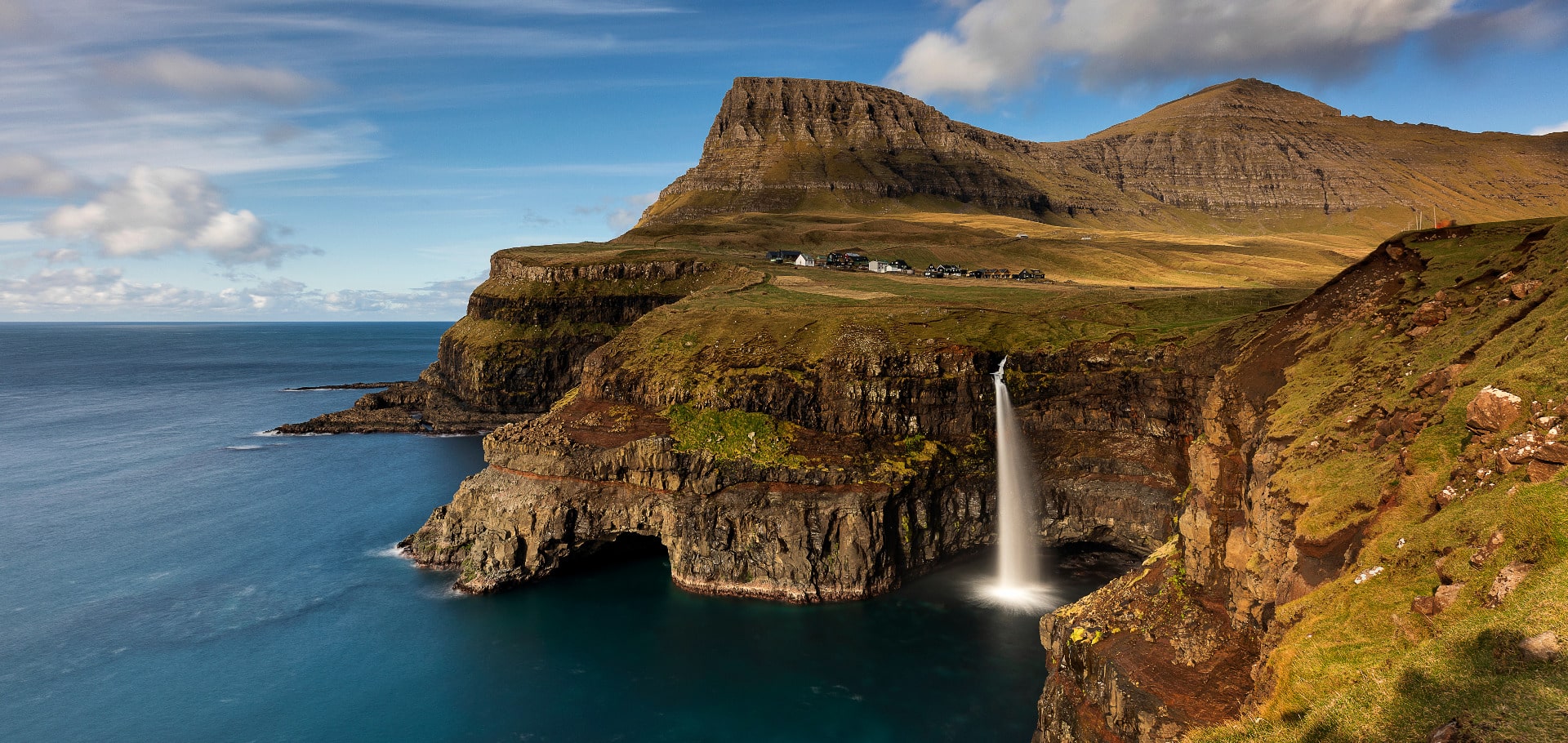
Vagar Island | The Ultimate Guide

What is the best time to visit Faroe Islands?
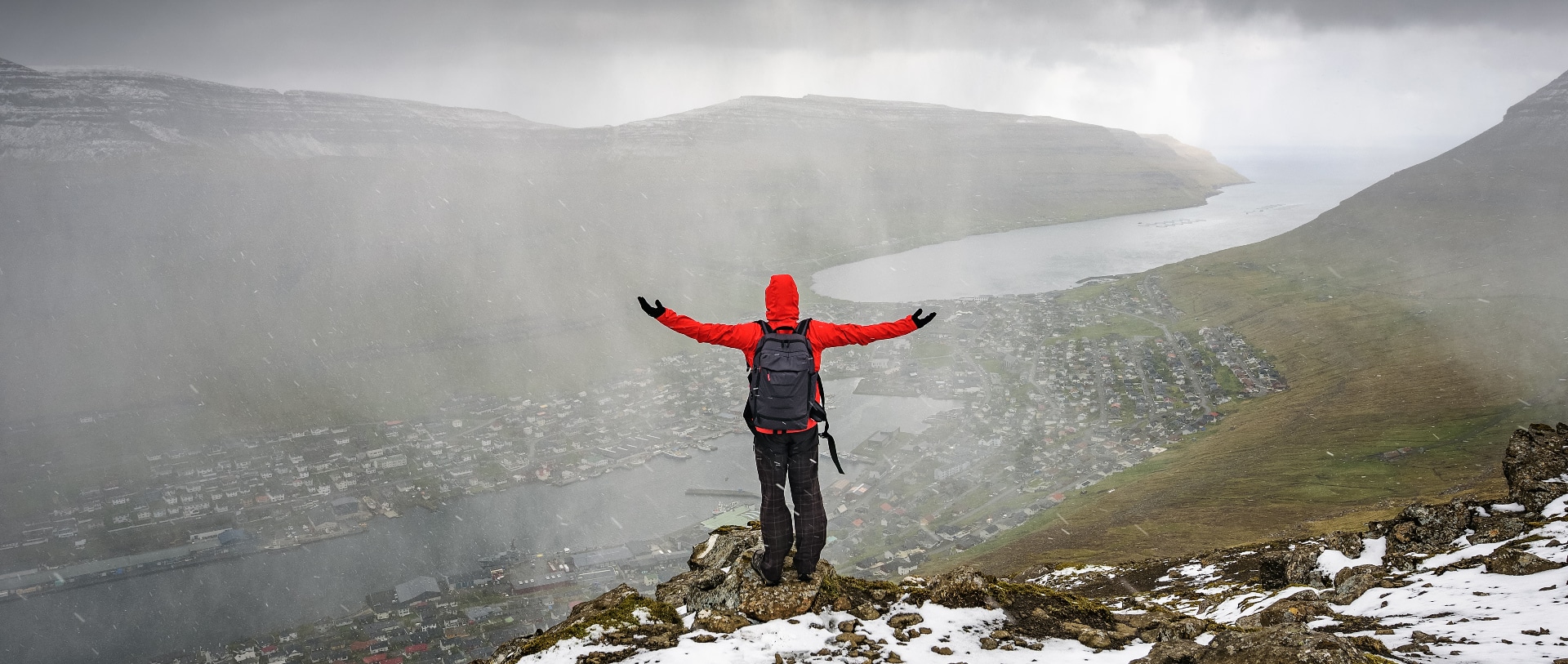
What to Pack for Travel in Faroe Islands
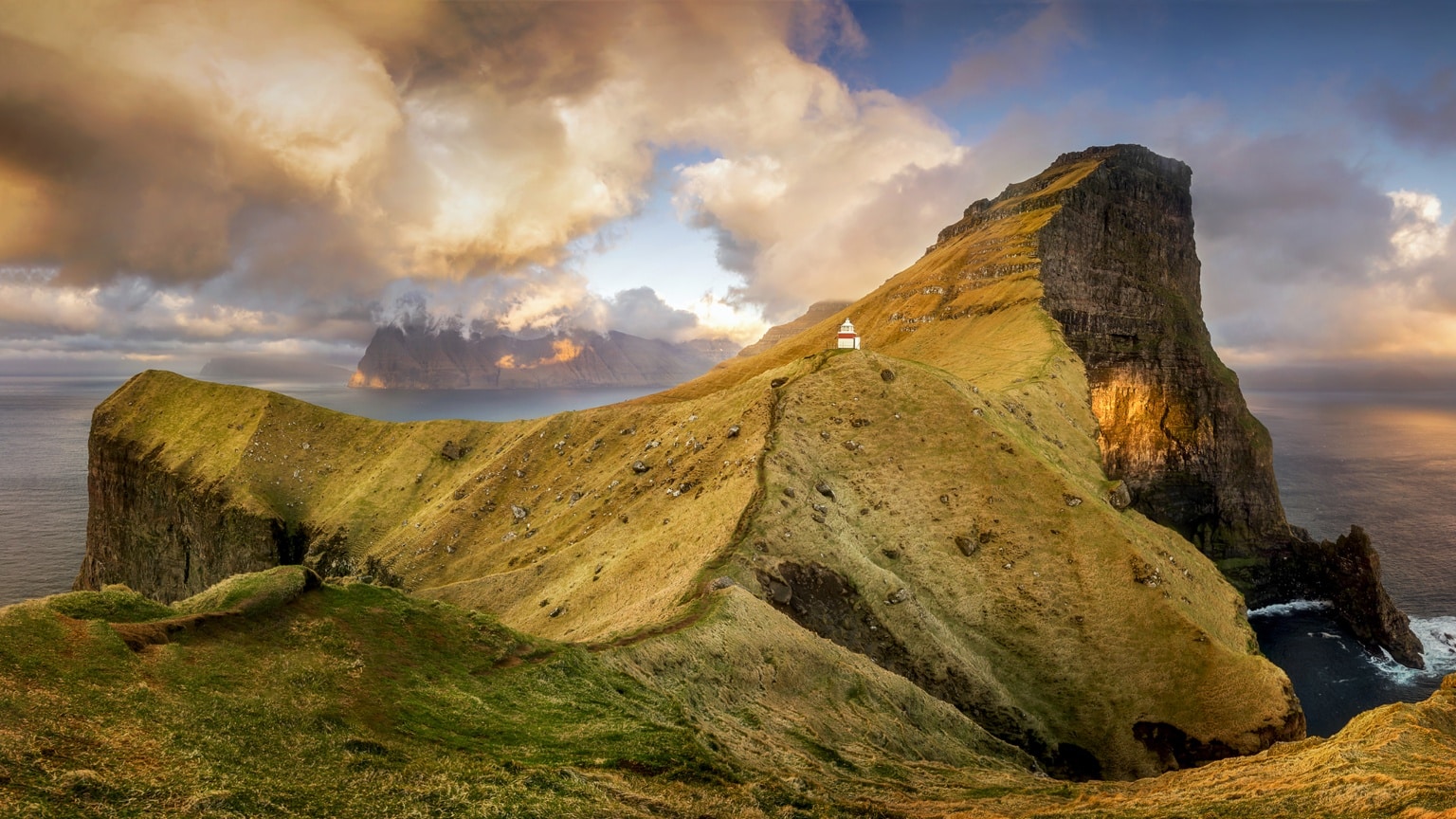
Where are the Faroe Islands?

Where to Stay in the Faroe Islands
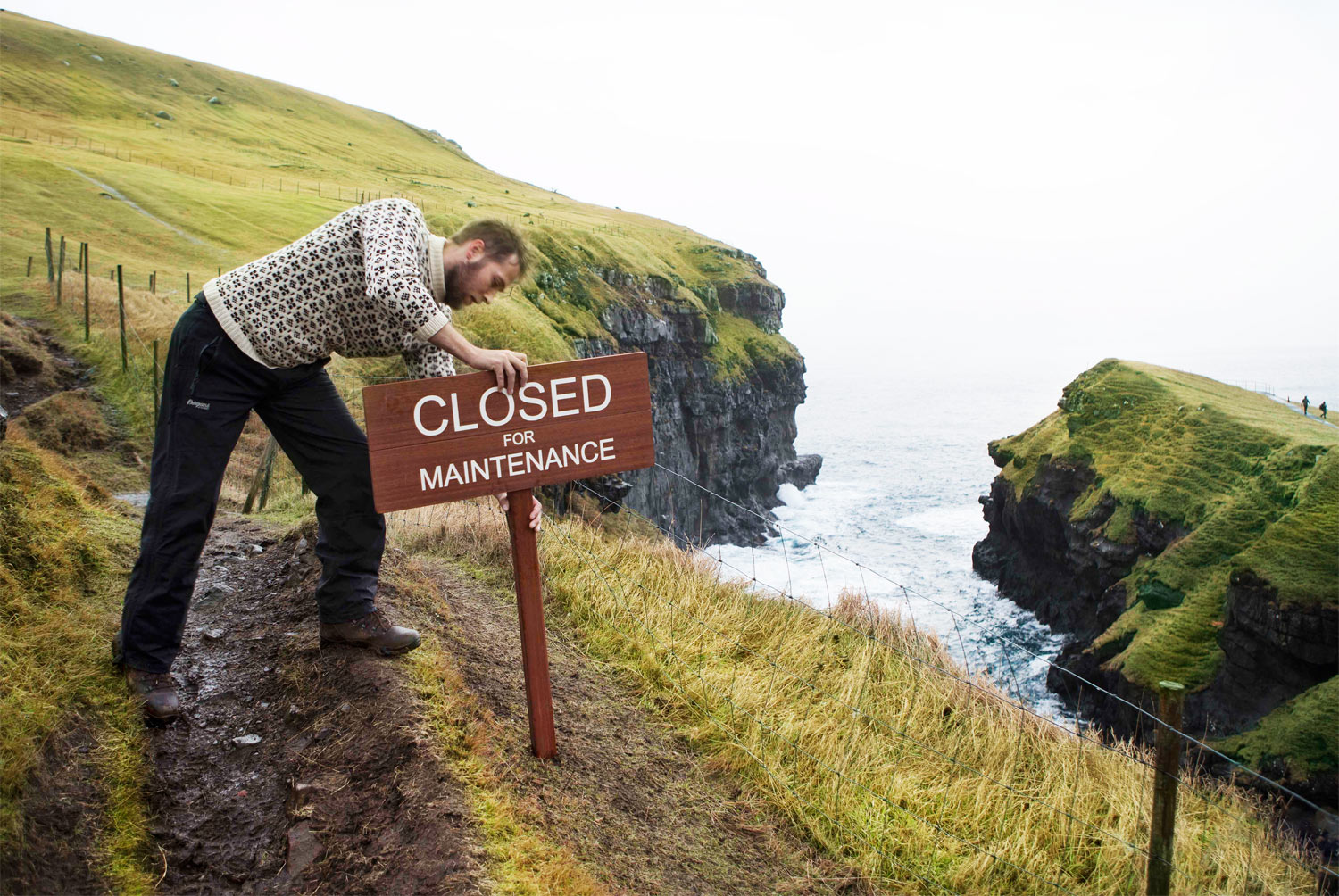
Why the Faroe Islands are Closed for Tourists for Two Days each Year

The best time to visit the Faroe Islands

Mar 4, 2024 • 5 min read

Read on for key puffin-watching months, seasonal treats and major annual events © Oleh_Slobodeniuk / Getty Images
The Faroe Islands offer superlative hiking, bird-watching and awe-filled experiences, with shard-like moss-covered mountains and roads snaking around fjords that will take your breath away. A trip to this relatively off-the-beaten-track archipelago takes you under the sea – via the world’s first subsea roundabout – over it, on a range of ferries and boat trips, and around it, seeking seabird-filled cliffs, wild beaches and idyllic hiking trails.
Plan the perfect time for your Faroe Islands trip with this guide to the country’s key events and what to expect from the seasons.
Key things to know about the seasons before you book
It's important to note that experiences on the Faroe Islands are highly seasonal and extremely weather dependent. It’s a cliché but it’s true: you could experience all four seasons in one day – or even within five minutes of each other – on these windswept islands at almost any time of year.
Many of its stellar experiences, from puffin spotting to Northern Lights watching, are not available year round. Some are only available on the days when the weather plays ball. Sometimes ferries are canceled due to high winds, or pelting rain puts an end to a long hike. It is highly likely that you’ll see snow in winter; it is not completely out of the question that you’ll also see it in May.
As a visitor, you’re in thrall to the whims of nature, and it’s all part of the experience.

June to August is the best time to visit for weather and activities
Nobody comes to the Faroe Islands expecting to catch a suntan. With temperatures typically hovering between 7 and 13℃ (44℉ and 55℉), you’ll still want to pack your merino wool undies for a summer trip.
Arriving on the islands in summer between June and August is going to give you the best options overall for whatever you want to do for a number of reasons. The first is that it’s peak season, so all the attractions and routes are open – expect reduced schedules out of season.
Secondly, it’s peak season for migratory birds too. If you want to spot puffins, you’ll need to arrive between April and September. Take note: the daily boats to Mykines, the puffins’ favorite island, are often booked up in advance – so book ahead.
It’s also the peak season for hiking. The northerly location means that there’s a lot of variation in daylight across the seasons, and in the height of summer around the solstice, the Faroes experiences around 20 hours of sun. It’s great for long hikes and making the most of your time on the islands. Traditional whale hunts can take place year-round on the Faroe Islands, but are most common in the summer.
Summer is also the best time for festivals and events. In July, the legendary G Festival takes place, drawing international musicians and music fans to the little town of Gøta. It’s also the month of Ólavsøka Festival, a two-day celebration of the Faroese National Day starting on 28 July. Summer is a time for concerts, food festivals, regattas and Gay Pride too.
With all these events and activities going on, it’s also the priciest season to visit. It’s important that you book everything from tours to accommodation, ferries and car hire ahead.

September to December and March to June are the best times for travelers on a budget
Come September, and some attractions and transport options switch to an off-peak, less regular service. The weather in September can be very like August, giving you the chance to enjoy the islands and their nature without so many other visitors – and at lower prices.
While the Faroe Islands are rarely crowded, they are emptier at this time of year, and accommodation options are more widely available. For the best prices and the best conditions, late spring and early autumn are a good bet.
The light starts to change through autumn; towards the end of the season, the days feel shorter and darker and it might be possible to see the Northern Lights on a clear night. The same can be said for spring: mornings get lighter but nights could still be dark enough for a light show. Towards the end of spring, when the wildflowers start to show their faces and the migratory birds return, the islands have a particular kind of fresh excitement to them.
Note that September is the traditional month for the Faroese sheep slaughter, a traditional time of sheep gathering, shearing and slaughtering, and for one weekend in spring (typically late April or early May) the islands are “ Closed for Maintenance ”.

December to March is the best time for the Northern Lights
To see the Northern Lights, you need luck on your side, a dark night and a cloudless sky. At least one of those things is on offer to you in winter on the Faroe Islands; winters are dark, and on the winter solstice in December, there’s only five hours of daylight to interrupt your aurora chasing. As for the clouds, you never know, they may well blow away. The best advice is to get outside – Tórshavn to an area with no light pollution – and look to the north.
Winter is a season for hardy, intrepid travelers. Temperatures hover around 1 to 6℃ (33℉ to 42℉) and with limited daylight, hiking is only really advisable on short trails and/or with a guide.
Travelers should check Landsverk.fo regularly for updates to road conditions; snow is likely and roads can be closed. Many attractions and transport options will be closed, but those that are open are warm and charming, including small concerts and cultural attractions.
For the most dramatic take on the Faroe Islands, winter doesn’t hold back: we’re talking frozen harbors, wild seas, ice swimming, sledging down vertiginous slopes, and visits to Tjornuvík, a village that experiences a full 24 hours of darkness every year. Pack your warmest clothes and call yourself an adventurer: the Faroe Islands in winter has plenty to offer if you have an appetite for extremes.
Explore related stories

Budget Travel
Mar 7, 2024 • 6 min read
Heading to the Faroe Islands? Here are some handy tips to help make your money go further.
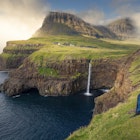
Mar 1, 2024 • 6 min read

Oct 28, 2021 • 2 min read

Dec 9, 2020 • 2 min read

Mar 5, 2020 • 2 min read

Sep 6, 2024 • 7 min read
- Meet the Team
- Our Manifesto
- Work with Us
- Budget Travel
- Personal Development
- Work & Travel
- United Kingdom
- More of Europe
- Philippines
- More of Southeast Asia
- More of South America
- More of Central America
- South Korea
- More of Asia
- More of North America
- New Zealand
- Pacific Islands
- More of Oceania
- South Africa
- More of Africa
- More of the Middle East
- Travel Essentials
- Travel Gear
Home » Europe » Denmark » Faroe Islands
Where to Stay in Faroe Islands (2024 • COOLEST Areas!)
Ancient, cultural and fascinating; the Faroe Islands, although a remote outcrop of Europe are actually part of Denmark. Sparsely populated but still bursting with life and interesting things to do, these islands make the perfect location for a unique getaway.
The Faroe Islands are located between Iceland and Norway and are made up of 18 rocky, volcanic islands. The islands are popular with hikers and bird-watches who are lured in by the island’s unspoiled landscapes and thousands of seabirds.
Home to mountains, valleys, terrifyingly beautiful steep coastal cliffs and endless stretches of grassy land – there is much to explore!
Surrounded by the open seas of the Atlantic Ocean, there are some breathtaking discoveries to make here. But with so much on offer, it can be quite overwhelming trying to decide where to stay in the Faroe Islands.
Are you after a remote cabin, miles away from the next human? Or, maybe you want to base yourself in one of the island’s quaint towns? No matter what travel budget or style you’re working with, I’ve got you covered.
I’ve compiled the best areas to stay in the Faroe Islands and I’ve even included the best places to stay and things to do in each. After reading this guide, you’ll be the expert on the Faroe Islands and ready to book your stay!
Without further ado, let’s find out where in the Faroe Islands is best suited for you.
Where to Stay in Faroe Islands
Faroe islands neighborhood guide – places to stay in faroe islands, 5 best neighborhoods to stay in faroe islands, faq about finding a place to stay in faroe islands, what to pack for faroe islands, don’t forget travel insurance for faroe islands, final thoughts on where to stay in faroe islands.
- Buy Us a Coffee!
Backpacking the Faroe Islands and looking for a specific stay? No need to stress, we’ve listed out best recommendations below. Keep in mind that there are more sheep than humans living on the islands, so if you’re looking for hostels or luxury resorts, you’ll end up very disappointed.
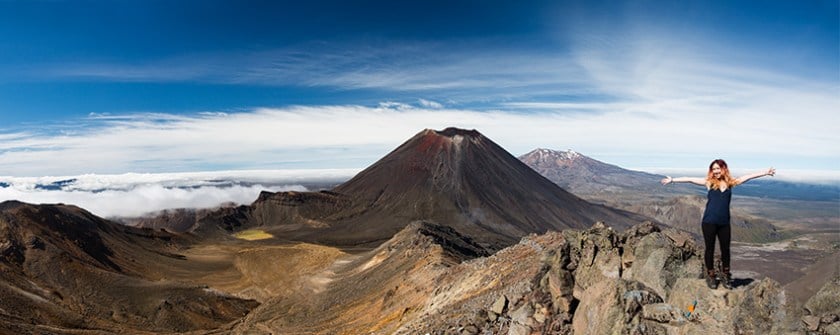
The Broke Backpacker is supported by you . Clicking through our links may earn us a small affiliate commission, and that's what allows us to keep producing free content 🙂 Learn more .
Apartment at the seaside with a wonderful view | Best Airbnb in Faroe Islands
This cosy little apartment overlooks Torshavn – the best place to stay in the Faroe Islands for your first time! It is sweet, warm and comfortable and just a 20-minute walk to the town centre, where you can find all the local amenities you can want!
There’s a beautiful sea view in the main living room and the location is unique – what more could you want for a short getaway?
Unique Cozy Cottage | Best Luxury Airbnb in Faroe Islands
For a truly authentic and rustic stay on the Faroe Islands, look no further than this traditional log-cabin-style home! It’s in a secluded location, but it is just a 25-minute walk to the centre of Torshavn and there are free buses which will drive you there!
Be careful- there’s no formal address for this cottage, so it’ll be an adventure when you arrive, but once you do – you won’t want to leave!
Visithomes A Miðgerði | Best Hotel in Faroe Islands
This hotel is the perfect place to stay on the Faroe Islands for luxury and bliss. Simple and comfortable, this hotel is connected to a shopping centre and a roundtrip airport shuttle to make sure you have the most stress-free stay possible.
There’s a lovely communal area for you to meet fellow travellers and there’s ample parking if you’re hiring a car for your travels!
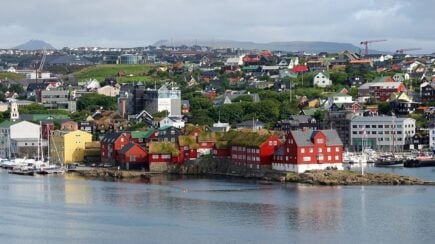
On the South end of one of the main areas of the Faroe Islands is this delightful port town. It’s the hub of the islands and the best place to stay if you want to experience this in all its beauty with everything at your door!
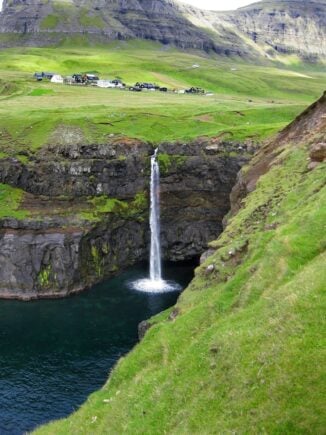
Vagar is one of the western islands which makes up the Faroe Islands. It is one of the most sparsely populated and civilised, however, it is the perfect place to visit to really be at one with the fantastic nature and wildlife available here.
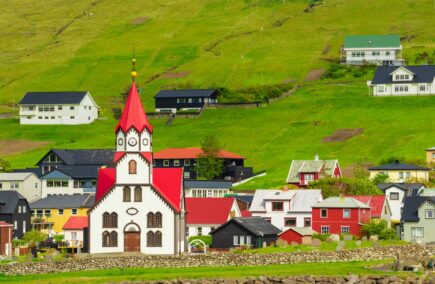
This is a delightful little town on the island of Esturoy, where you’ll find some of the best nightlife in the Faroe Islands! For anybody who wants to be able to explore during the day but also have a quality night out – this is the best place to stay in the Faroe Islands!
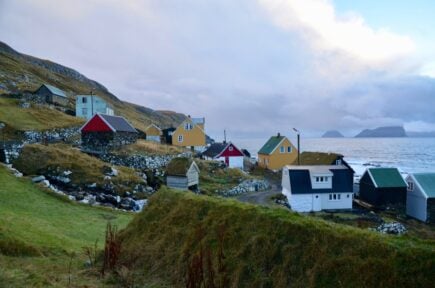
We think Sandoy is the coolest place to stay – there’s the perfect mixture of the rural without missing out on finding some gems! If you’re into history and culture, you simply have to stay on this island!
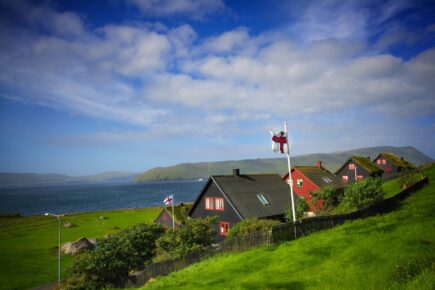
Planning a family holiday? Then the best place to stay in the Faroe Islands is definitely Kirkjubøur. It’s a small town on the southern end of the main island of Streymoy with a huge variety of indoor and outdoor activities for all the family to enjoy.
With so much history and beautiful surroundings, the Faroe Islands is one of the best places to visit in the Atlantic!
Want to save money on accommodation?

We got you. For reals.
The Faroe Islands are renowned for their history and culture, not to mention the breath-taking views that you simply cannot escape from! They are located 200 miles northwest of Scotland, so you’ll really be on top of the world during your stay here.
With rugged terrain, huge mountains and craggy outcrops, this archipelago is a fascinating place to visit if you want a holiday with a bit of a difference!
Cascading waterfalls, quaint little villages and loads of hiking routes are what make up these islands, and if you want to get a real feel for the islands, the best place to stay on your first time is Torshavn. If you’re a fan of history, the neighborhoods of Sandoy and Kirkjubøur Syðrugøta are amazing places to visit, where you’ll really step back in time to the world of Vikings and ancient wars!
Having been under the occupation of Vikings, Norway and now Denmark, these islands are overflowing with varying cultures which are ready for you to explore. Local cuisine is mostly fish dishes, which you can enjoy at a variety or gorgeous little restaurants scattered around the islands’ small towns and quaint villages.
Although owned by Denmark, these islands have their own autonomy, controlling most of their domestic affairs themselves. This has led to a close and tight-knit community feel, no matter which island you find yourself on.
If you’re looking for a sunshine-glossed beach holiday, then this probably isn’t the place for you! This archipelago is super exposed in the heart of the North Atlantic, so the weather can get pretty wild out here, but that’s what makes it so special here.
Because of the jet stream, the temperatures are relatively warm for this area, so you won’t be totally freezing!
Getting around these islands isn’t as hard as you might think. The main islands are connected by road bridges and tunnels, but there are also public bus and ferry services – travelling by boat here is pretty normal!
Vagar Airport is the islands’ only airport, but it is regularly served by Atlantic Airlines.
1. Torshavn – Best Place to Stay in Faroe Islands for Your First Time
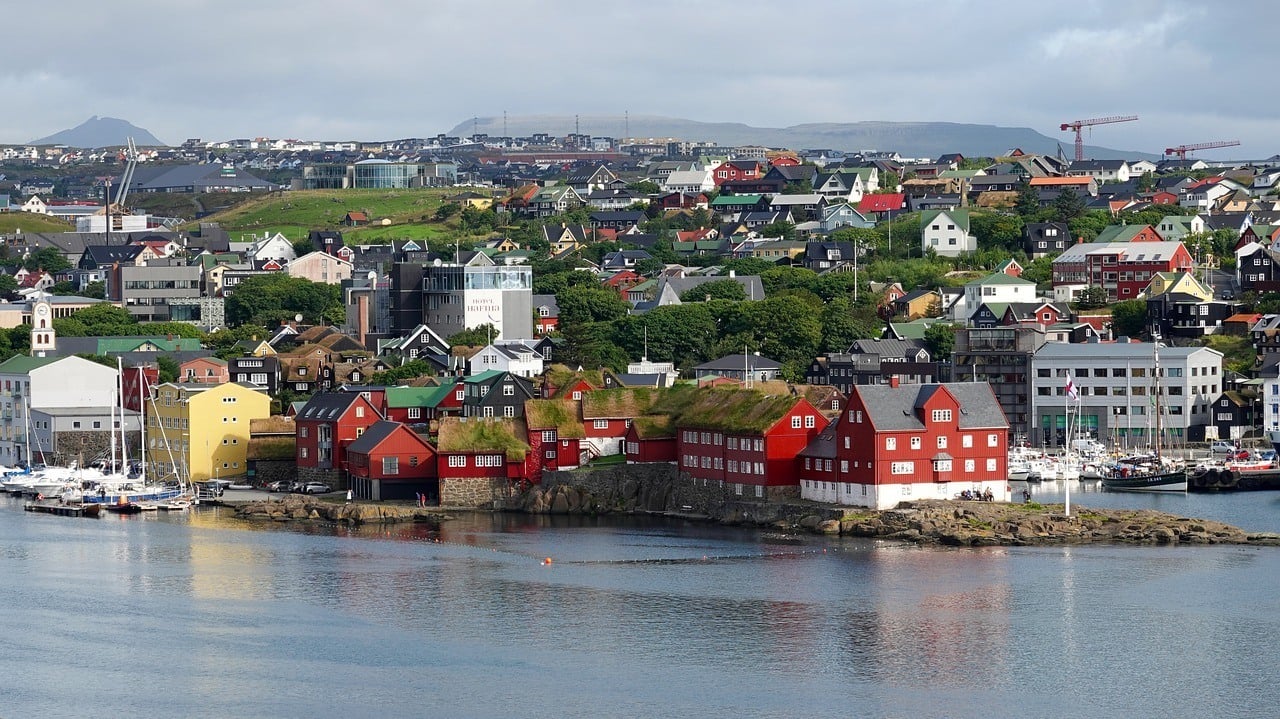
You can access so many areas from this spot, but you can stay local too and discover all the islands have to offer!
Cosy house in old Torshavn with a view to Tinganes | Best Luxury Airbnb in Torshavn
This is an authentic Nordic log-cabin in the old town area of Torshavn. Sweetly named after the previous owner who sadly passed away recently, the location is perfect for people who want to be able to explore from their doorstep! Form the living room, there’s a gorgeous view towards the harbour, so you can enjoy your surroundings even from inside!
Hotel Torshavn | Best Hotel in Torshavn
Just steps away from Torshavn Cathedral and harbour is this lovely hotel which has brilliant views across the town! There’s a business centre onsite, large comfortable rooms with TVs and a roundtrip airport shuttle.
A harbour house with a wonderful view | Best Airbnb in Torshavn
This is a penthouse apartment with a difference. It overlooks Torshavn’s beautiful harbour and is in one of the oldest narrow streets in the town. The house itself is about 100 years old and has been recently renovated to cater for all your modern needs!
Things to See and Do in Torshavn:
- Travel up the island to an exquisite dining experience! If you want to try amazing local cuisine headed up by a local chef, look no further than this fantastic restaurant. You’ll have a bumpy ride to get to it, as it’s tucked away in a hidden valley, but boy, is it worth the wait!
- Fancy a quick boat trip? Why not head over to Nolsoy? It’s a quiet and quaint island, but you can hike to its spectacular lighthouse and have a look around the small town, where you’ll find some delicious homemade food. The ferry only takes around 20 minutes and it goes 6 times a day, so you won’t be time-constrained!
- A little more local is the Foroya Sjosavn, which is an aquarium by Torshavn’s port! Discover the secrets of the Atlantic here!
- Want to discover the amazing culture of these ancient islands? Head to The Nordic House, just north of the town centre!
- Take a walk around the harbour wall to Skansin, a historical landmark, now a really important lighthouse. You’ll find some amazing views across the North Atlantic here!

We’ve tested countless backpacks over the years, but there’s one that has always been the best and remains the best buy for adventurers: the broke backpacker-approved Osprey Aether and Ariel series.
Want more deetz on why these packs are so damn perfect? Then read our comprehensive review for the inside scoop!
2. Vagar – Best Place to Stay in Faroe Islands on a Budget
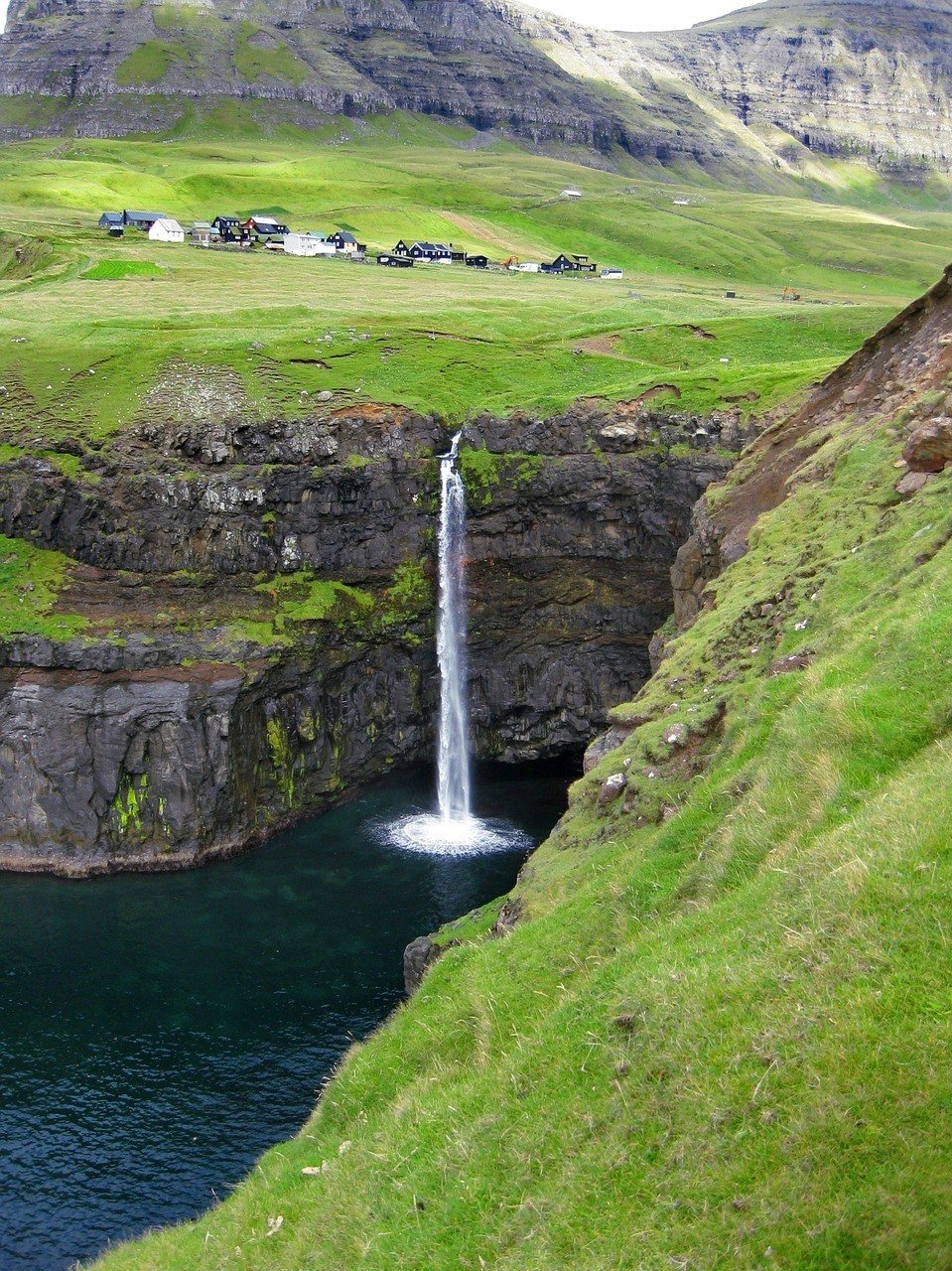
Whether it’s ferry trips to small neighboring islands, or long hikes into the wilderness, this is the perfect place to see the beauty of the Faroes without breaking the bank!
Ocean front, great view and balcony | Best Airbnb in Vagar
This ocean-front house is a beautiful option for your stay on the breath-taking island of Vagar. There’s an unobstructed view of the fjord and beach and the rest of the town is just a short walk away. Being bright yellow, it’ll be easy for you to find and once you’re here you won’t want to leave. There’s a brilliant kitchen and bright lounge for you to relax in.
Turf House near Airport – Town Center | Best Luxury Airbnb in Vagar
This is a truly authentic stay if you’re looking to immerse yourself in the Faroe Islands’ eclectic and ancient culture. It is built in the traditional Faroese style and you can reach everything you could need by foot. Your host is super friendly and you’ll even be helping the environment – this house has a garden roof!
Giljanes Hotel | Best Hotel in Vagar
This is a simple, yet convenient hotel right on the coast on the beautiful island of Vagar. It’s the perfect place to make new friends on your travels with a comfortable communal lounge and eating area. There’s also a shared kitchen to compare your cooking skills!
Things to See and Do in Vagar:
- You simply cannot visit Vagar without heading to Gasaladur. It may sound like somewhere from Middle Earth, but you’ll find no orcs here! Instead, there’s some fantastic opportunities to hike, especially out to Mulafossur Waterfall, a breath-taking cliff edge with water flowing into the sea! If you want some amazing pictures of an Atlantic sunset, make sure you hike over to the sunset point right on the cliff edge!
- Do you love nature and wildlife? The best thing for you to do is jump on a ferry over to Mykines, for, in one word, puffins. Every year this island is flooded with hundreds of thousands of the migrating seabirds. They’re super cute, super friendly and are a sight to behold!
- In order to get to Mykines, you’ll have to travel to the quaint port town of Sorvagur. There isn’t much in this small, originally fishing, village, but this doorway to the Atlantic is absolutely beautiful!
- For the chance to take some pictures of some breath-taking scenery, go on a hike to the lake of Sorvagsvatn. The weather here can be changeable, so make sure you wrap up warm, but it’ll be worth braving the clouds!
3. Syðrugøta – Best Place to Stay In Faroe Islands for Nightlife
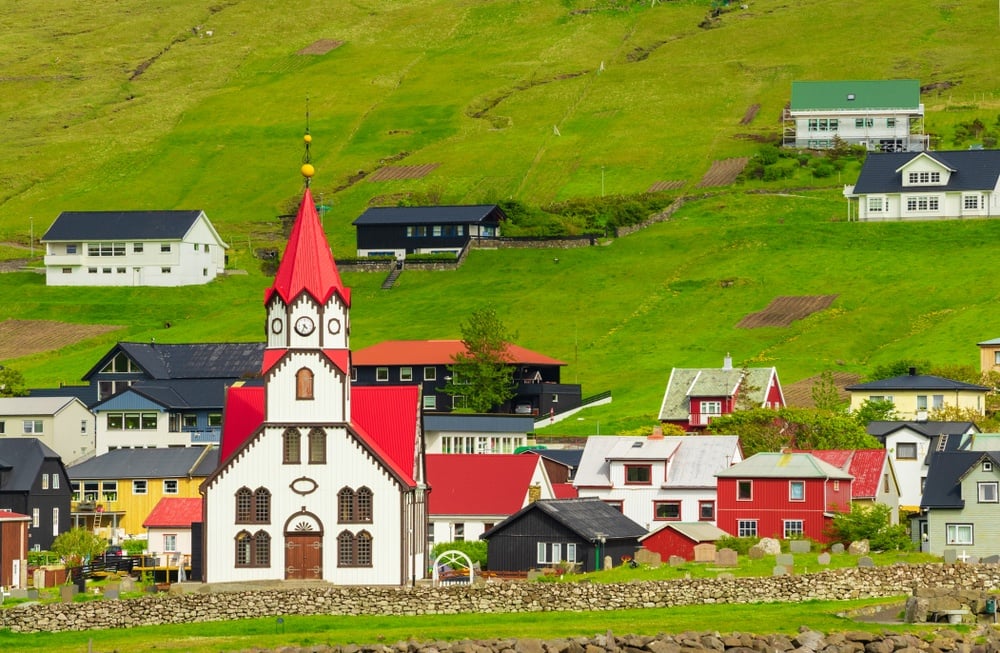
There are other small towns nearby too which you can visit, offering you a range of activities to get stuck into!
The perfect house for the active family | Best Luxury Airbnb in Syðrugøta
Although you might not be travelling with your family, you’ll be in a house of luxury here! It is a perfect example of modern architecture in an ancient landscape, with breath-taking views over the town and the ocean beyond.
Enjoy a morning coffee or a late-night cocktail on the outdoor terrace!
Fjordcottage | Best Hotel in Syðrugøta
This is a gorgeous small stay with three bedrooms, a flat-screen TV and free private parking. There’s a shared lounge and kitchen so you’re sure to make new friends and the dishwasher will make the clean up after your late-night parties that whole lot easier!
The 24 hour front desk is perfect for you night-owls.
FaroeGuide with Majestic Mountains and seaview | Best Airbnb in Syðrugøta
This Airbnb is exactly what is says on the tin and is perfect if you’re travelling in a large group! With space for up to 10 guests, this is the perfect place to stay if you’re planning a group trip to one of the busiest and most fascinating towns on the Faroe Islands.
It’s large, spacious and there are even cars for rent to make your stay that bit easier!
Things to See and Do in Syðrugøta:
- Fancy a night of dancing? This area of the Faroe Islands, although peaceful and tranquil in the daytime, has loads of opportunities for a late-night boogie. Head to Fjosið, Sandurin or Spæliplássið for a solid night of great music and chilled vibes!
- Take a stroll along the promenade in Syðrugøta – there are stunning views and lovely little picnic spots for you to enjoy a lunch in the great outdoors!
- Just up the coast, you can visit a traditional Lutheran church, which sits at the foot of a mountain!
- If you want to find out about the local culture and history, head to Gota Museum, a small, locally-run museum where you’ll find friendly locals and lots to learn!
- Want to do something fun with your night? Head over to Leirvik, where you’ll find a very unique bowling alley right on the coast!

A new country, a new contract, a new piece of plastic – booooring. Instead, buy an eSIM!
An eSIM works just like an app: you buy it, you download it, and BOOM! You’re connected the minute you land. It’s that easy.
Is your phone eSIM ready? Read about how e-Sims work or click below to see one of the top eSIM providers on the market and ditch the plastic .
4. Sandoy – Coolest Place to Stay in Faroe Islands
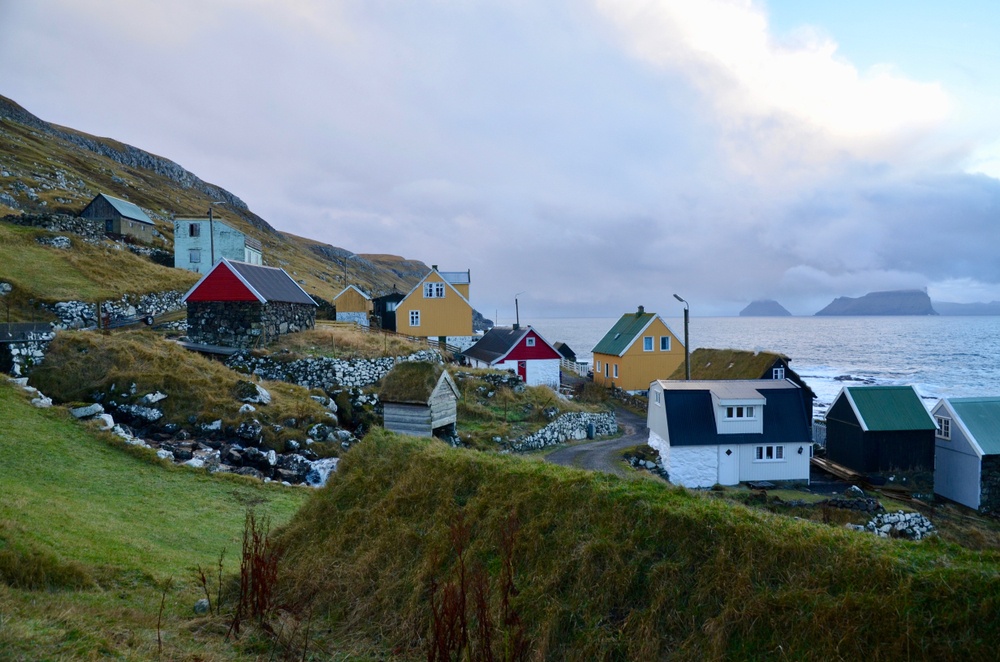
Although hotels are scarce, and civilisation is few and far between, this is the perfect place to stay if you’re looking for a chance to escape from the hustle and bustle of home life. Grab a boat trip to the nearby Skuvoy, or just enjoy Sandoy’s outstanding natural beauty if you don’t have great sea legs!
Brand new summerhouse in stunning nature | Best Budget Airbnb Sandoy
This traditional style cabin is in the quaint village of Sandur on the island of Sandoy, with glorious panoramic views surrounding it. There are daily nearby ferry connections so you can get around easily to enjoy all the activities listed above!
Cozy house with a view in Skalavik | Best Airbnb in Sandoy
This is a large cabin in Skalavik with an ocean view and all the amenities you could want. Catering for 8 guests, this cabin boasts a large kitchen-diner and a gorgeous living space for all the guests to enjoy. There’s even a café nearby, just two minutes away, so if you fancy a treat, it’s right on your doorstep!
I oskulagnum | Best Luxury Airbnb in Sandoy
One of the larger properties on the island of Sandoy is this gorgeous house. Right next to the beach and boasting incredible views, this house has the perfect location for exploring. The kitchen is large and the bedrooms are spacious – what more could you want?
Things to See and Do in Sandoy:
- Do you love your history? On Sandoy, you can take part in a Viking Tour, which takes you around the island’s most significant historical landmarks and with the help of useful guides, you’ll learn the context of everything you see!
- Take a visit to the oldest stone church in the Faroe Islands! You’ll step back in time as you immerse yourself in this peaceful but characterful landmark!
- Sandury Art Museum is the best place to visit in Sandoy if you’re looking for some local, rustic culture. It contains pieces by local and international artists, capturing the rich artistic culture of these islands and its residents!
- Take a boat trip out to the smaller island of Skuvoy, which will show you one of the most rural communities of the Faroe Islands!
5. Kirkjubøur – Best Place to Stay in Faroe Islands For Families
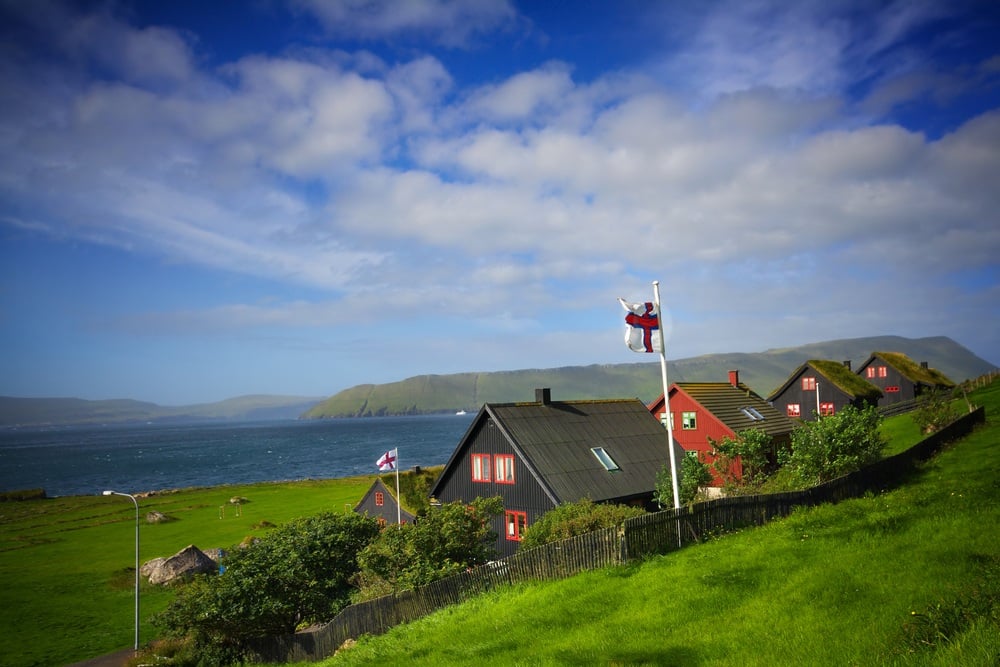
You won’t be able to escape the amazing views across the Fjords and out to the Atlantic Ocean and everything in this area is just a short drive away from busy local towns.
Bed and Breakfast in Velbastadur | Best Airbnb in Kirkjubøur
This is a simple but charming private stay, in a quiet and tranquil neighborhood, where you can really appreciate the isolated nature of the Faroe Islands. There’s wide-open spaces all around for the kids to play in and the hosts are super friendly and willing to help you in any way you need to make your visit exciting and convenient!
Hotel Foroyar | Best Hotel in Kirkjubøur
This large, hillside hotel is the peak of luxury on the island of Esturoy! Just a short drive away from Kirkjubøur, this is packed with amenities to make your stay stress-free and relaxing!
There’s a gorgeous bar and restaurant serving up all sorts of local delicacies and complimentary breakfast is included – great for feeding the kids up before a day of exploring!
Private penthouse apartment with a beautiful view | Best Luxury Airbnb in Kirkjubøur
Don’t be fooled by the rather dingy looking exterior of this apartment – inside you’ll realise that it is one of the most luxurious stays on the Faroe Islands! There are loads of spaces for all the family to enjoy some privacy, and a large kitchen/diner for you to enjoy a family meal together!
There’s even a TV with Netflix and free Wi-Fi if the kids need a bit of evening entertainment!
Fantastic history, breath-taking surroundings and a variety of amazing activities. It’s no wonder the Faroe Islands are so popular with tourists of all ages!
Things to See and Do in Kirkjubøur:
- For some history in a fabulous location, head to Olaf’s Church! This is the perfect place to visit if your kids are fans of Frozen! With sheer cliffs in the background and a wide-open ocean on the doorstep, this is really breath-taking!
- For some historical learning that means the kids won’t have to go inside, take them to Kirkjubomururin – some fantastic ancient ruins overlooking the Atlantic!
- Head up the coast to Gamlaraett Ferry Port so that you can go on a family adventure out to some of the surrounding islands! You can head over to Sandoy from here, or to the smaller Hestur, where you’ll find a truly wild, untamed environment.
- Perhaps more of a treat for mum and dad is the Okkara brewery – just a little further up the coast and a great chance to get to know local culture indoors if the weather turns a bit wild!

Stash your cash safely with this money belt. It will keep your valuables safely concealed, no matter where you go.
It looks exactly like a normal belt except for a SECRET interior pocket perfectly designed to hide a wad of cash, a passport photocopy or anything else you may wish to hide. Never get caught with your pants down again! (Unless you want to…)
Here’s what people usually ask us about the areas of Faroe Islands and where to stay.
How many days do you need in Faroe Islands?
We’d say 4-7 days. That’ll give you plenty of time to roam around and really feel the magnificent sites you’re about to witness. Have a great one!
What are the ultimate best places to stay in Faroe Islands?
Need some inspiration on where to stay? Here are a few great options: – In Torshavn: Harbour House with Wonderful View – In Vagar: Turf House near Airport – Town Center – In Syðrugøta: Perfect Active Family Home
What are the best Airbnbs in Faroe Islands?
Need some Airbnb inspiration for your Faroe Islands trip? Check these out: – Seaside Apartment – Unique Cozy Cottage – Cozy House with a View
Where to stay in Faroe Islands for couples?
Planning a romantic getaway to the Faroe Islands? Check out a COUPLE of our favorite spots. 😉 – Unique Cozy Cottage – Giljanes Hotel
Pants, socks, underwear, soap?! Take it from me, packing for a hostel stay is not always quite as straightforward as it seems. Working out what to bring and what to leave at home is an art I have perfected over many years.

Snoring dorm-mates can ruin your nights rest and seriously damage the hostel experience. This is why I always travel with a pack of decent ear plugs.

Hanging Laundry Bag
Trust us, this is an absolute game changer. Super compact, a hanging mesh laundry bag stops your dirty clothes from stinking, you don’t know how much you need one of these… so just get it, thank us later.

Sea To Summit Micro Towel
Hostel towels are scummy and take forever to dry. Microfibre towels dry quickly, are compact, lightweight, and can be used as a blanket or yoga mat if need be.

Monopoly Deal
Forget about Poker! Monopoly Deal is the single best travel card game that we have ever played. Works with 2-5 players and guarantees happy days.

Grayl Geopress Water Bottle
Always travel with a water bottle! They save you money and reduce your plastic footprint on our planet. The Grayl Geopress acts as a purifier AND temperature regulator. Boom!
Check out my definitive Hotel Packing list for even more top packing tips!
ALWAYS sort out your backpacker insurance before your trip. There’s plenty to choose from in that department, but a good place to start is Safety Wing .
They offer month-to-month payments, no lock-in contracts, and require absolutely no itineraries: that’s the exact kind of insurance long-term travellers and digital nomads need.

SafetyWing is cheap, easy, and admin-free: just sign up lickety-split so you can get back to it!
Click the button below to learn more about SafetyWing’s setup or read our insider review for the full tasty scoop.
Torshavn is our number one choice for the best place to stay in the Faroe Islands for the first time. It’s on the main island of Esturoy and is the best place to learn about this archipelago’s historical and cultural importance.
For a luxurious stay, look no further than Visithomes A Miðgerði – a relaxing and stress-free stay!
If you are travelling on a budget, then we recommend the brilliant Airbnb ‘ Apartment at the seaside with a wonderful view ’. With gleaming reviews and spacious rooms, this stay is the perfect base for your explorations!
Have we missed anything? Let us know in the comments below! Otherwise, enjoy your travels!
- Check out our ultimate guide backpacking around Faroe Islands .
- Figured out where you wanna stay? Now it’s time to pick the perfect hostel in Europe .
- Save yourself hassle and money and get an international sim card for Europe .
- Swing by our super epic backpacking packing list to prep for your trip.
- Our in-depth Europe backpacking guide will help you plan the rest of your adventure.
Buy Us a Coffee !
A couple of you lovely people suggested we set up a tip jar for direct support as an alternative to booking through our links. So we created one!
You can now buy The Broke Backpacker a coffee . If you like and use our content to plan your trips, it’s a much appreciated way to show appreciation 🙂

Christina Grayt
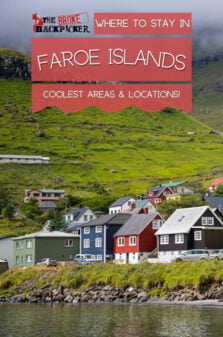
Share or save this post

Leave a Reply Cancel reply
Your email address will not be published. Required fields are marked *
Save my name, email, and website in this browser for the next time I comment.
Notify me of followup comments via e-mail.
Faroe Islands on a budget: How to sleep for free!
Beyond being incredibly beautiful, the Faroe Islands is notorious for being incredibly expensive too. But a visit to the gorgeous isles doesn’t have to break your bank account, at least not if you’re willing to rough it a little. Just bring your camping gear and put on your charm!
If you combine these free overnight stays listed below with hitchhiking (very easy and safe!), you could even enjoy a very cheap trip to the Faroe Islands!
Free campsites on the Faroe Islands
Tentsite on nólsoy.
There’s a free primitive tentsite just above the harbour on Nólsoy, the island just across the ocean from Tórshavn. The terrain is quite uneven but there are a few flat spots to pitch small tents.
If you’re looking for a bit more comfort but still a cheap night on the island, it’s possible to park a caravan or motorhome in front of the football field for 100 DKK per night. Electric power can be provided on request. There are no showers available. The campsite is open from April 1st to October 1st, but the tentsite is available year-round.
There are free public toilets near the supermarket which you can use free of charge (open 24hrs), and there are also free public toilets at the harbour which are open during ferry operating hours. The latter are accessible for the disabled. You can get fresh drinking water at both public toilets.
Contact Visit Nólsoy for more information at +298 52 70 60 or info(at)visitnolsoy.fo.
Curious what there is to see and do on Nólsoy? Click here to read my in-depth guide to the island !
Elduvík Camping
The campsite in Elduvík on northeast Eysturoy is a small, primitive site with limited facilities. It’s free to pitch a tent or park a caravan or motorhome, although only for three consecutive days.
If you need electricity, this can be purchased at the tourist information centre in Runavík for 300 DKK.
Contact Visit Runavík for more information at +298 41 70 60 or [email protected].
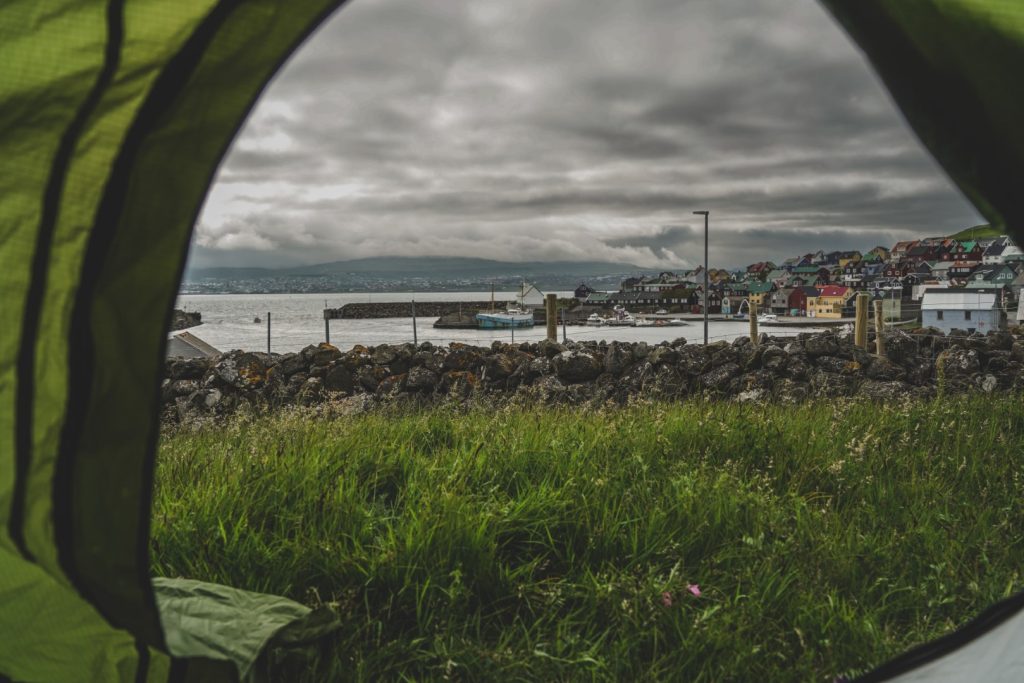
Wild camping on the Faroe Islands
All land in the Faroe Islands is privately owned and thus, wild camping is not permitted. However, if you ask around, you’ll soon find a local who either owns land in the area or knows someone who does. Ask politely, and I’m almost certain they’ll allow you to stay the night. I’ve done this on several of the smaller islands where there are no tentsites, such as Fugloy, Koltur and Skúvoy, and I’ve never been turned away.
I also heard from four Swiss travellers that they had success asking locals to camp out in their gardens, so this might also be worth a try but remember to always respect a ‘no’.

Free shelters on the Faroe Islands
Skarð on kunoy.
Skarð is an abandoned village on the island of Kunoy where hikers can stay overnight in a little red shelter. As far as I know, this is the only public shelter in the entire country. Reaching it is no easy feat though; you can either hike for three hours along the coast from Haraldssund or take a treacherous climb over the mountains from the village of Kunoy (only recommended with a local guide!).
Remember to bring your own sleeping gear and food as there is nothing out there except abandoned houses, beautiful nature and solitude!
Sleeping for free in your (rental) car
Parking is free anywhere on the Faroe Islands, and thus, you can save a lot of money by camping out in your car! I’ve done it myself all throughout Germany as well as in Austria and Iceland, and it wasn’t as uncomfortable as it sounds. Just put the front seat down as far as possible and maybe something under your feet – or, if you’re tiny like me, crash on the back seats!
Just make sure you park out of the way of houses and private parking lots, and of course don’t park at the side of the road so as not to put yourself in potential danger. And please, do not do this with campervans or motorhomes, it’s only acceptable to do in small, unseeable cars.
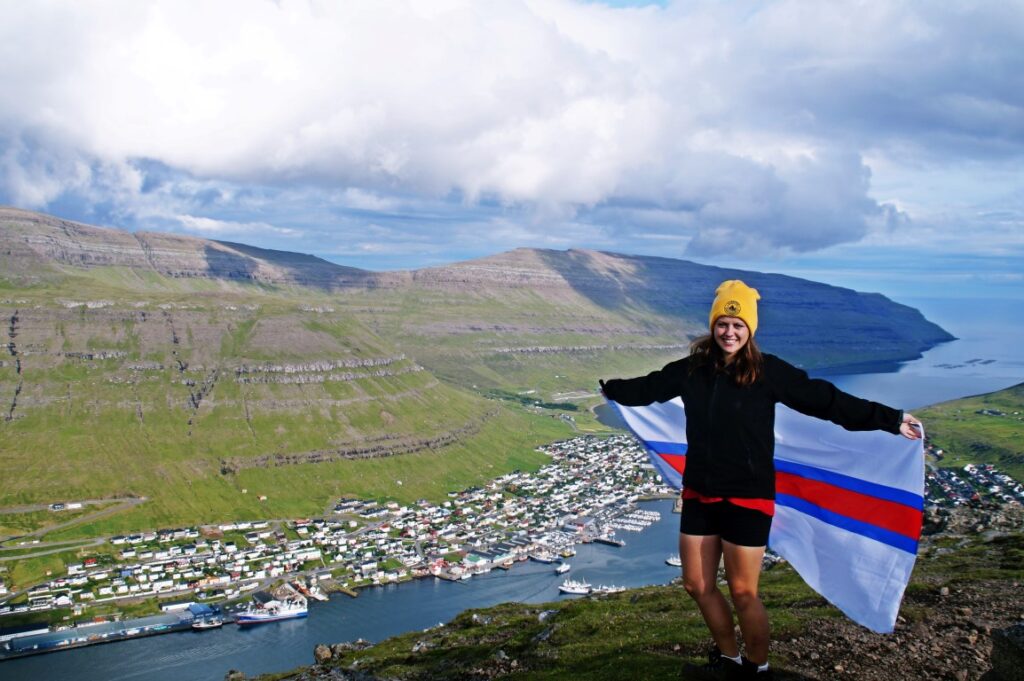
Couchsurfing on the Faroe Islands
Back in the days when I first travelled to the Faroes, I used Couchsurfing to find a host after my tent got destroyed in a storm, and I ended up staying with a lovely family for two weeks that I still visit to this day.
The golden days of Couchsurfing are over and the site now requires payment to get access to potential hosts, but according to the site itself, there are over 300 hosts in the Faroe Islands so there might be potential for a free stay there. But do remember that Couchsurfing is much more than just a free place to stay. It’s a cultural exchange and an exceptional chance to make local friends!
It might also be worth searching for hosts on other similar sites, such as BeWelcome , Trustroots and TrustedHousesitters .
Workaway on the Faroe Islands
Workaway is an excellent way to emerge yourself in local culture and help out hosts while receiving free accommodation and food – and often, so much more than that!
This option is ideal for those that want to stay for at least a few weeks, and don’t mind spending time on different chores. Basically, Workaway allows you to pay for bed and board by helping out hosts with household chores or different projects. Currently, there are over 20 hosts on the Faroe Islands , and one of these families is one that is very close to my heart. I’ve stayed with them many times over the past seven years (as a friend, not a workawayer), and they almost always have a workawayer staying with them. It’s a lot of fun for everyone!
Workaway is the ultimate way to learn about Faroese culture and share your own culture while exploring the country at a slow pace.

Other cheap places to stay on the Faroe Islands
If the free options don’t satisy your needs, you can also stay at these cheap campsites around the country:
- Tórshavn = 120 DKK per adult per night. Access to toilets and kitchen facilities. Showers and washing machine for a small fee. Open from April 1st to October 18th.
- Vestmanna = 100 DKK per adult per night. Access to toilets and kitchen facilities. Showers and washing machine for a small fee. Open from May 1st to August 30th.
- Lómundaroyri (above Vestmanna) = 100 DKK per tent and caravan/motorhome per night. Access to toilets, but no showers. Open from April 1st to October 1st.
- Víkar (Haldórsvík) = 150 DKK per caravan/motorhome per night, unclear if tent slots are available. Access to toilets, showers and washing machine. Open from May 1st to August 31st.
- Eiði = 120 DKK per tent per night / 220 DKK per caravan/motorhome per night. Access to toilets, showers and kitchen facilities. Washing machine for a small fee. Open from April 11th to October 1st.
- Gjógv = 200 DKK per tent and caravan/motorhome per night. Access to toilets and showers. Open from May 1st to August 31st.
- Fuglafjørður = 150 DKK per caravan/motorhome per night, unclear if tent slots are available. Access to toilets and showers. Open from March 1st to October 1st.
- Selatrað = 125 DKK per tent per night / 175 DKK per campervan/motorhome per night. Access to toilets and showers. Open year-round.
- Æðuvík = 100 DKK per tent per night / 200 DKK per campervan/motorhome per night. Access to toilets and showers. Open year-round.
- Mikladalur, Kalsoy = 100 DKK per tent per night / 200 DKK per caravan/motorhome per night. Access to toilets and showers. Open from April 1st to October 1st.
- Svínoy = 100 DKK per person per night. There are no spaces for caravans or motorhomes, only tents. Access to a toilet. Shower for a small fee. Open from April 1st to October 1st.
Vágar and Mykines
- Giljanes (Miðvágur) = 100 DKK per adult per night. Access to toilets, showers and kitchen facilities. Washing machine for a small fee. Open year-round.
- Mykines = 100 DKK per adult per night. Access to toilets and showers. Open from April 1st to September 30th.
- Sandur = 50 DKK per tent per night / 100 DKK per caravan/motorhome per night. Access to toilets. Showers and washing machine for a small fee. Open year-round.
- Dalur = 100 DKK per tent per night / 175 DKK per caravan/motorhome per night. Access to toilets. Showers and washing machine for a small fee. Open year-round.
- Vágur = 100 DKK per person in a tent per night / 200 DKK per caravan/motorhome with two people included. Access to toilets and showers. Washing machine for a small fee. Open from April 1st to October 1st.
- Hvalba = 100 DKK per tent and caravan/motorhome per night. Access to toilets and showers. Open from April 1st to October 1st.
- Fámjin = 100 DKK per caravan/motorhome per night, unclear if tent slots are available. Access to toilets and showers. Open from April 1st to October 1st.
- Sumba = 100 DKK per tent and caravan/motorhome per night. Access to toilets, but no showers. Open from April 1st to October 1st.
Spejderhuset on Suðuroy
In addition to the campsites on Suðuroy, there is a cabin in Tvøroyri that you can rent for 100 DKK per person per night. The cabin is located on the opposite side of the fjord from where the ferry docks at Ovari Vagur 44. There is a stream nearby where you can get clean drinking water, and there is also a toilet at the site.
Contact +298 239390 or info(at)tvoroyri.fo to book the cabin and gain access to the facilities.
Other cheap options
Travelling in the off-season? Then you might get lucky and find a cheap bunk bed at Giljanes Hostel on Vágar ! I stayed there for 100 DKK per night / 3100 DKK for an entire month in October 2020 . Keep an eye on booking.com for this special deal!
Wanting to stay for a month or more? Search on Airbnb for good deals as you can often save a lot by booking month-long stays! Alternatively, search up local facebook groups (such as this one ) and ask if anyone has a place to rent for a few months. That was how I found my rental house on Nólsoy back in 2019 where I stayed for six weeks for a total of 4500 DKK!
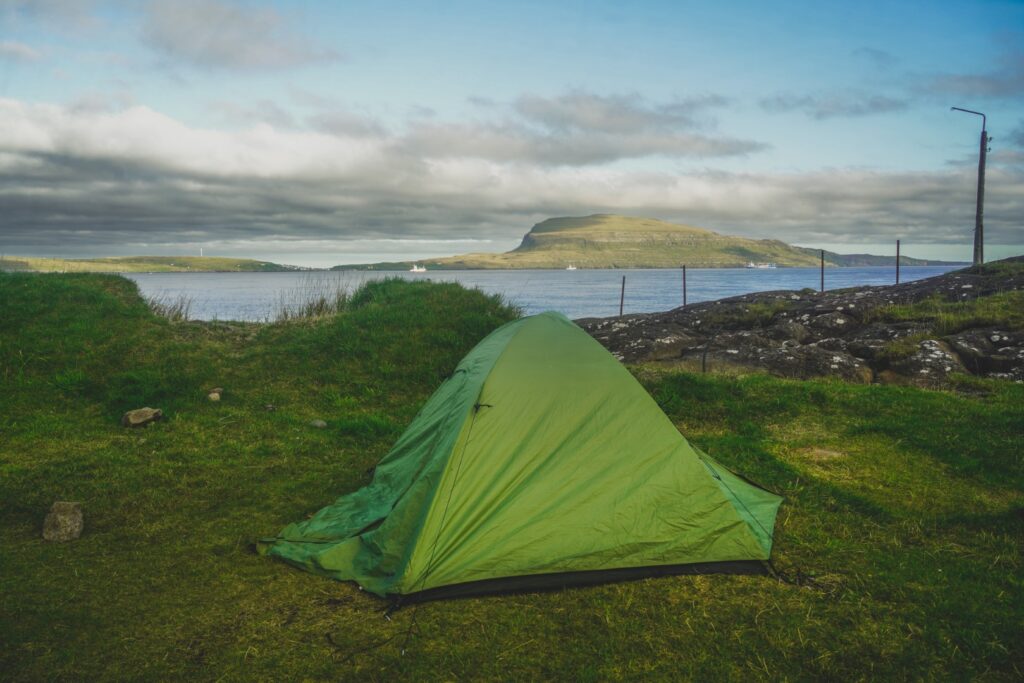
Other ways to keep costs down on the Faroe Islands
Hitchhike everywhere! It’s surprisingly easy and very safe. Locals are friendly and often curious about your adventures, and/or willing to tell stories from their lives on the islands. It’s a fun way to meet locals and travel for free all over the country. I’ve done it ever since I started travelling solo in the Faroes in 2015, and I’ve never had an issue getting to my planned destination, even with a huge backpack and other travellers! I’ve met many interesting people this way, and many of my stories and knowledge on the Faroe Islands come from conversations I’ve had with locals during my hitchhiking trips.
Take the free red busses around Tórshavn. They even go as far as Kollafjørður, Kaldbak and Kirkjubøur. See more here .
Drink nature’s own water – it’s free, clean and incredibly fresh!
Limit restaurant and café visits and eat from supermarkets instead. Food is expensive, but this will definitely keep the costs down.
Buy traditional Faroese sweaters , souvenirs and other clothing in thrift stores instead of the expensive high-end stores. Tórshavn has four thrift stores, and most other larger towns have 1-2 thrift stores too!
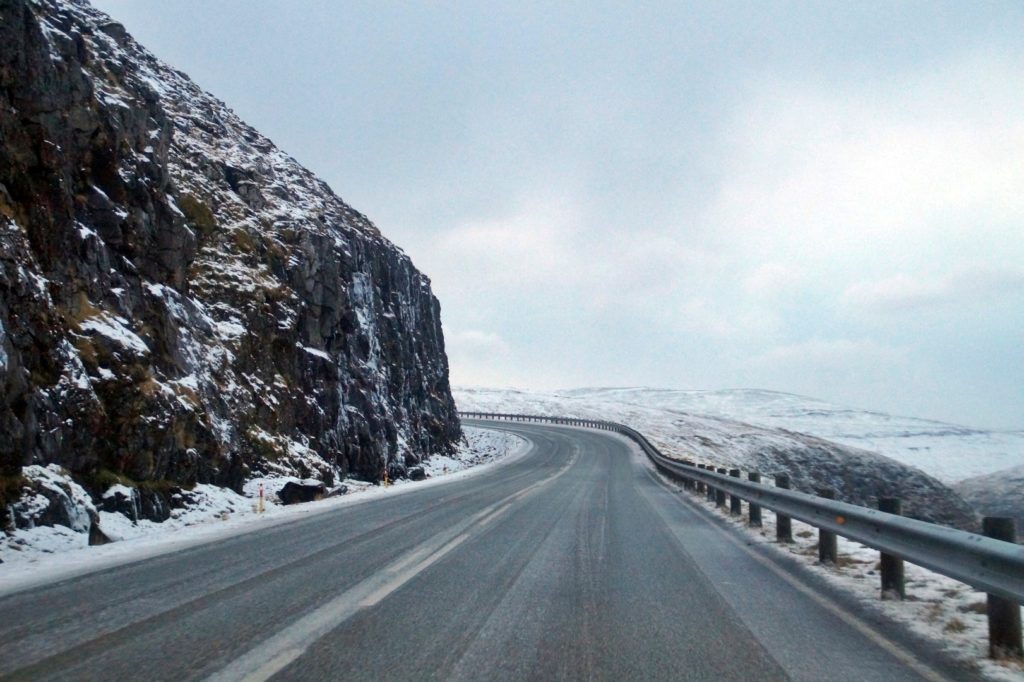
Updated 22/6/2023
« Red cliffs, seals and birds galore: A journey to Helgoland, an isolated archipelago in Germany
Travel while studying: how i visited 36 countries during my bachelor’s degree », you may also like.
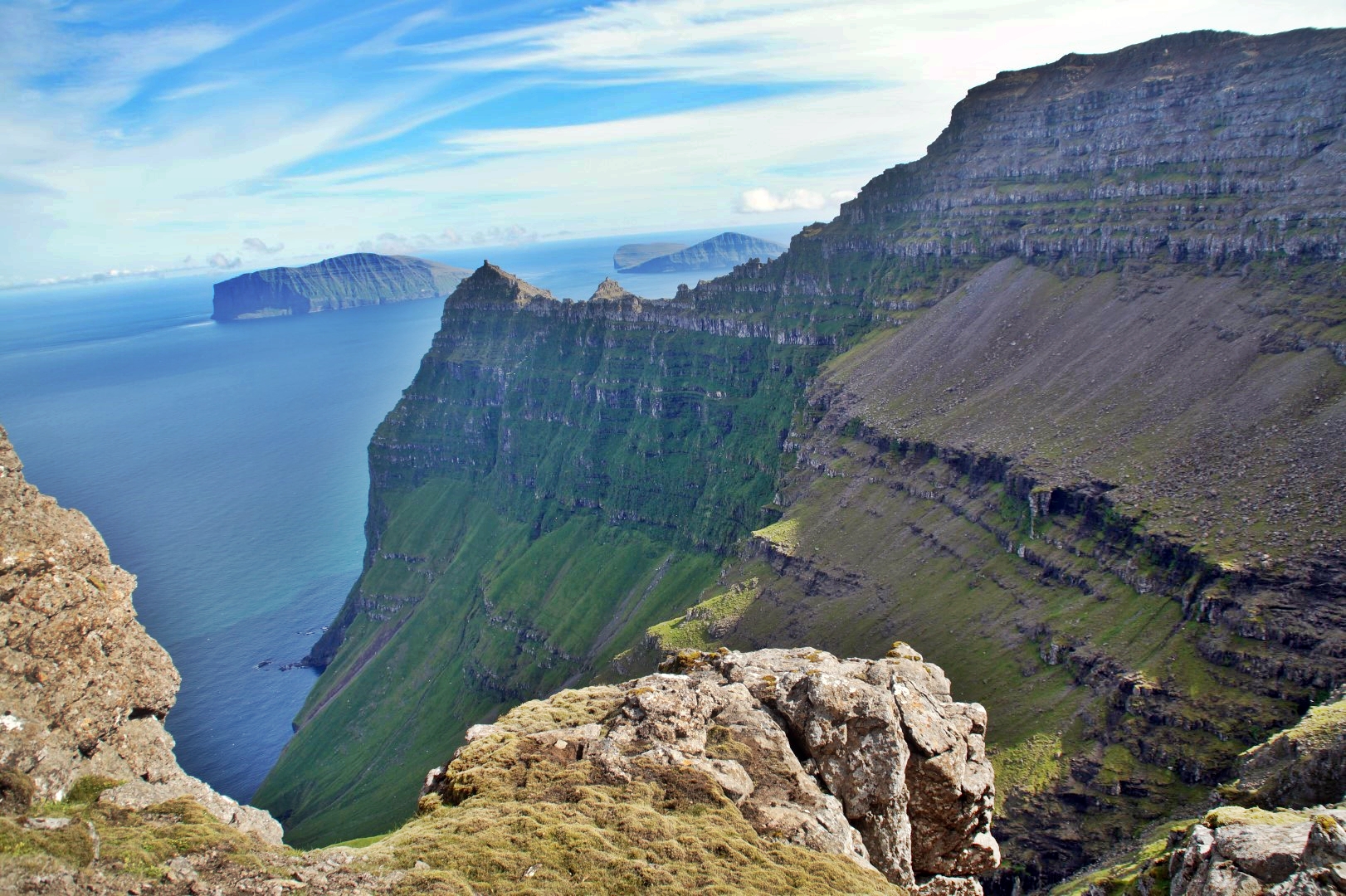
Cape Enniberg: A challenging hike to the northernmost point of the Faroe Islands
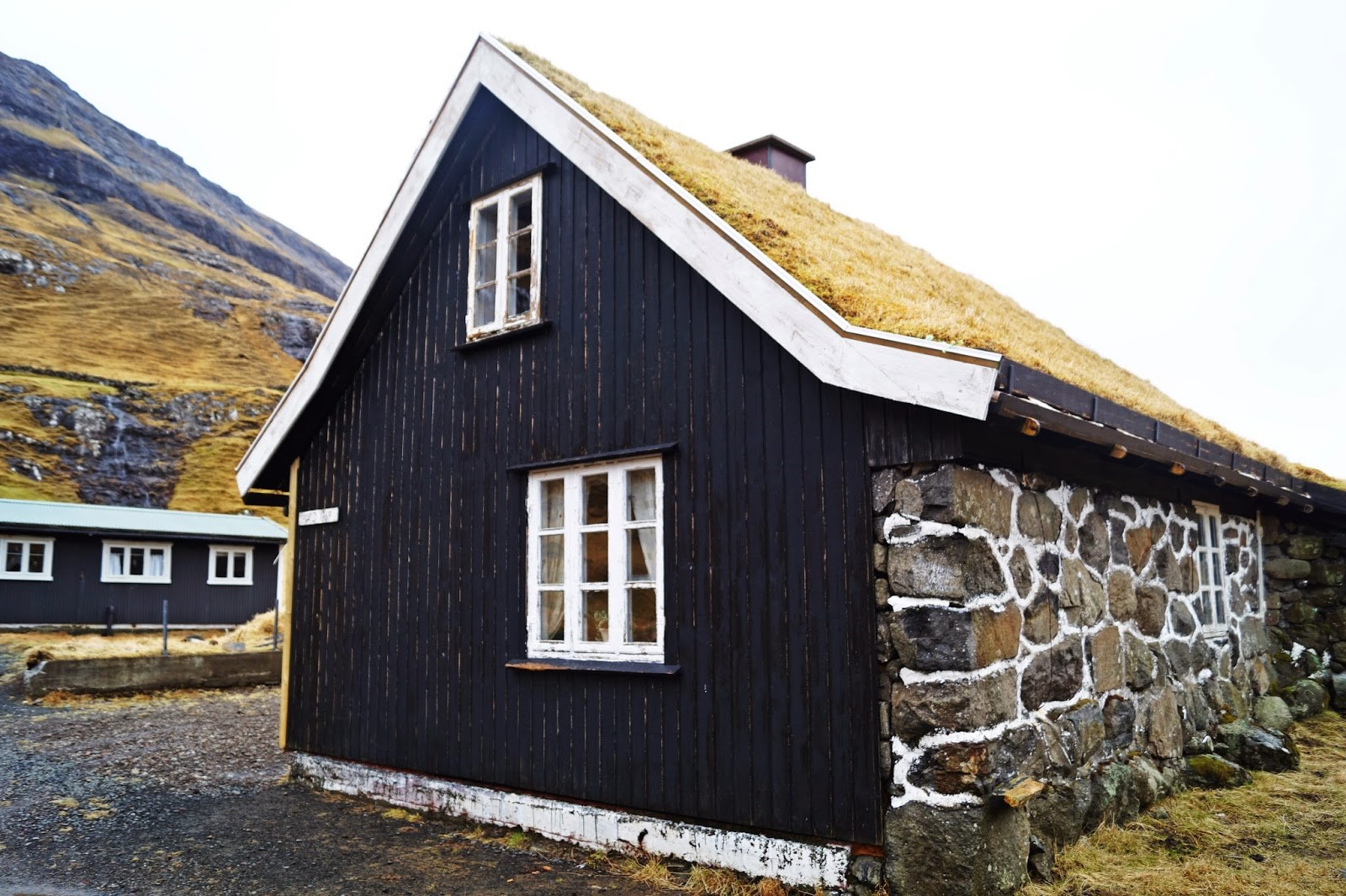
Night at the museum: Sleeping in an old cottage in Saksun

The weirdest places I’ve slept for free around the world
Leave a comment cancel reply.
Your email address will not be published. Required fields are marked *
Save my name, email, and website in this browser for the next time I comment.
Notify me of follow-up comments by email.
Notify me of new posts by email.
Pingback: Highlights of the Faroe Islands: The perfect two-week itinerary for hikers – Northtrotter on 24/11/2022
Pingback: A hike up Eiðiskollur: Standing above the sea stacks of Risin and Kellingin – Northtrotter on 24/11/2022

Copyright 2023 @ Northtrotter

IMAGES
VIDEO
COMMENTS
Budget Travel in the Faroe Islands • Best Tips to Save Money
Other locations in the islands can be more hit and miss. In particular, look out for fish and chip options, which can fill you up from around 100 kr with locally caught fish. How to travel the Faroe Islands for almost free. Every year the Faroe Islands run a special weekend called Closed for Maintenance. This unique tourism initiative invites ...
Here is the link to our Air Bnb we stayed in: From 40 Euro per night - best way to stay in the Faroe Islands on a budget. There was a small kitchen here where you could cook. This is the best way to keep costs down as food can be quite expensive in the Faroe Islands in the cafes and restaurants.
2.1 How to Get to the Faroe Islands on a Budget. 2.2 Budget Accommodation on the Faroe Islands. 2.3 Cheap Transportation on the Faroe Islands. 2.4 Affordable Food on the Faroe Islands. 2.5 Cheap and Free Sights on the Faroe Islands. 2.6 Daily Backpacking Budget for the Faroe Islands. 3 General Travel Advice for the Faroe Islands.
If you have the time to travel according to the pace of the timetables, you won't even need to rent a car -- an expense that may cost up to $100 a day, or more if you need an automatic. July 2016 Update: In an effort to get the attention of Google Street View, the Faroe Islands are turning to rather unusual methods. Its official tourism arm is ...
Outside of rentals, a hotel room could cost up to £80 per night, which is roughly $110 USD. Therefore, the difference of £40 is quite a lot when considering an Airbnb rental over a hotel. Next: The Most Remote House In The World Sits On This Island, And Its Owner Is A Mystery. It's not cheap to visit the Faroe Islands but if you do your ...
Faroe Islands Itinerary & Travel Guide: 5 Days (More or ...
How to travel the Faroe Islands on a budget. Mar 7, 2024 • 6 min read. Heading to the Faroe Islands? Here are some handy tips to help make your money go further. Destination Practicalities. The best time to visit the Faroe Islands. Mar 4, 2024 • 5 min read. Tips & Advice.
Many people travel to the Faroe Islands for just a few days, but we wanted to explore the main islands to the fullest, and so we spent 9 full days in the Faroe Islands 11 including travel days. TIP: If you are visiting the Faroe Islands for the first time and are not sure where to start, you can also opt for organized tour packages. They ...
Faroe Islands travel - Lonely Planet | Europe
Faroe Islands: Planning Your Trip. Few places in the world are as naturally beautiful and unspoiled as the Faroe Islands. The lush rolling hills, green-roofed cottages, and pastures dotted with sheep are like something out of a storybook. This idyllic remote nation is made up of 18 small islands connected by bridges, tunnels, helicopters, and ...
Iceland is so 2022: The Faroe Islands are the next untapped travel destination. And thanks to new flights to and from the Faroe Islands, it's shockingly easy (and surprisingly cheap) to get to this relatively unknown destination. Take it from our Social Media Manager Lauren, who recently returned from a trip to the Faroe Islands this spring.
3. You Can Take a Ferry to the Faroe Islands from Denmark (and Iceland) From Hirtshals, Denmark, you can take a ferry to the Faroe Islands from the European mainland. While this isn't my cup of tea, it still is a nice alternative for those who are perhaps afraid of flying or want to try something a little different.
This is how much my entire trip cost: Flights: 152 € (Copenhagen-Vagar) + 187 € (Warsaw-Copenhagen) ~ 340 €. Registered luggage: 7 €. Accomodation: 27 € per night = 189 € for a week. Car rental: 23 € per day = 161 € for a week (including insurance) Costs of the car: 14 € (tunnels) + 8 € (ferry) + 23 € (gas) = 45 €.
The cost is 450 DKK (€60) for adults, 150 DKK (€20) for children aged 7 to 14, and free for kids 6 and under. Guided hiking groups depart at 9 a.m., 12 and 3 p.m. daily. Book your tour here or visit this website for more information. Sørvágsvatn is one of the most visited areas in the Faroe Islands and these measures have been put in ...
2 The Perfect One-Week Itinerary for the Faroe Islands. 2.1 Day 1: Tórshavn. 2.2 Day 2: Streymoy. 2.3 Day 3: Gjógv and Northern Eysturoy. 2.4 Day 4: Bordoy and Kalsoy. 2.5 Day 5: Kunoy or Fugloy. 2.6 Day 6: Vágar. 2.7 Day 7: Mykines. 3 Longer Stays on the Faroe Islands.
Prices in the Faroe Islands are comparable to that in Norway. Accommodation prices start from 35 euros per person for a hostel bed and 100 euros for a three-star hotel. Restaurant prices are around 20 euros for a meal and ferries cost around 15 euros return. However, there are ways to keep your budget down.
15 things to know before visiting the Faroe Islands
How to Travel Faroe Islands on a Budget How To Travel in the Faroe Islands | The Top 5 Do's and Don'ts Is Faroe Islands Worth Visiting? Luxury Travel in the Faroe Islands Map of Faroe Islands Public Holidays in the Faroe Islands in 2025 The 7 best hotels in the Faroe Islands ...
Standard Airbnb for a couple. Whilst you can certainly find Airbnbs for much more than this, we were actually quite surprised how many were available for around £60 - £80 a night. Just be sure to book it in advance - the good value places get booked up early. View the best Airbnbs in the Faroe Islands here.
How to travel the Faroe Islands on a budget. Mar 7, 2024 • 6 min read. Heading to the Faroe Islands? Here are some handy tips to help make your money go further. Tips & Advice. 8 of the best places to visit in the Faroe Islands. Mar 1, 2024 • 6 min read. Destination Practicalities.
2. Vagar - Best Place to Stay in Faroe Islands on a Budget. Vagar is one of the western islands which makes up the Faroe Islands. It is one of the most sparsely populated and civilised, however, it is the perfect place to visit to really be at one with the fantastic nature and wildlife available here.
Budget travel Faroe Islands. Faroe Islands on a budget: How to sleep for free! by Mel on 24/11/2022. Beyond being incredibly beautiful, the Faroe Islands is notorious for being incredibly expensive too. But a visit to the gorgeous isles doesn't have to break your bank account, at least not if you're willing to rough it a little. ...